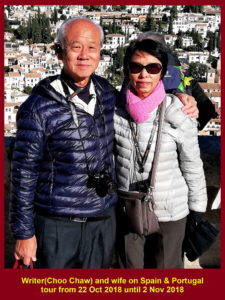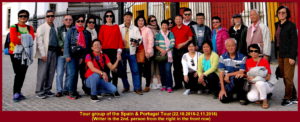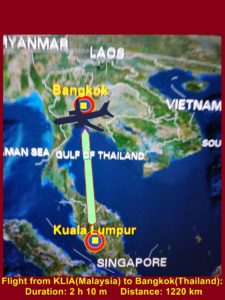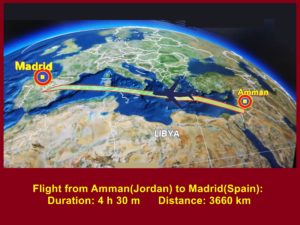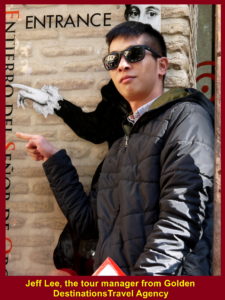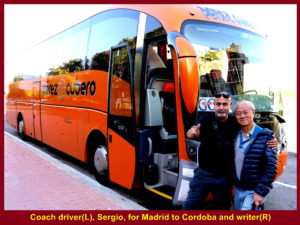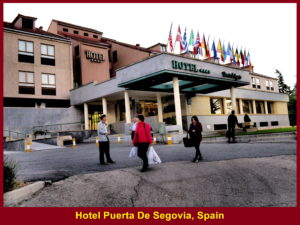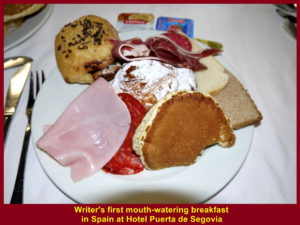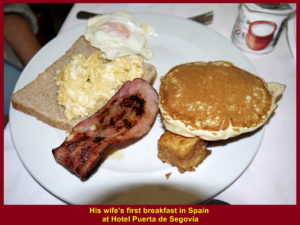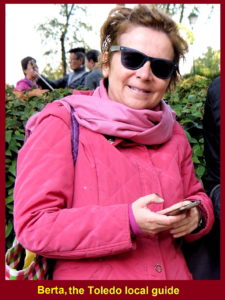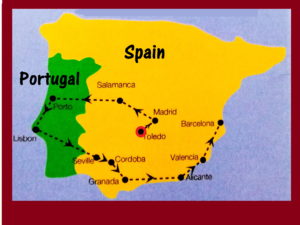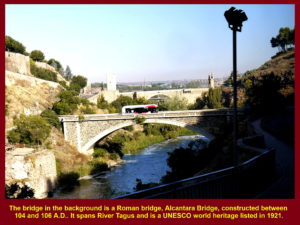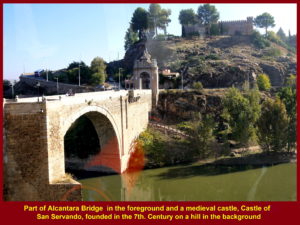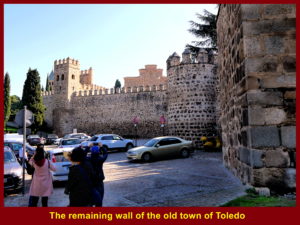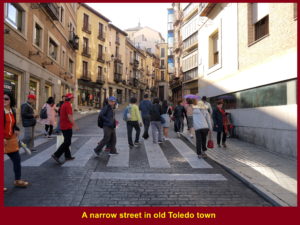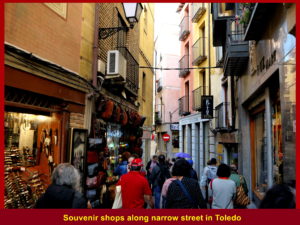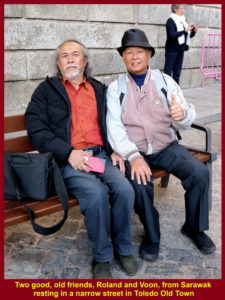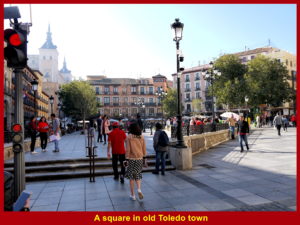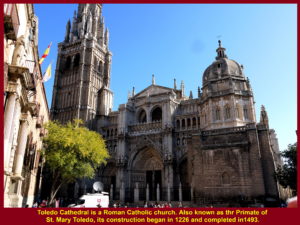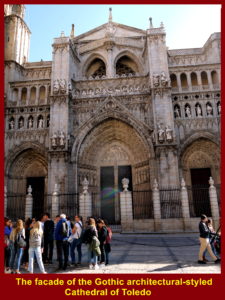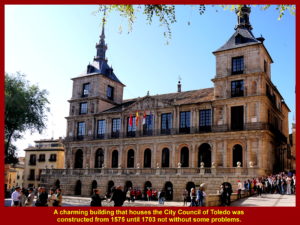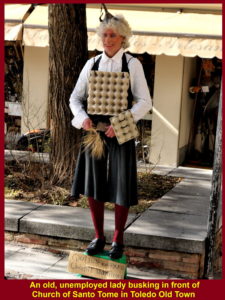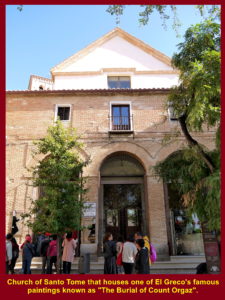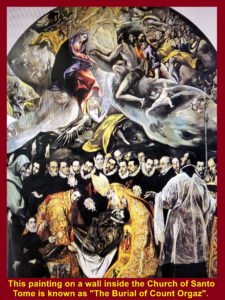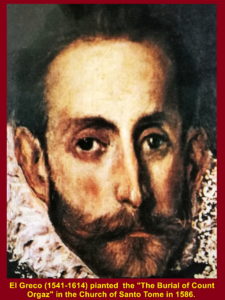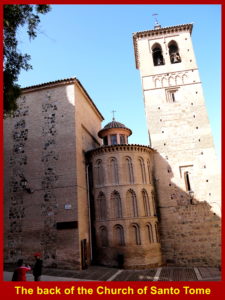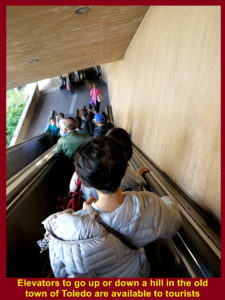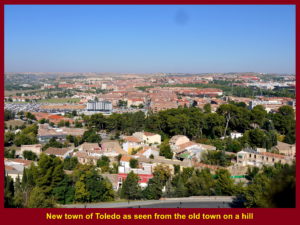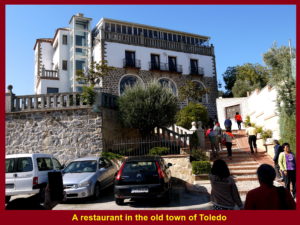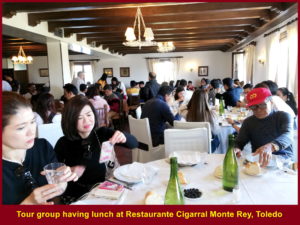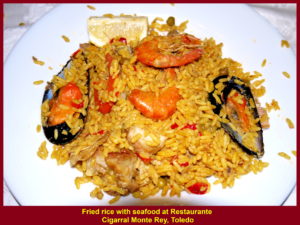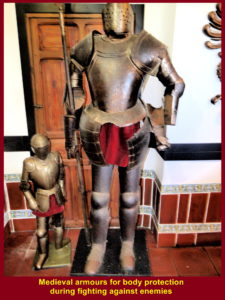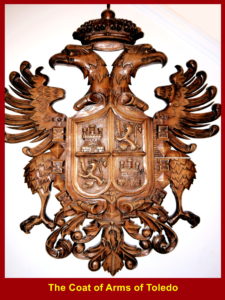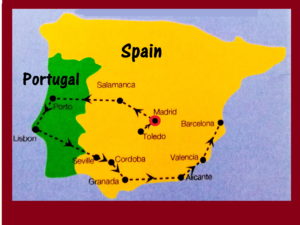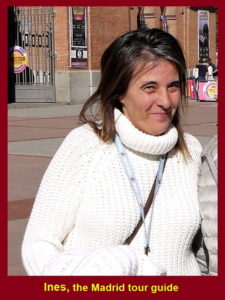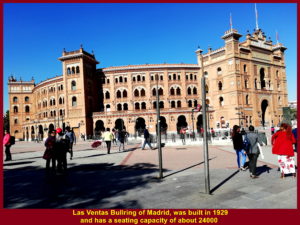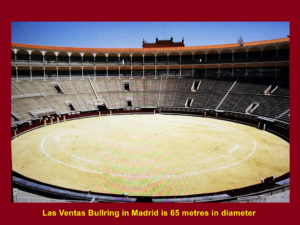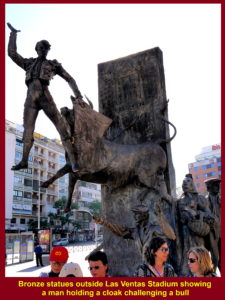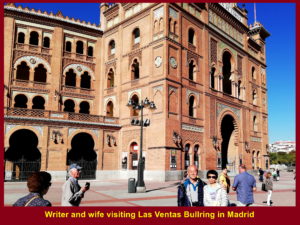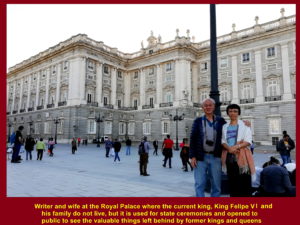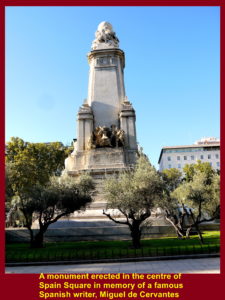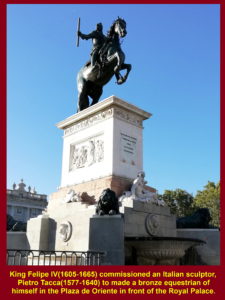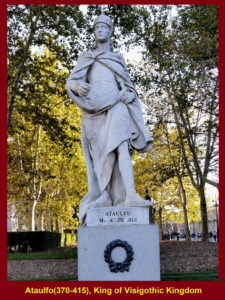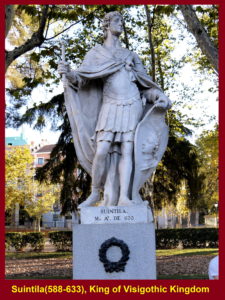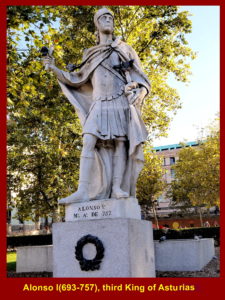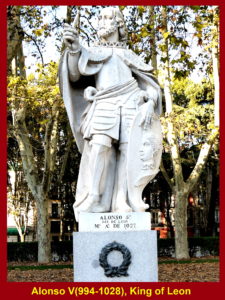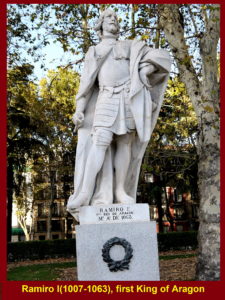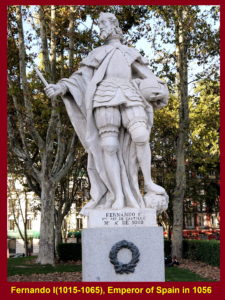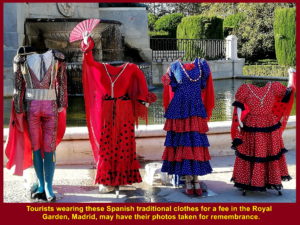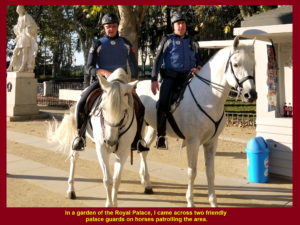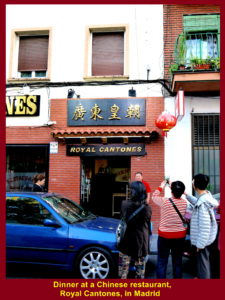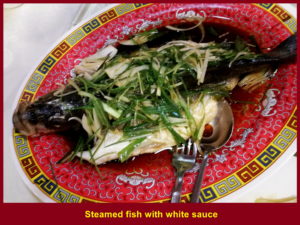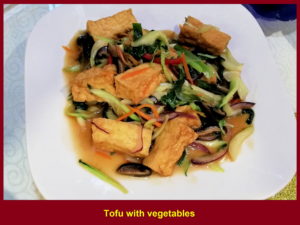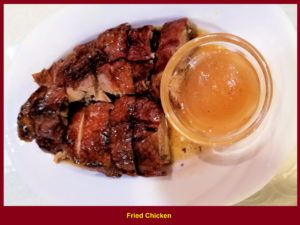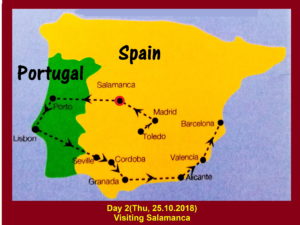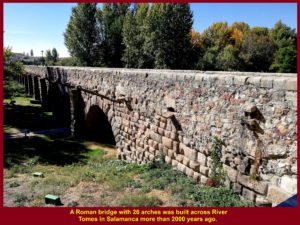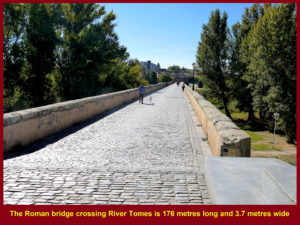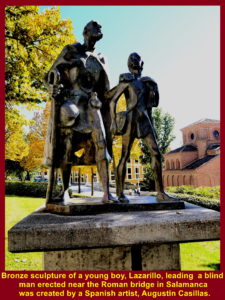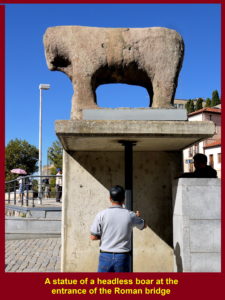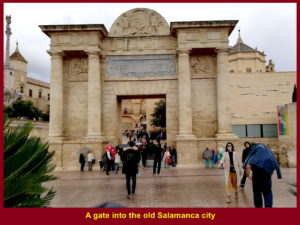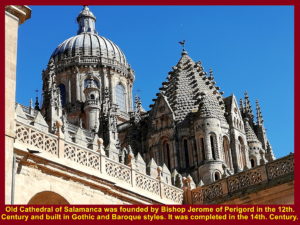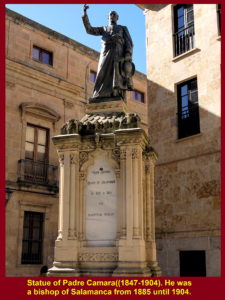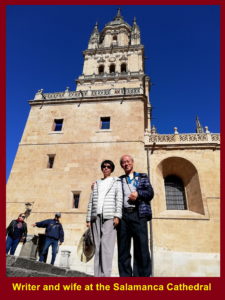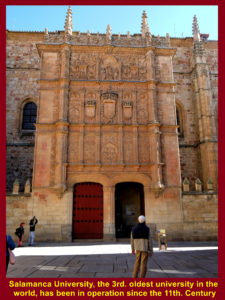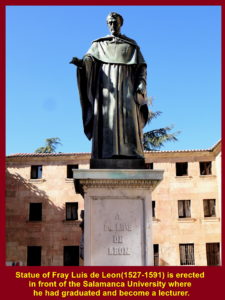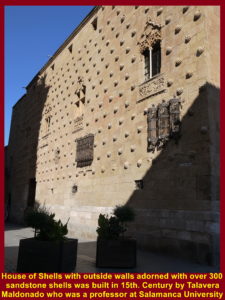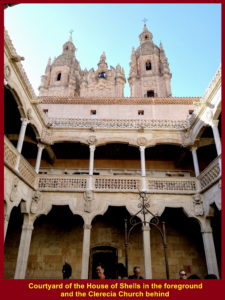Turkey Travel Part VII Uchisar Valley & Kaymakli Underground City
Filed under: Turkey Travel, Uchisar Valley, Kaymakli Underground City
Day 6
Friday, 18 Oct 2019
(Continued from previous page)
Visiting Uchisar Valley and Kaymakli Underground City
As we had visited Pasabag Valley that was described on the previous page, we went to Uchisar Village and Kaymakli Underground City then.
Map below shows the four places in Cappadocia we visited on 18 Oct 2019: Pasabag Valley, Uchisar Valley, Kaymakli Underground City and Goreme Valley.
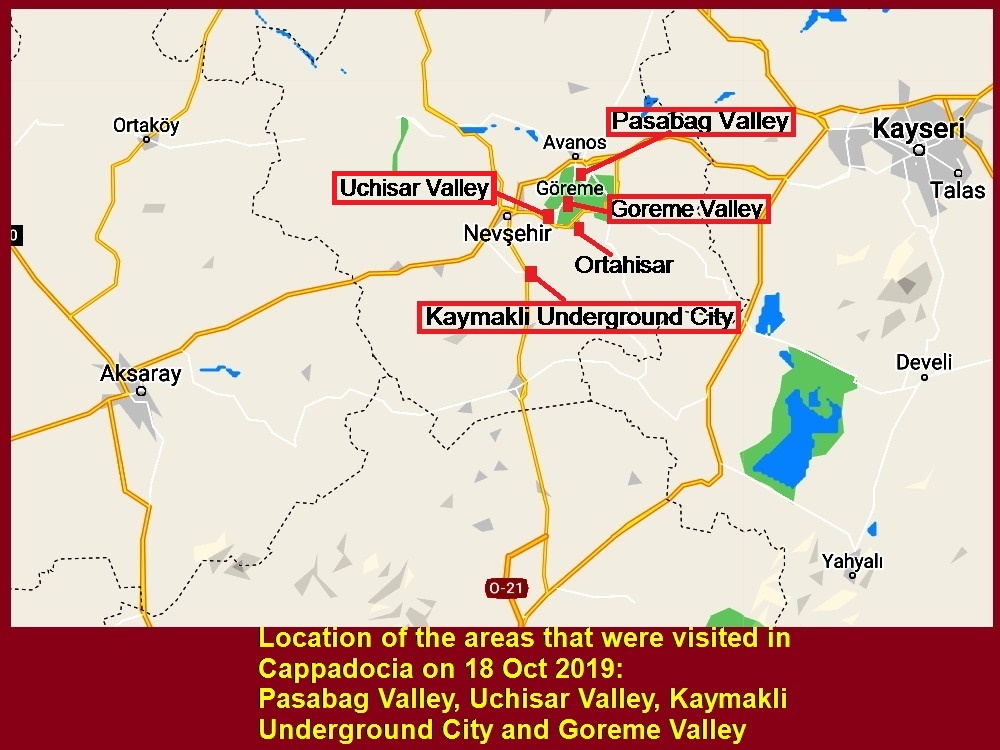
Uchisar Kaya Hotel
At 12.30 p.m. we arrived at a restaurant of Uchisar Kaya Hotel and had a simple lunch.
Writer’s simple lunch at Uchisar Kaya Hotel, Uchisar, Cappadocia, Turkey
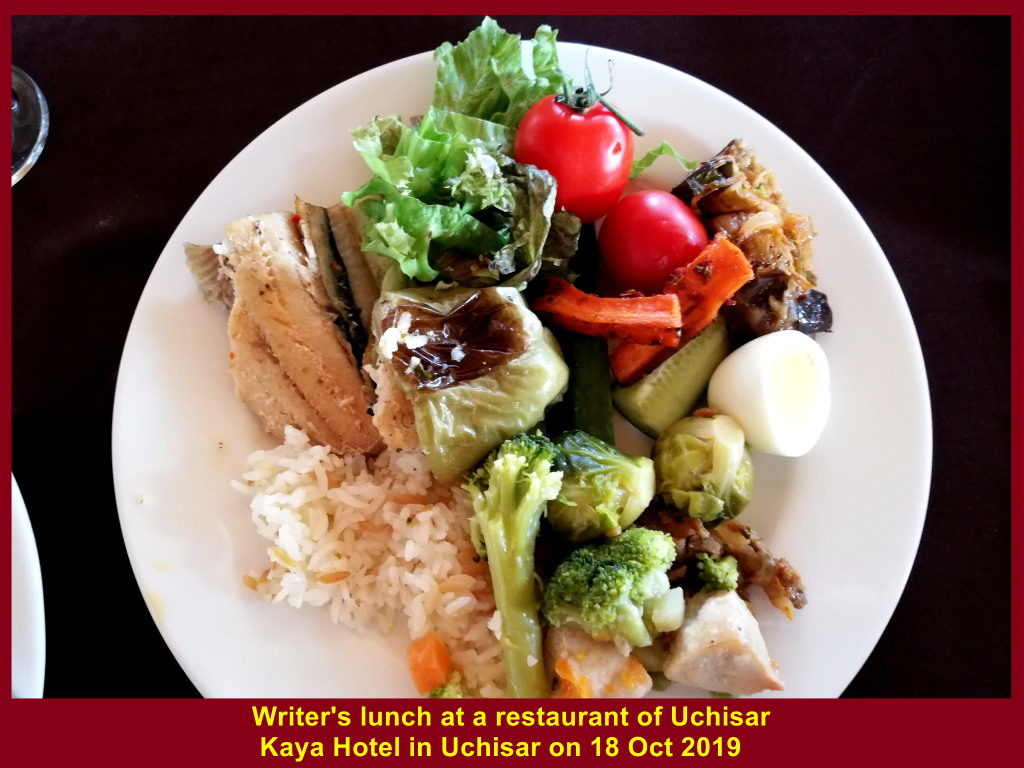
Uchisar Valley
After lunch we looked at a valley behind the hotel. Known as Uchisar Valley, the view of the valley is breathtaking. There are holes that have been dug into rocks and people lived in them like their homes in the olden days.
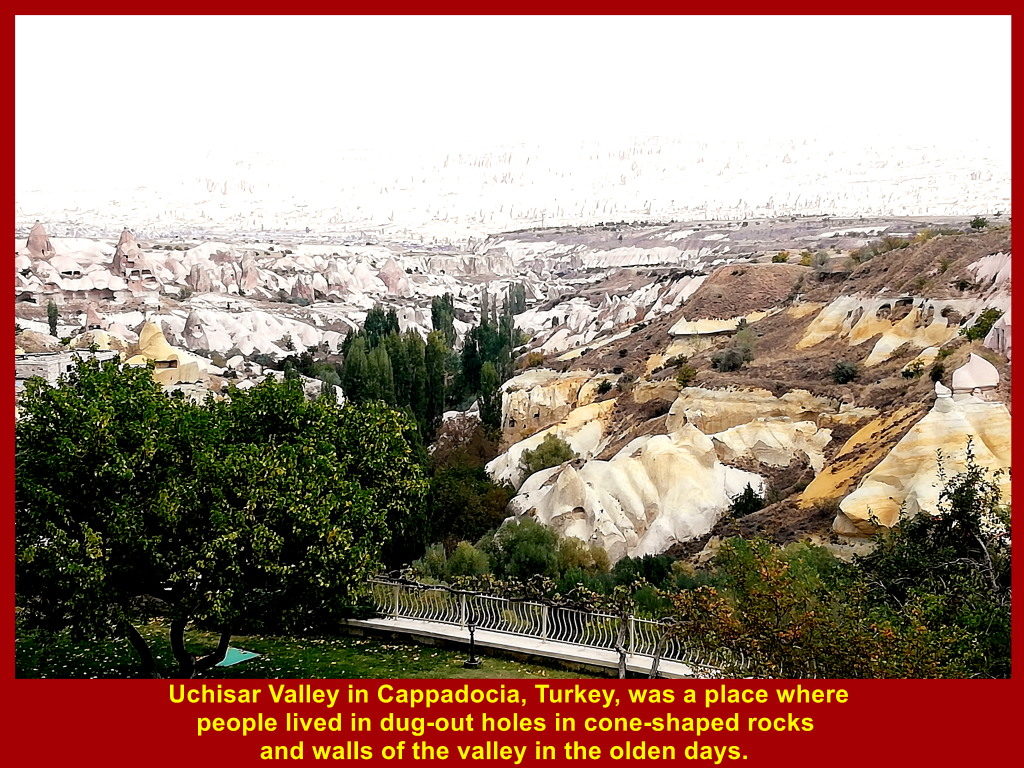
Valley of the Dovecotes or Pigeon Valley
Further up the valley there are holes dug into the walls of the valley. It is known as Valley of the Dovecotes or Pigeon Valley. They are meant for pigeons to stay, literally. The birds provided eggs and fertiliser for the hole-dwellers in the olden days.
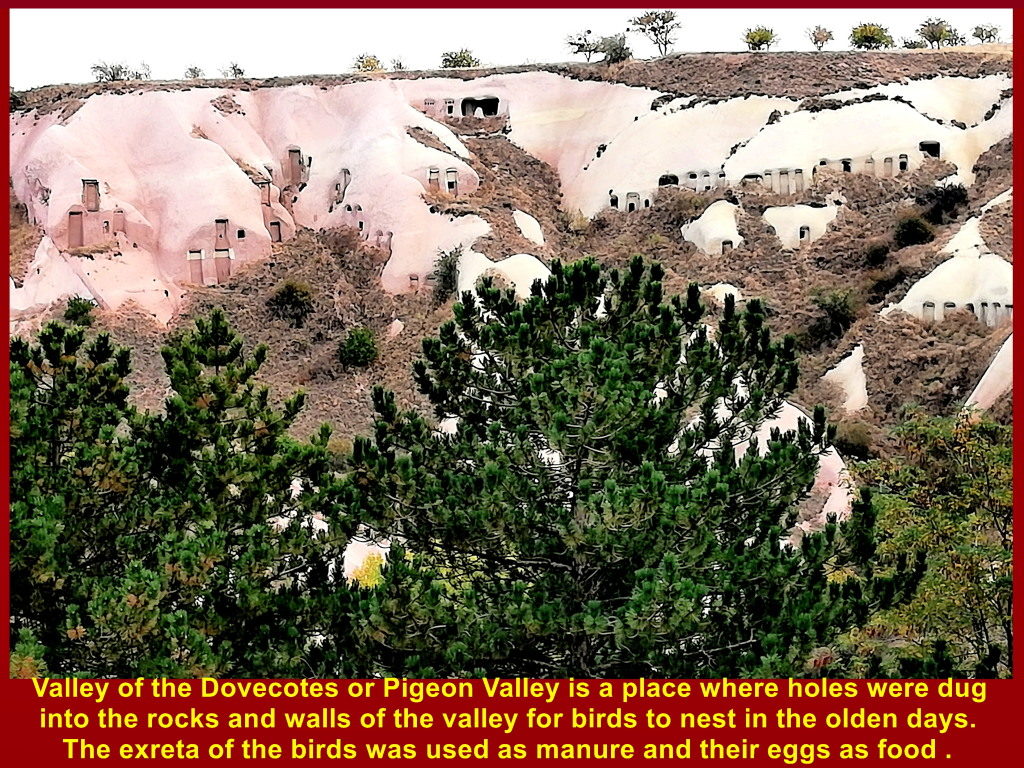
Hotels in Holes of Rocks
Nowadays, there are some holes which are still occupied by people in the Uchisar Valley. A few of them become hotels.
Rock-dwellers on the slope of Uchisar Valley in Cappadocia, Turkey
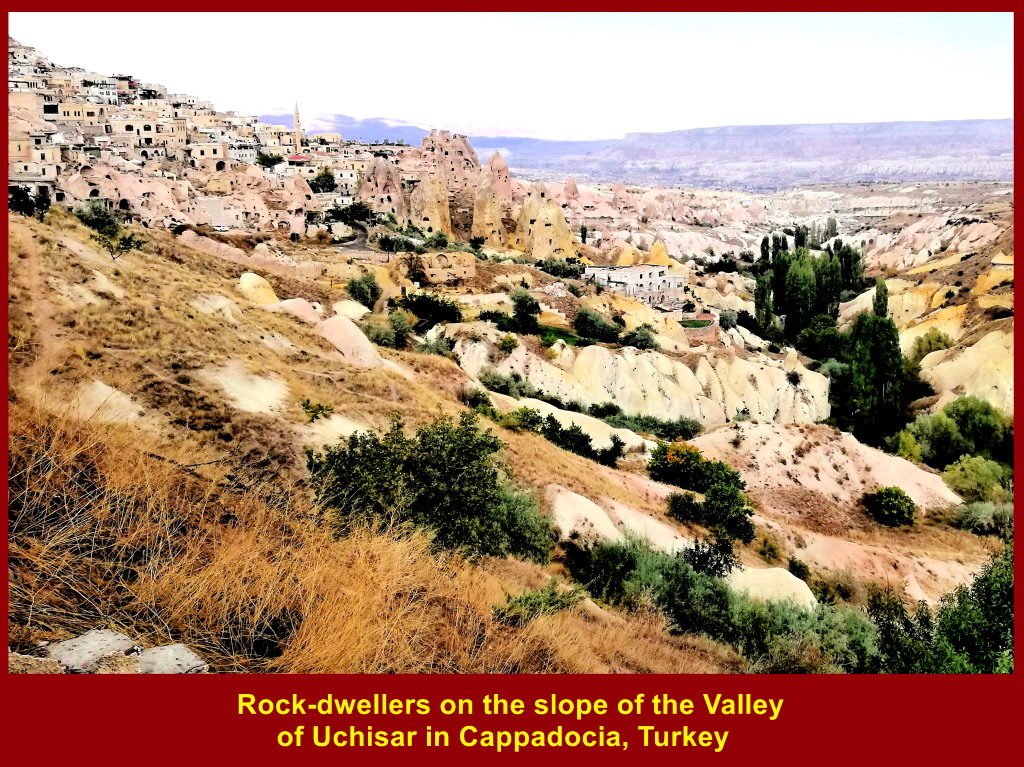
A hotel in Uchisar Valley for visitors to stay and explore the beautiful landscape as shown in the photo below
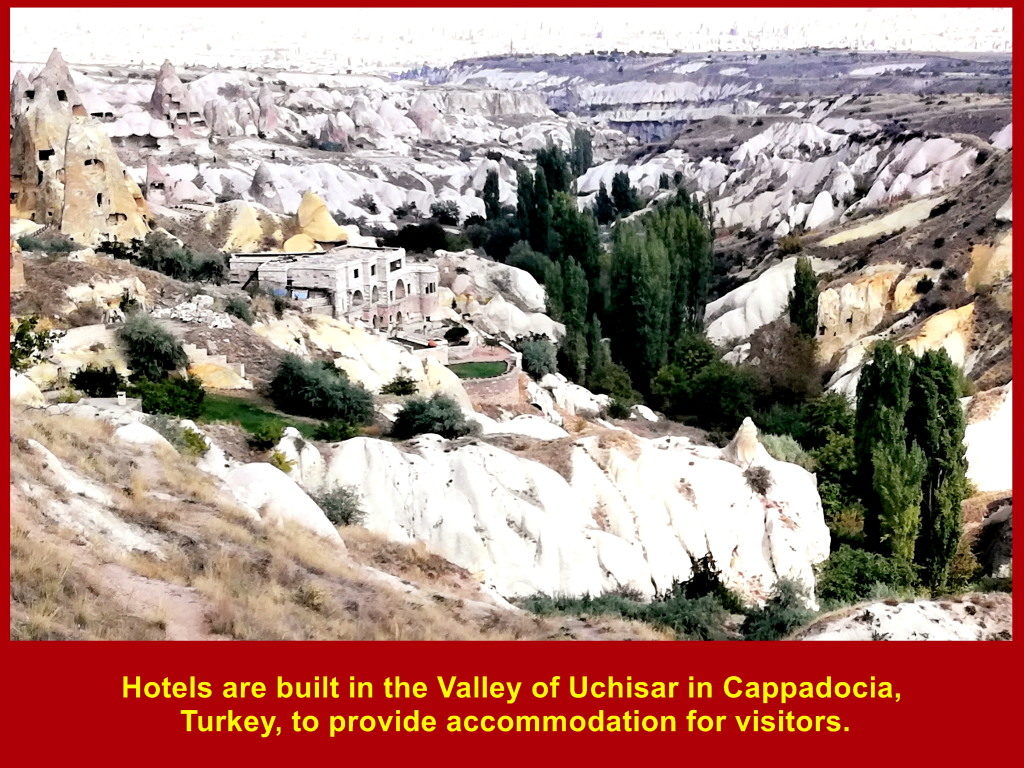
Uchisar Castle
A high, unusual hill in Uchisar Valley known as Uchisar Castle had hundreds of people living inside in the olden days.
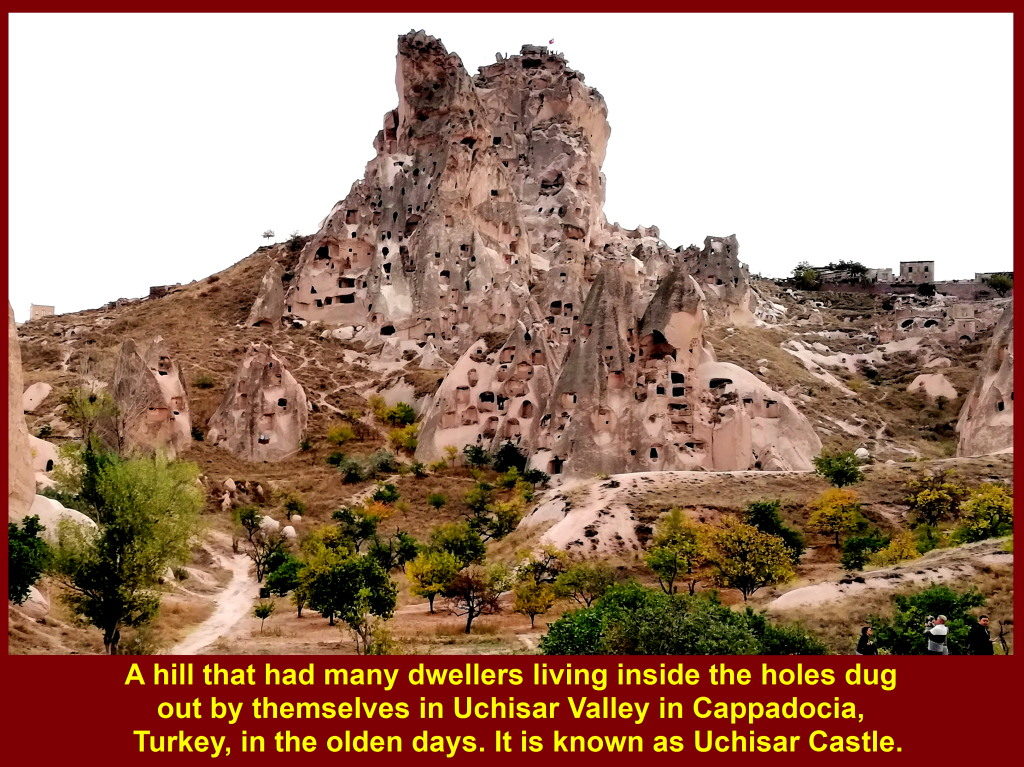
Underground Cities in Kaymakli
After spending an hour at the Uchisar restaurant and looking at the awesome landscape of Uchisar Valley, we left and travelled to Kaymakli where there are many abandoned underground cities. Researchers have estimated the number to be over 150.
Inhabitants built and lived in the underground cities to hide themselves from attackers in the olden days.
Kaymakli Underground City
We visited one of them and it is known as Kaymakli Underground City in Cappadocia on 18 Oct 2019.
There is an entrance to Kaymakli Underground City where visitors pay a fee to enter.
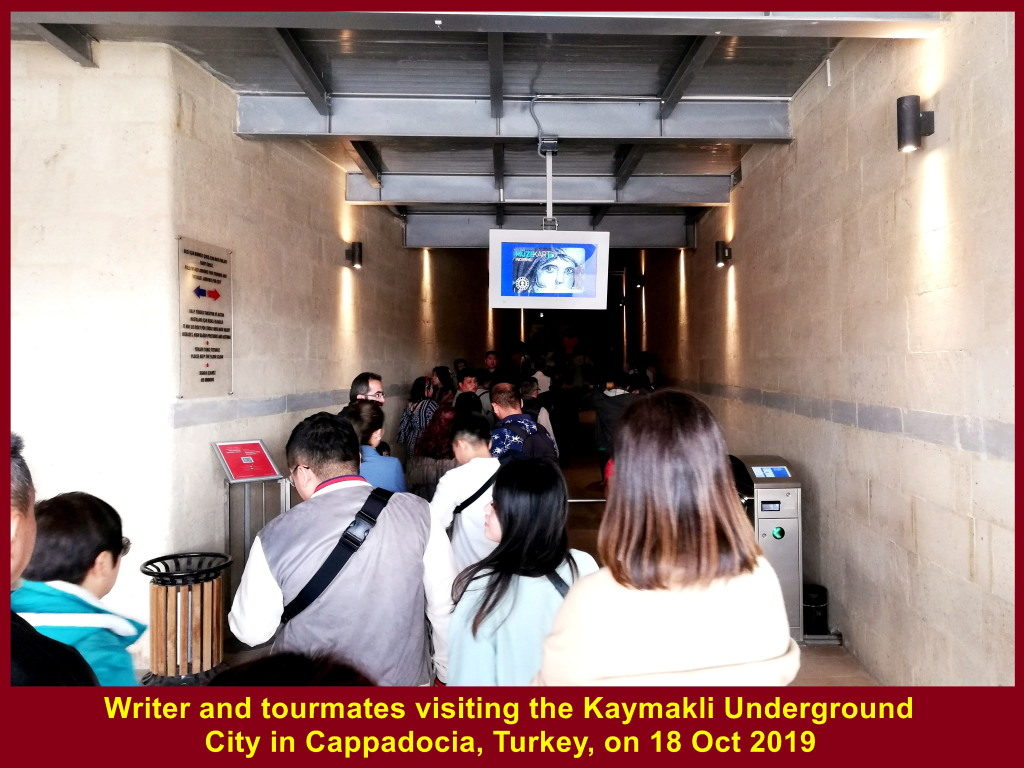
Below are photos showing some of the underground legacies left behind by the inhabitants of the olden days.
(i) The passages or tunnels in the underground city are narrow. Some of them are low.
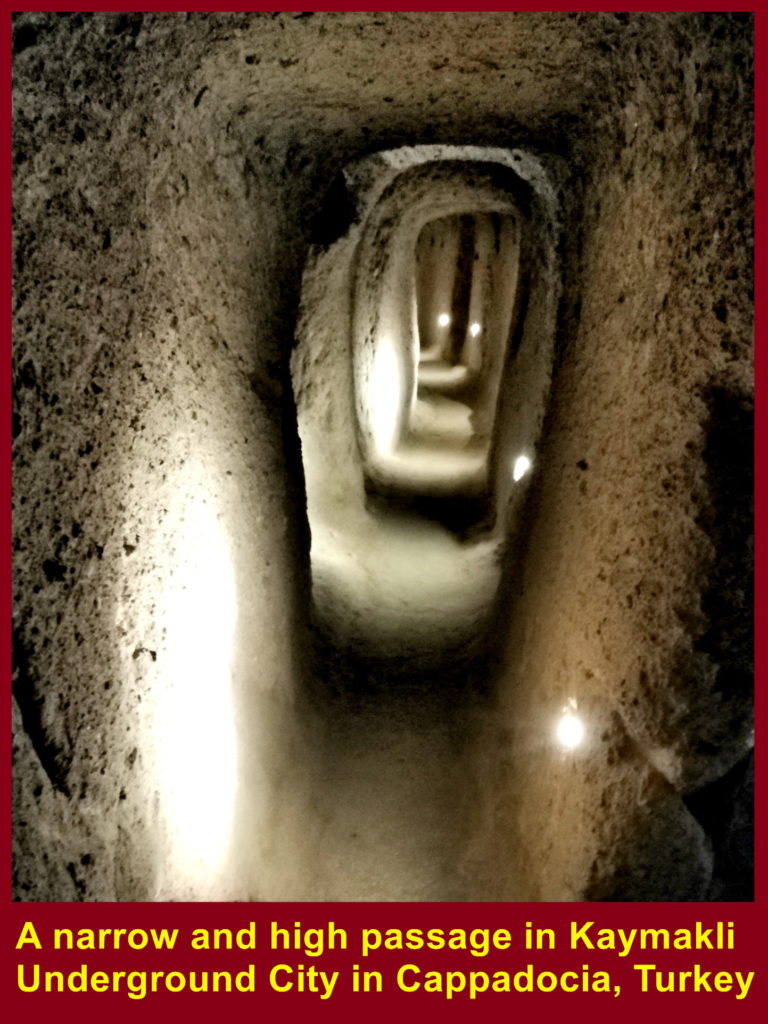
(ii) To go through this small and low passage, a visitor has to bend his knees and walk, otherwise their heads will get a few bumps.
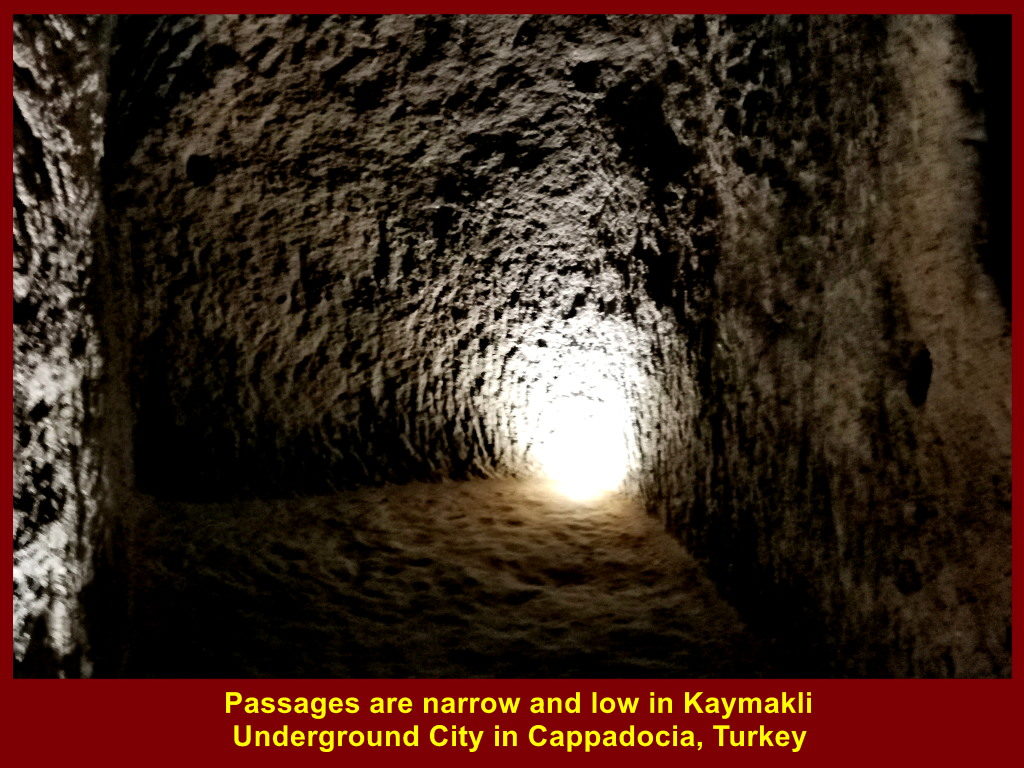
(iii) Writer and tourmates walked done the narrow steps to the lower level very slowly and cautiously.
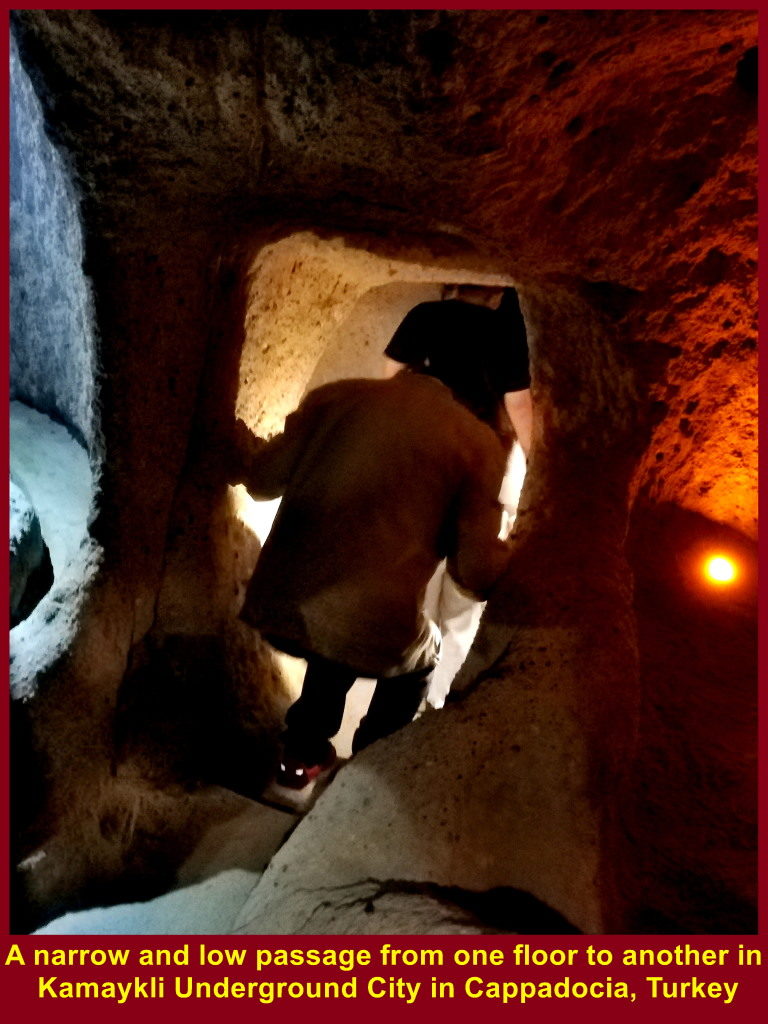
(iv) Judging by the narrow passages and steps in the underground cities, I guess the inhabitants were small and slim in the olden days.
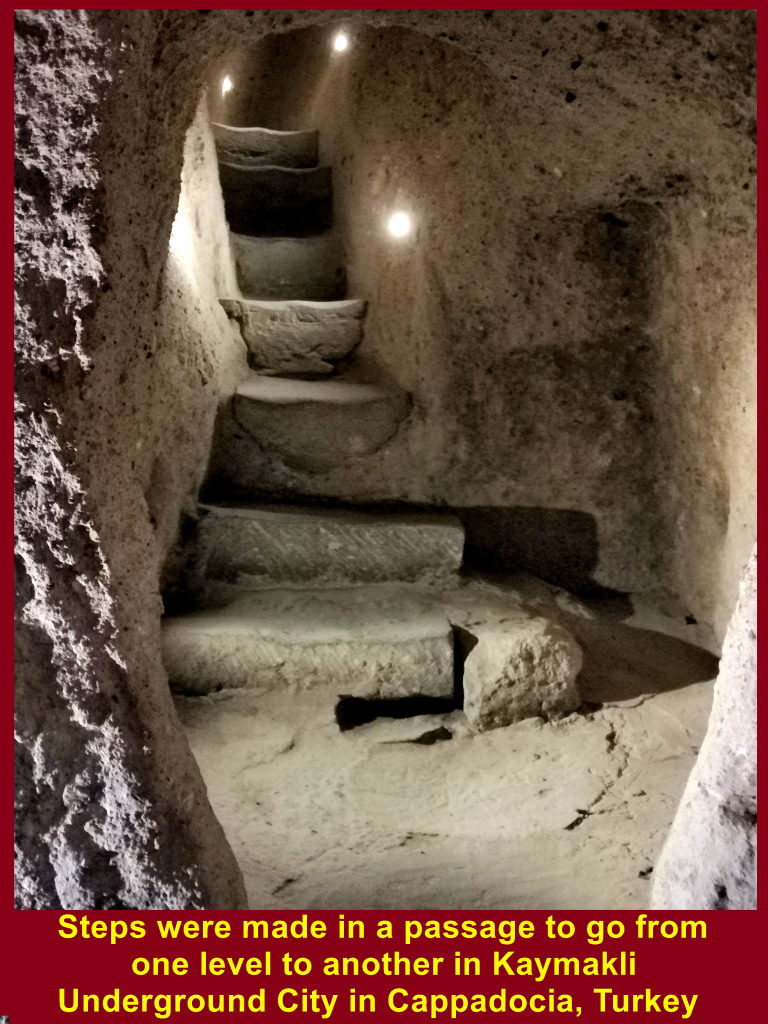
(v) A small hole in a wall was used for communication from room to room in the olden days.
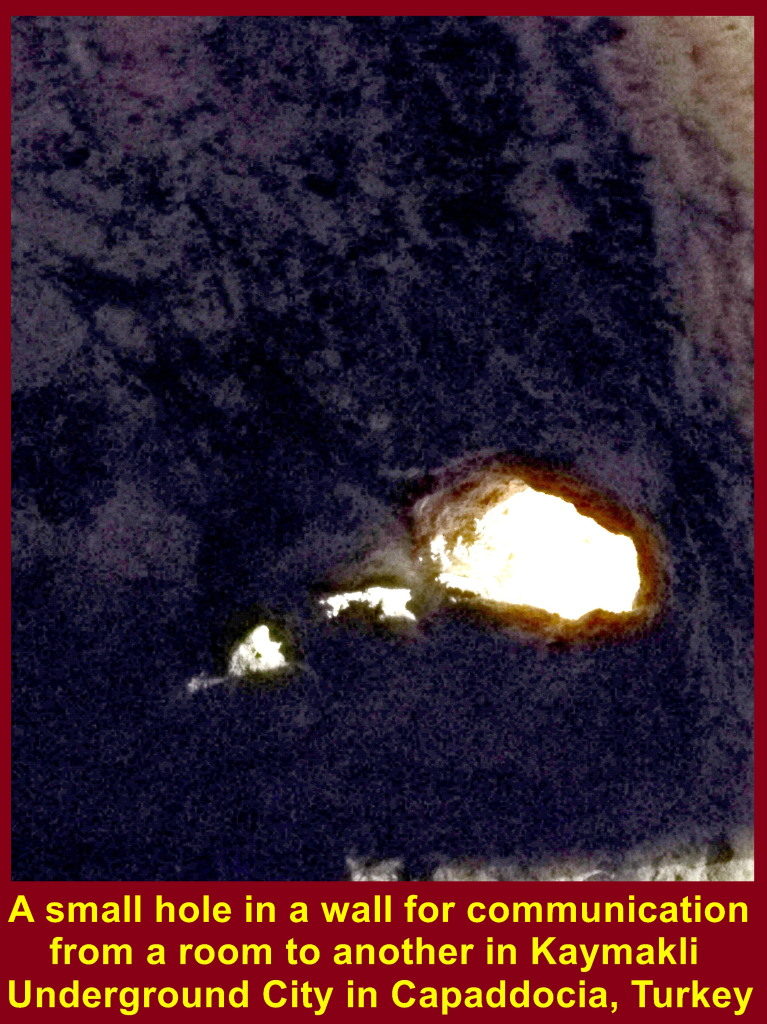
(vi) Holes made through floors were for communication from floor to floor.
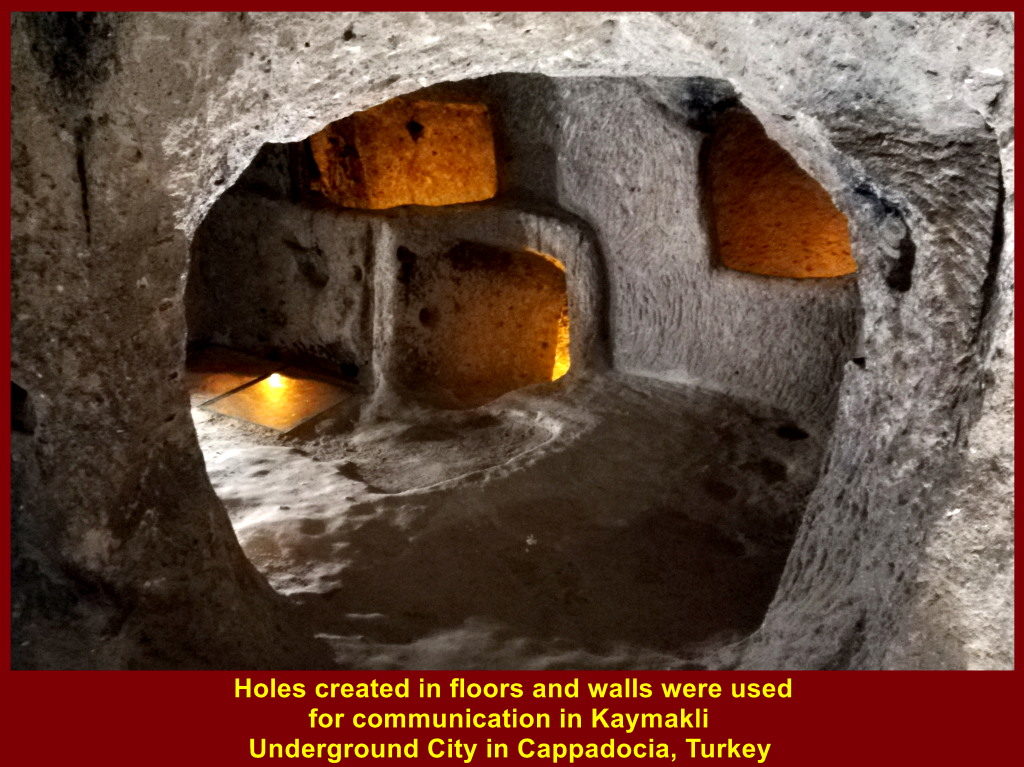
(vii) A narrow door between rooms
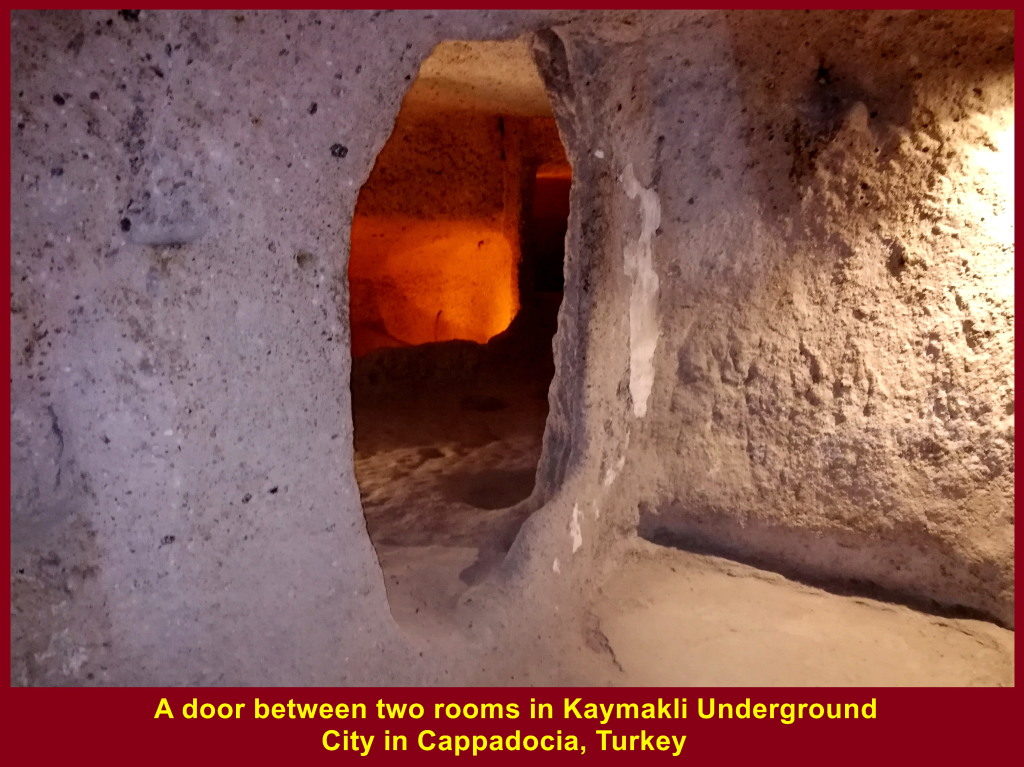
(viii) A stable for domesticated animals on the first floor of the underground city
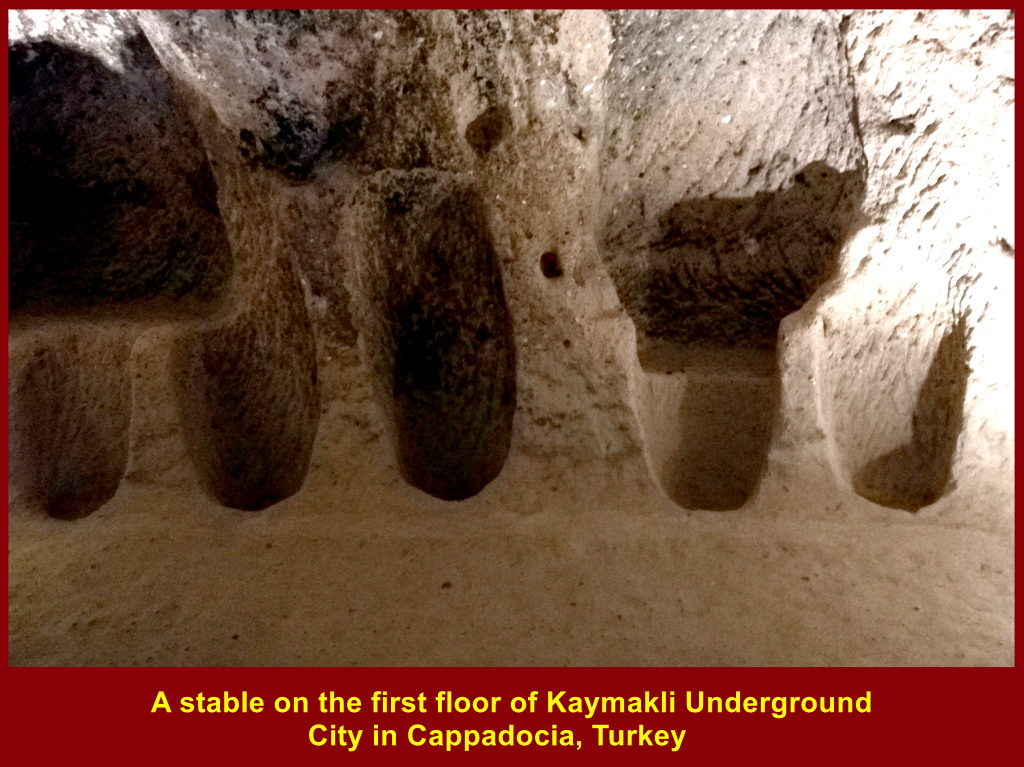
(ix) A church and a graveyard which was next to it are on the second floor.
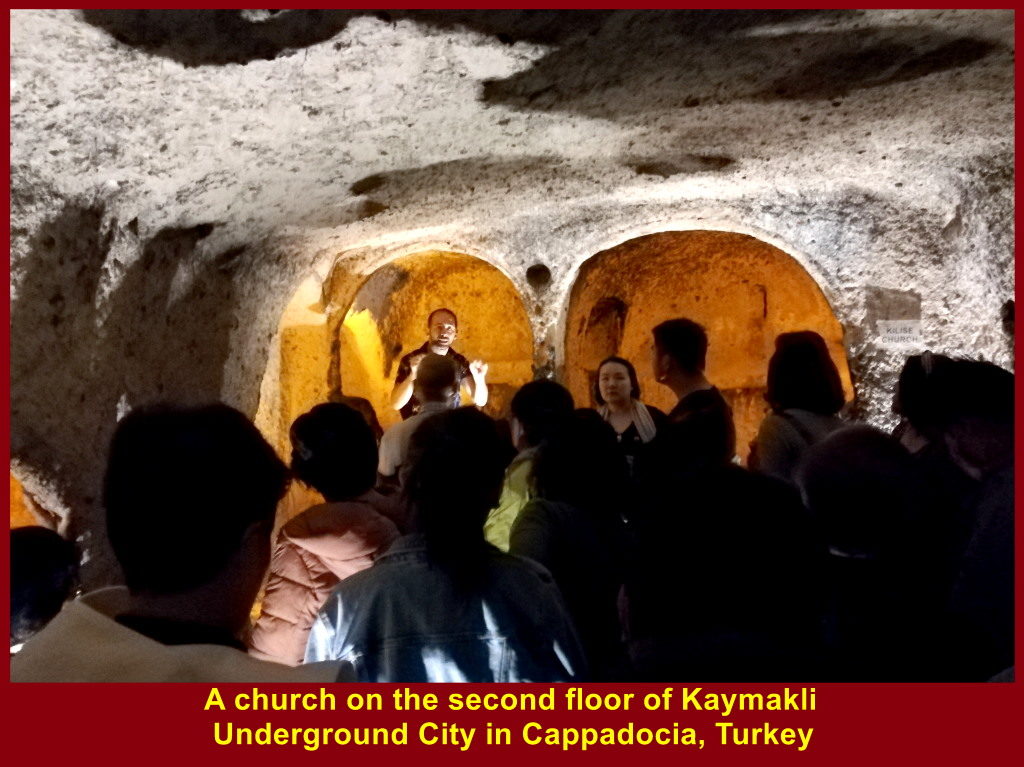
(x) A room on the 3rd floor that was used for winery, kitchen, food storage or other purposes in the underground city
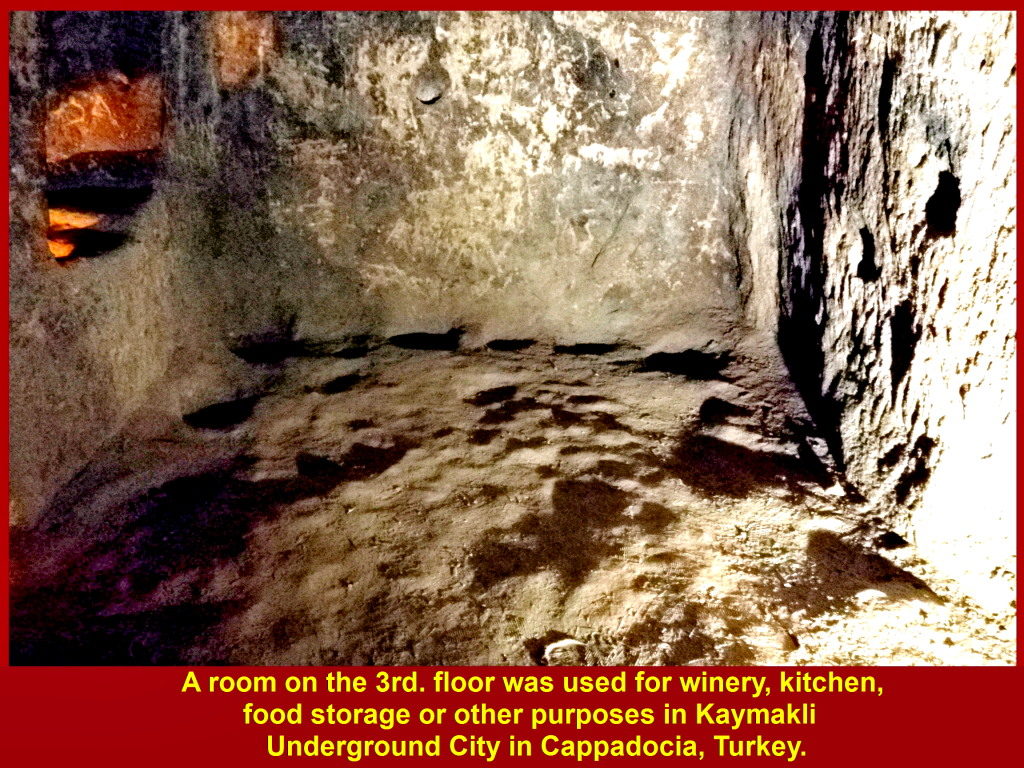
(xii) A storage space for wine or other foodstuff on the third floor in the underground city
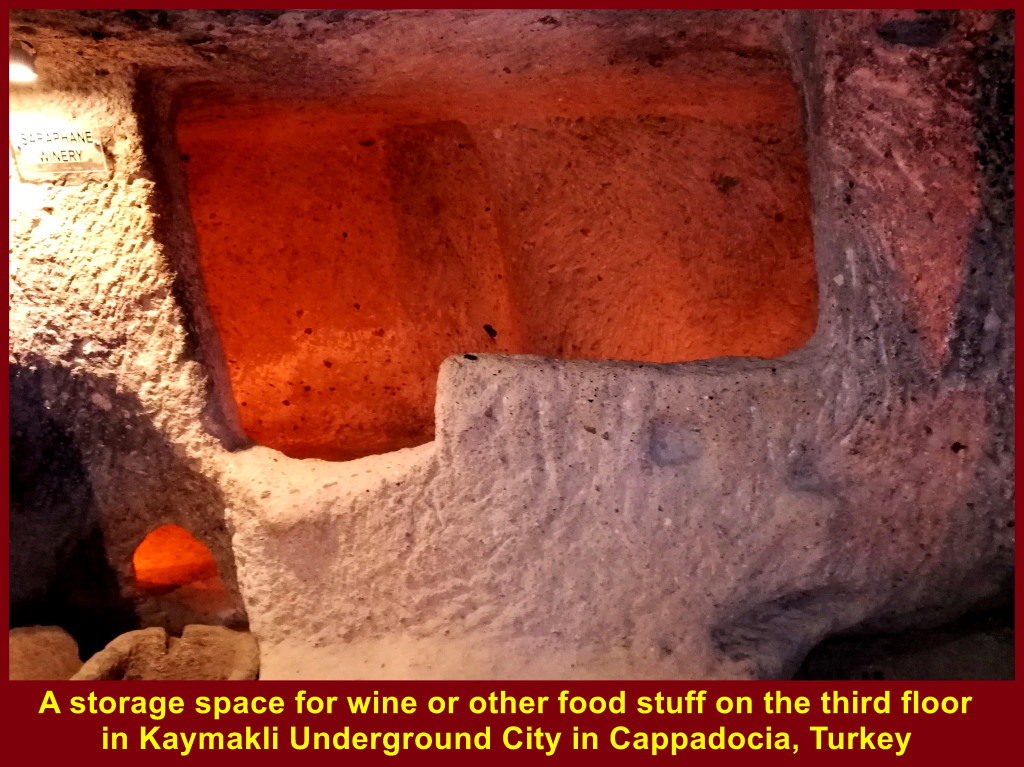
(xiii) A stone with holes on the 3rd. floor was used for processing copper in the olden days.
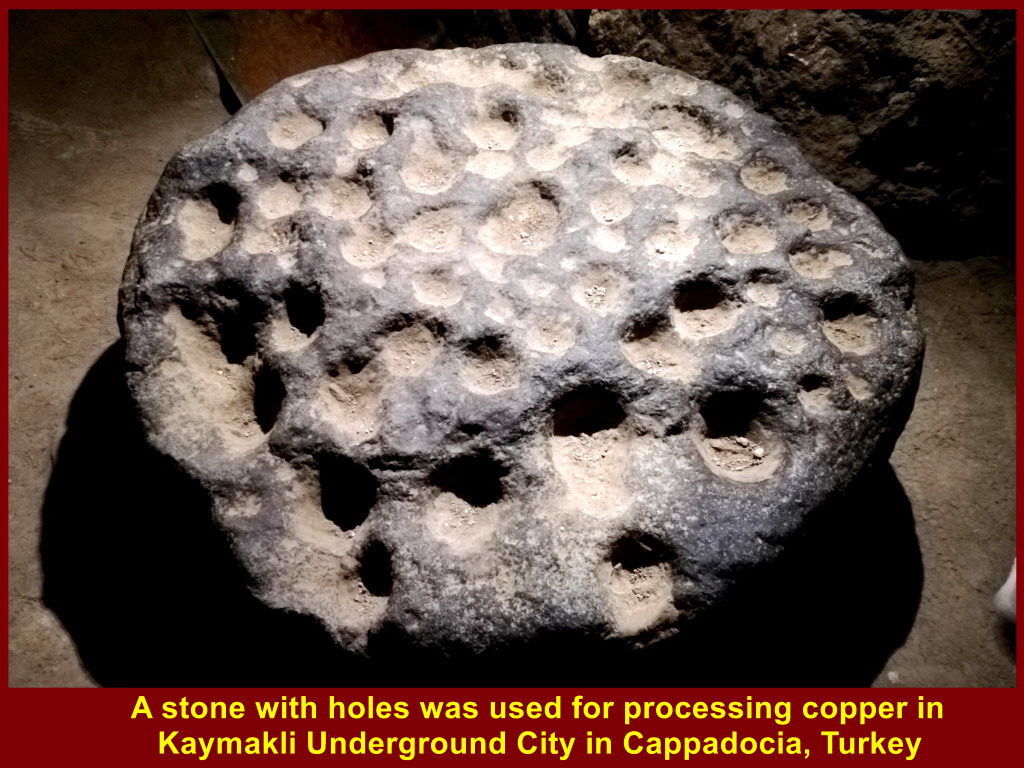
(xiv) A millstone for grinding grains on the first floor
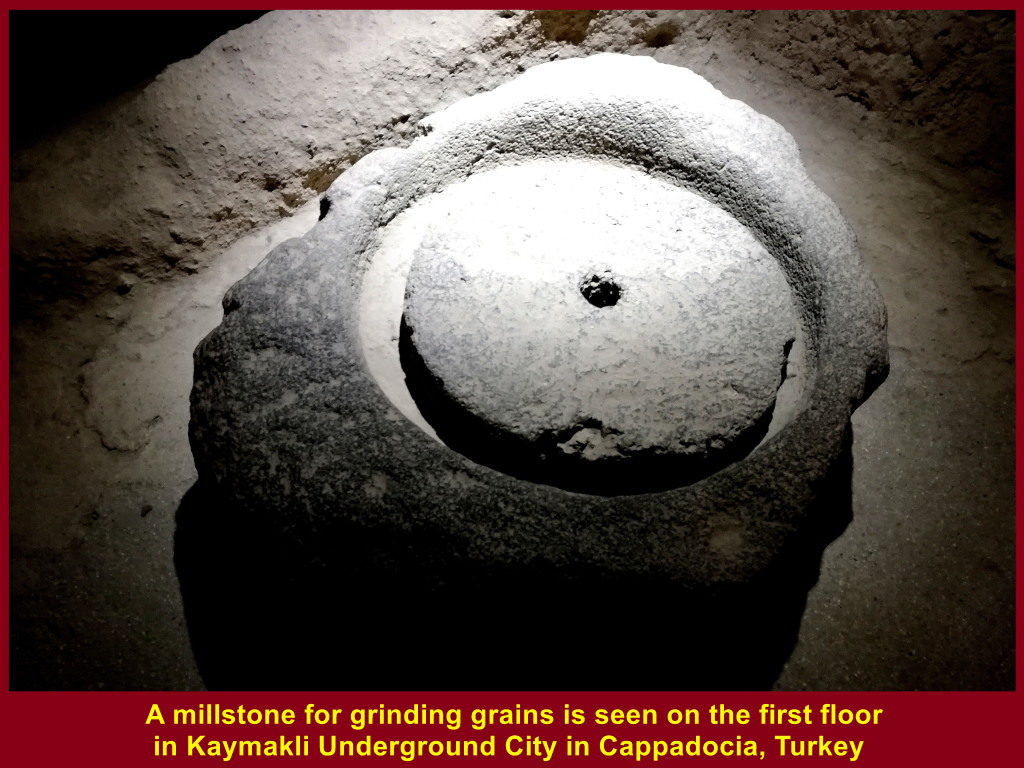
8 underground floors
The Kaymakli Underground City has 8 underground floors but only four of them are open to public.
Judging by the size of the city, I guess there were several thousands of people living in it in the olden days.
Gerome Valley
Then we went to another valley known as Gerome Valley which is next to Uchisar Valley.
Previous Page / Home / Next Page
Places visited during Turkey Tour(13-22 Oct 2019):
Trojan Horse/Ancient Troy Cities Asklepion Ephesus Hierapolis/Pamukkale Travertine Sultanhani Caravanserai Pasabag Valley Uchisar Valley/Kaymakli Underground City Gerome Valley/Turkish Night Show Hot Air Balloon/Lake Golu/Anitkabir Hagia Sophia/Topkapi Palace/Blue Mosque Bosphorus Boat Cruise Spice Bazaar/Grand Bazaar
Turkey Travel Part VIII: Gerome Valley & Turkish Night Show
Filed under: Gerome Valley, Turkish Night Show, Turkey Travel
(Continued)
Day 6
Friday, 18 Oct 2019
Visiting Gerome Valley
As we had visited Uchisar Valley and Kaymakli Underground City that were described on the previous page, we went to Gerome Valley then. Later, we relaxed and enjoyed watching a Turkish night show at a restaurant, Evranos Restaurant, in Cappadocia in the evening.
Map below shows four places we visited on 18 Oct 2019: Pasabag Valley, Uchisar Valley, Kaymakli Underground City and Gerome Valley on 18 Oct 2019.

Gerome Valley Visit
After lunch in Uchisar, we went to another valley, Gerome Valley, nearby. It is similar to Uchisar Valley in physical features i.e. both have cone-shaped rocks.
Gerome Valley, a Christian Settlement
Gerome Valley was a place where Christians in the Byzantine Period(330-1453 AD) lived. They lived in holes cut into large cone-shaped rocks and established churches, chapels and monasteries in them.
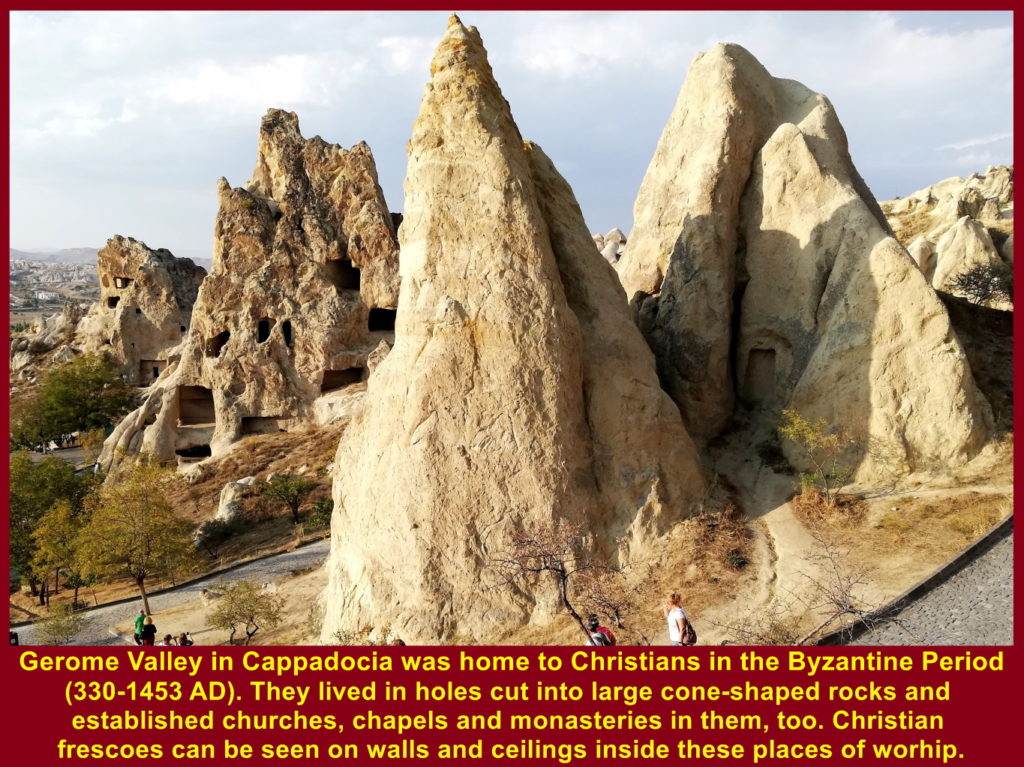
Writer and wife visited Gerome Valley on 18 Oct 2019. In the background of the photo below is a high hill known as Uchisar Castle.
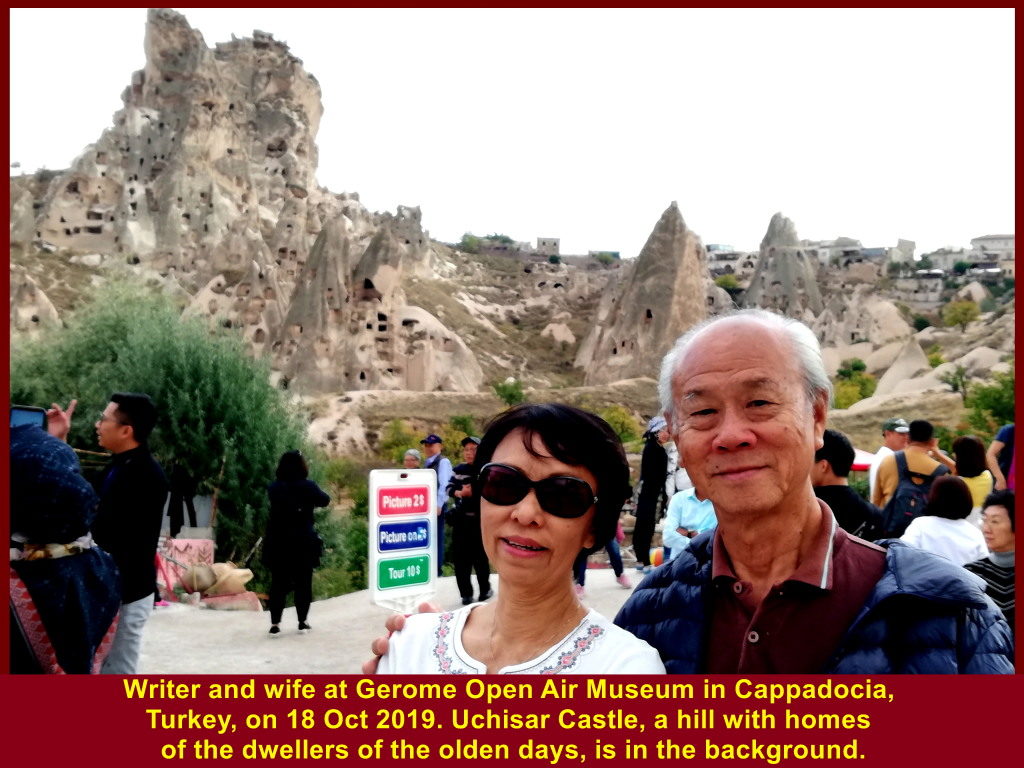
In the Gerome Valley, there is a row of abandoned churches, chapels and monasteries.
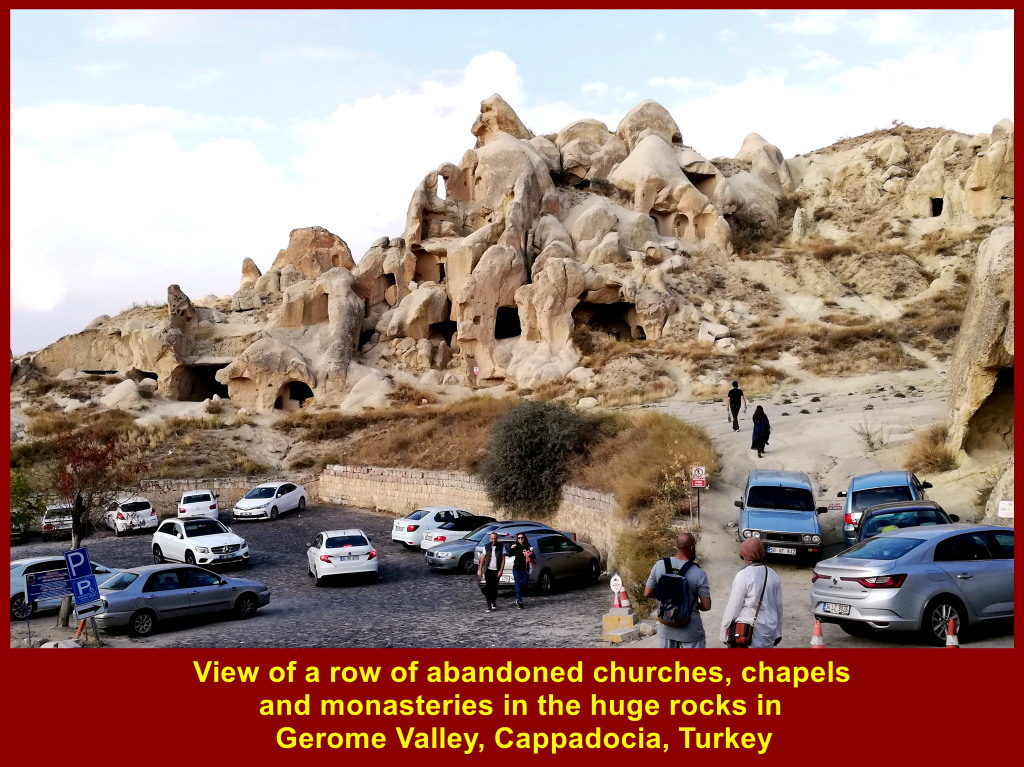
The photos below show some churches in Gerome Valley.
(i) A 7-storey “Nunnery” that housed a dining hall, kitchen and rooms on the first floor, ruined chapel on the second floor, church on the third, etc.
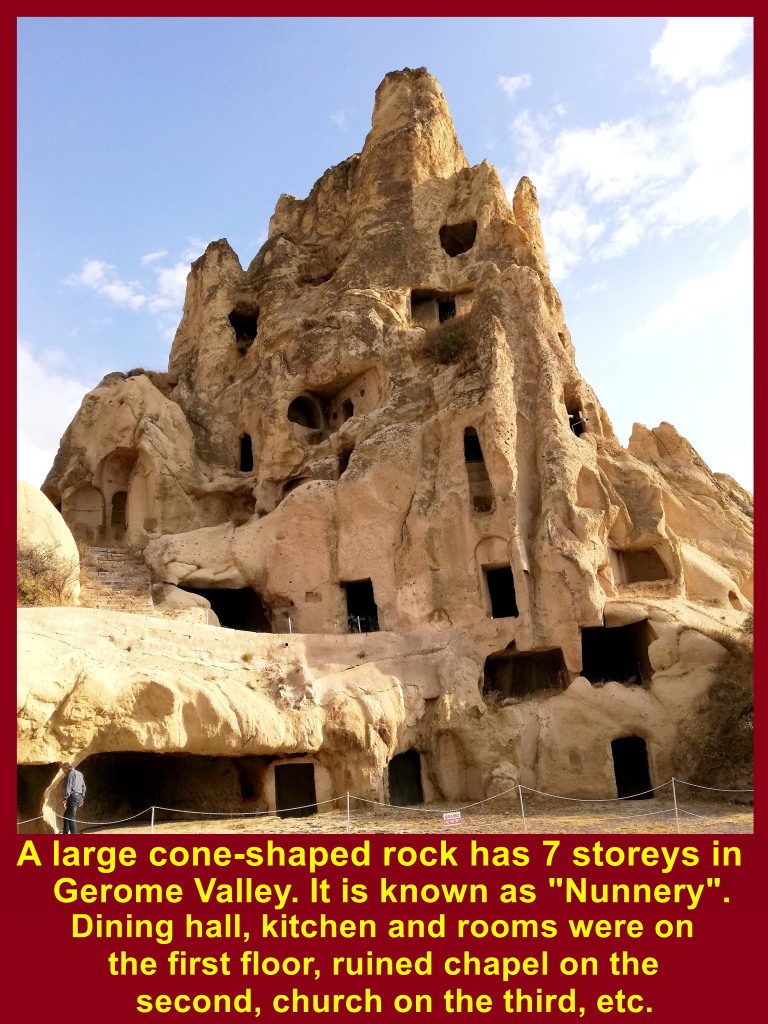
(ii) This large rock housed three rooms next to each other: Larder, Kitchen and Refectory in Gerome Valley.
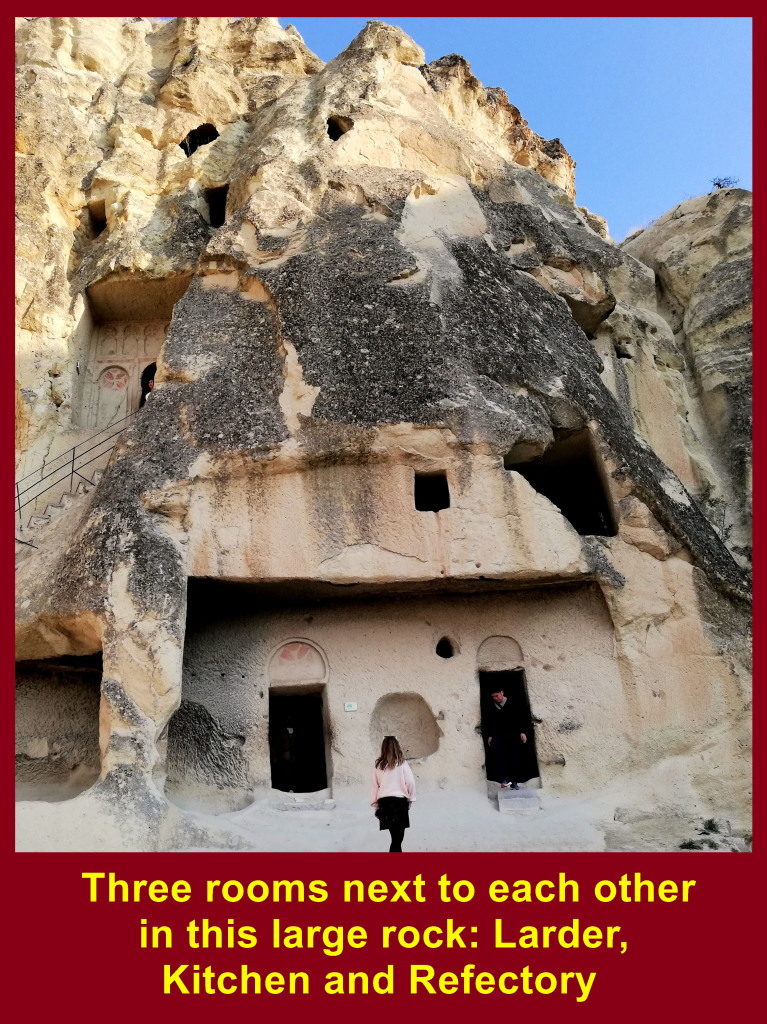
(iii) Karanilik Church in Gerome Valley
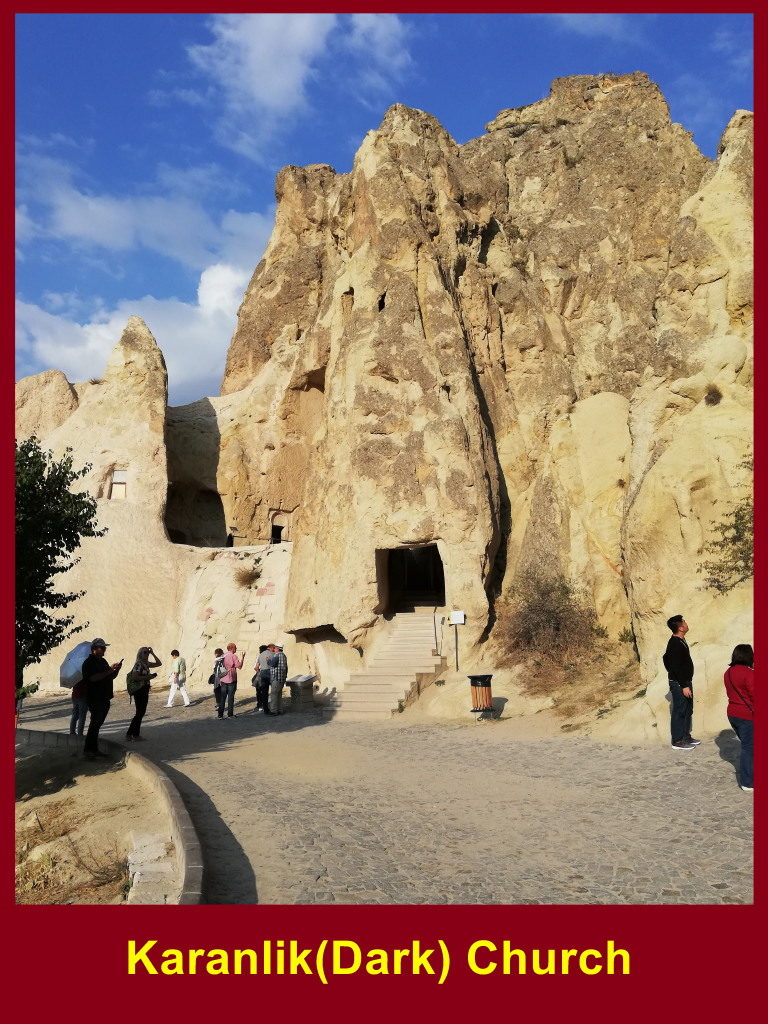
(iv) Yilani(Dark) Church of St. Onuphrius in Gerome Valley
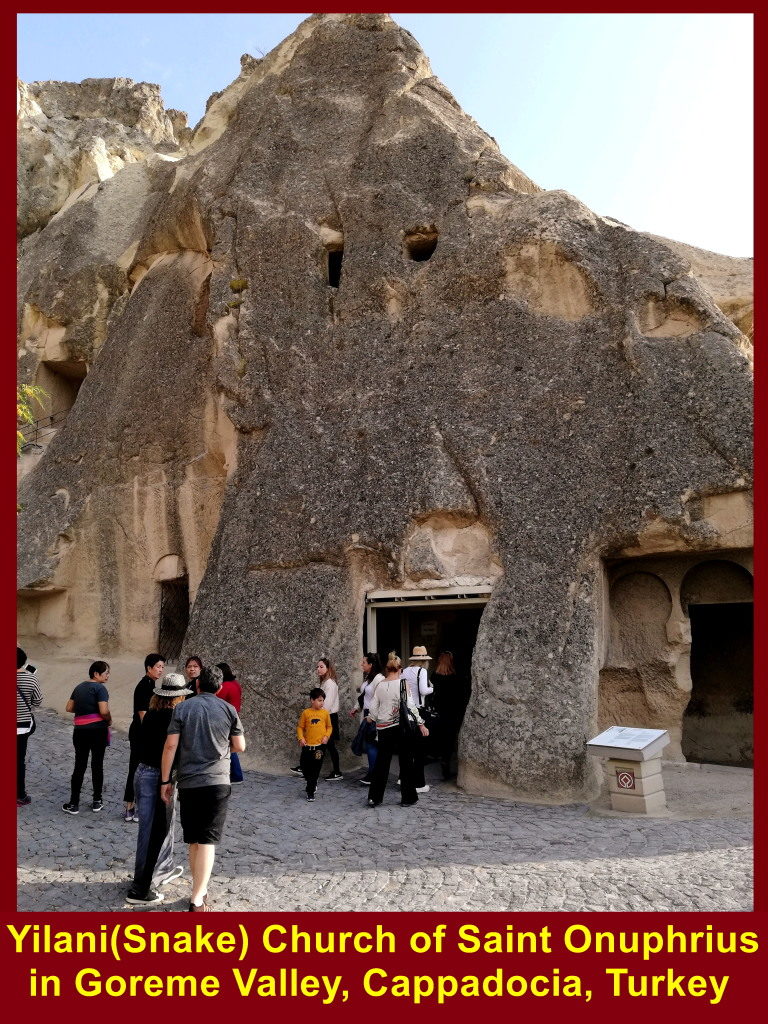
(v) Church of Tokali(Buckle) in Gerome Valley

(vi) A staircase outside a church in Gerome Valley
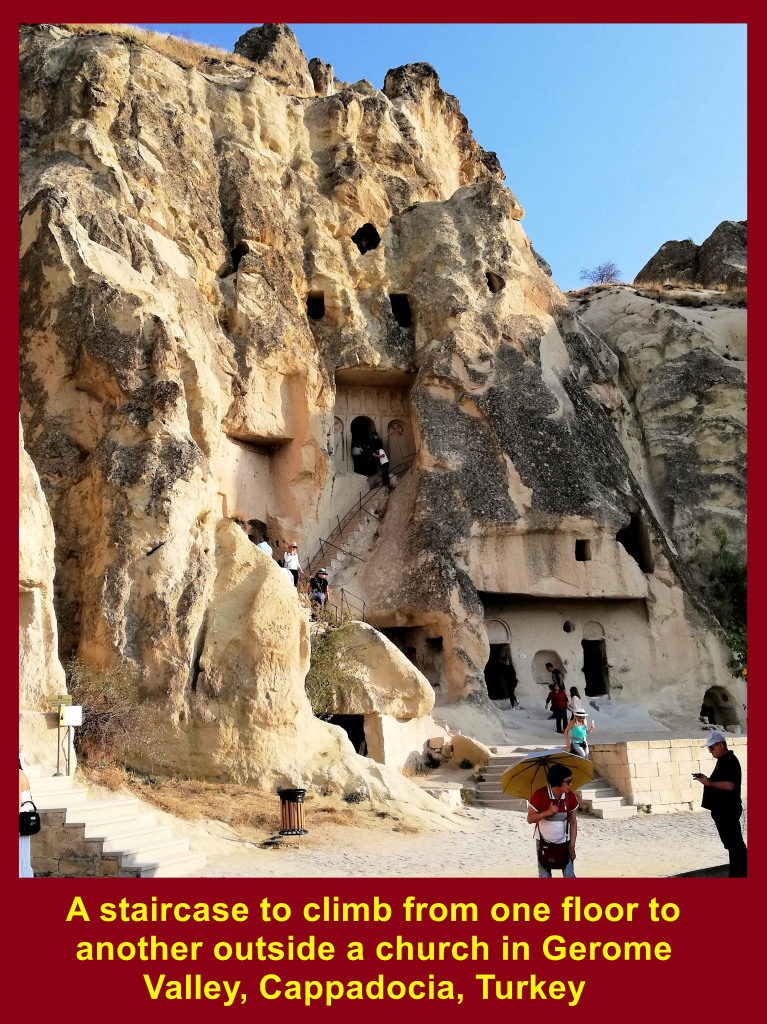
(vii) Close-up view of a staircase outside the church in Gerome Valley
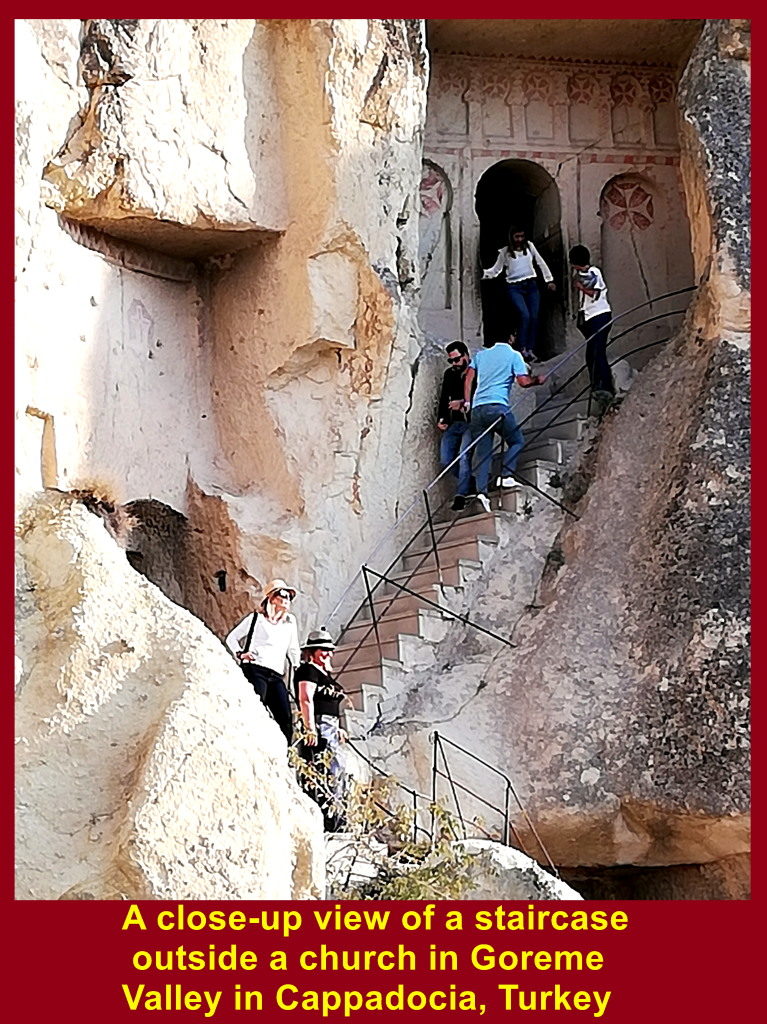
(viii) A chapel in a church in Gerome Valley
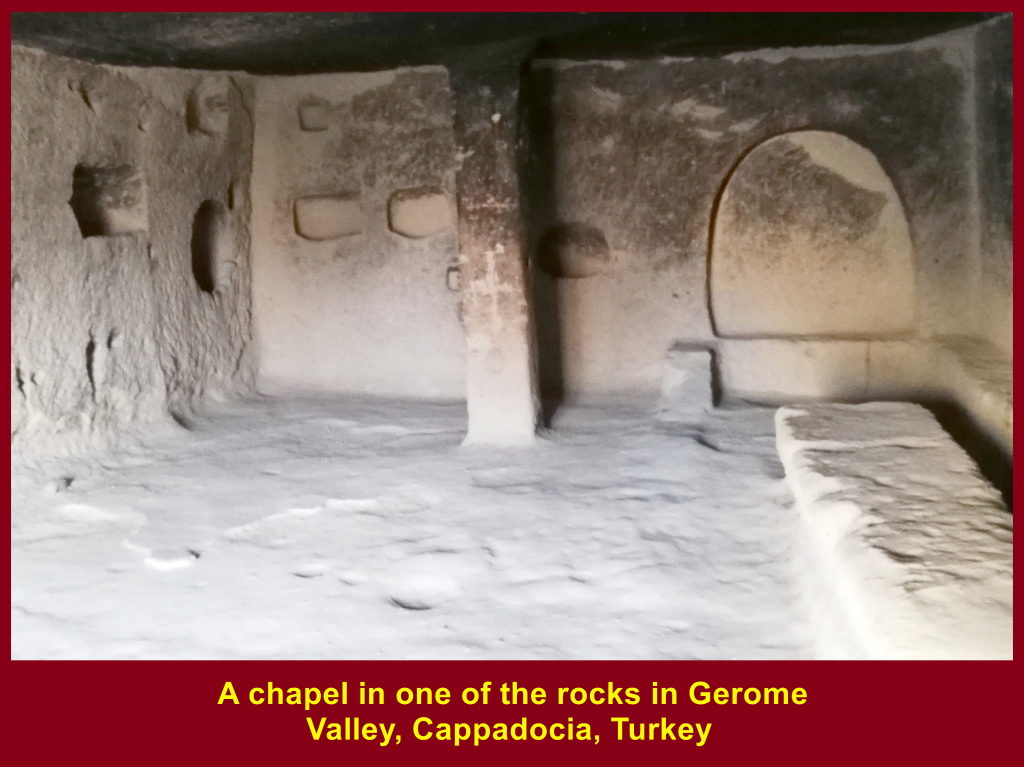
(ix) Most of the churches in Goreme Valley had frescos of Christian figures on the walls and ceilings. The photo below shows some of them found inside the churches.
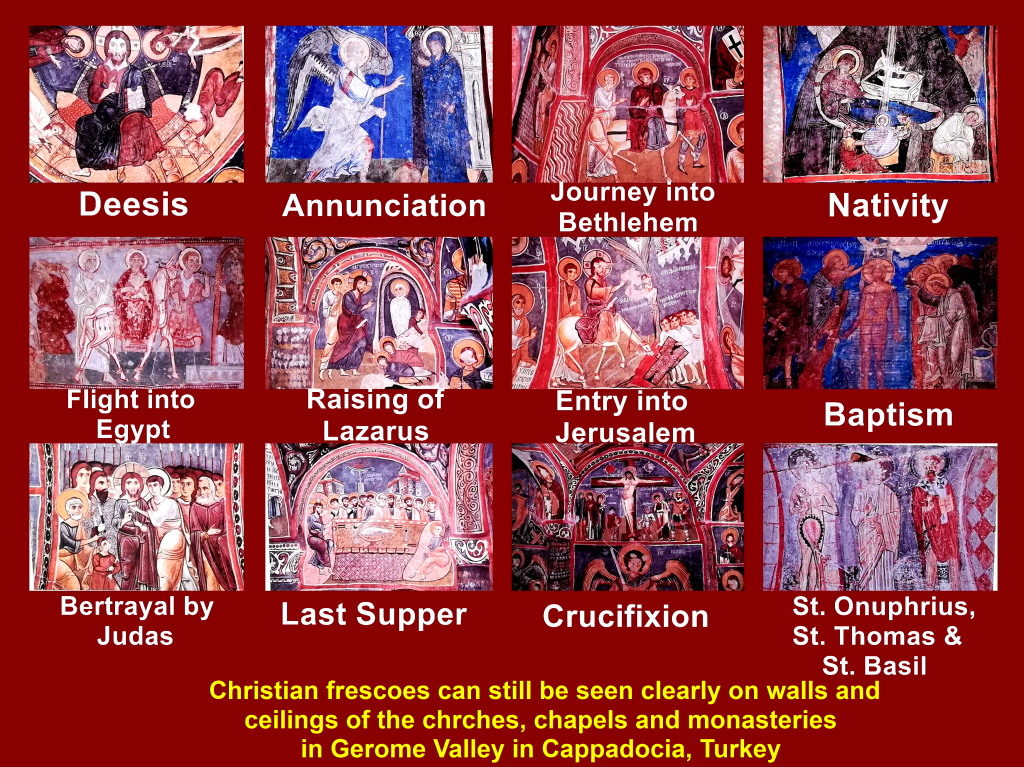
(ix) A dweller’s home in a rock in Gerome Valley in the olden days
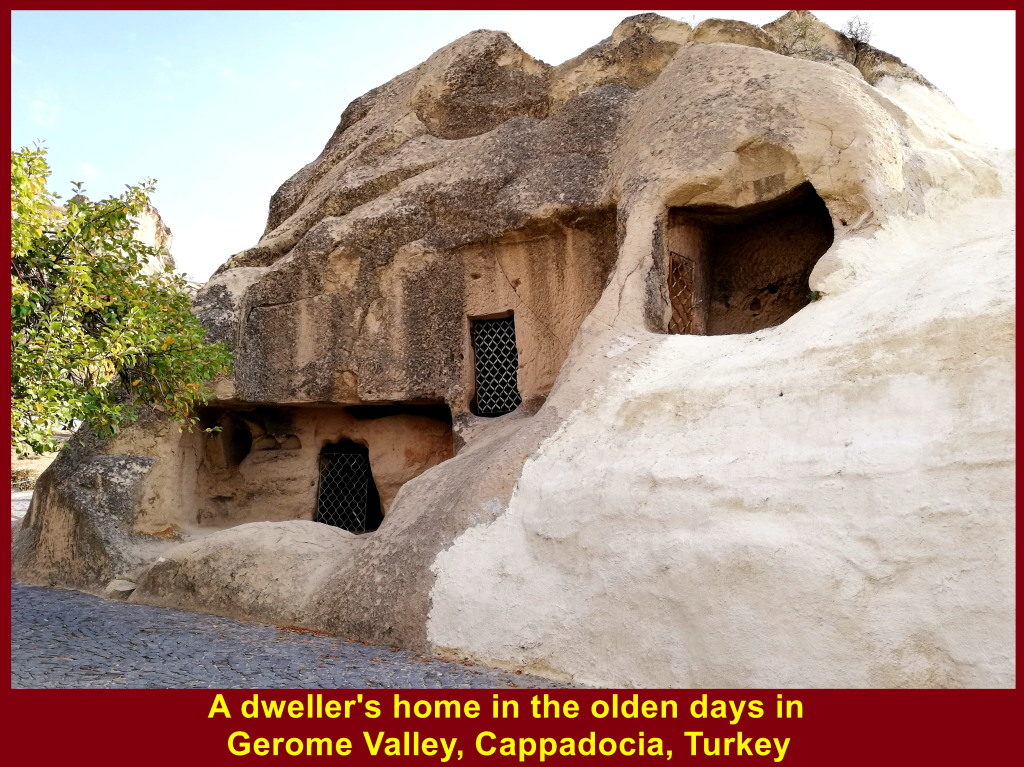
Evranos Restaurant
In the evening writer and tourmates went to a restaurant, Evranos Restaurant, in Cappadocia, Turkey, to dine and watch a Turkish Night show.
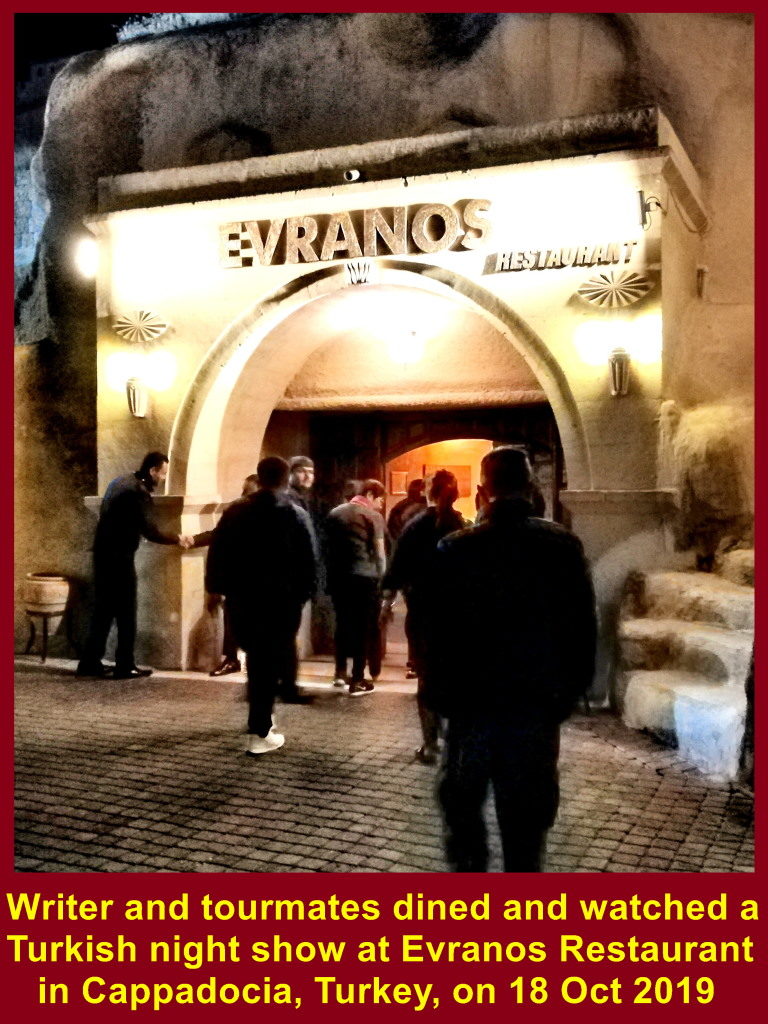
Turkish Night Show
Writer and tourmates were waiting, patiently, for the Turkish show to start at Evranos Restaurant in Cappadocia, Turkey, on 18 Oct 2019.
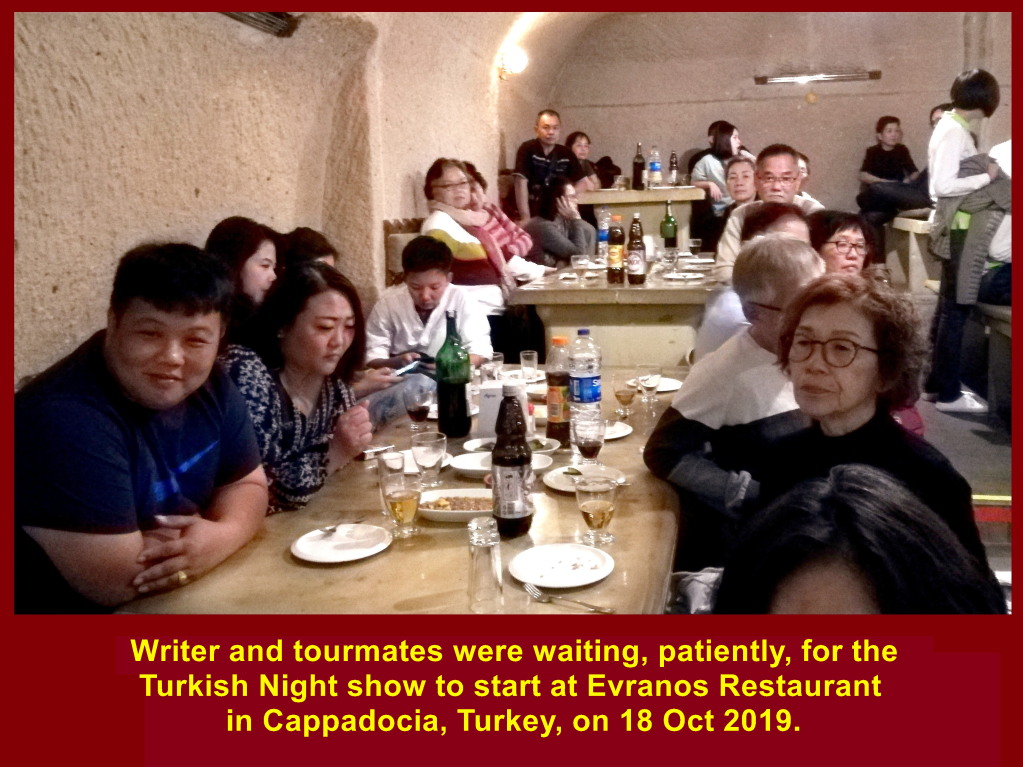
Foreign guests were also waiting, patiently, for the Turkish Night show to start at Evranos Restaurant in Cappadocia, Turkey, on 18 Oct 2019.
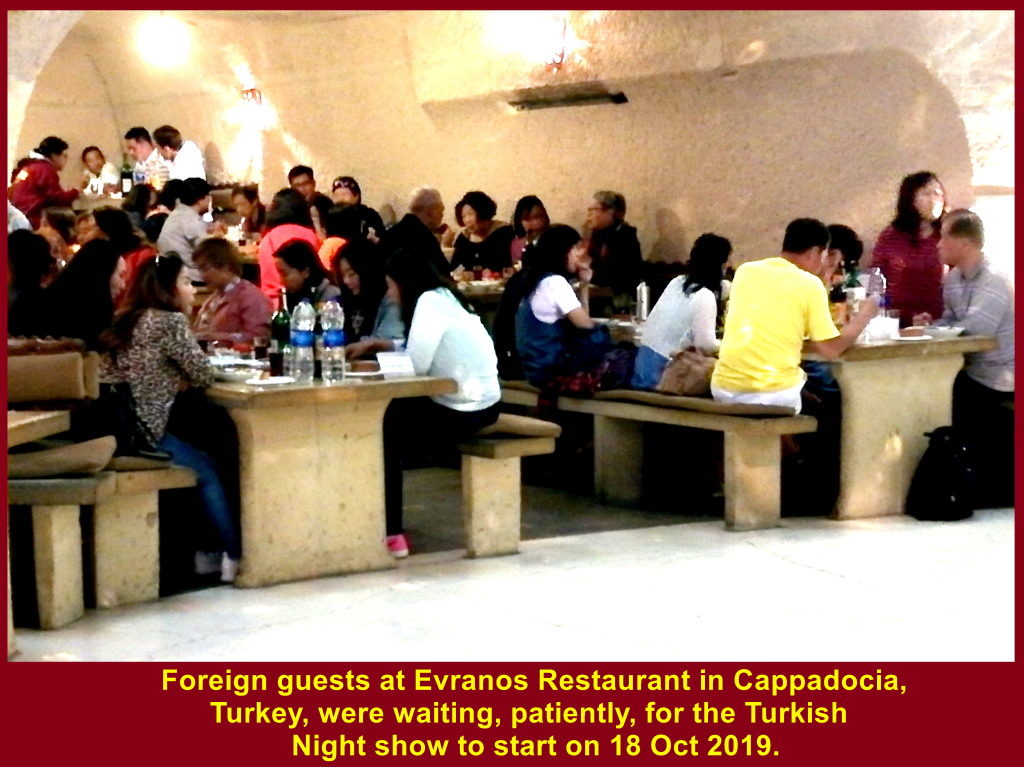
Three elderly Turkish musicians of the restaurant were playing musics before the show began.
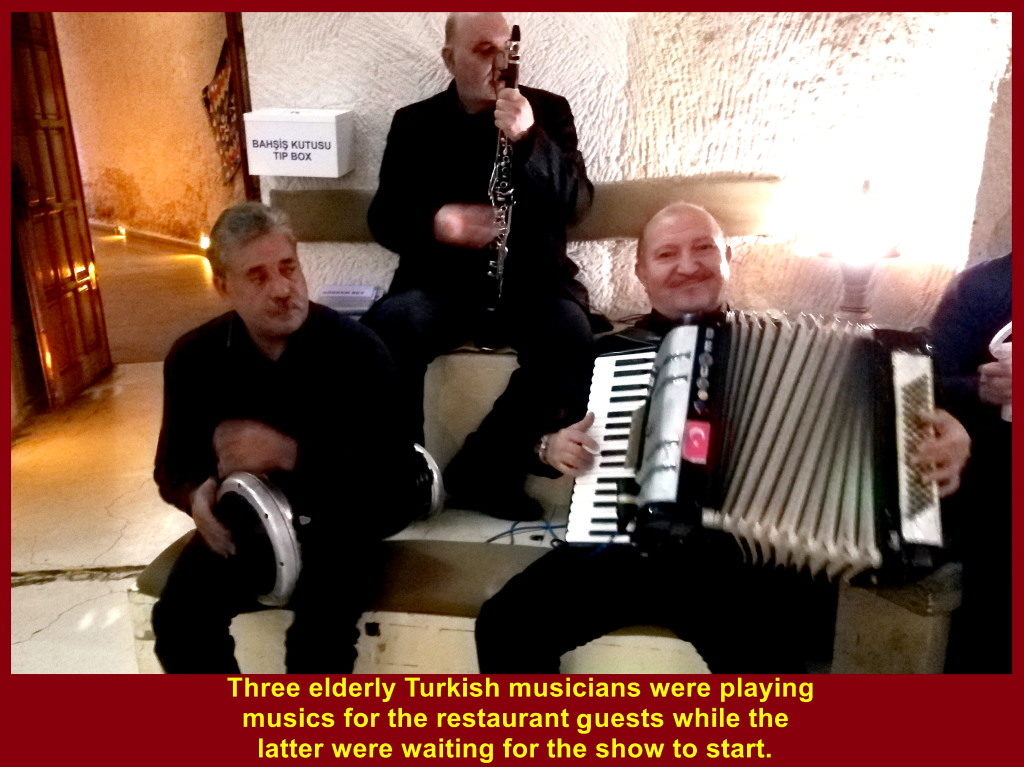
At 8.20 p.m. the show started. Several men dressed in traditional costumes appeared on the floor and did a traditional dance.
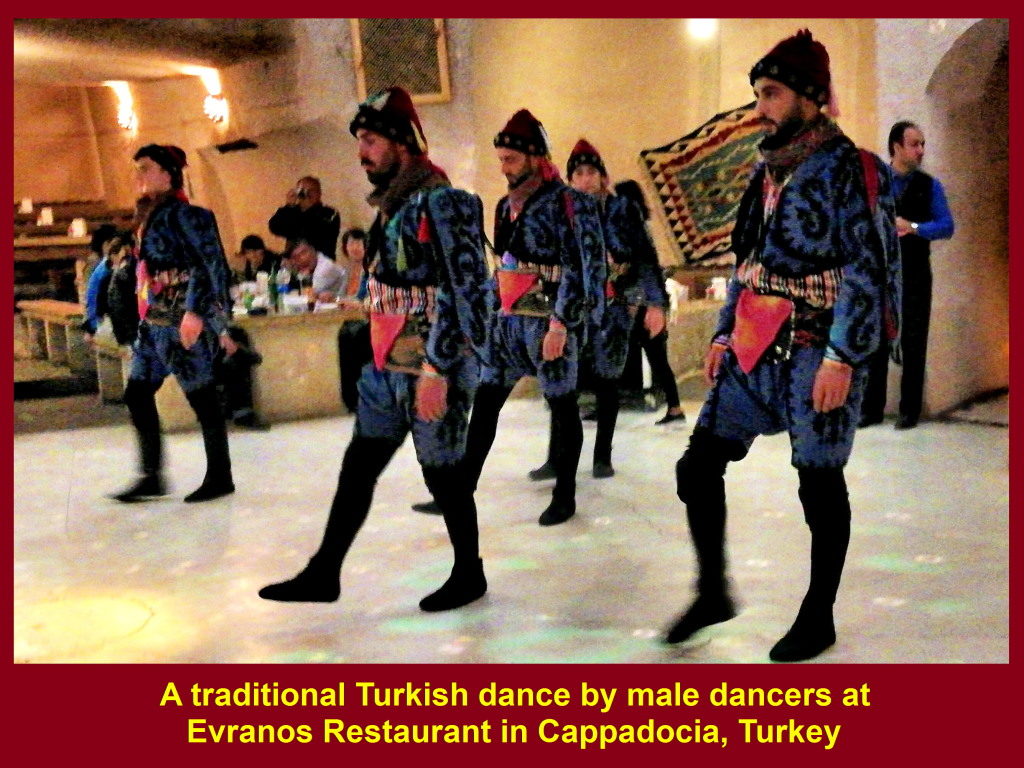
Then a few ladies appeared and danced, gracefully.
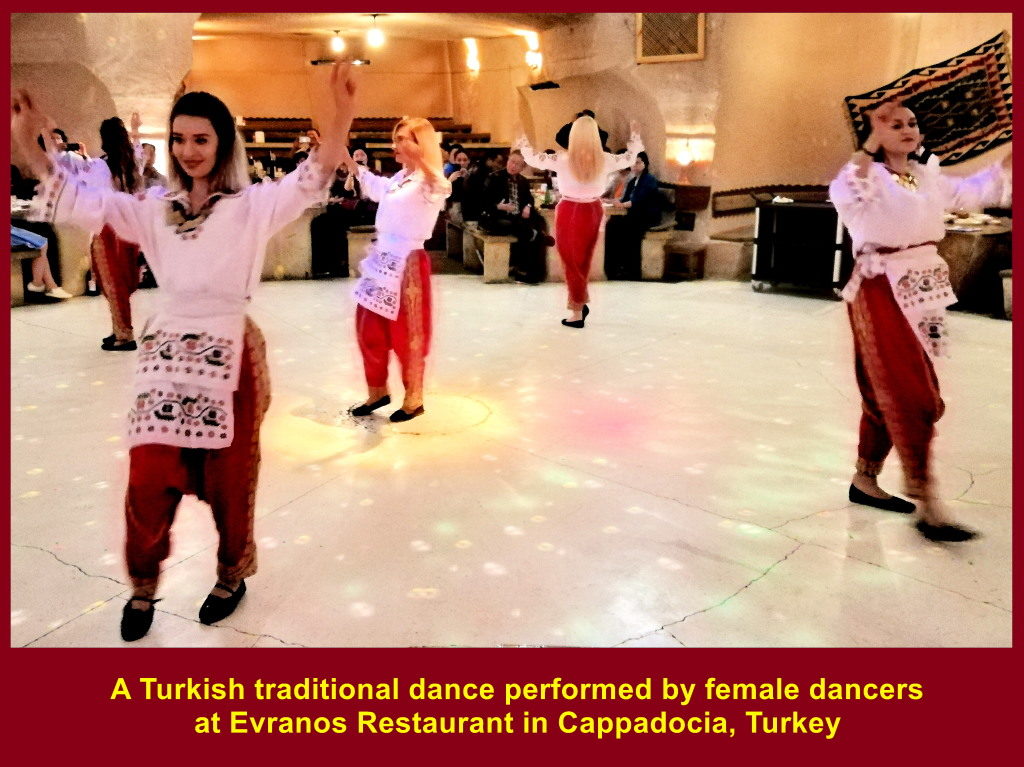
After the dance performed by the ladies, a Turkish traditional wedding ceremony was performed.
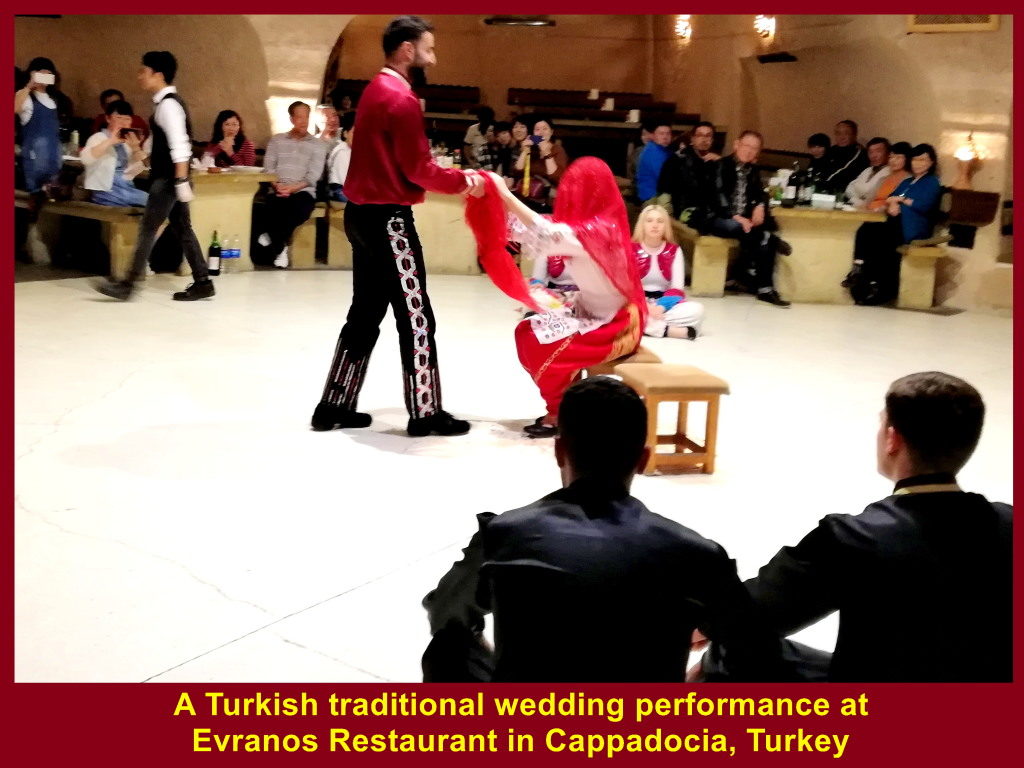
When the wedding ceremony was over, the performers invited some guests to the floor to dance their traditional way.
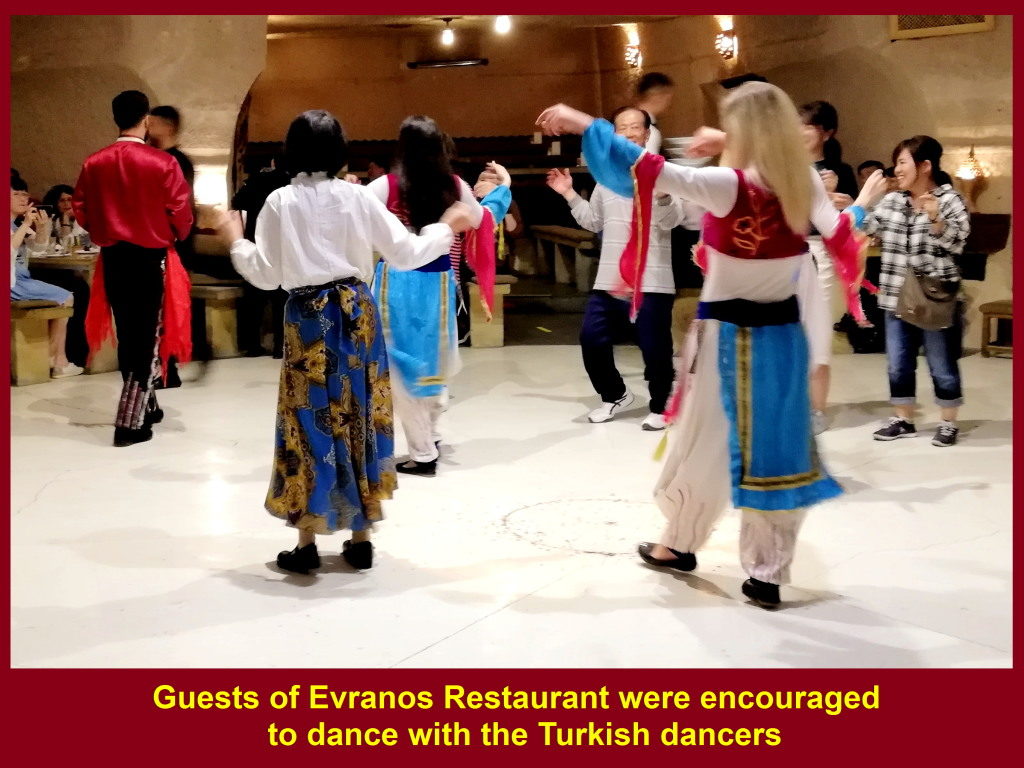
Finally, the highlight of the show was the belly dance. It was performed by a fair, pretty Turkish lady. She began dancing with two “white wings and then other dances.
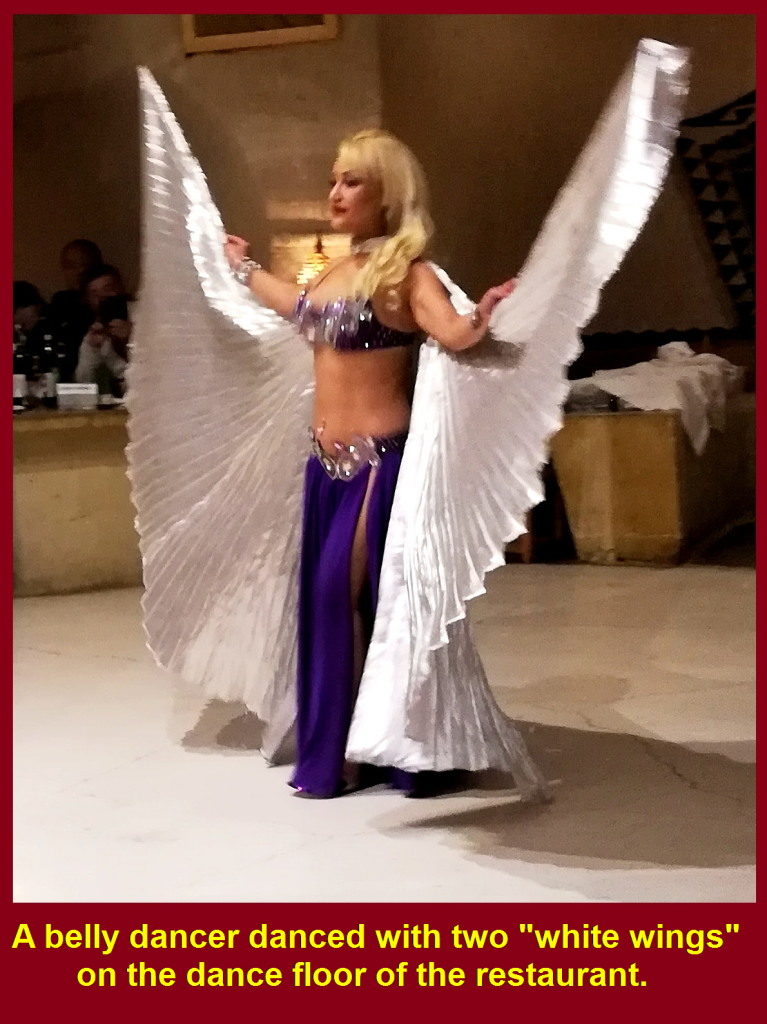
Occasionally, she did some sensual movements in her dance to the delight of the guests.
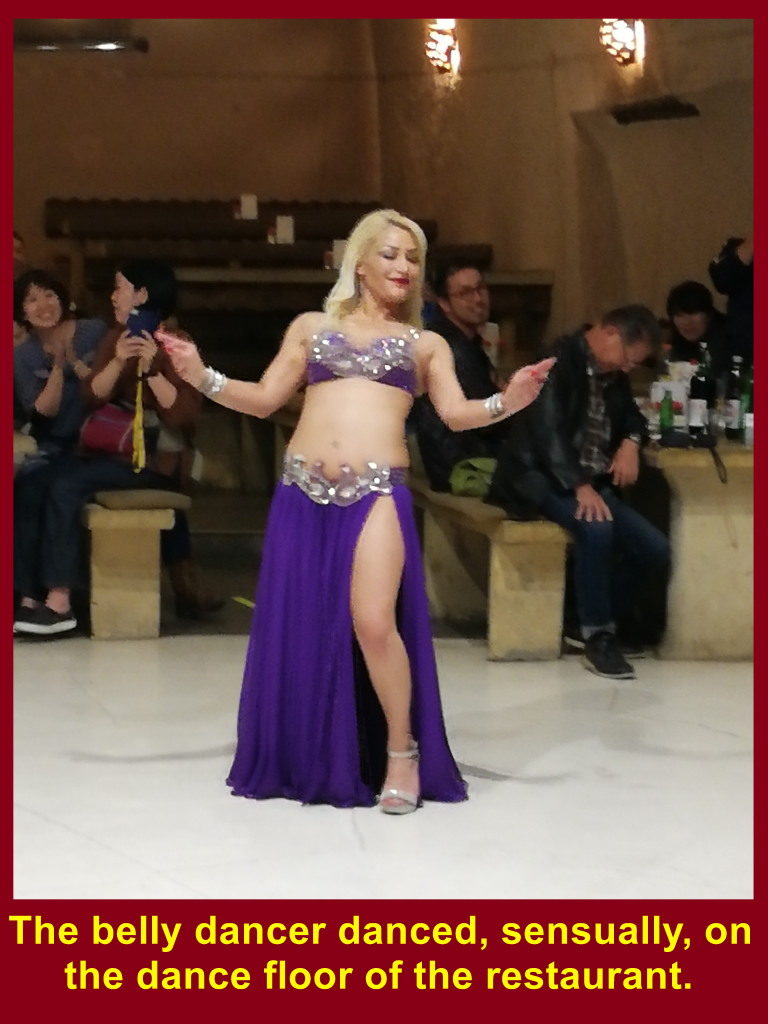
After dancing, the lady went round looking for a male guest.
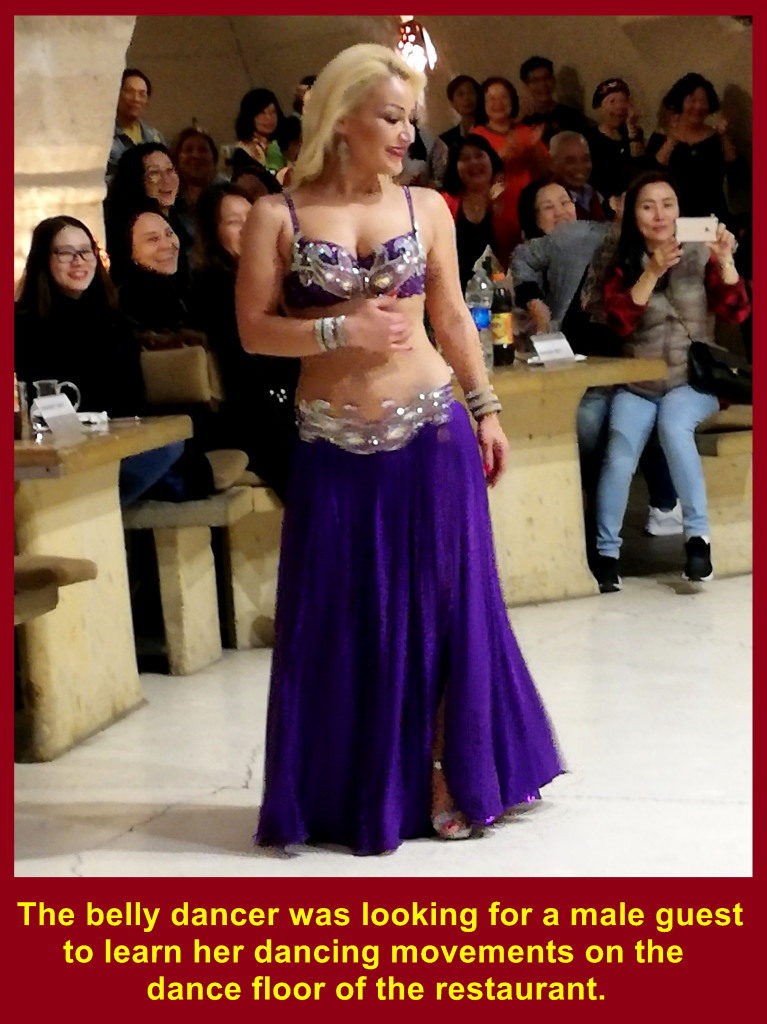
When she spotted one, she invited him to the floor and asked him to follow her basic belly dance movements. His movements were stiff.
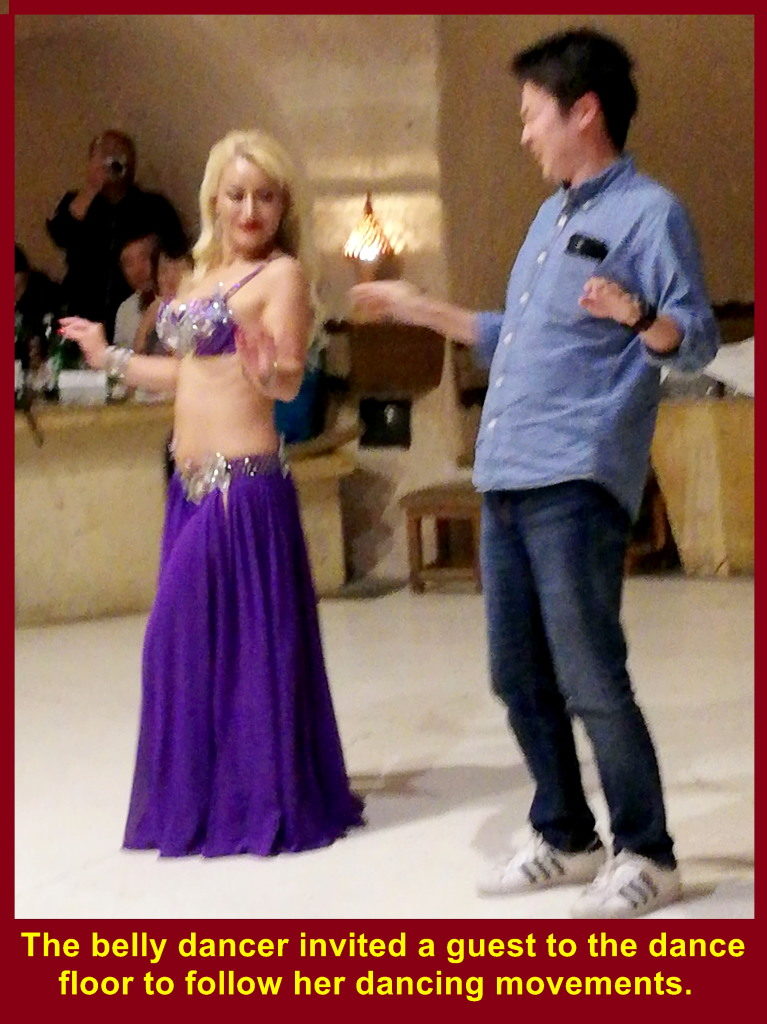
Later, she invited another male guest and asked him to follow her sensual body movements. He made us laughed at his clumsiness, but we liked him as he was very sporting.
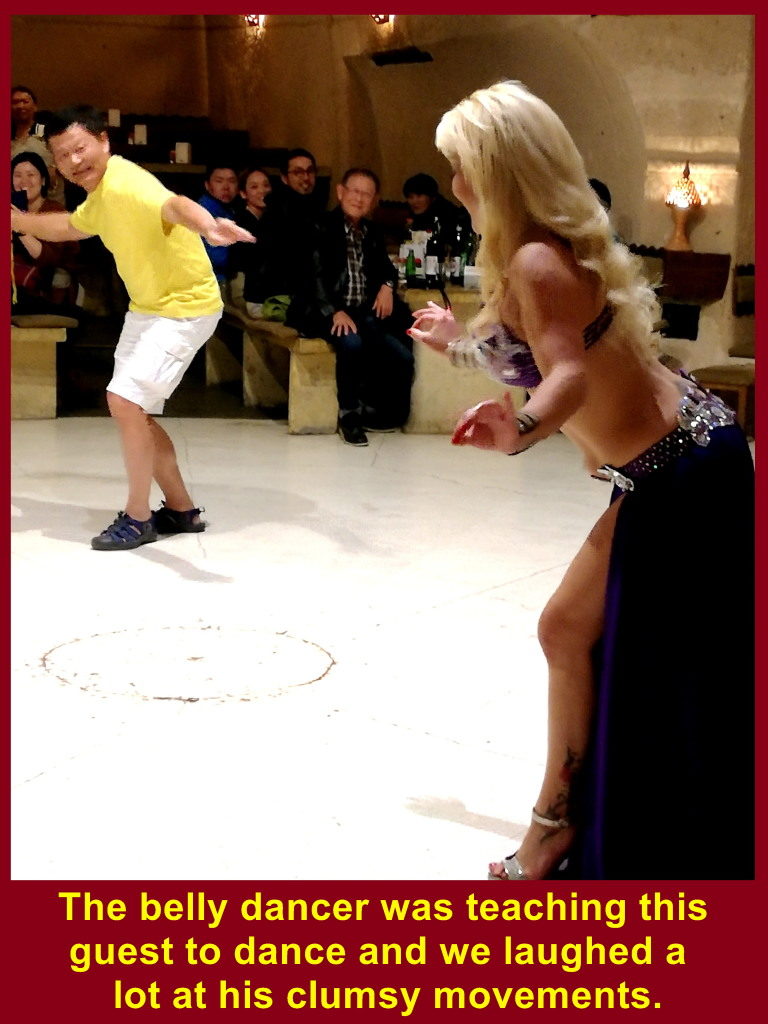
Back to Dilek Kaya Hotel
After an hour of enjoyment at Evranos Restaurant in Cappadocia, Turkey, we went back to our hotel, Dilek Kaya Hotel, nearby and stayed there for another night.
Previous Page / Home / Next Page
Places visited during Turkey Tour(13-22 Oct 2019):
Trojan Horse/Ancient Troy Cities Asklepion Ephesus Hierapolis/Pamukkale Travertine Sultanhani Caravanserai Pasabag Valley Uchisar Valley/Kaymakli Underground City Gerome Valley/Turkish Night Show Hot Air Balloon/Lake Golu/Anitkabir Hagia Sophia/Topkapi Palace/Blue Mosque Bosphorus Boat Cruise Spice Bazaar/Grand Bazaar
Turkey Travel Part IX: Hot Air Balloon, Lake Tuz & Anitkabir
Filed under: Hot Air Balloon, Lake Golu, Anitkabir, Turkey Travel
(Continued from previous page)
Day 7
Saturday, 19 Oct 2019
Hot Air Balloon Ride
Early in the morning, 22 of our tourmates went to a place, Goreme, near our hotel, Dilek Kaya Hotel, to ride a hot air balloon in Cappadocia, Turkey.
Writer and wife did not go with them as they had the same ride in Luxor, Egypt, in 2017.
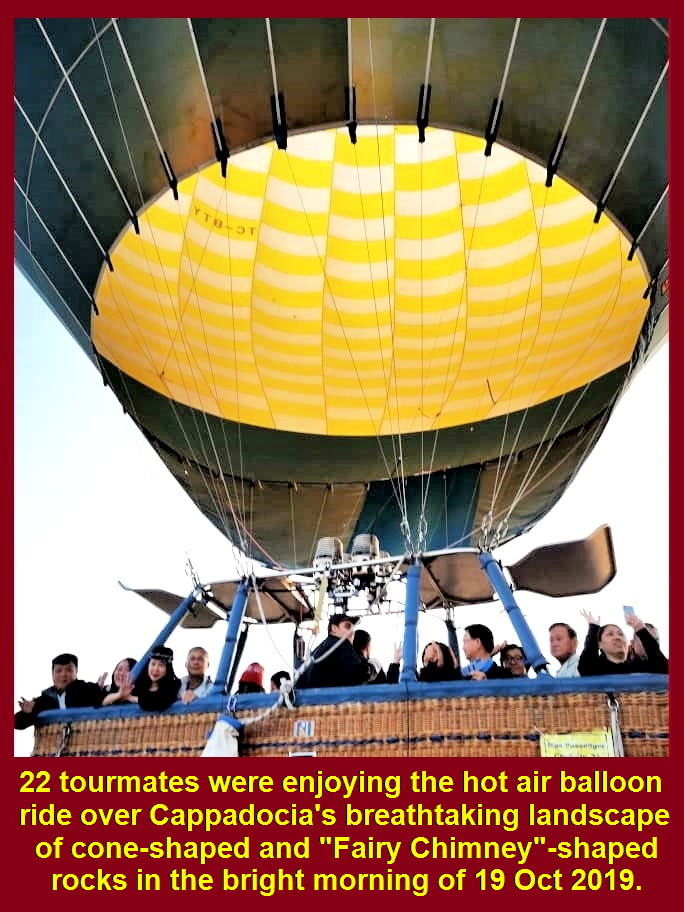
The following photos below show the hot air balloon activities in Cappadocia in the morning of 19 Oct 2019.
(i) One balloon had lifted off and the other would soon follow.
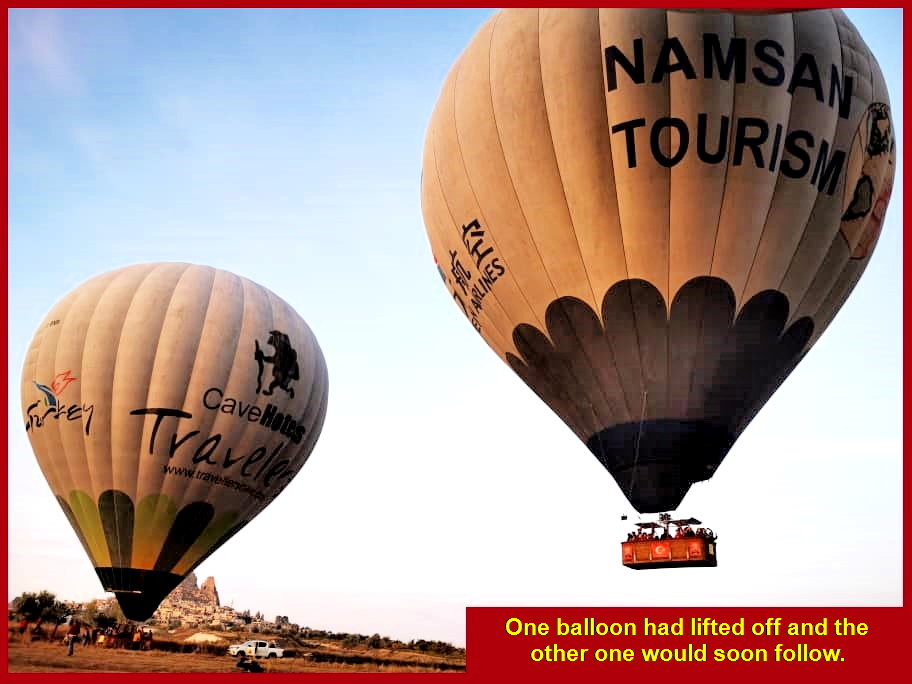
(ii) Many balloons were already in the sky when the sun appeared in the east.
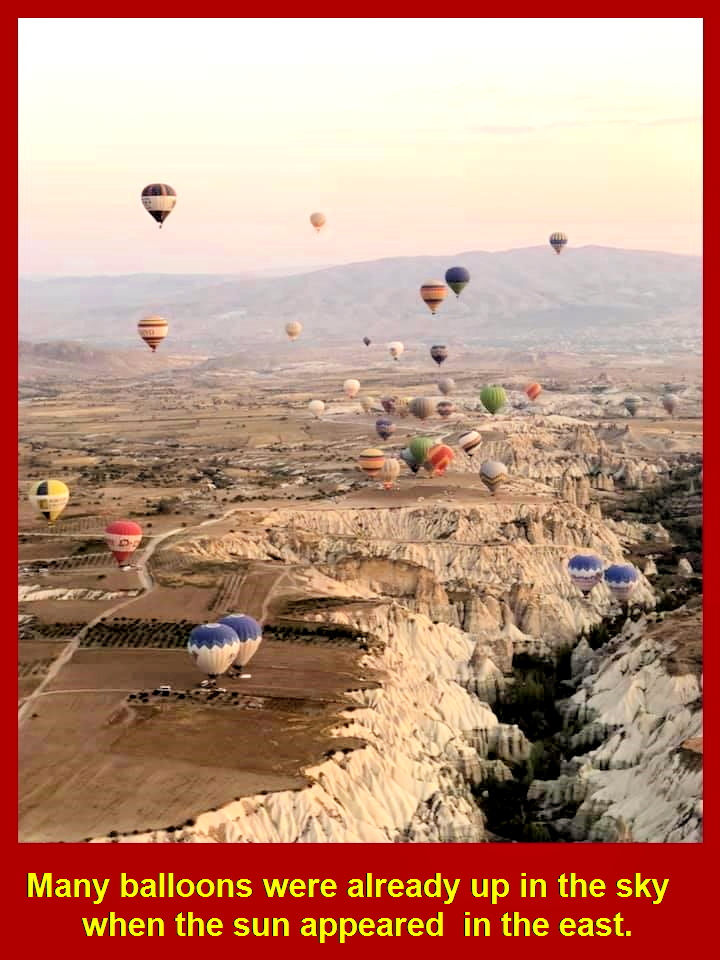
(iii) Lots of balloons in the sky in the bright morning of 19 Oct 2019 in Cappadocia.

(iv) Riders of the balloons were enjoying the breathtaking view of the land below them in Cappadocia in the bright morning of 19 Oct 2019.
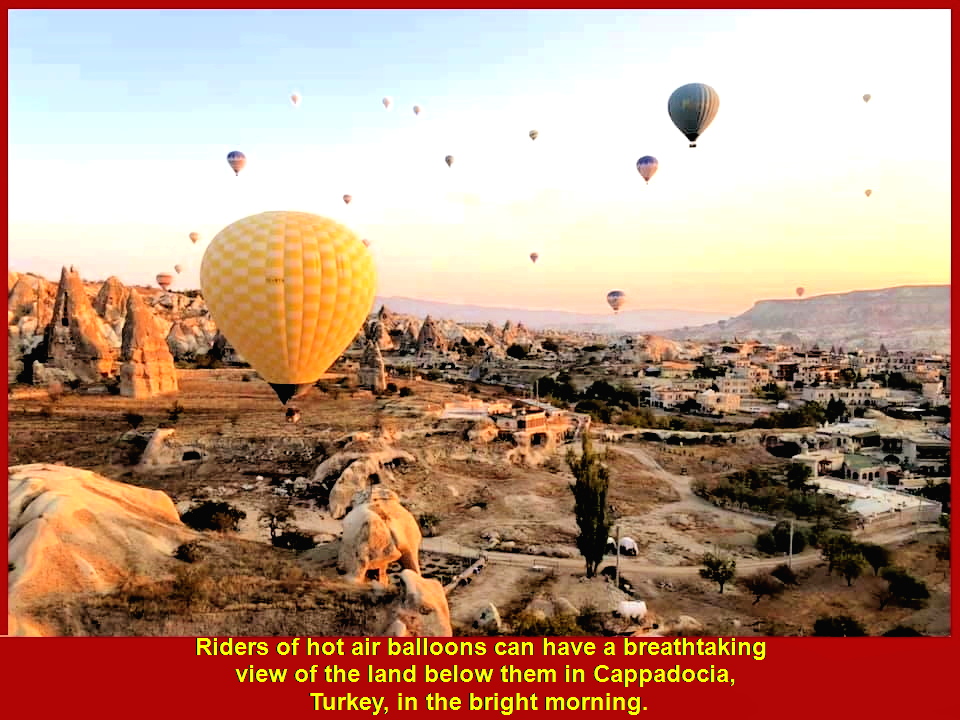
(v) Writer who stayed at the hotel, Dilek Kaya Hotel, Cappadocia, spotted two hot air balloons floating in the air at 7.40 a.m. on 19 Oct 2019.
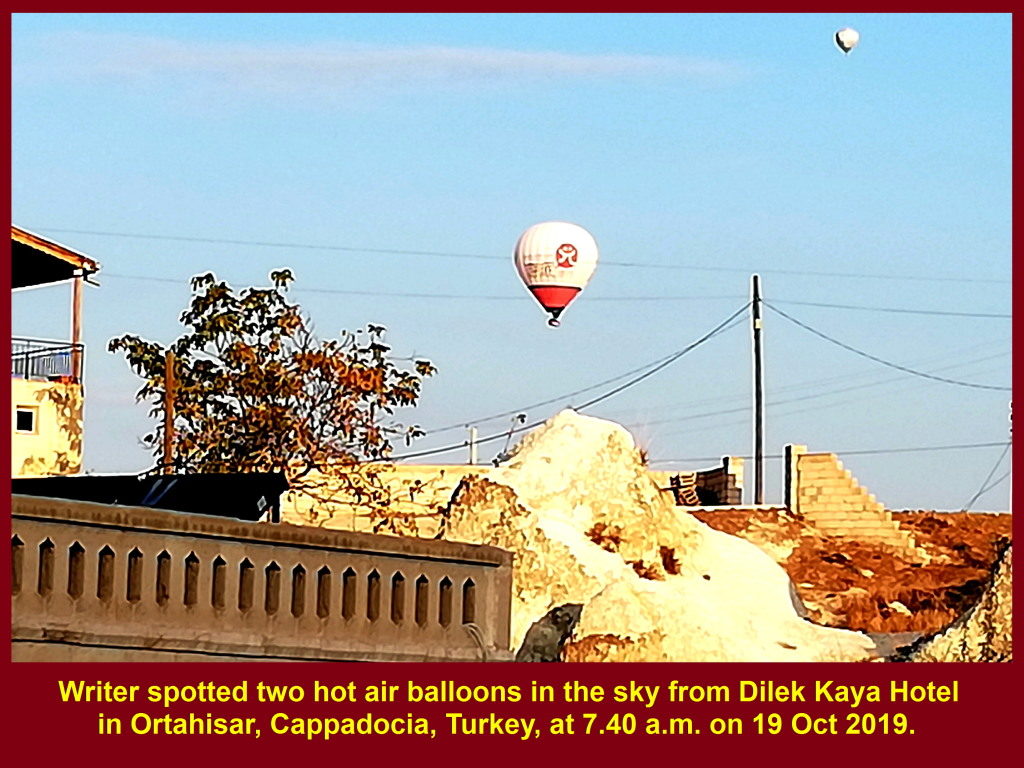
Departure for Ankara from Cappadocia
At 10 a.m. we left Dilek Kaya Hotel in Cappadocia and continued our Turkey tour to Ankara, the capital of Turkey, that had a population of 5.5 millions in 2018.
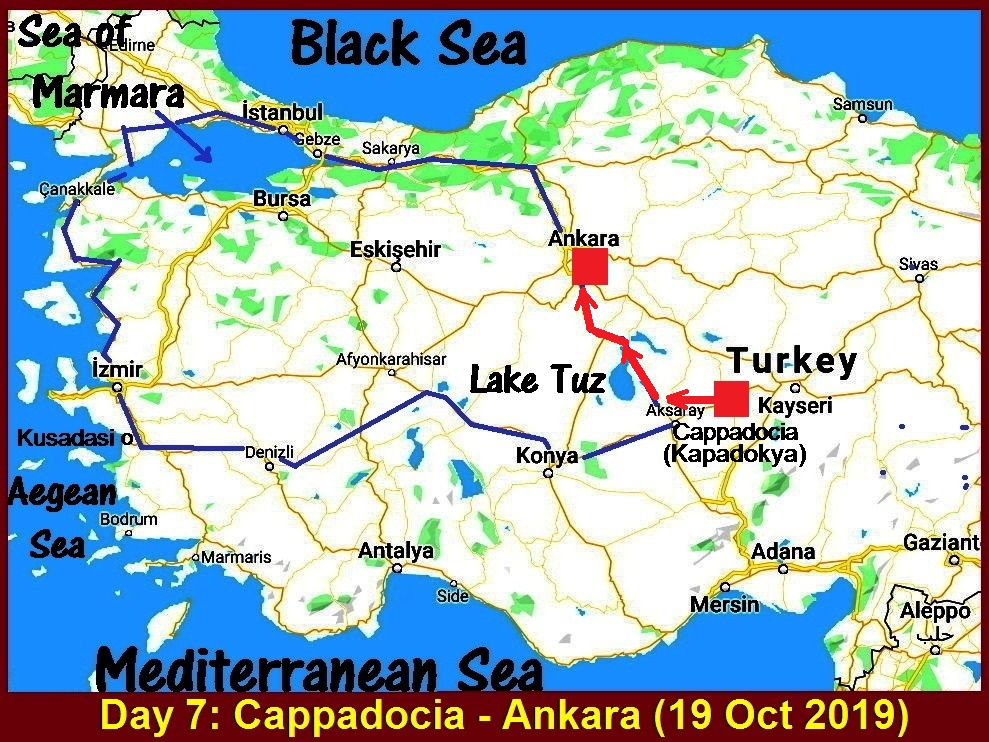
Lake Tuz
After travelling for more than an hour, we stopped by a large lake, Lake Tuz, which is the second largest in Turkey. It is located 150 km south-east of Ankara.
Breeding Ground for Flamingos
The picture below shows Lake Tuz(Tuz Golu). It is a breeding ground for tens of thousands of flamingos in the middle of every year.
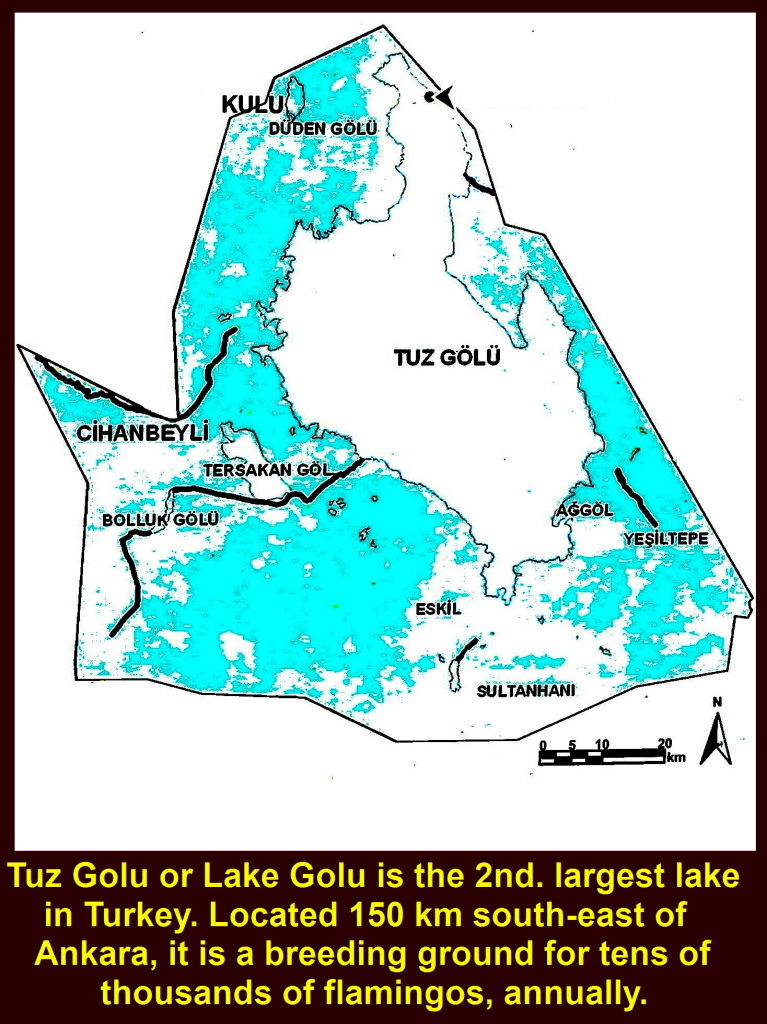
Writer and tourmates visited Lake Tuz(Tuz Golu) on 19 Oct 2019.
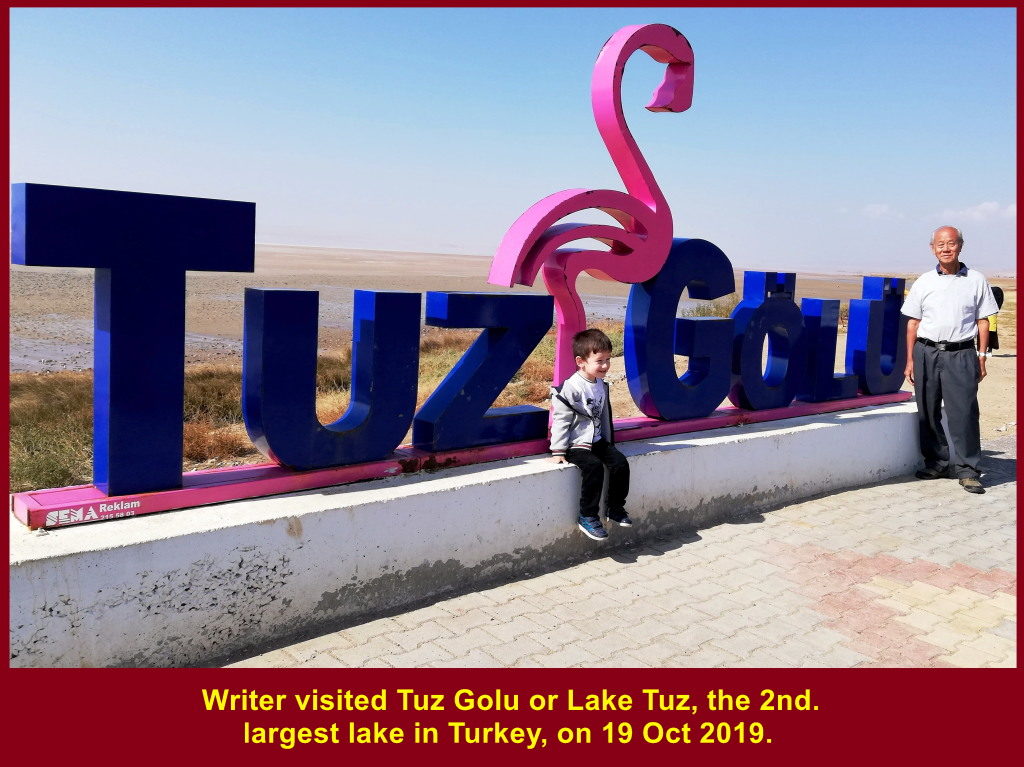
Salty Shore
The shore of Lake Tuz is salty. We were not lucky to see any flamingo around when we were there on 19 Oct 2019. Flamingos are migratory birds and they fly to the lake to breed in summer.
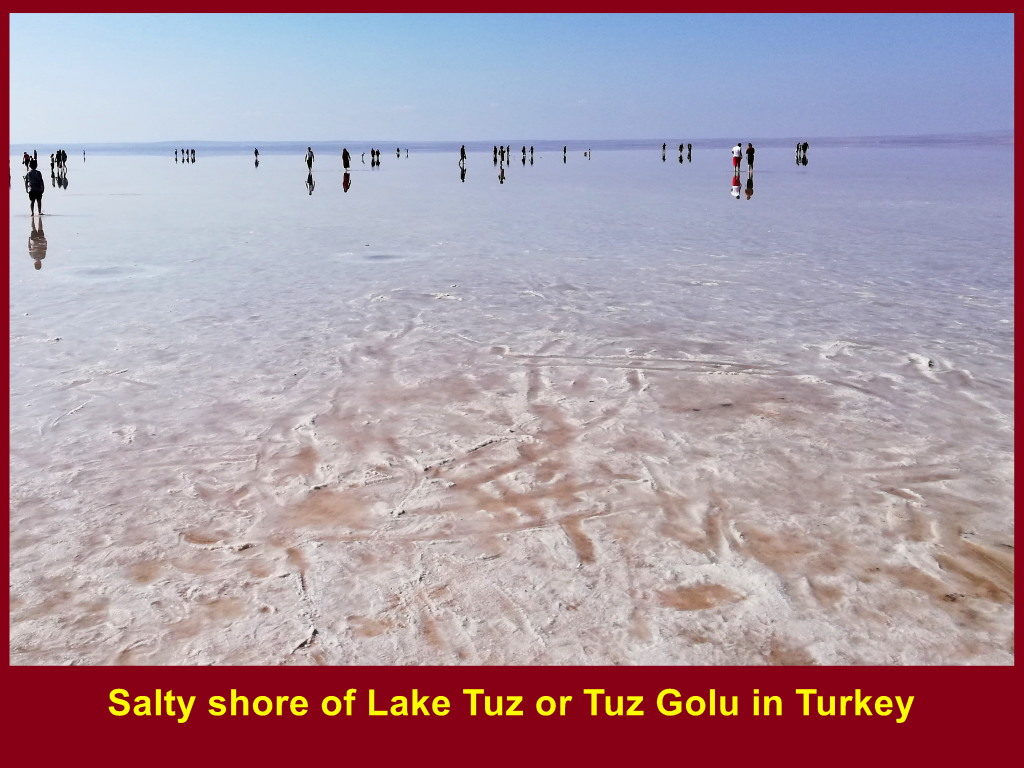
Flamingos
This picture shows a flamingo with white feather on its body and red feathers on its wings. It has two long pink legs and black curved beak. Birds of this kind migrate to Lake Tuz, annually.
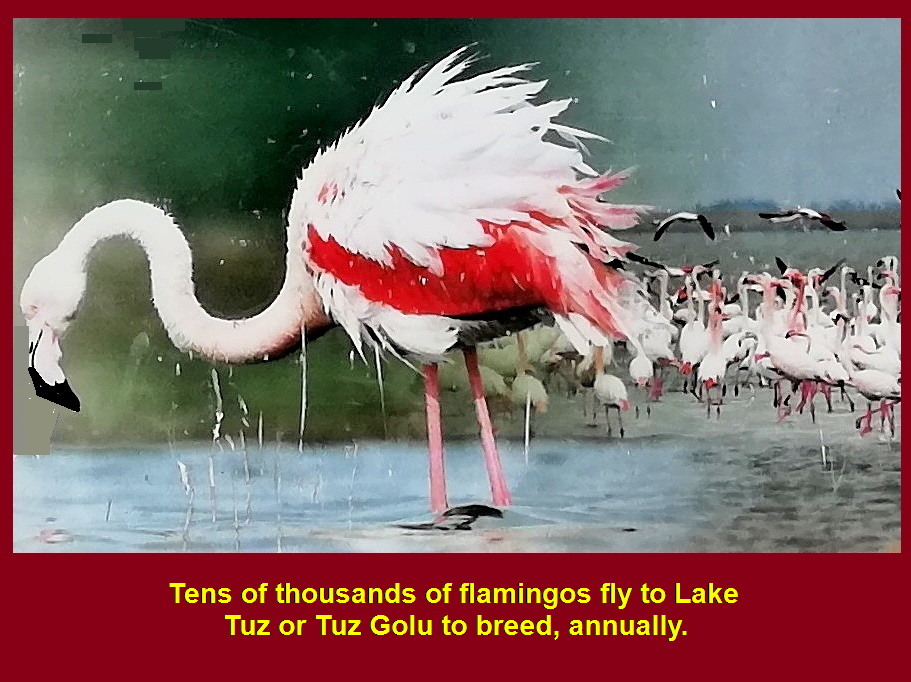
Journey to Ankara
At 12.30 p.m. we left the salt-lake, Lake Tuz, and went straight to Ankara.
Two hours later, we arrived at Ankara, the capital of Turkey.
Anitkabir, Mausoleum of Mustafa Kemal Ataturk.
In Ankara, the first place we visited was Anitkabir, the Mausoleum of the founder and first President of Republic of Turkey, Mustafa Kemal Ataturk.
Below is a picture of the Anitkabir, the Mausoleum of Mustafa Kemal Ataturk.
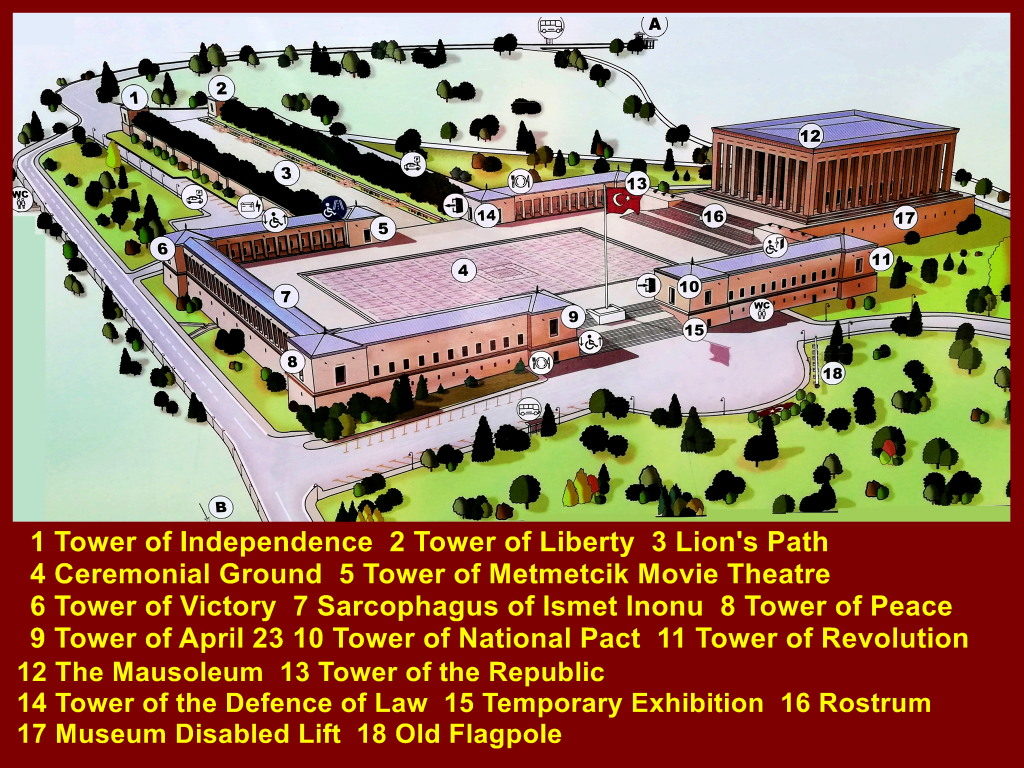
Entrance to Anitkabir, the Mausoleum of Mustafa Kemal Ataturk, in Ankara
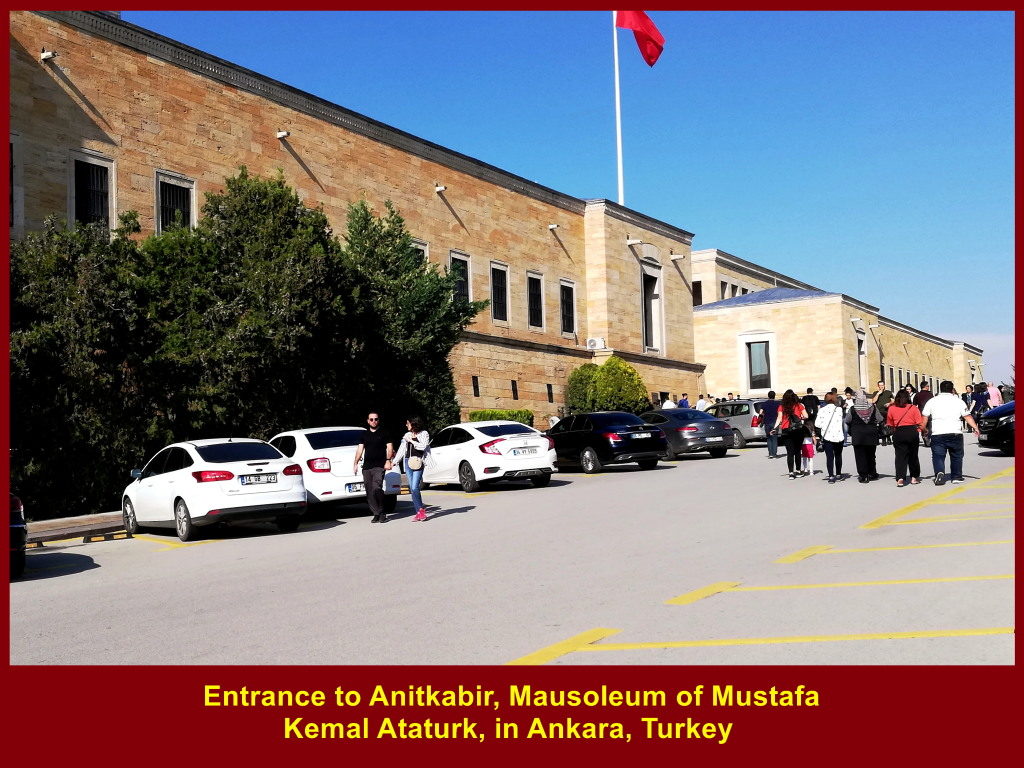
Writer and wife were in the courtyard of Anitkabir, the Mausoleum of Mustafa Kemal Ataturk, on 19 Oct 2019. It was opened in 1953 in memory of the Turkish hero.
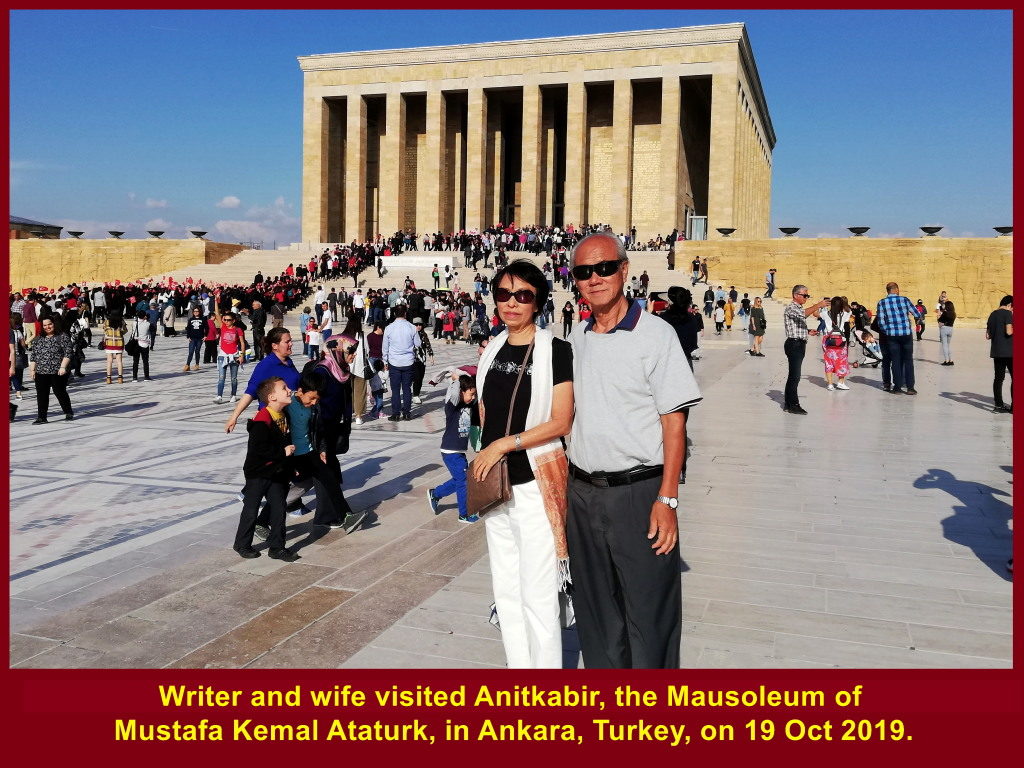
Founder and First President of Republic Turkey
Mustafa Kemal Ataturk(1881-1938) was the founder and first President of Republic Turkey in 1923. He made many reforms to make his country a strong, secular and modern state.
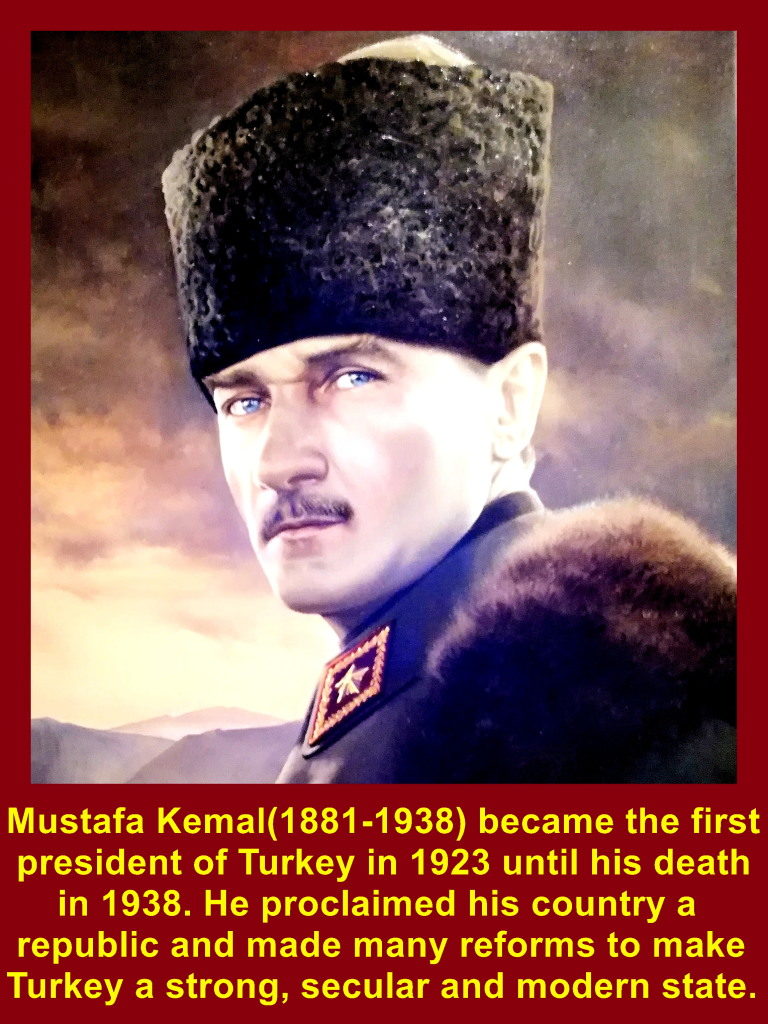
Symbolic Sarcophagus of Mustafa Kemal Ataturk
The symbolic sarcophagus of Mustafa Kemal Ataturk’s tomb in the Hall of Honour in Anitkabir in Ankara. His tomb is right under the sarcophagus on the ground floor.
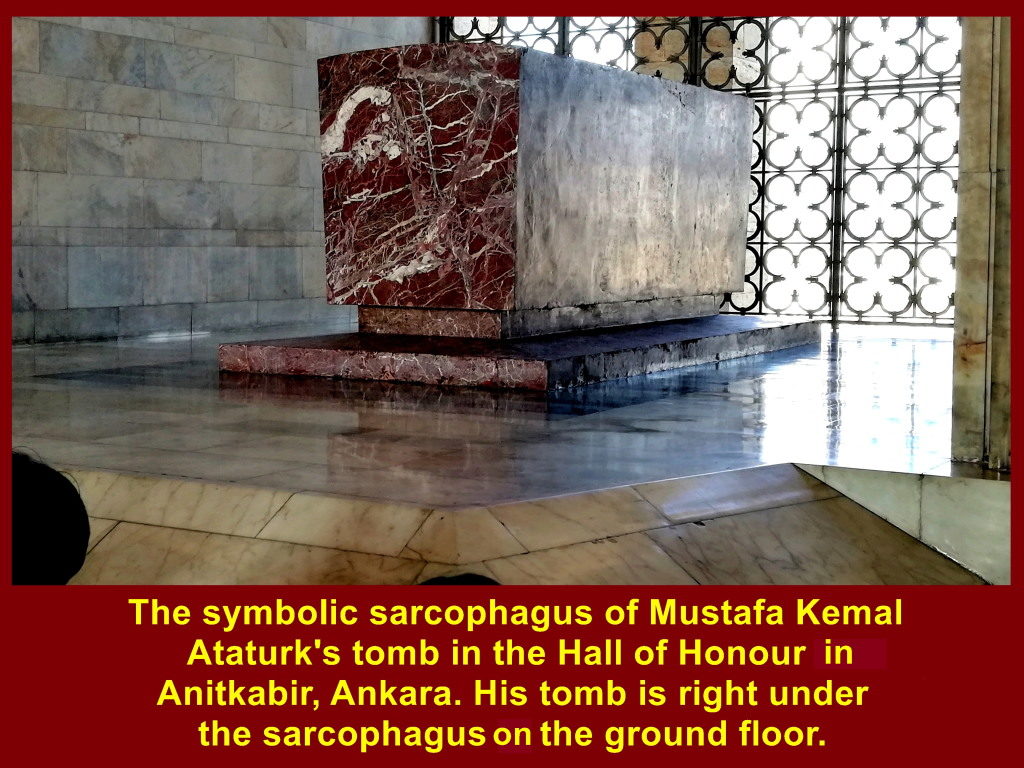
Mustafa Kemal Ataturk had fought in the 1st. World War(1914-1918).
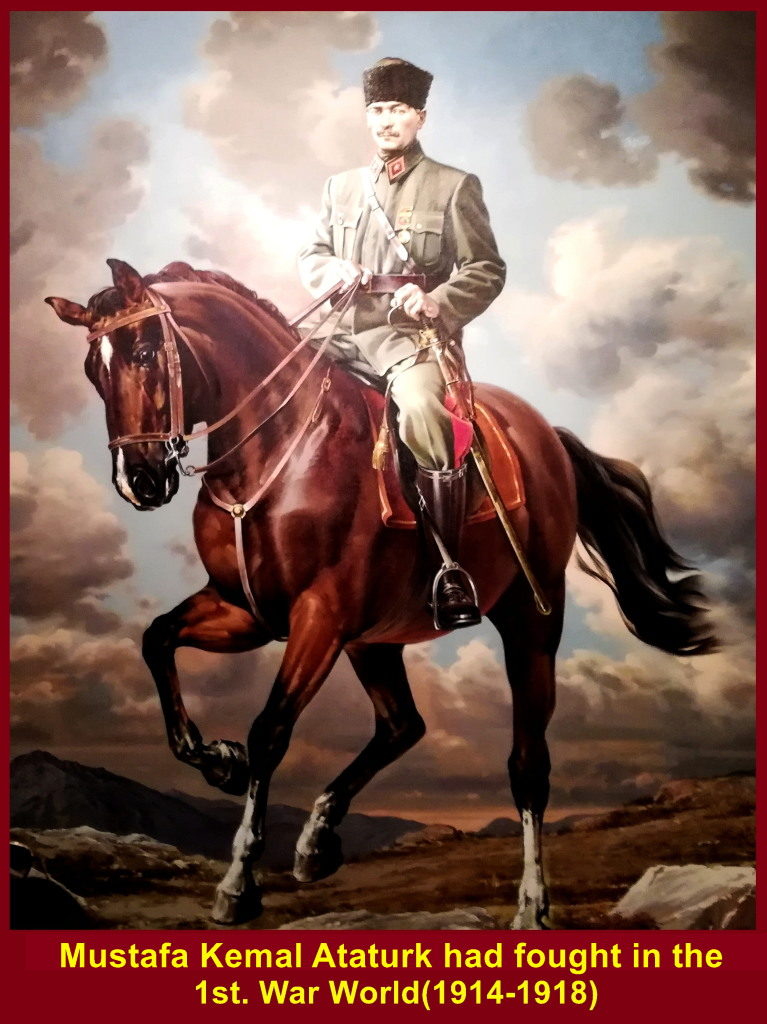
Western Front
Mustafa Kemal Pasha(Commander-in-Chief) and his men were sent off to the Western Front to fight against the Allied Powers in the Battle of Gallipoli(1915-16). The allied Powers wanted to control the sea route(Strait of Dardanelles) between Europe and Russia. The Turkish won the battle.
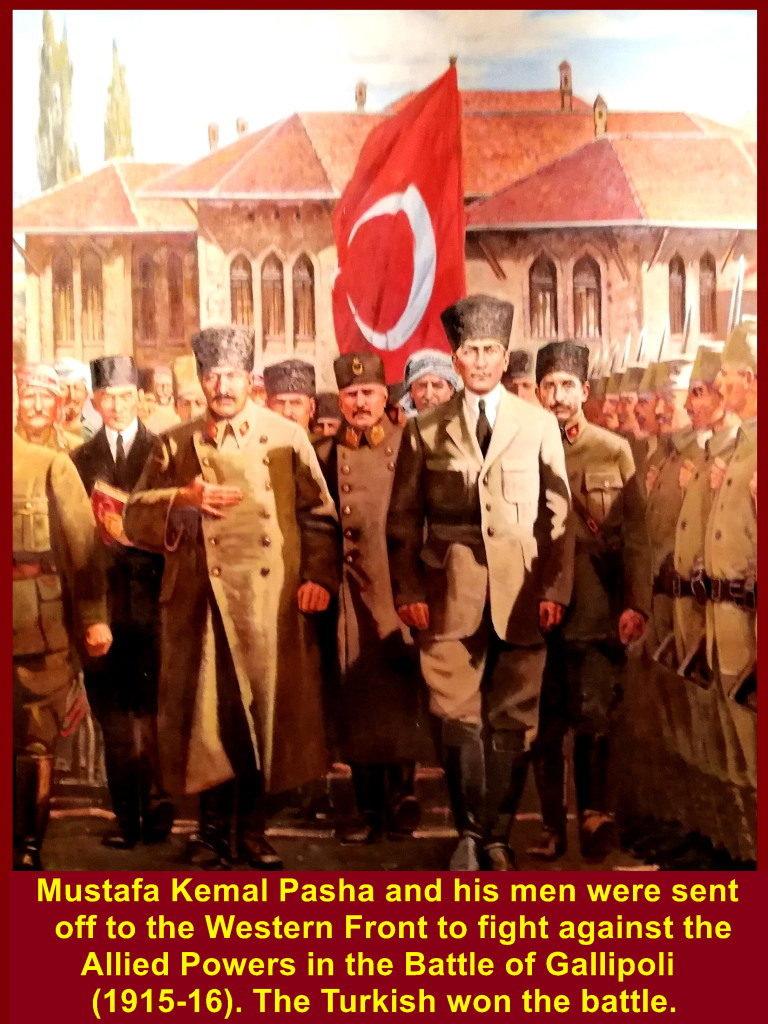
Military Manoeuvre in Ilgin
Commander-in-Chief Ghazi Mustafa Kemal Pasha and Commander of Western Front, Imet Pasha, at the big military manoeuvre in Ilgin on 1 April 1922.
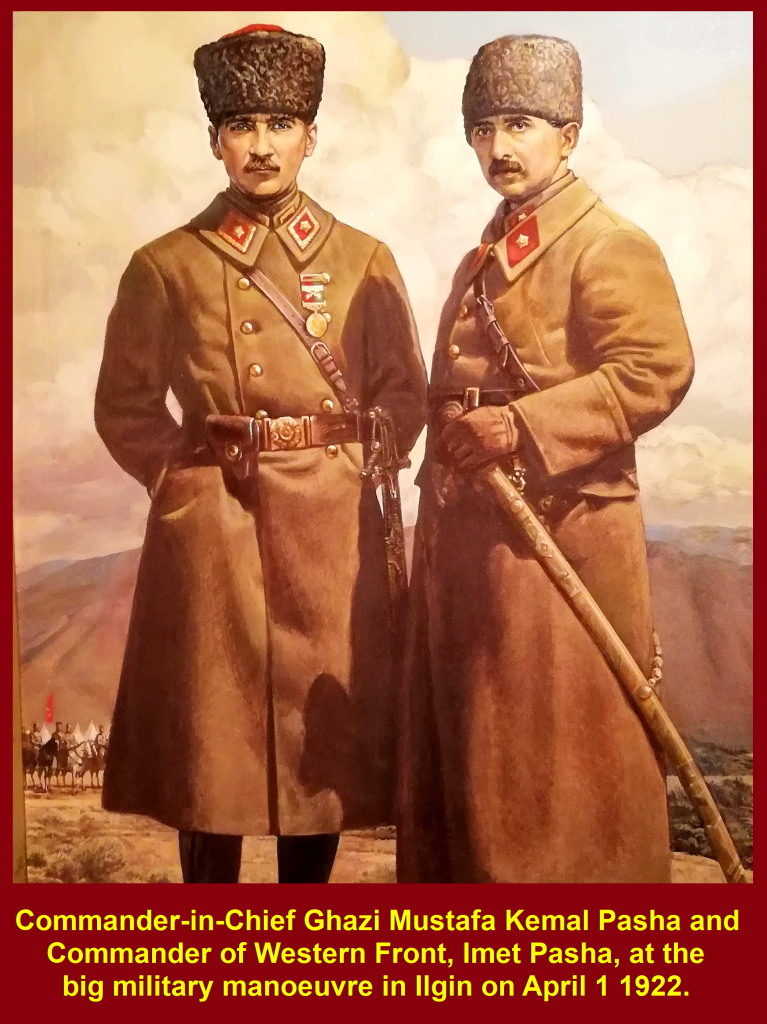
The Great Battle in 1922
Commander-in-Chief Marshal Ghazi, Mustafa Kemal Pasha, were discussing the Great Attack(1922) with the Commander of the Turkish Army and Western Front Commander.
In 1919 the Greek forces captured Smyrna(now Izmir). In 1922 the Great Battle between the Greek and Turkish forces were launched in Smyrna. Turrkish forces counter-attacked and recaptured the town from the Greek.
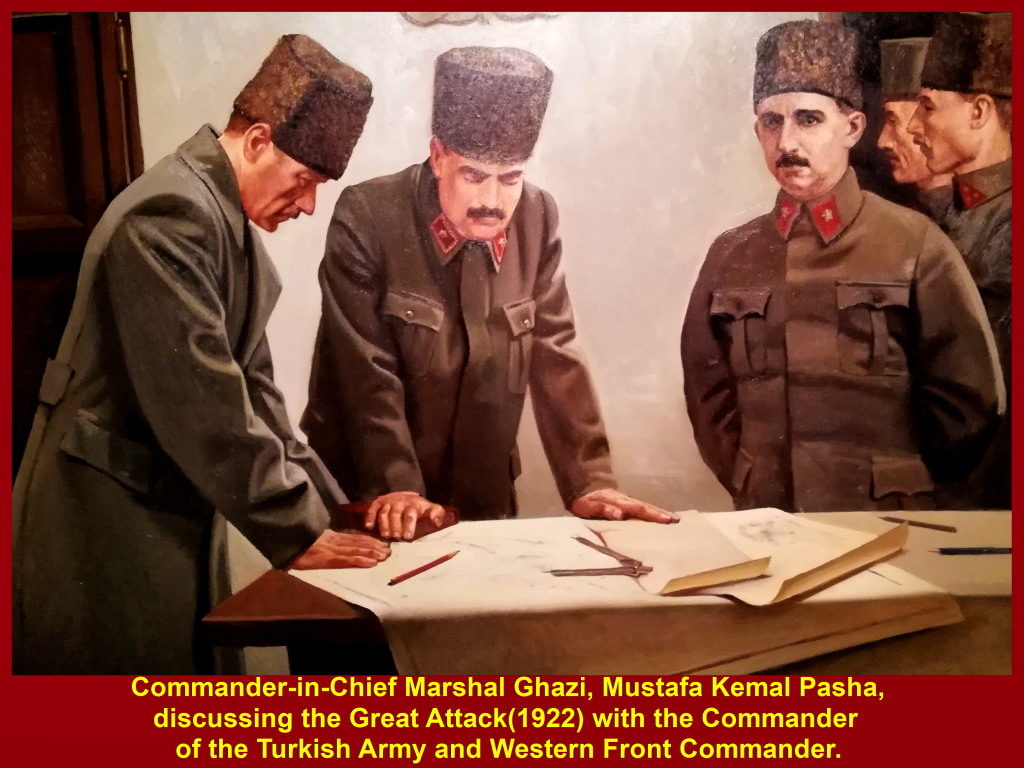
Battle of Gallipoli(1915-16)
Below are some pictures painted on the walls in Anitkabir. They depict the Battle of Gallipoli(1915-16).
(i) Turkish armies firing cannons at British and French in the Battle of Gallipoli in 1915.
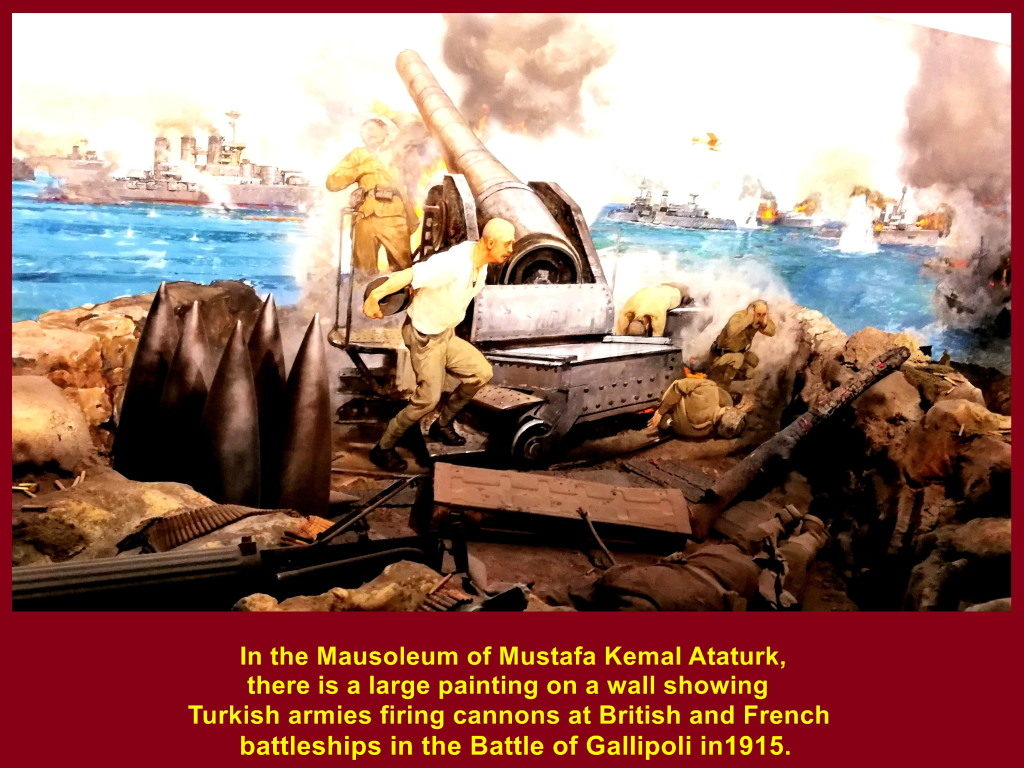
(ii) The Turkish armies fighting against the Allied Powers(Britain, France and Russia) in the Battle of Gallipoli(1915-16)
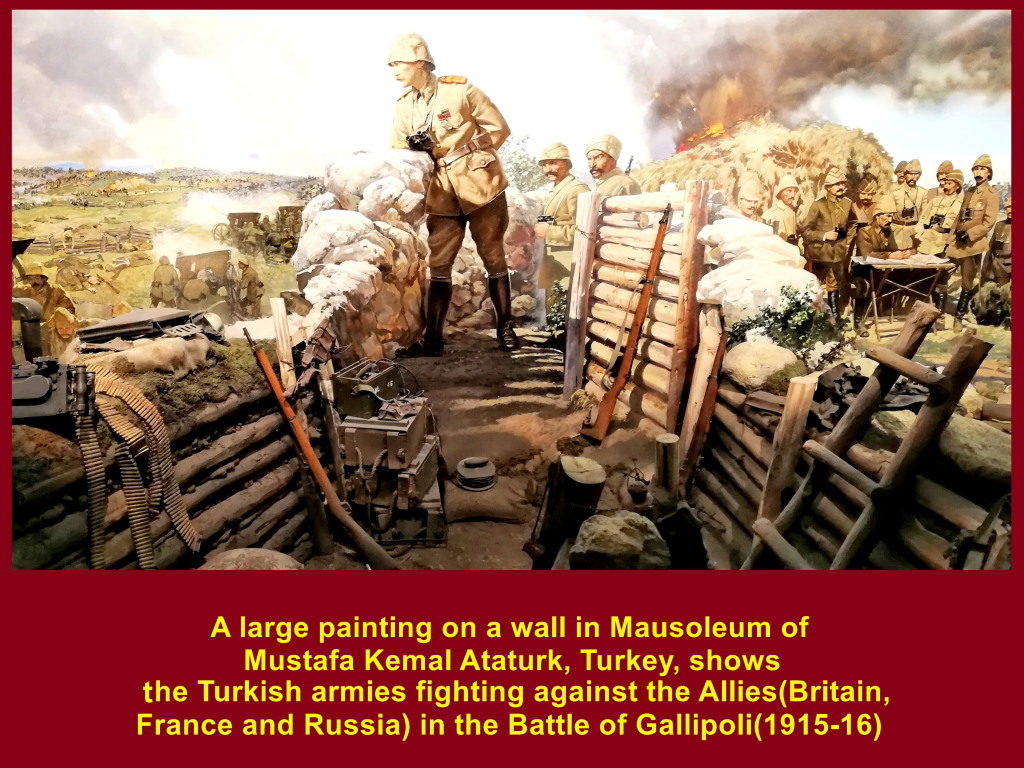
(iii) Nurses were taking care of wounded Turkish soldiers in the Battle of Gallipoli(1915-16)
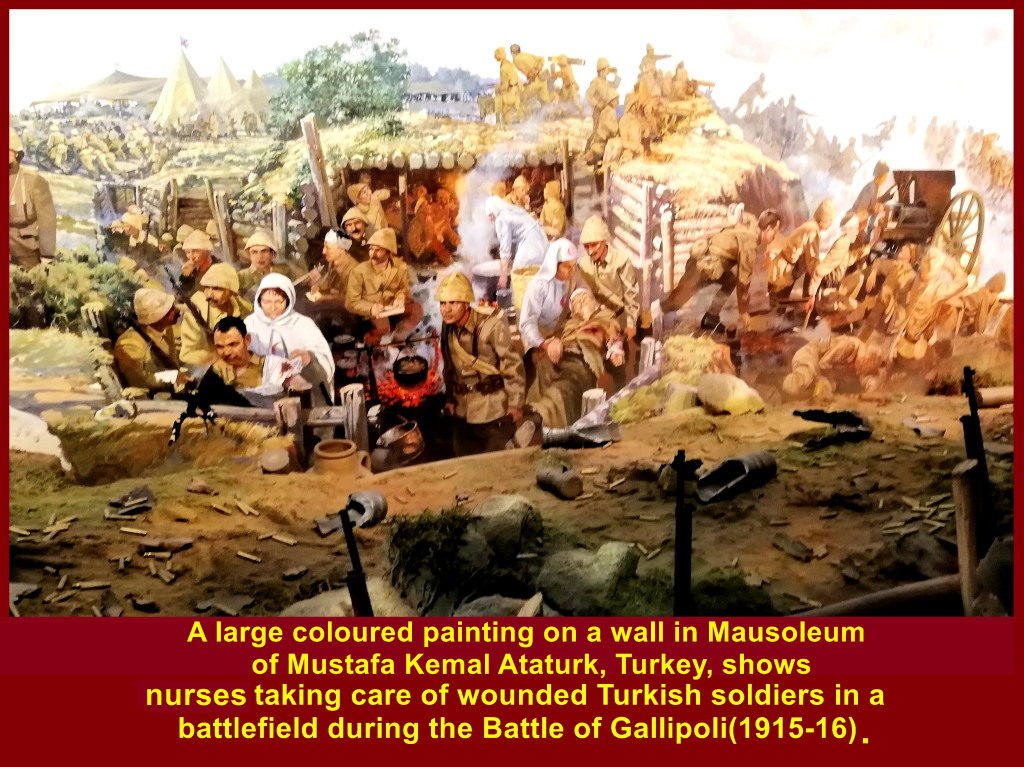
(iv) The Greek armies were invading villages, towns and cities beginning in Anatolia(Turkey) in 1919,
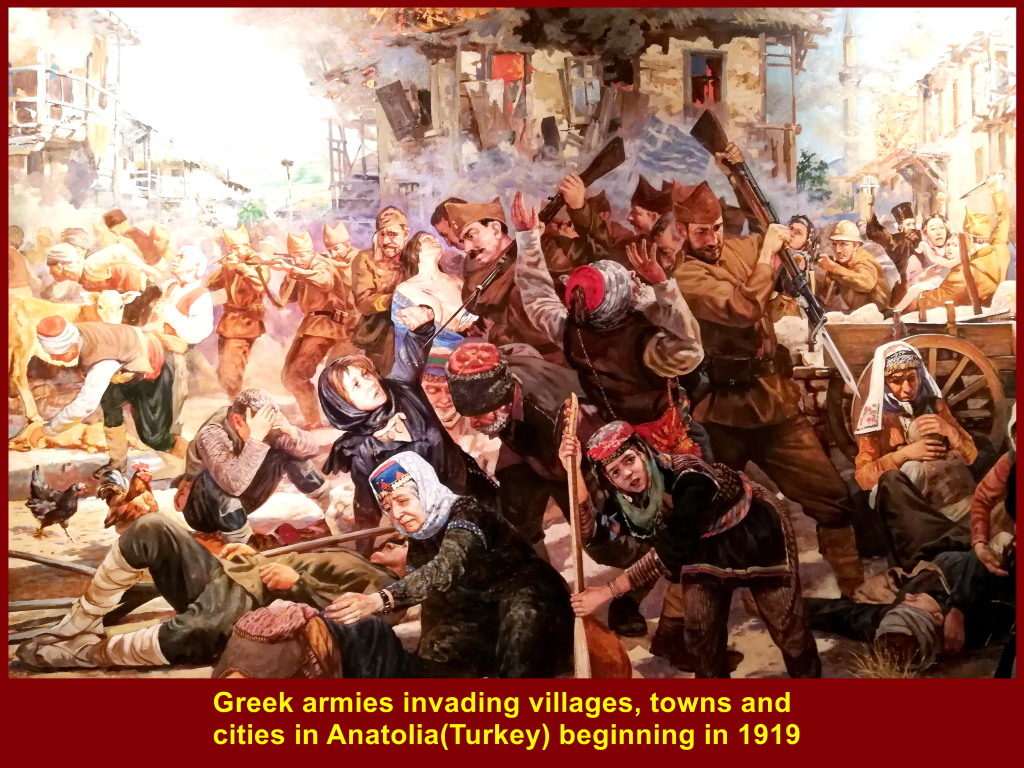
(v) In 1915, the British and French navies attacked the Turkish forces in the Strait of Dardanelles in the Battle of Gallipoli(1915-16) hoping to take control of the waterway between Europe and Russia.
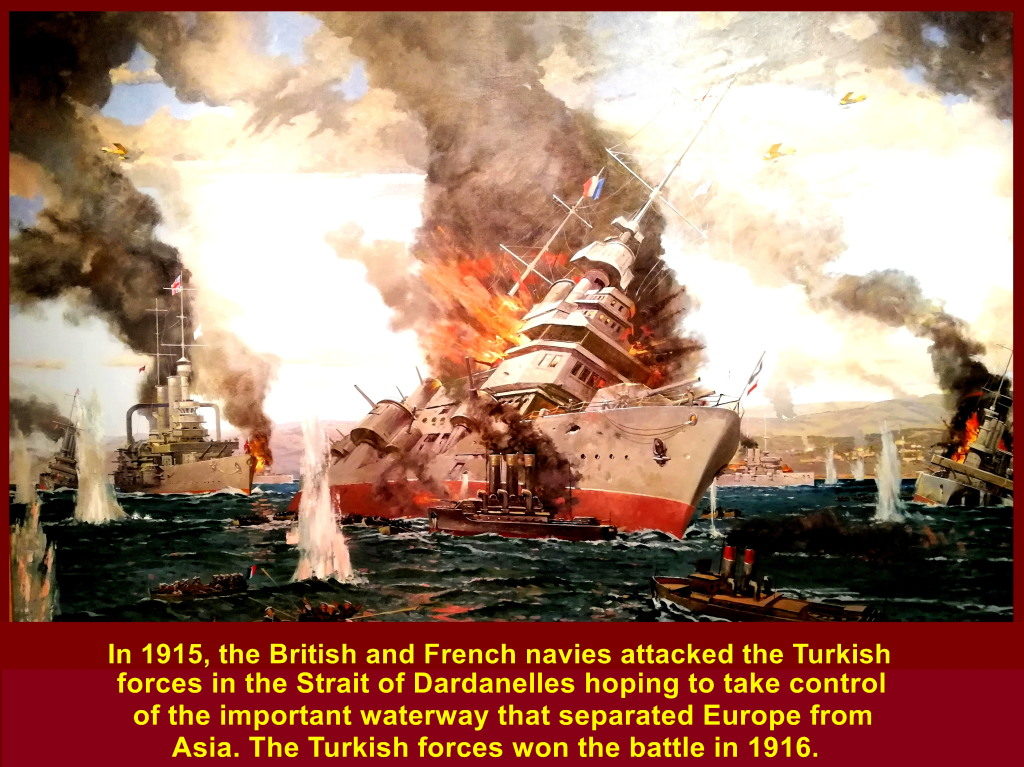
(vi) Turkish soldiers were relaxing during a truce in the Battle of Gallipoli(1915-16) between the Ottoman Empire(Turkey) and the Allies(Britain, France and Russia).
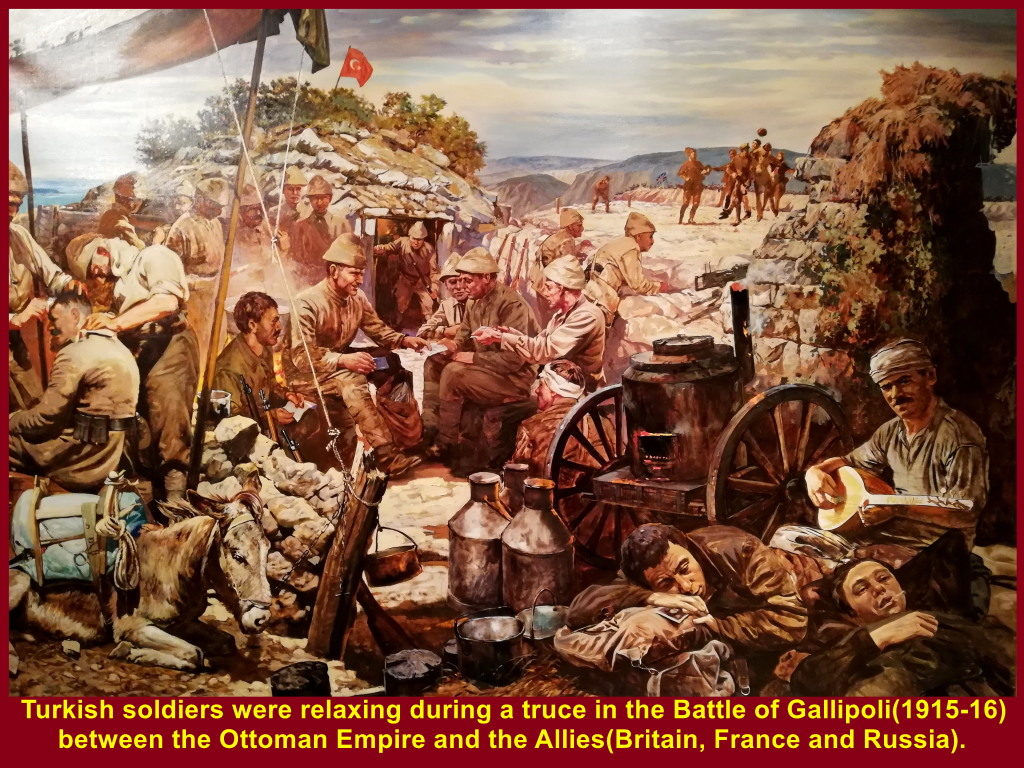
(vii) A Turkish army led by Commander-in-Chief, Ghazi Mustafa Kemal Pasha, and the people of Smyrna(now Izmir) were celebrating victory over the Greek forces in 1922.
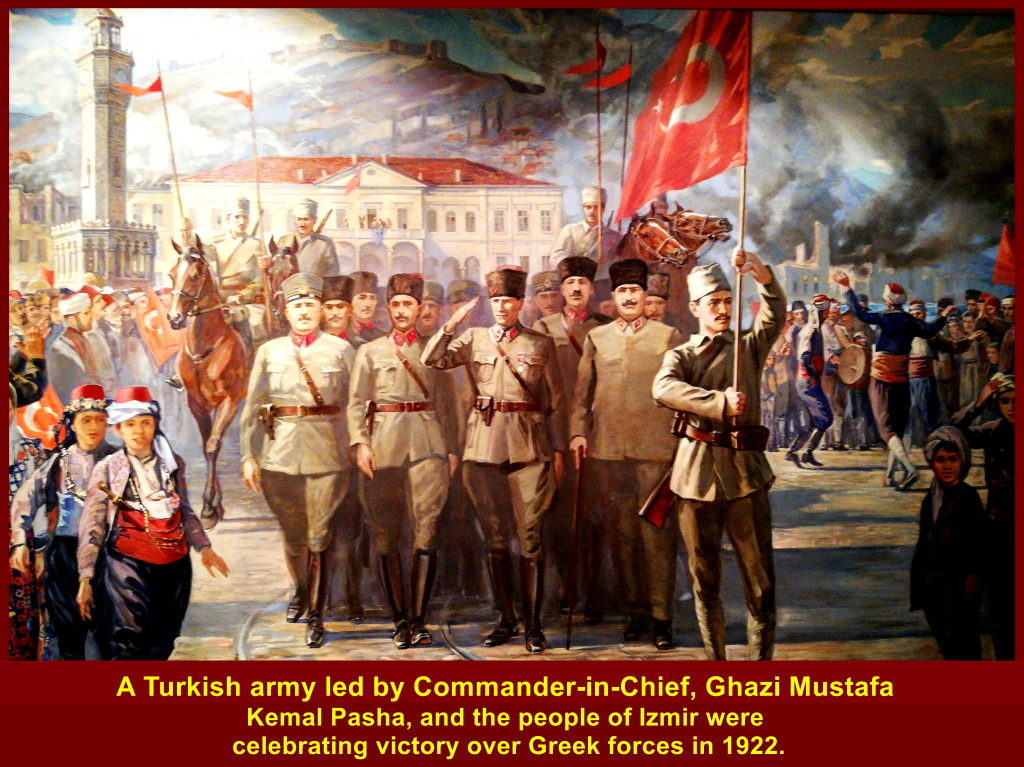
Copper-Tuning Art Pieces
Besides the large paintings about wars against the Allied Powers in the Battle of Gallipoli and the battle against Greece in 1922 in Anitkabir, Ankara, there were copper-tuning art pieces about events leading to the establishment of Republic of Turkey in 1928 and thereafter.
(i) Turkish National Forces founded in 1920
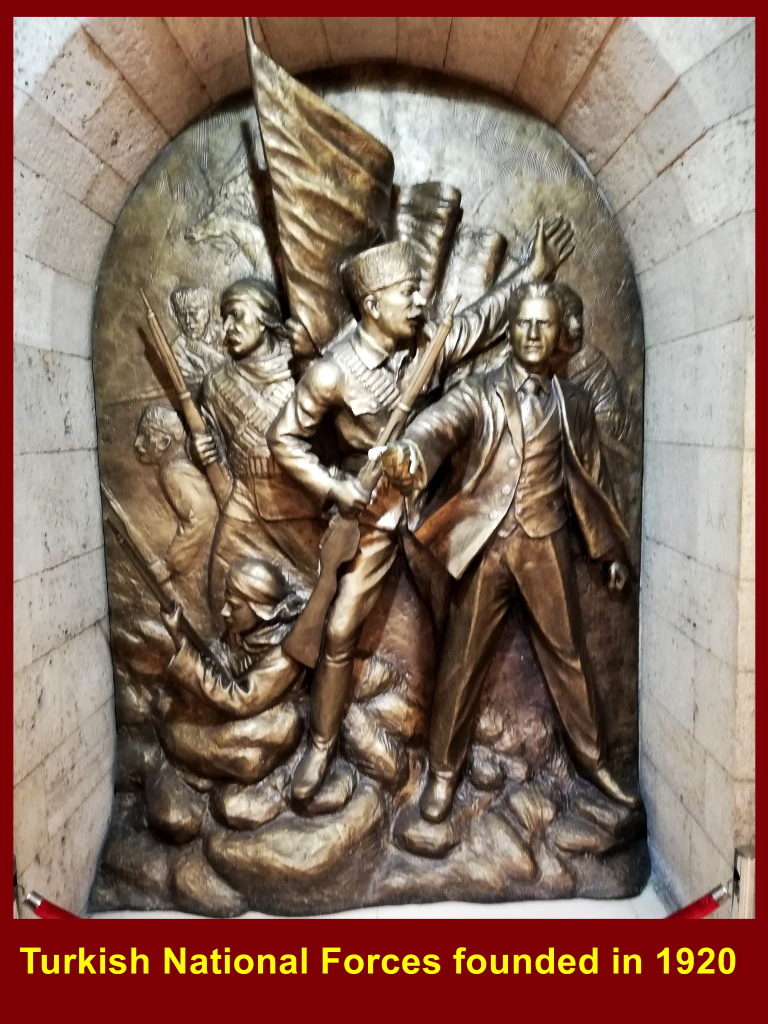
(ii) Inauguration of the Grand National Assembly(1920) and internal revolts
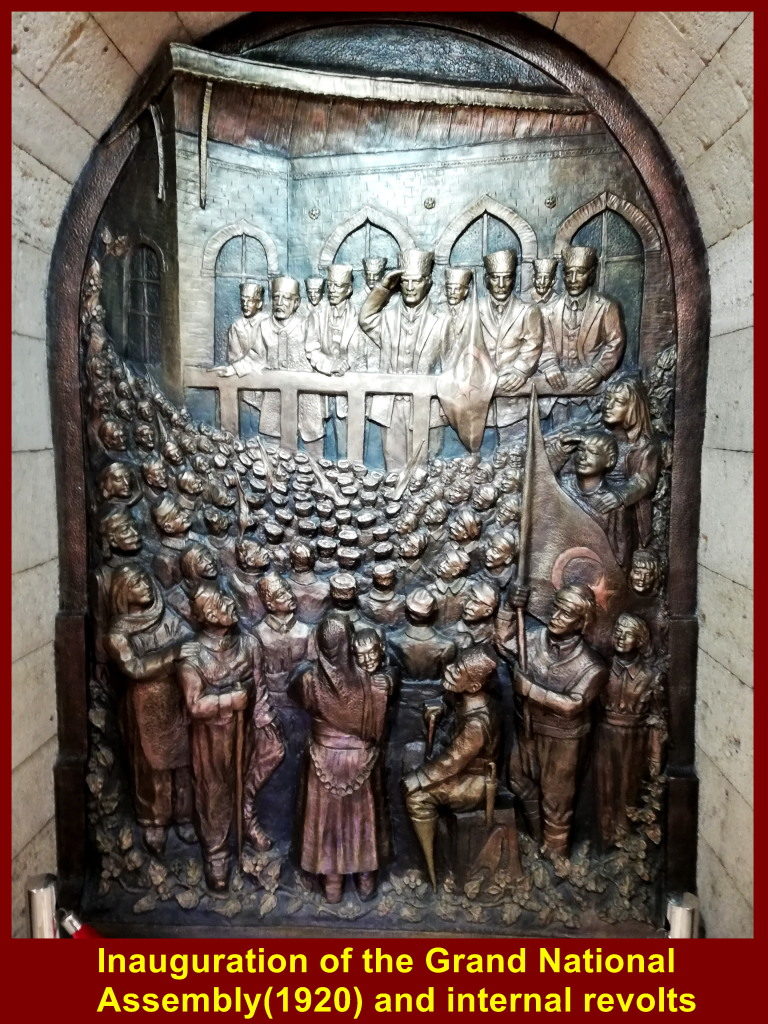
(iii) National struggle in Antep, Maras, Urfa and Thrace
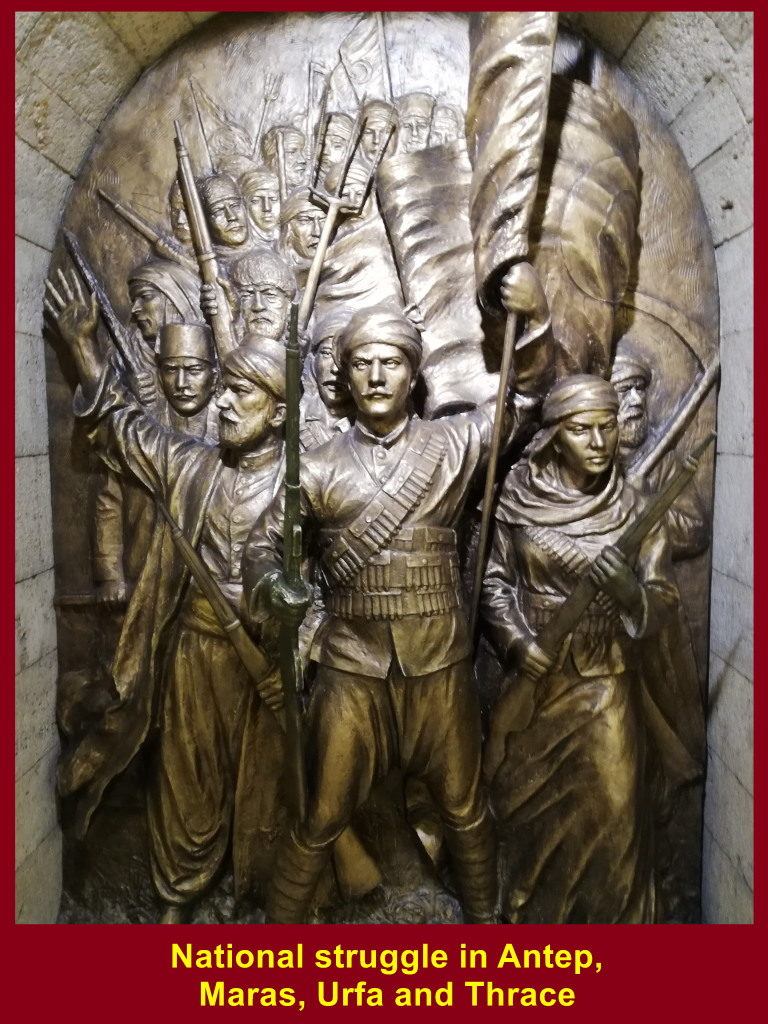
(iv) Vistories, Mudaya Armistice, Treaty of Lausanne and political revolutions
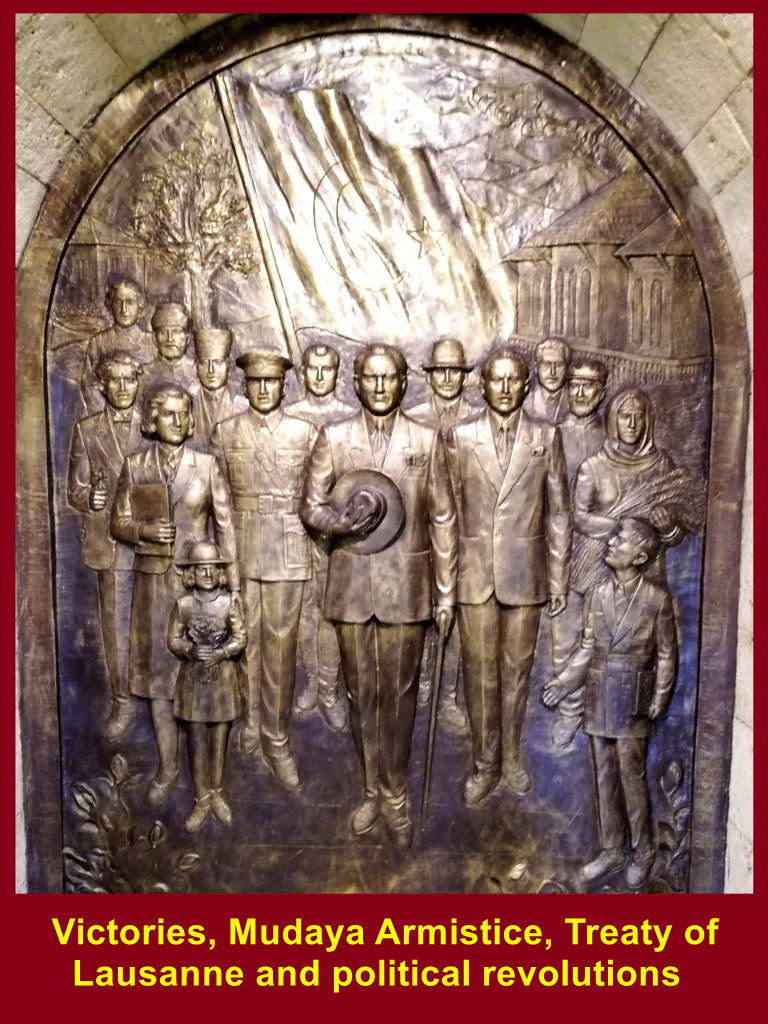
(v) Reforms in law, women’s rights and adoption of surnames
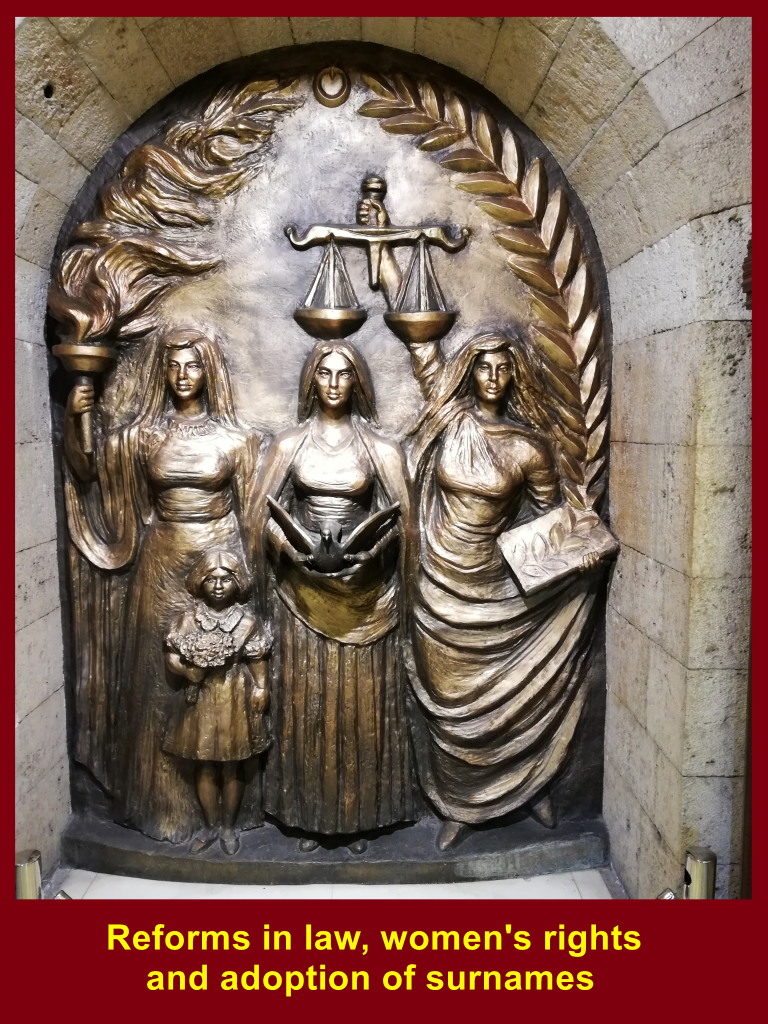
(vi) Turkey’s progress in agriculture, forestry, industry and commerce
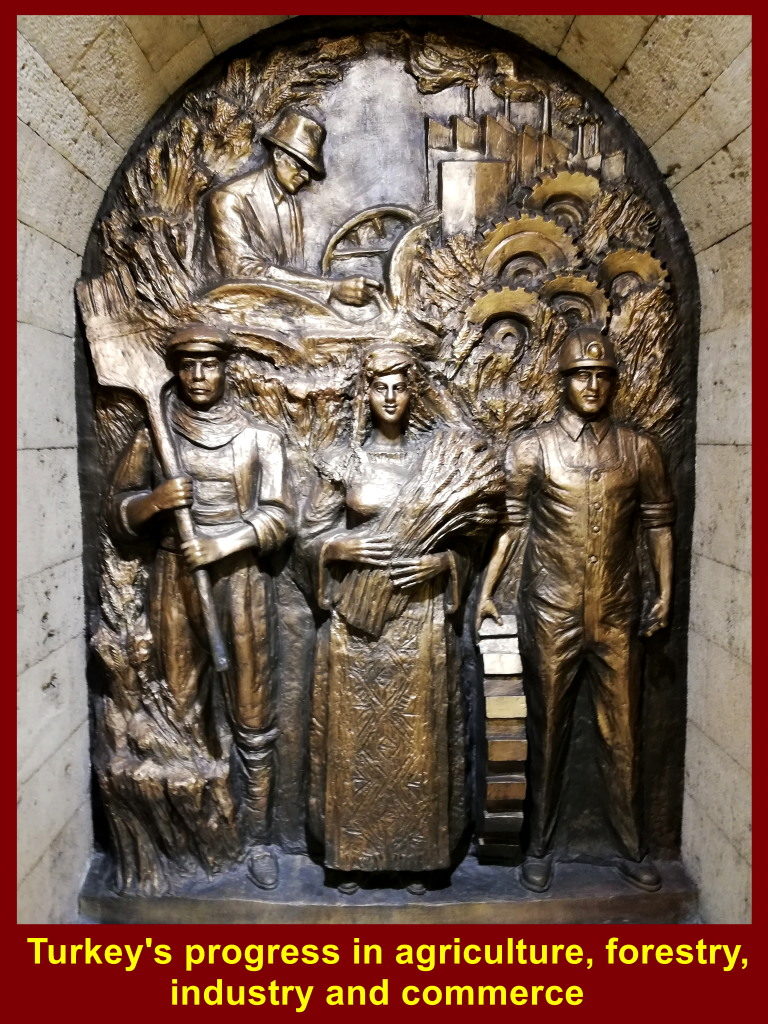
(vii) President of Turkey, Mustafa Kemal Taturk, and his ministers were active in domestic and foreign political events during his term from 1923 until 1938.
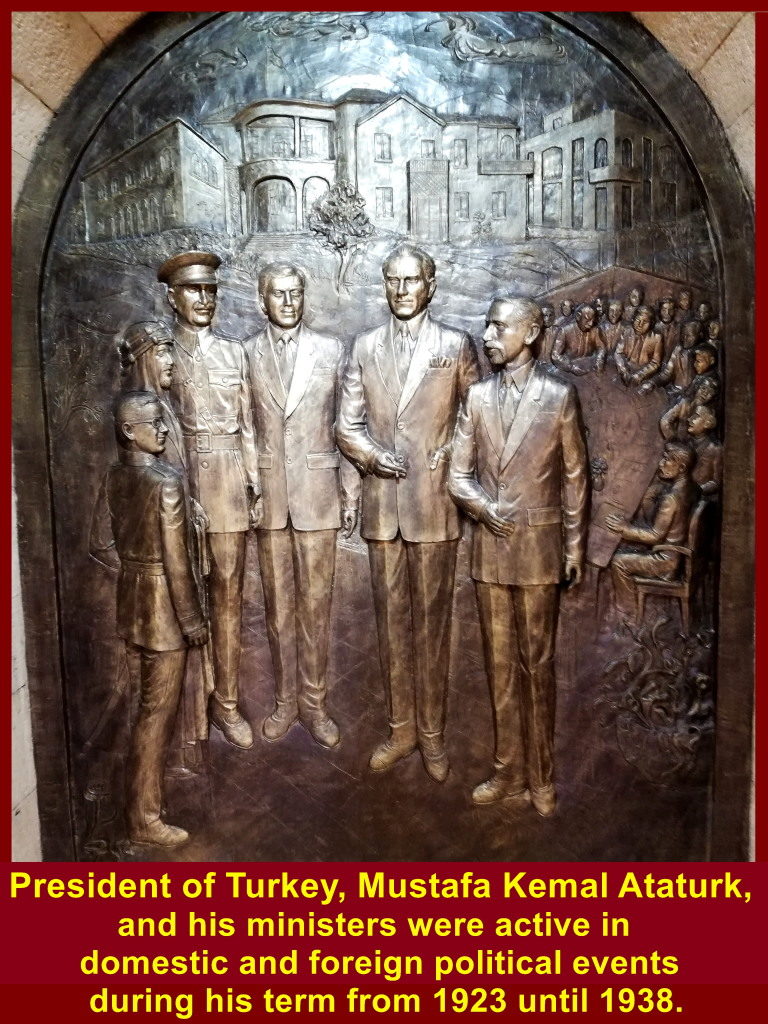
(viii) People of Republic Turkey founded by Mustafa Kemal Ataturk in 1923
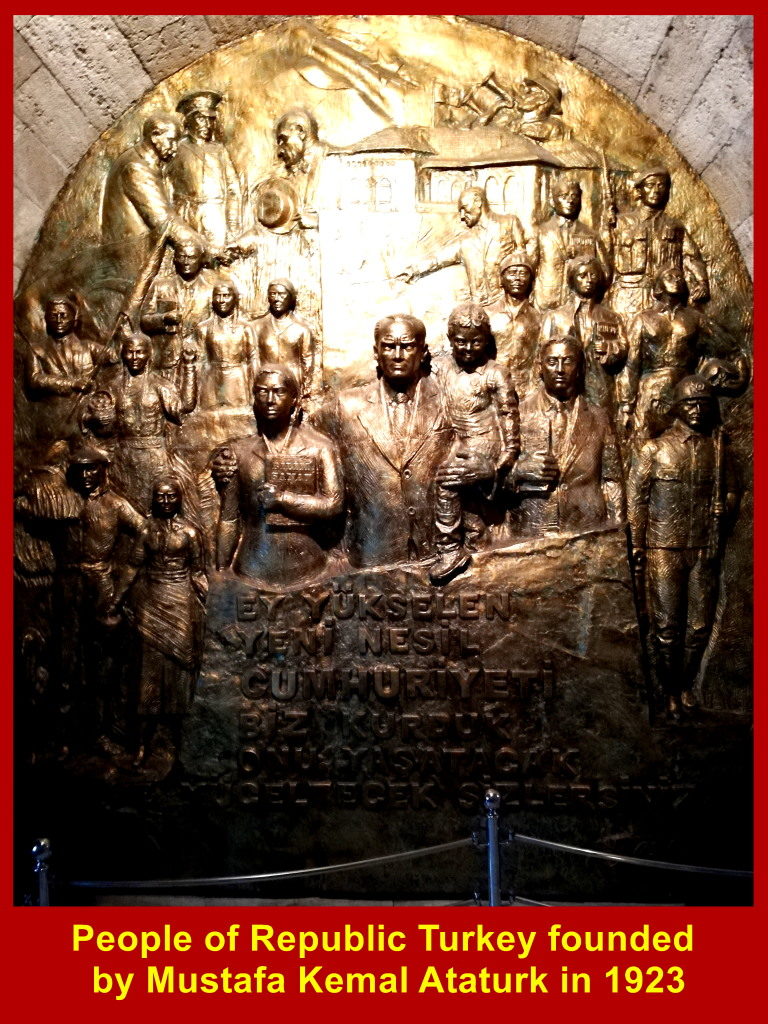
Anitkabir Guards
There are several guards at Anitkabir, Mausoleum of Mustafa Kemal Ataturk, in Ankara. Although there ars standing motionless, they are always watching the visitors.
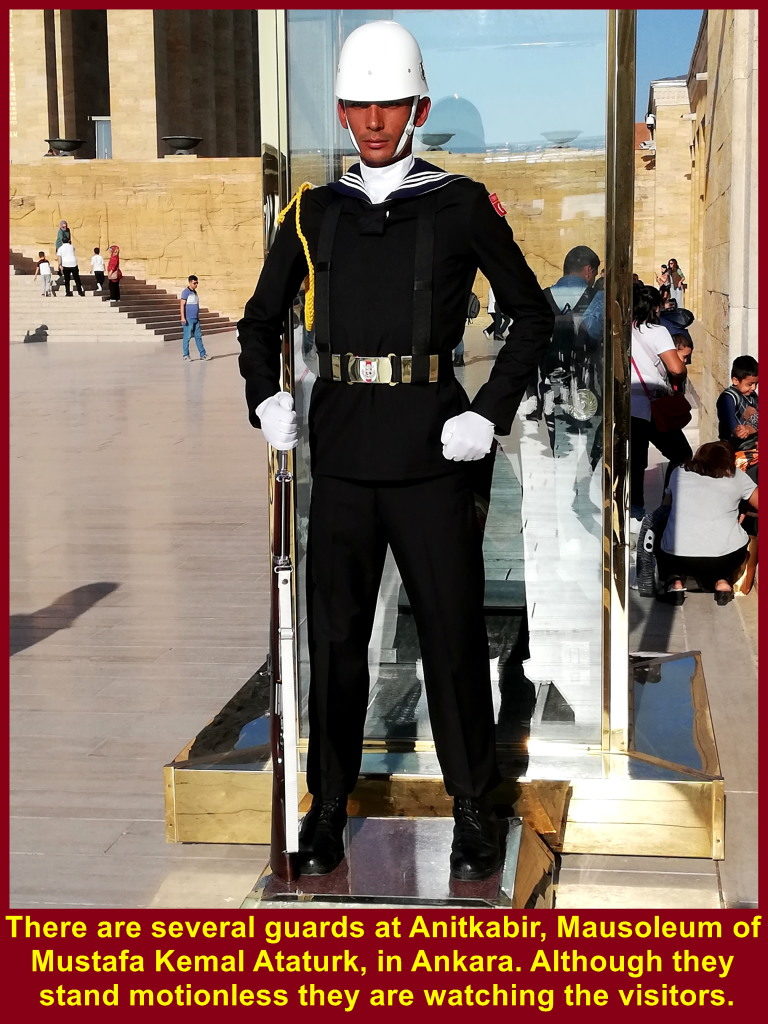
Bera Ankara Hotel, Ankara
At 4 p.m we left Anitkabir, the Mausoleum of Mustafa Kemal Ataturk, and went to Ankara City to have dinner and then checked into a hotel, Bera Ankara Hotel.
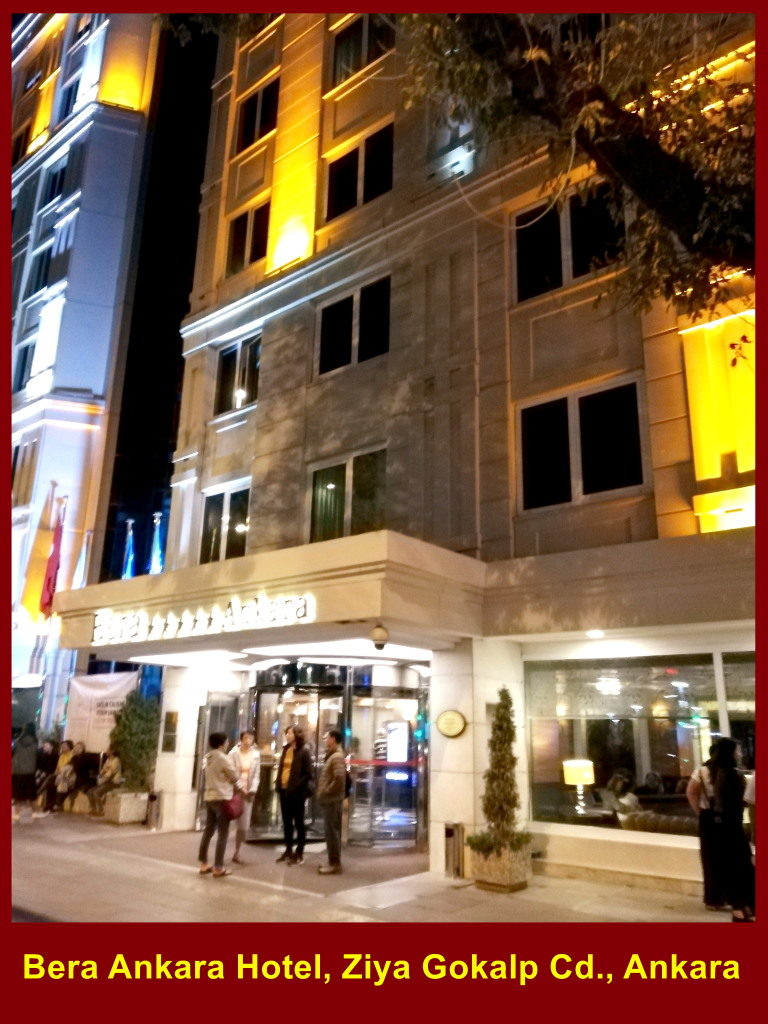
Ziya Gokalp Cd.
At 7 p.m. our tour-manager, Brian Wong, brought us to see the shops along a busy street, Ziya Gokalp Cd., in the City of Ankara.
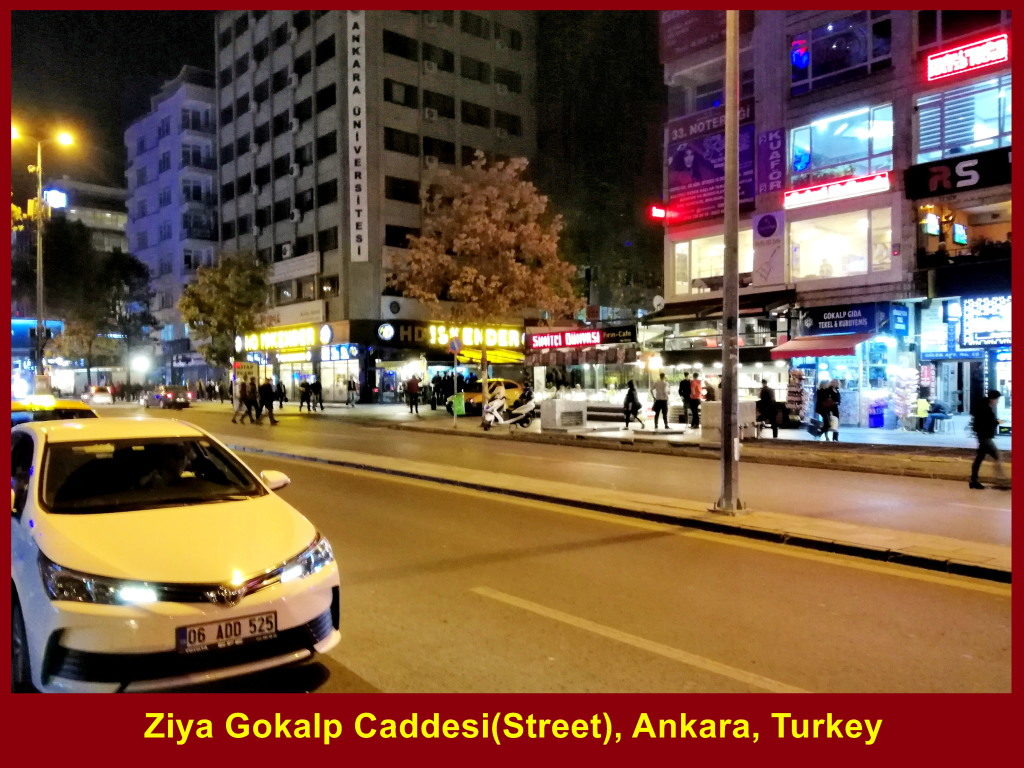
Ice-Cream Delight
After walking a few hundred metres, we stopped at an ice-cream shop, Mado Cafe, and everyone bought an ice-cream each.
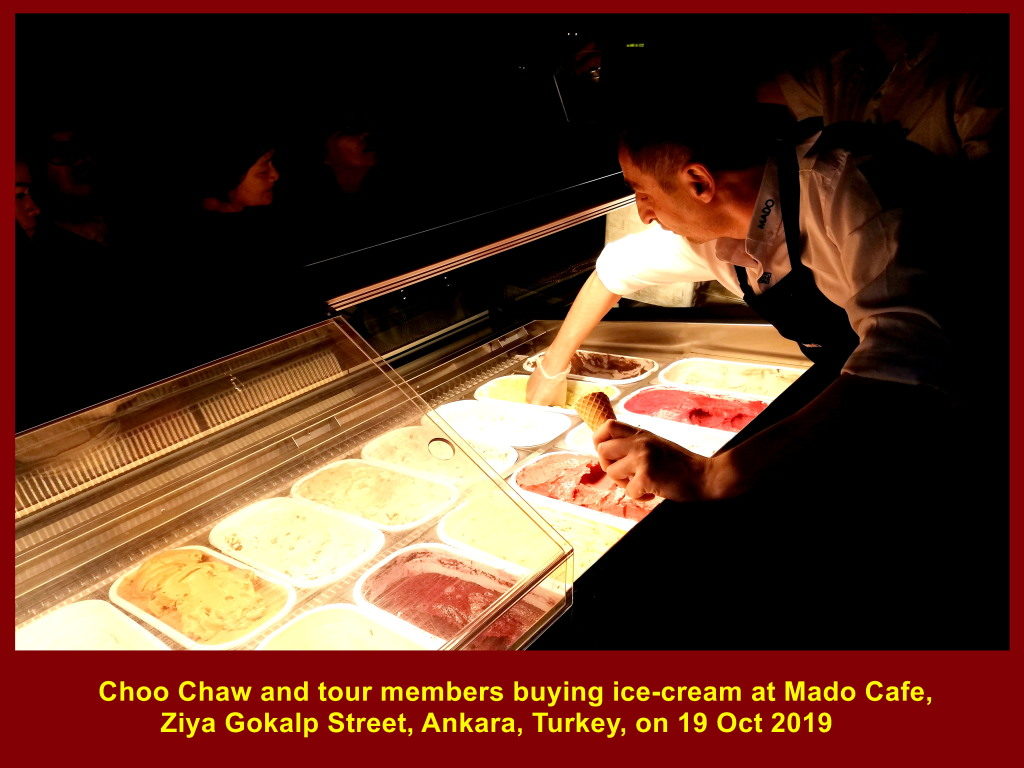
“Wefie”
For remembrance, we took a photo together showing our ice-creams.
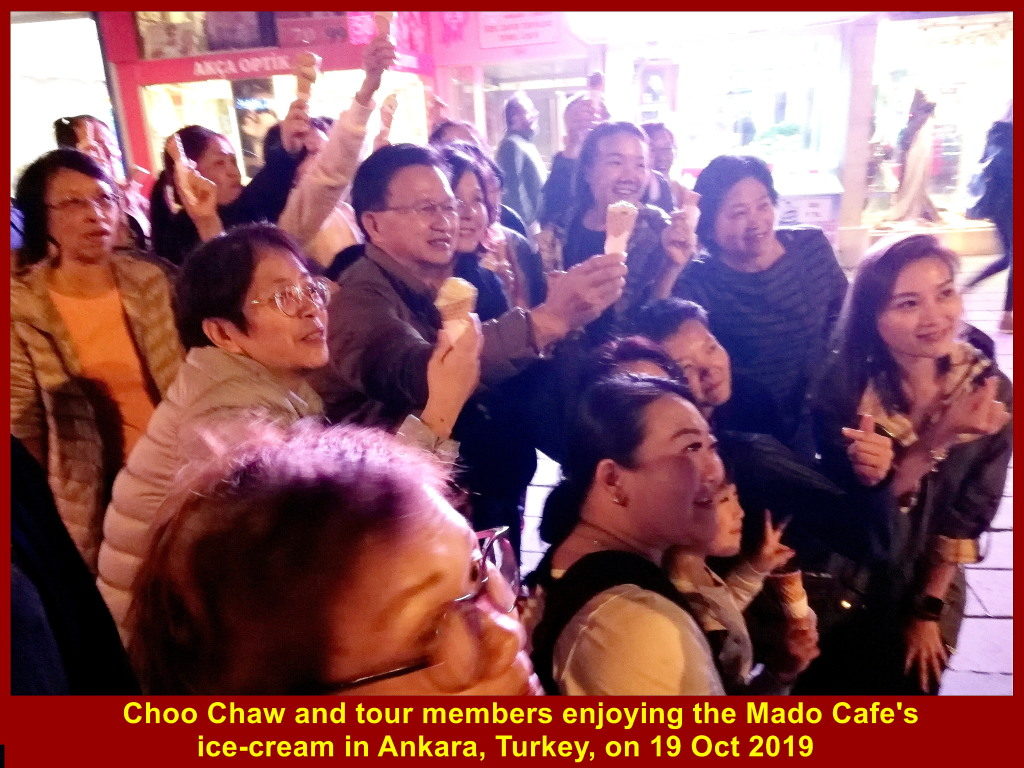
Previous Page / Home / Next Page
Places visited during Turkey Tour(13-22 Oct 2019):
Trojan Horse/Ancient Troy Cities Asklepion Ephesus Hierapolis/Pamukkale Travertine Sultanhani Caravanserai Pasabag Valley Uchisar Valley/Kaymakli Underground City Gerome Valley/Turkish Night Show Hot Air Balloon/Lake Golu/Anitkabir Hagia Sophia/Topkapi Palace/Blue Mosque Bosphorus Boat Cruise Spice Bazaar/Grand Bazaar
Turkey Travel Part X: Hagia Sophia, Topkapi Palace & Blue Mosque
Filed under: Hagia Sophia, Topkapi Palace, Blue Mosque, Turkey Travel
Day 8
Sunday, 20 Oct 2019
Journey to Istanbul
In the morning of 20 Oct 2019, writer and tourmates left Ankara, the capital of Turkey, and travelled 400 km south-west to Istanbul, the largest city of 15 million people in Turkey.
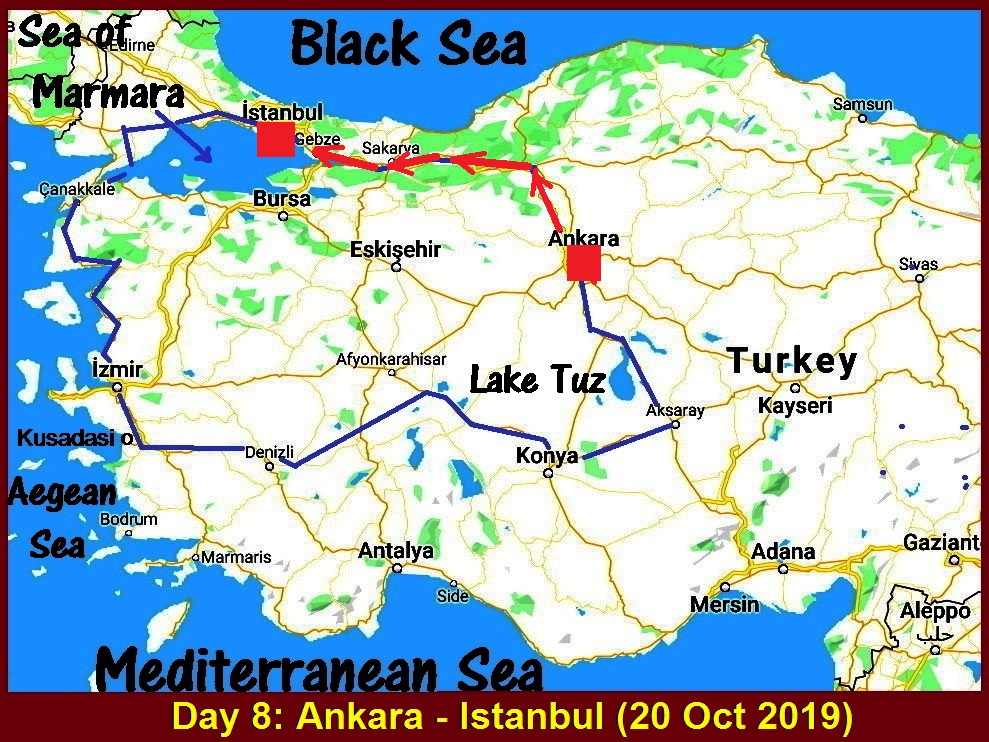
Arrival in Istanbul City
On arrival in Istanbul City, we crossed Bosphorus Bridge over Bosphorus Strait from Asian side to European side at 12 noon on 20 Oct 2019. The bridge was built in 1973, the first one to be built across Bosphorus Strait.

Writer and tourmates crossed the Bosphorus Bridge that links the Asian side to the European side in Istanbul City on 20 Oct 2019.
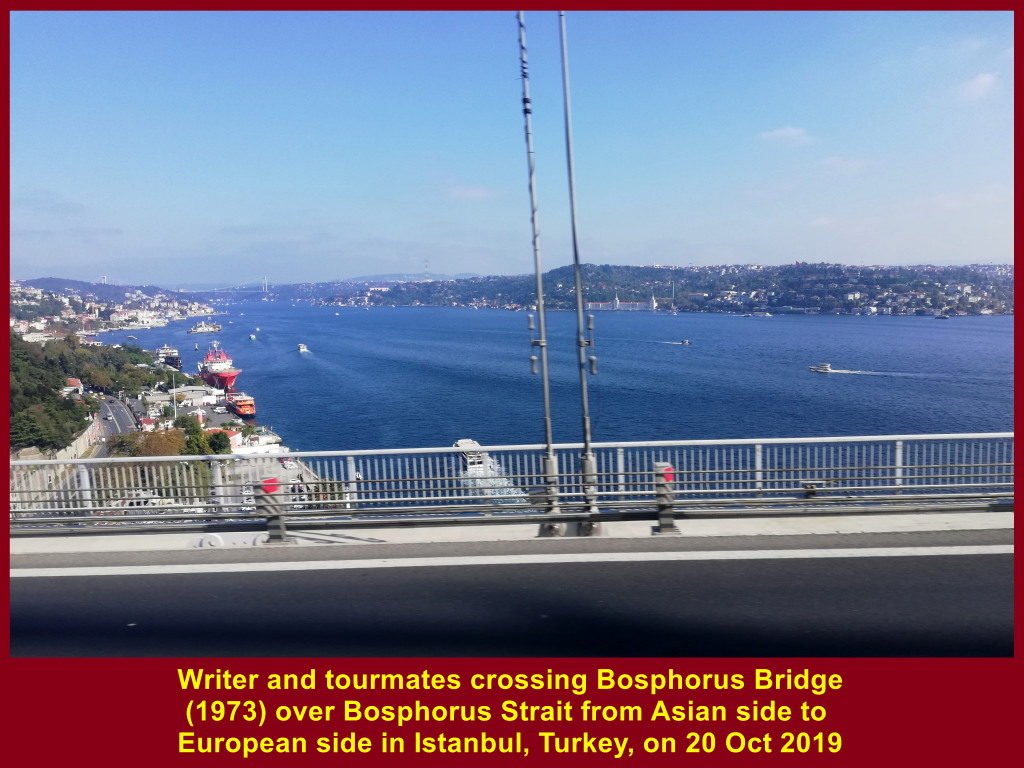
Lunch Time
After crossing the bridge, we went to a restaurant, Sultan Kosesi Restaurant, to have lunch.
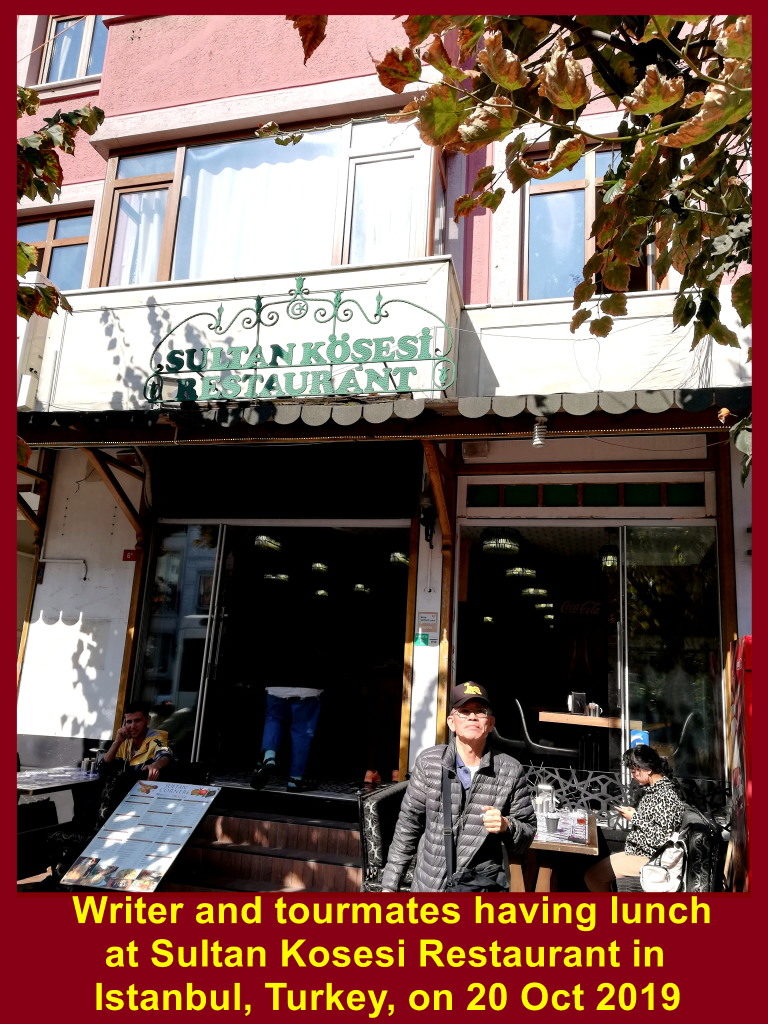
Visiting Hagia Sophia Museum
Immediately, after lunch we went to visit three places of interest, viz. Hagia Sophia or Ayasofya Museum, Topkapi Palace Museum and Blue Mosque in the city of Istanbul.
Pictorial map below shows the location of the three famous places in Istanbul City the writer and tourmates would visit after lunch on 20 Oct 2019.
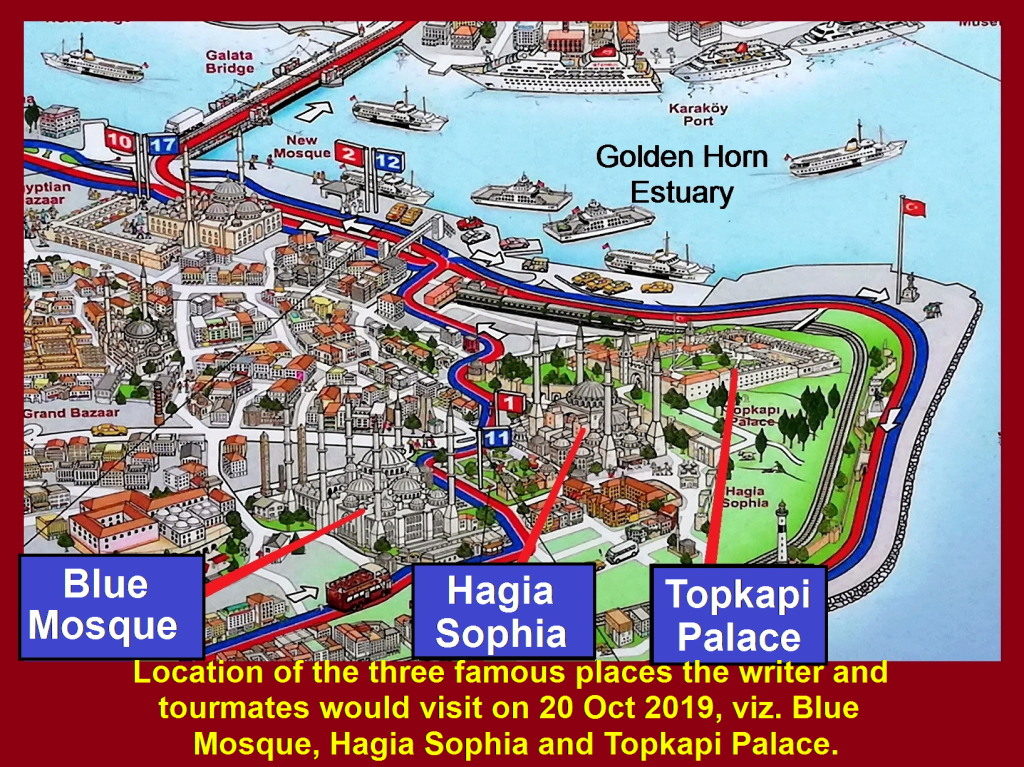
Group photo for remembrance at Hagia Sophia Museum in Istanbul City
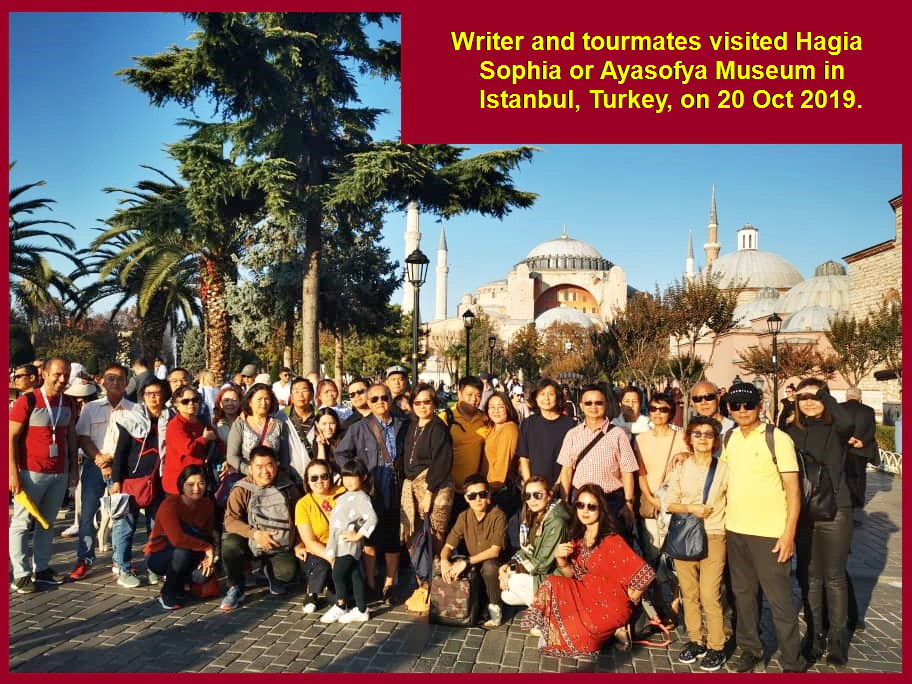
Hagia Sophia, a Byzantine Cathedral
Hagia Sophia was a Byzantine cathedral from 537 until 1453. Then it was an Ottoman mosque from 1453 until 1931. Finally, it is a museum since 1935.
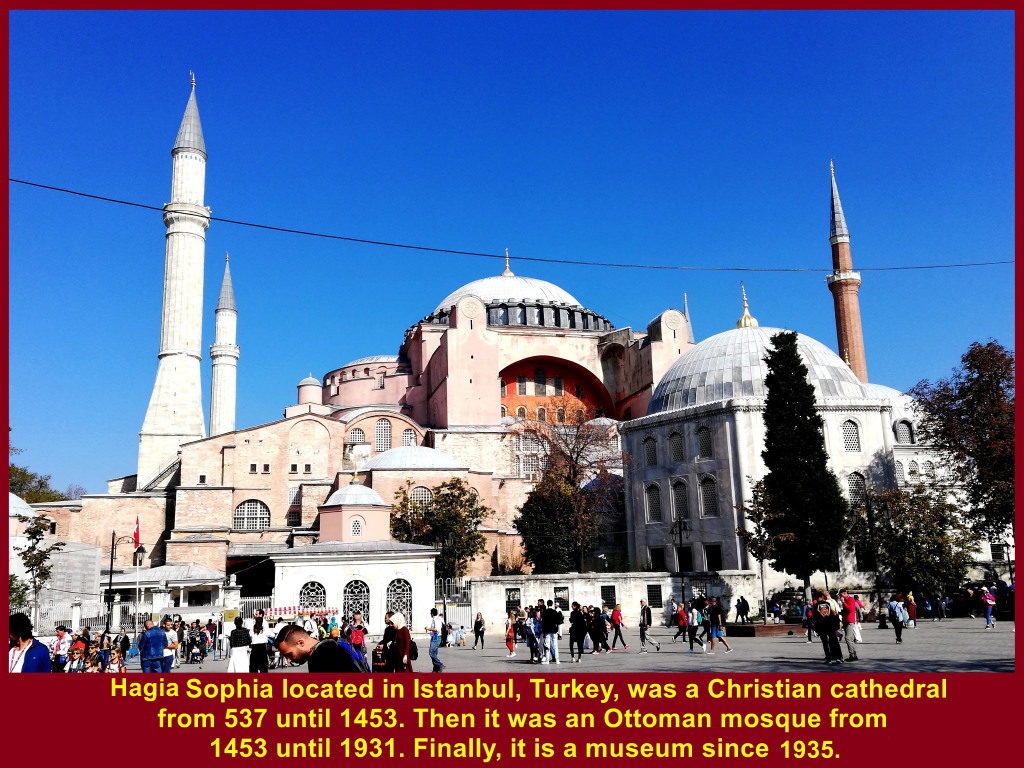
Side view of Hagia Sophia in Istanbul, Turkey
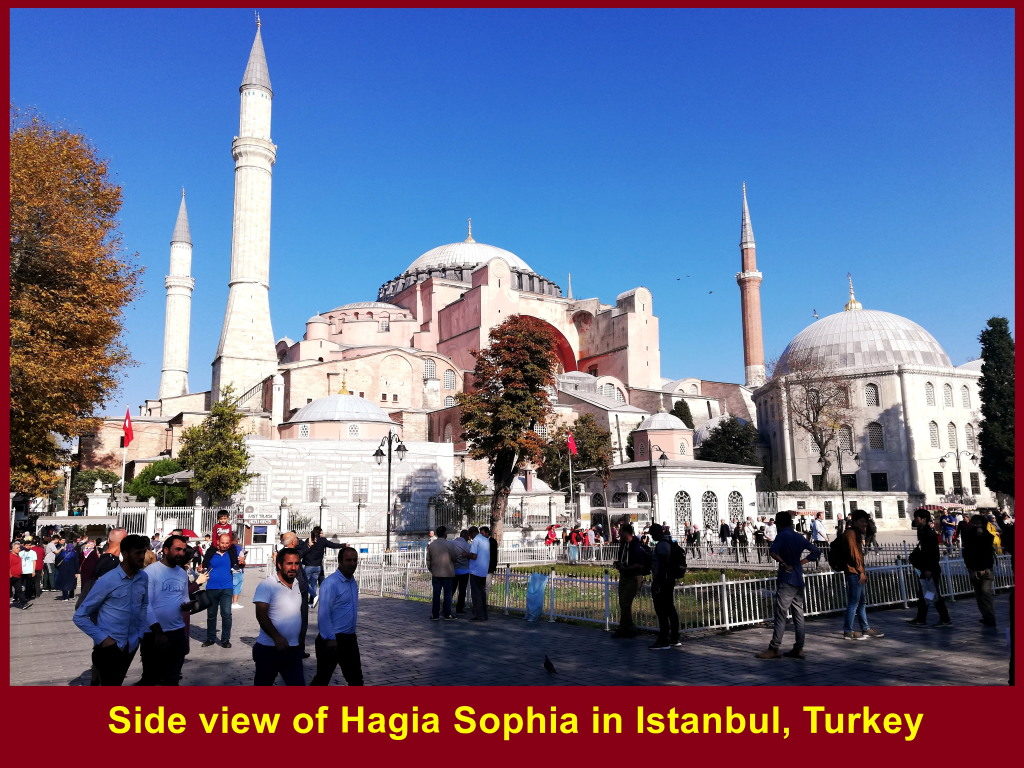
Entrance of Hagia Sophia or Ayasofya Museum in Istanbul, Turkey
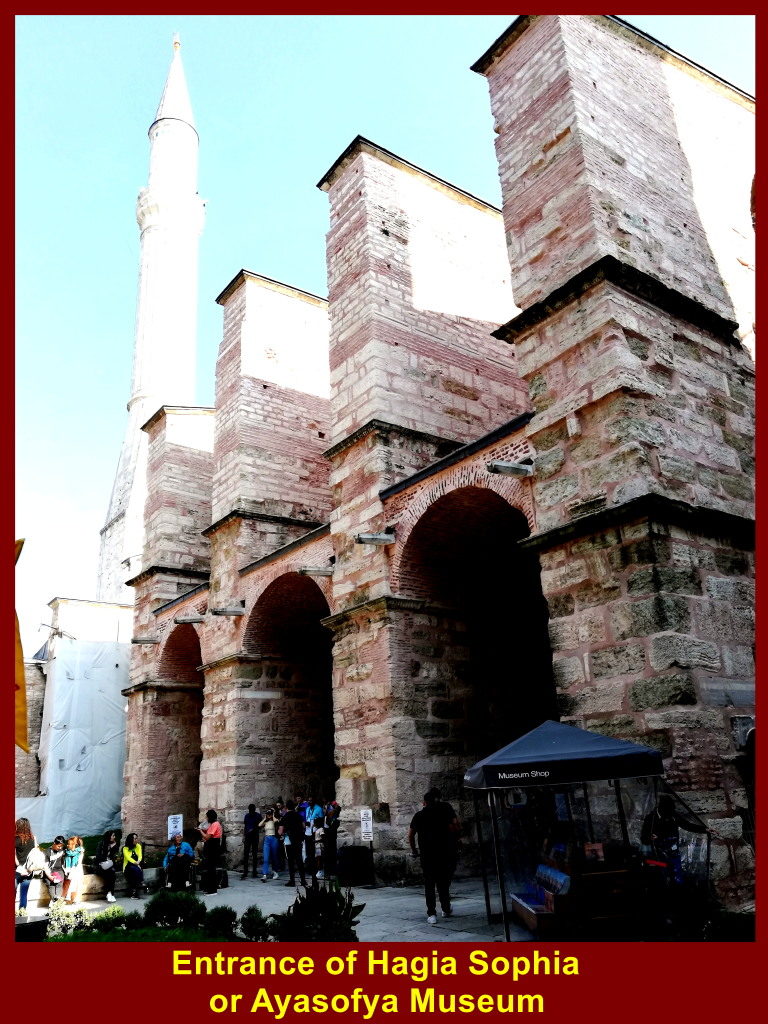
Writer and wife were in the Hagia Sophia Museum on 20 Oct 2019.
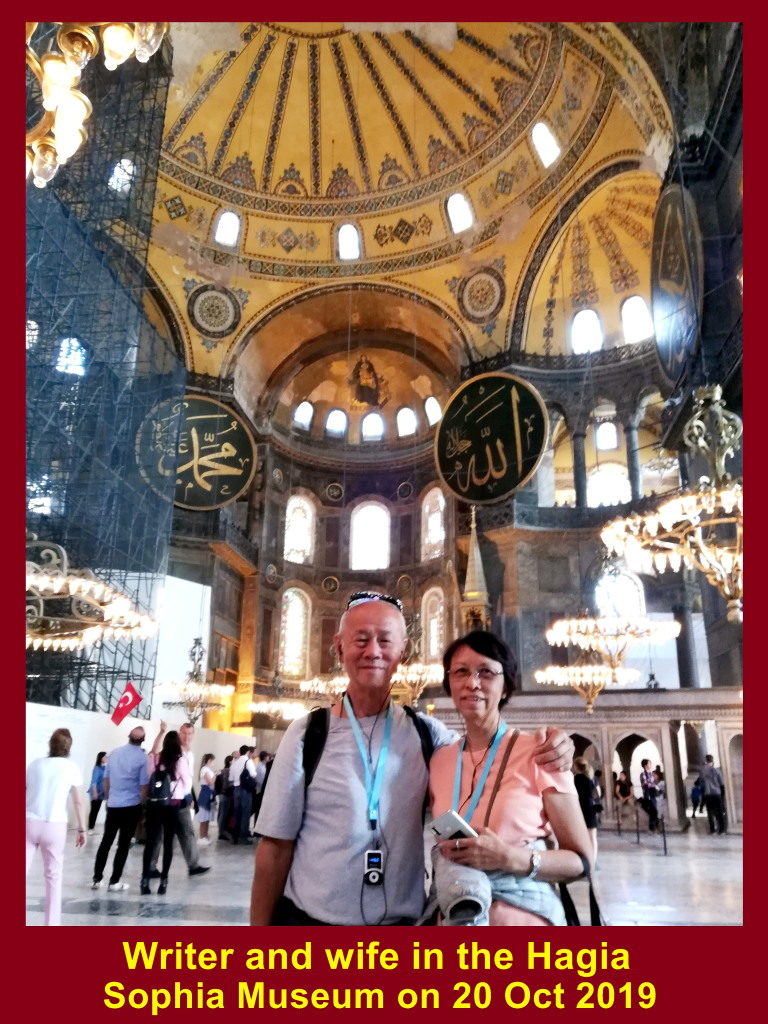
Quranic Writings
In Hagia Sophia Museum, there were two large circular boards with quranic writings hanging on the vaults above the prayer niche(mihrab).
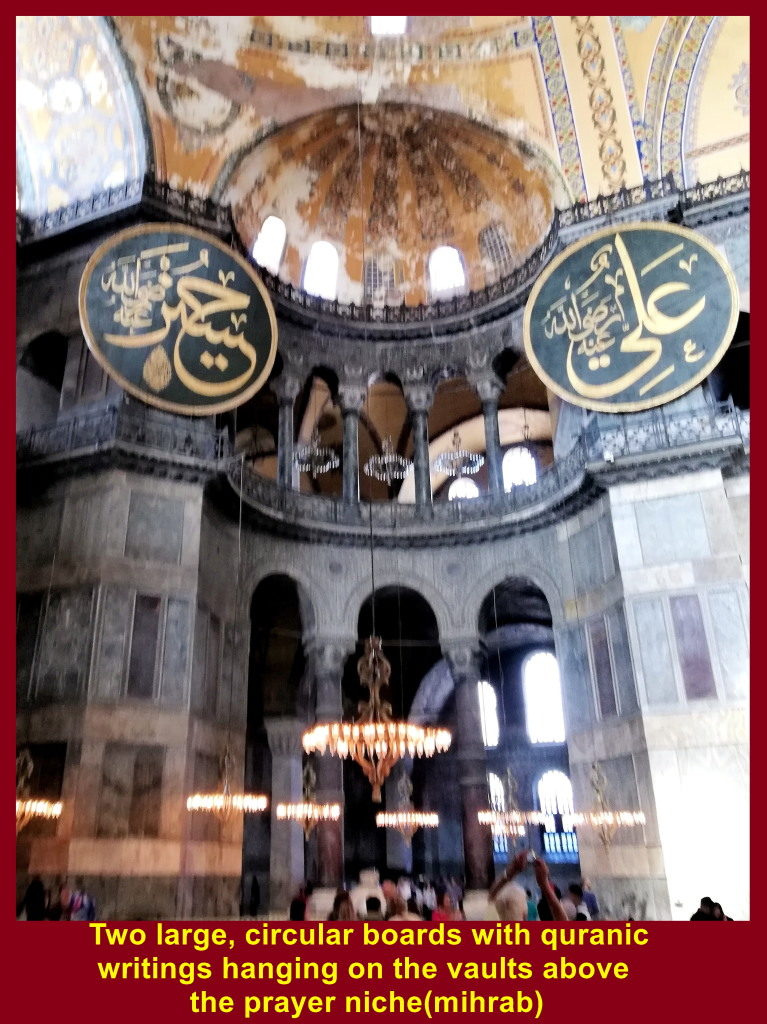
There were another two large circular boards with quranic writings hanging on the vaults above the back of the nave in Hagia Sophia Museum.
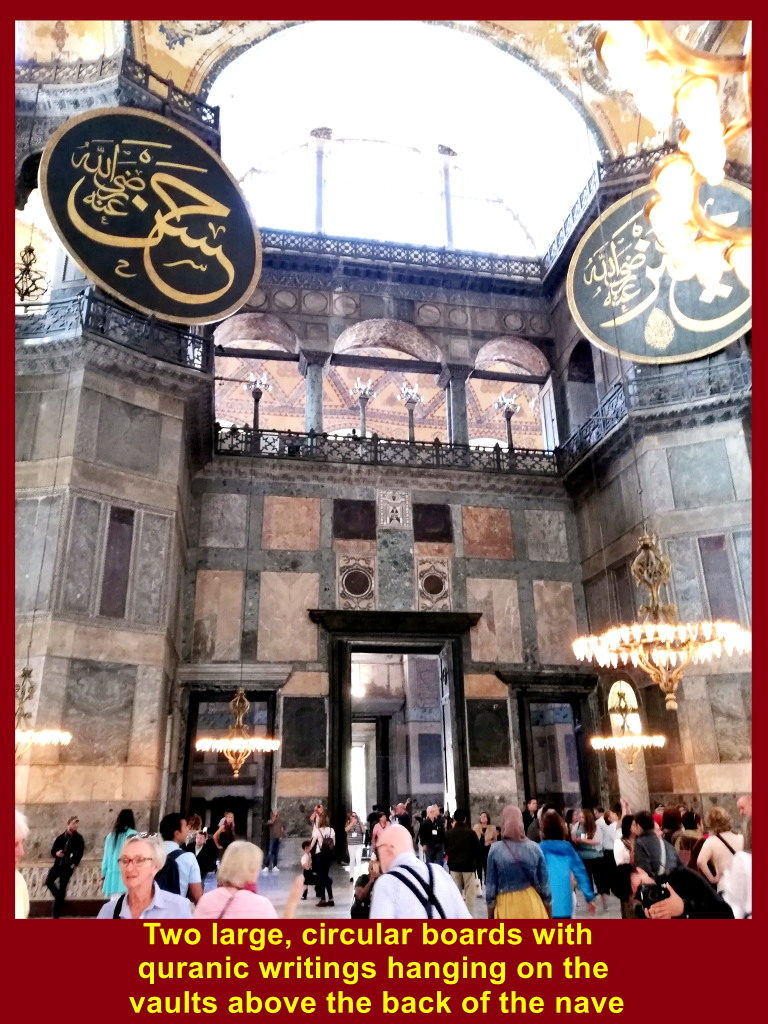
The inner part of a large dome above the nave of Hagia Sophia Museum was written with quranic verses.
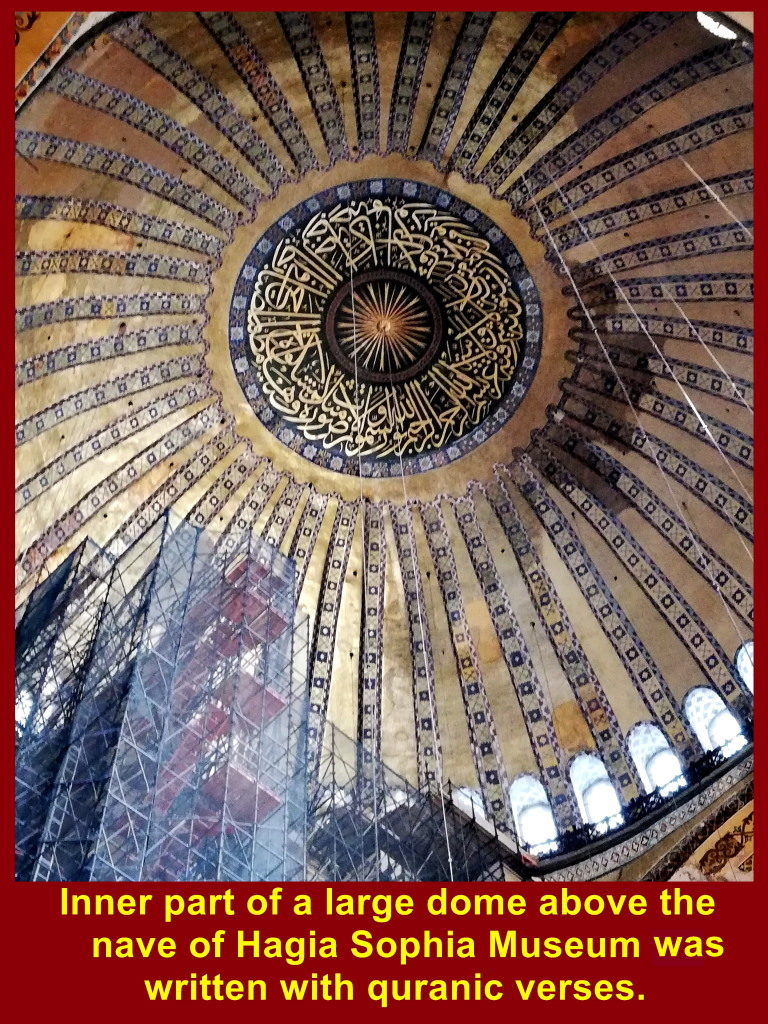
Upper Gallery
The ceilings of the upper gallery of Hagia Sophia Museum were richly painted with motifs.
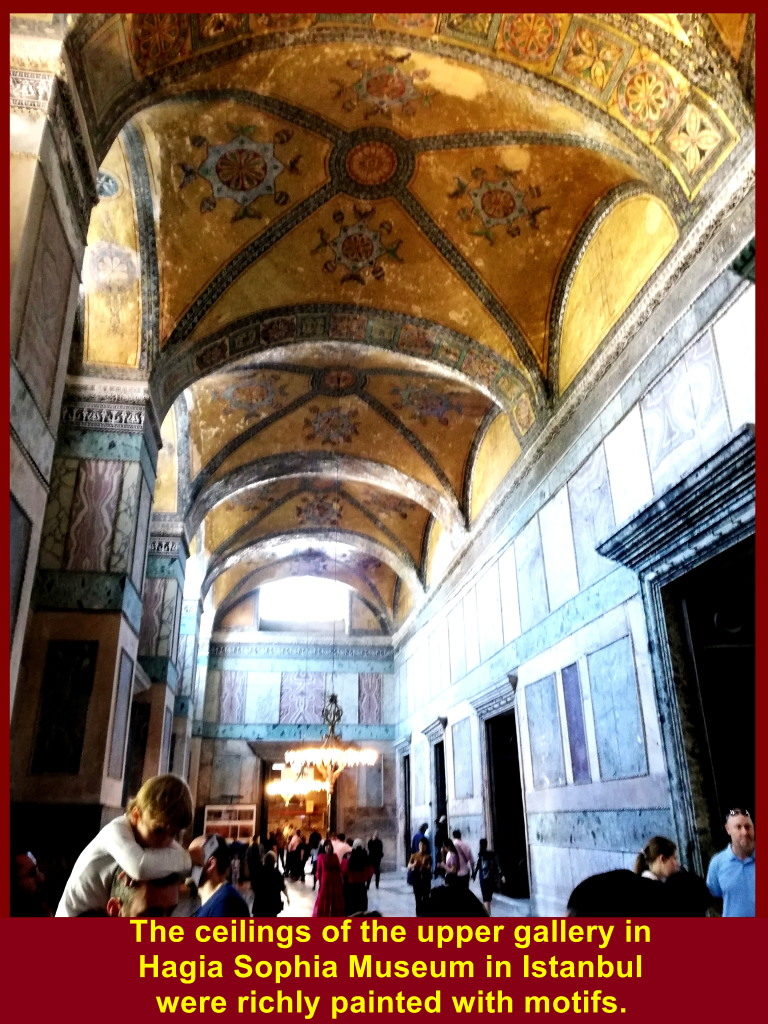
Marble-Stone Ramp
There was a ramp covered with smooth marble-stones for visitors to go up to the upper gallery of Hagia Sophia or Ayasofya Museum.
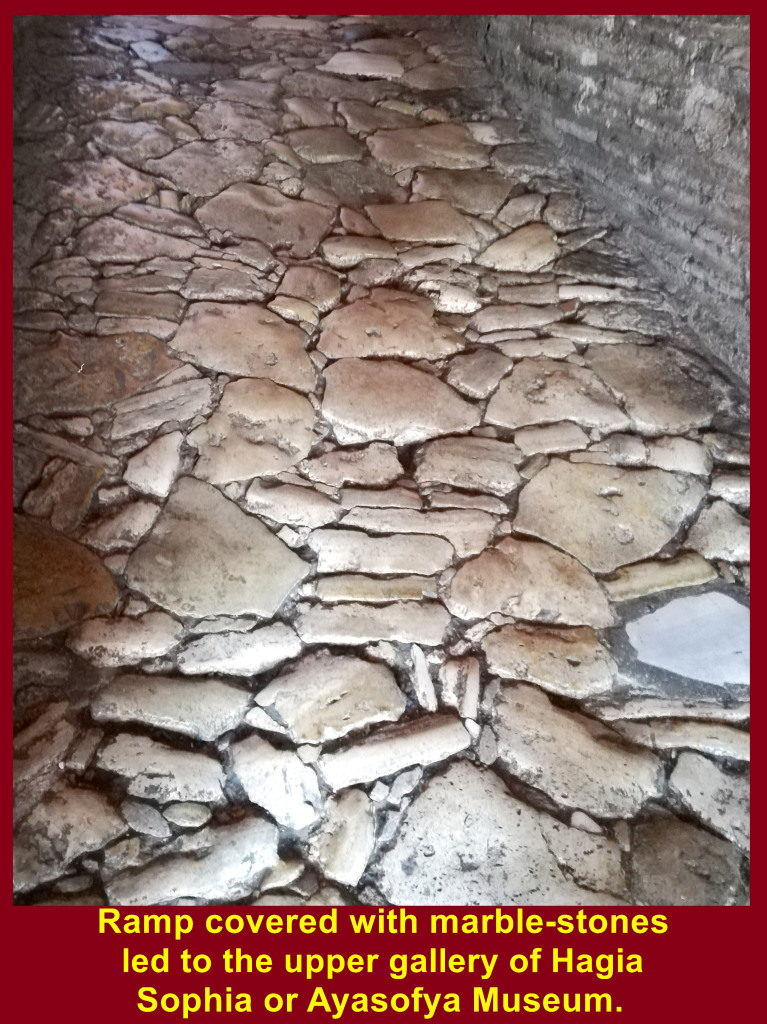
Prayer Niche(Mihrab)
View of the prayer niche(mihrab) in the background as seen from the upper gallery of Hagia Sophia Museum in Istanbul.
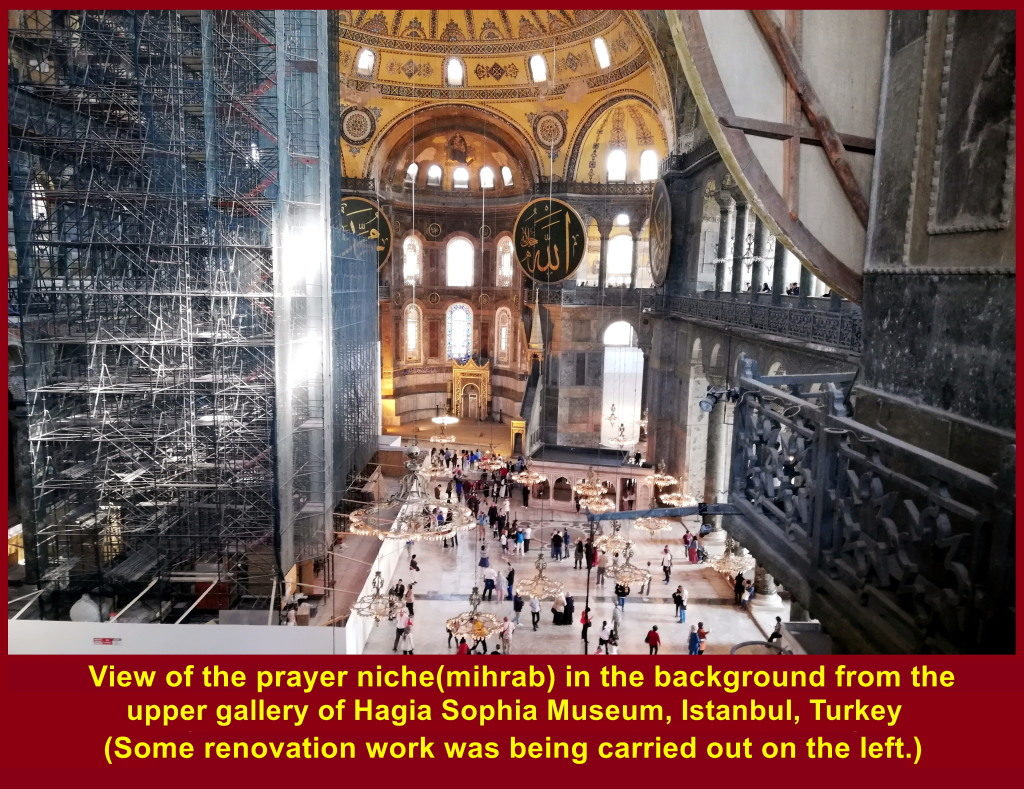
Marble Wall
On the upper floor of Hagia Sophia Museum there was a marble wall of the 6th. Century separating the Emperor’s private chambers from the meeting chamber for church members.
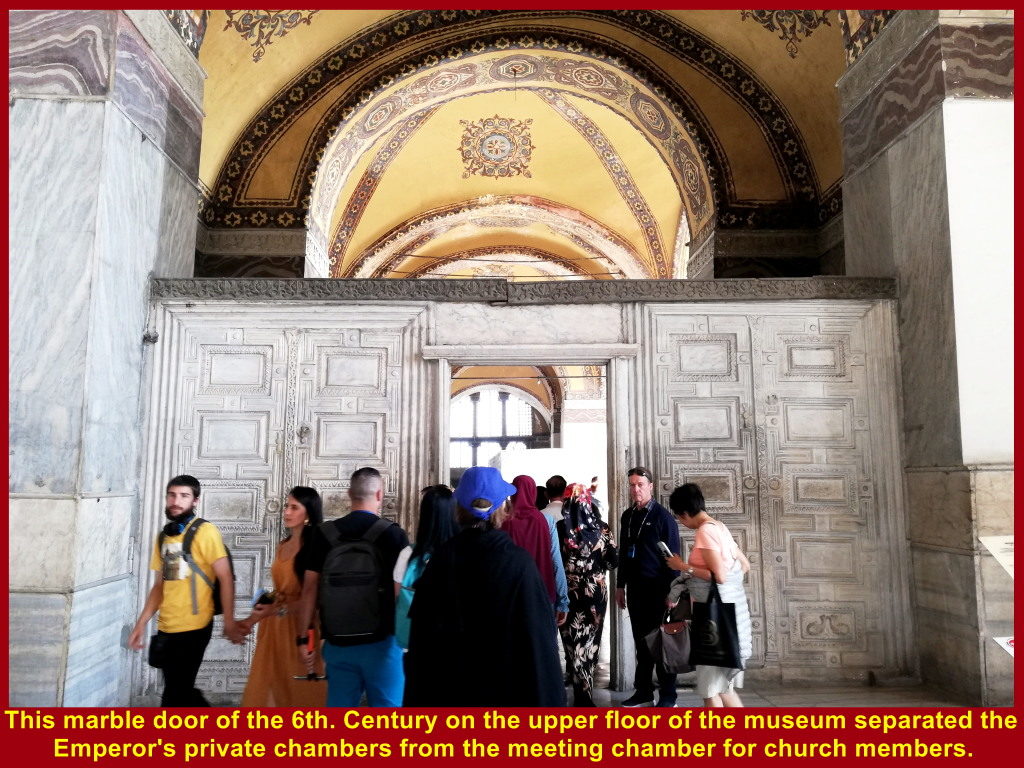
Coloured Mosaic Murals
In the upper gallery there were several coloured mosaic murals on the walls with pictures of Christian religious figures. But they were partially removed when the cathedral was transformed into a mosque by the Ottoman Empire in 1453.
Here are some of the vandalized mosaic murals.
(i) The damaged mosaic mural of Christ with a book flanked by John and Virgin Mary or “Deesis”
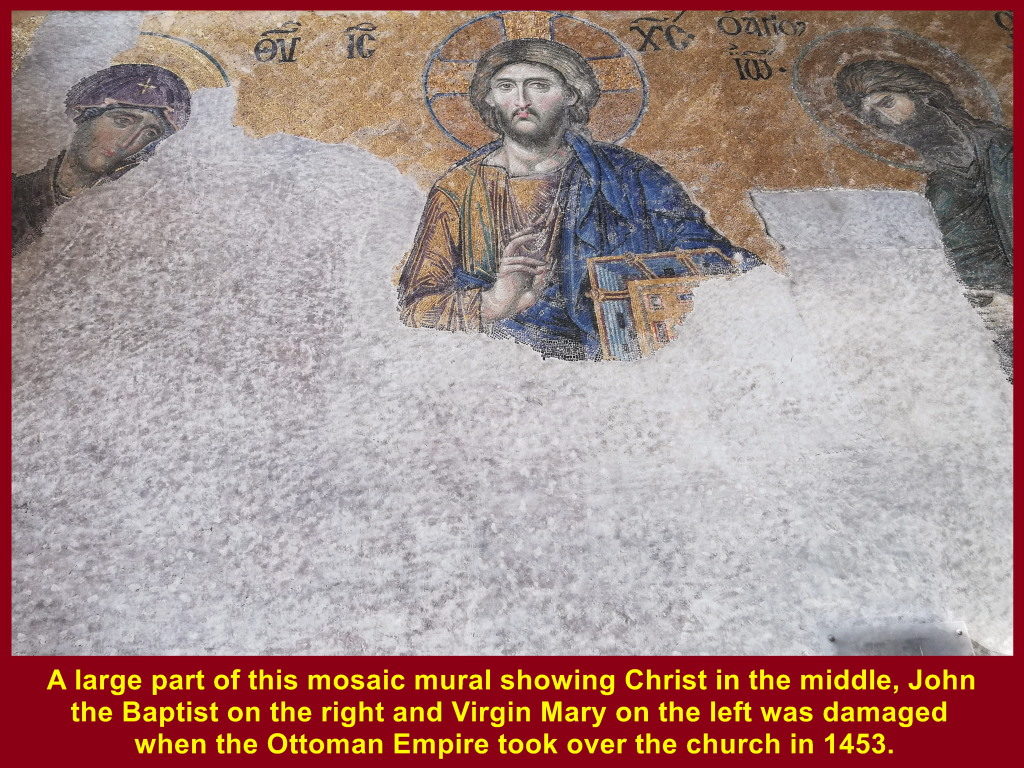
(ii) The damaged mosaic mural of “Deesis” should have been like the picture below.
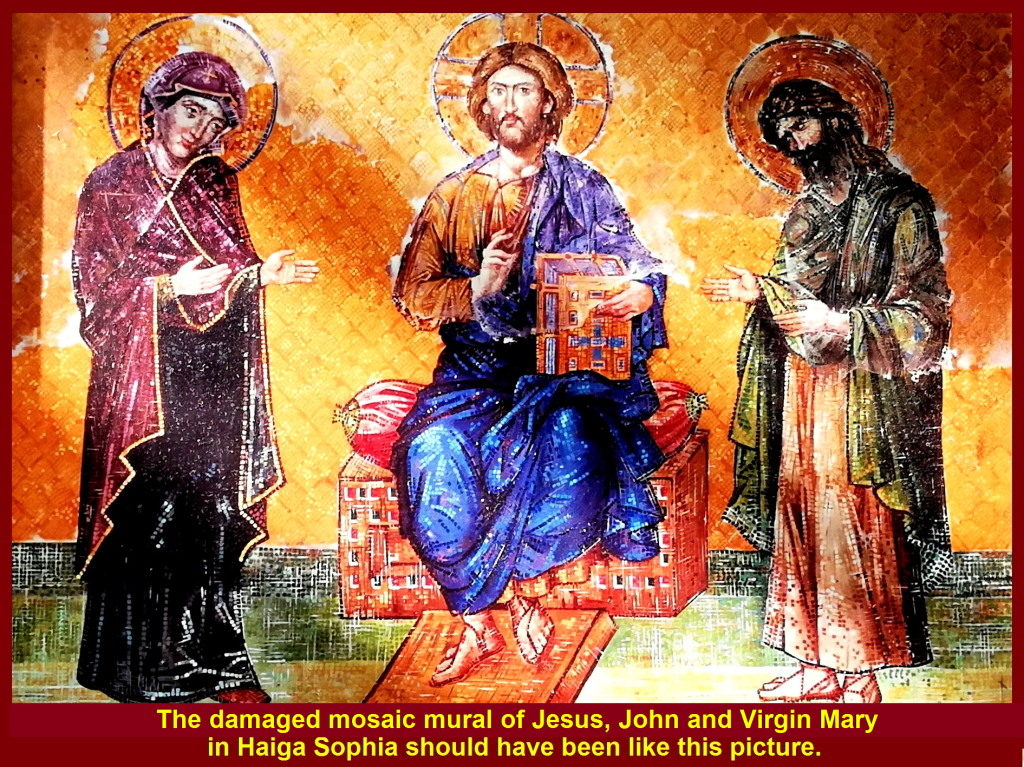
(iii) The lower part of the mosaic mural of Virgin Mary with her child, Emperor John II and his wife, Eirene, was damaged.
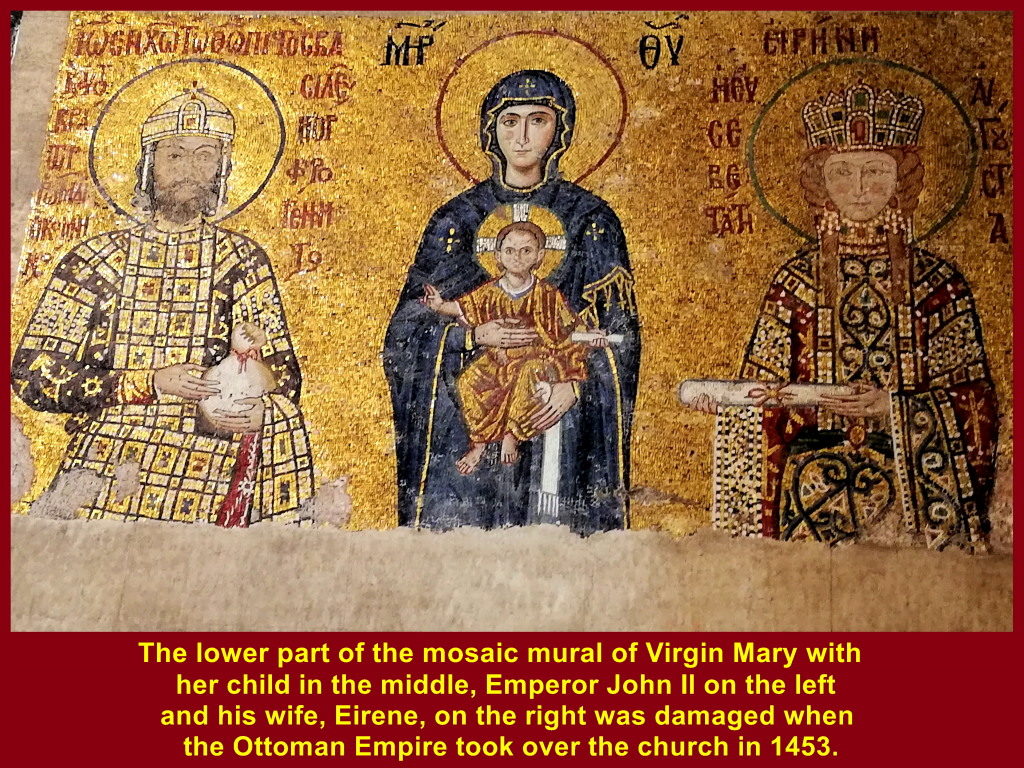
(iv) Similarly, the lower part of the mosaic mural of Christ, Emperor Constantine IX Monomachos and Empress Zoe was damaged when the Ottoman Empire took over the cathedral in 1453.

Untouched Columns
Some columns in Hagia Sophia Museum were untouched by the Byzantine Empire, as shown below.
(i) A column in Hagia Sophia Museum was untouched when the Ottoman Empire took over the cathedral in 1453.
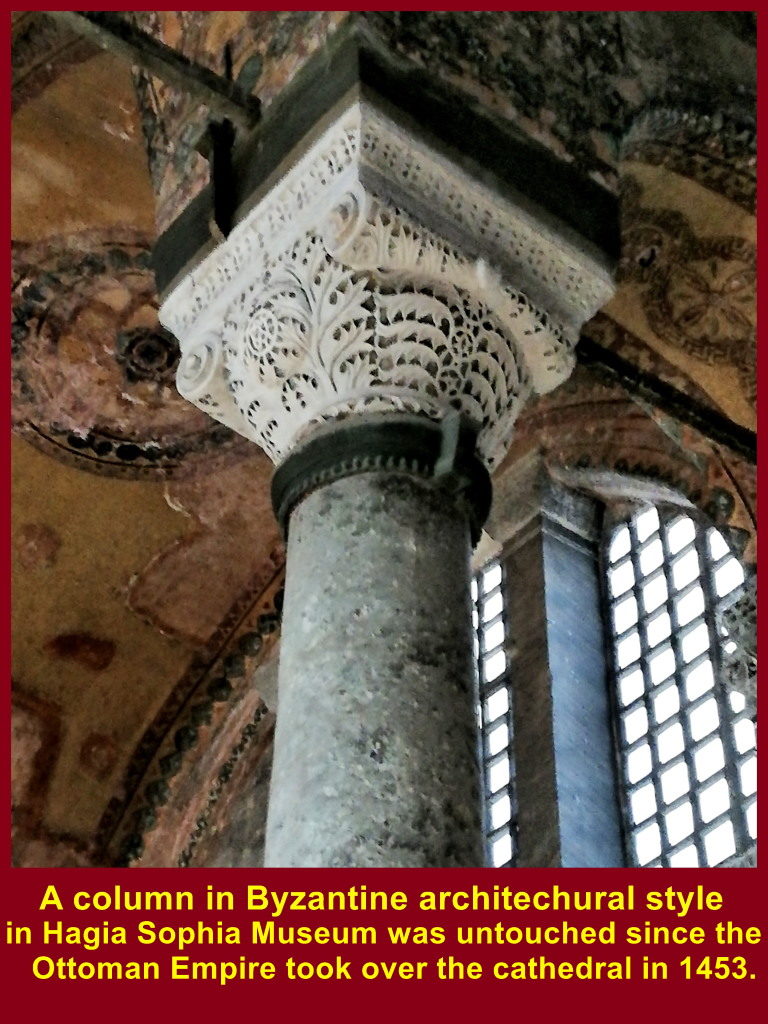
(ii) Another column in Hagia Sophia Museum was untouched when the Ottoman Empire took over the cathedral in 1453.
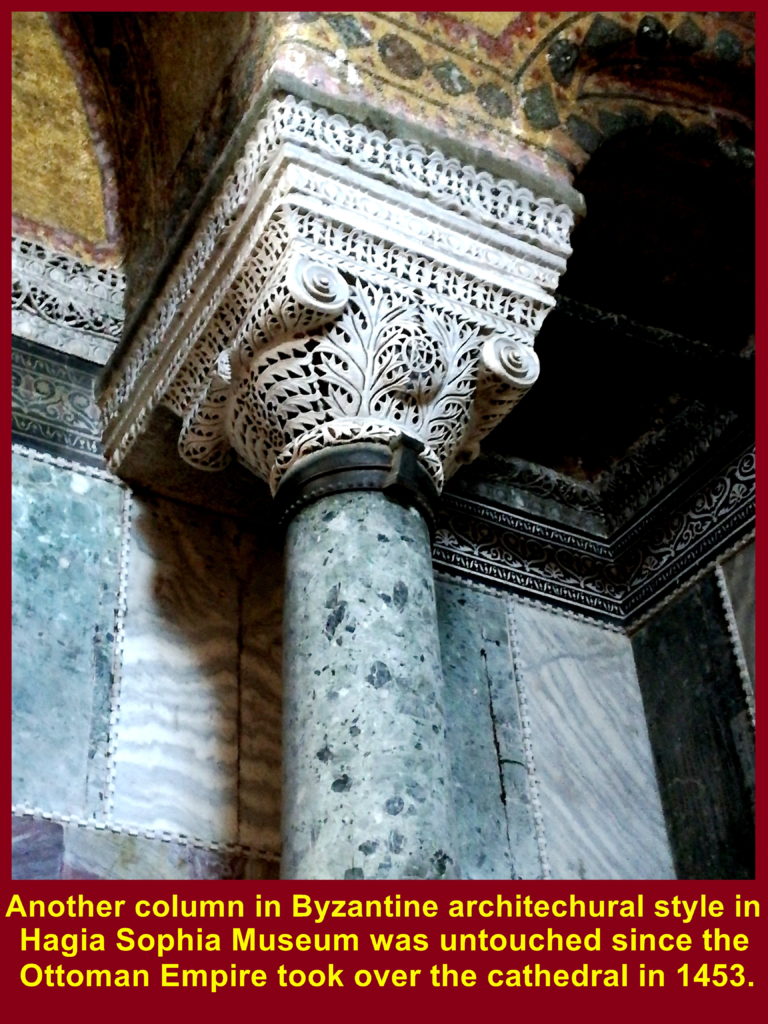
Removal of Christian Images
Christian images were removed from all the pillars and walls in Hagia Sophia Museum since the Ottoman Empire ruled Turkey in 1453.
(i) A Christian image was removed on the pillar in Hagia Sophia Museum when the Ottoman Empire ruled Turkey since 1453.
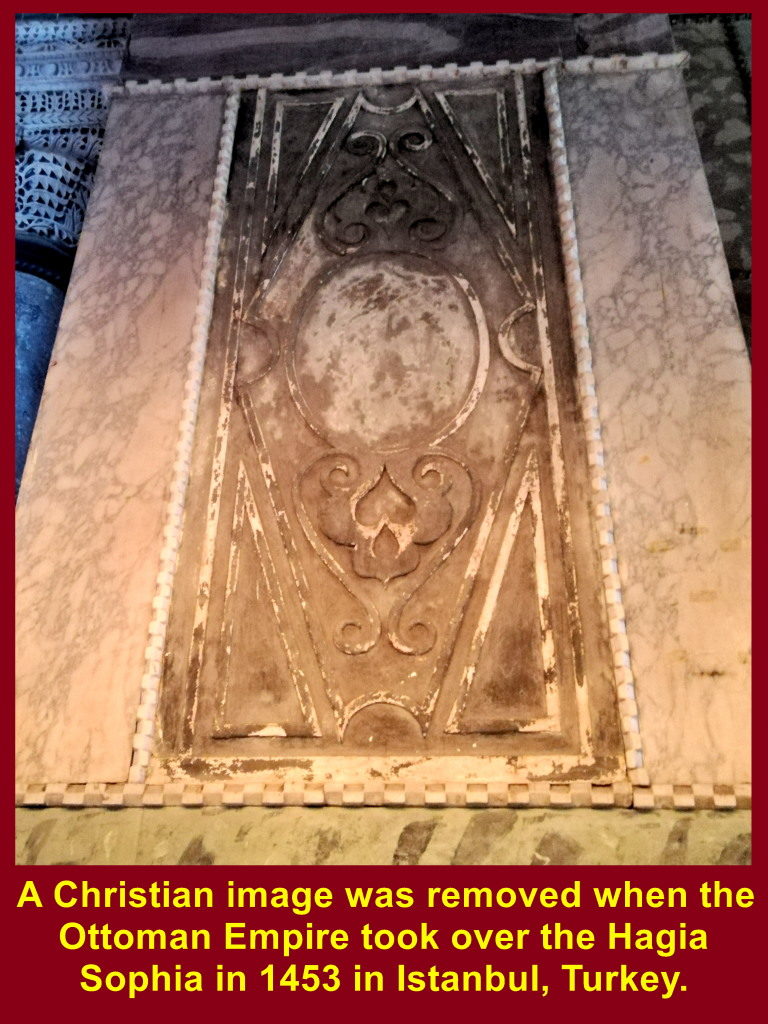
(ii) Another Christian image was removed from another pillar in the museum since the Ottoman Empire ruled Turkey in 1453.
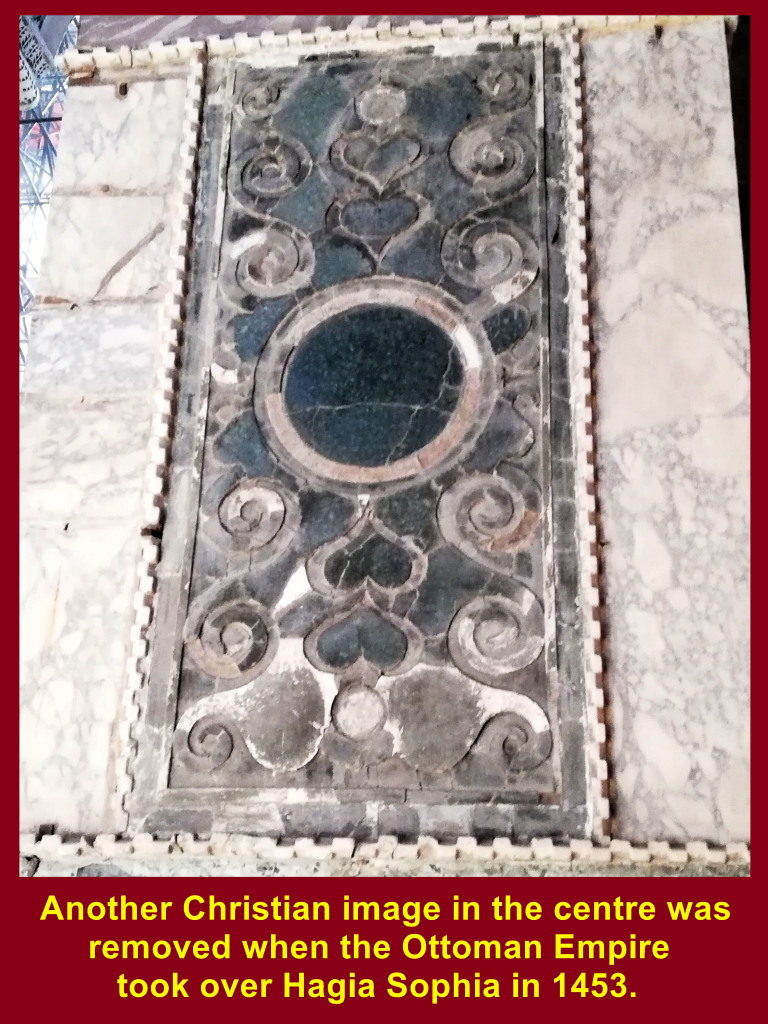
(iii) A column with a cross was removed from Hagia Sophia Museum and left outside the cathedral since the Ottoman Empire ruled Turkey in 1453. A cross is a symbol of Christianity.
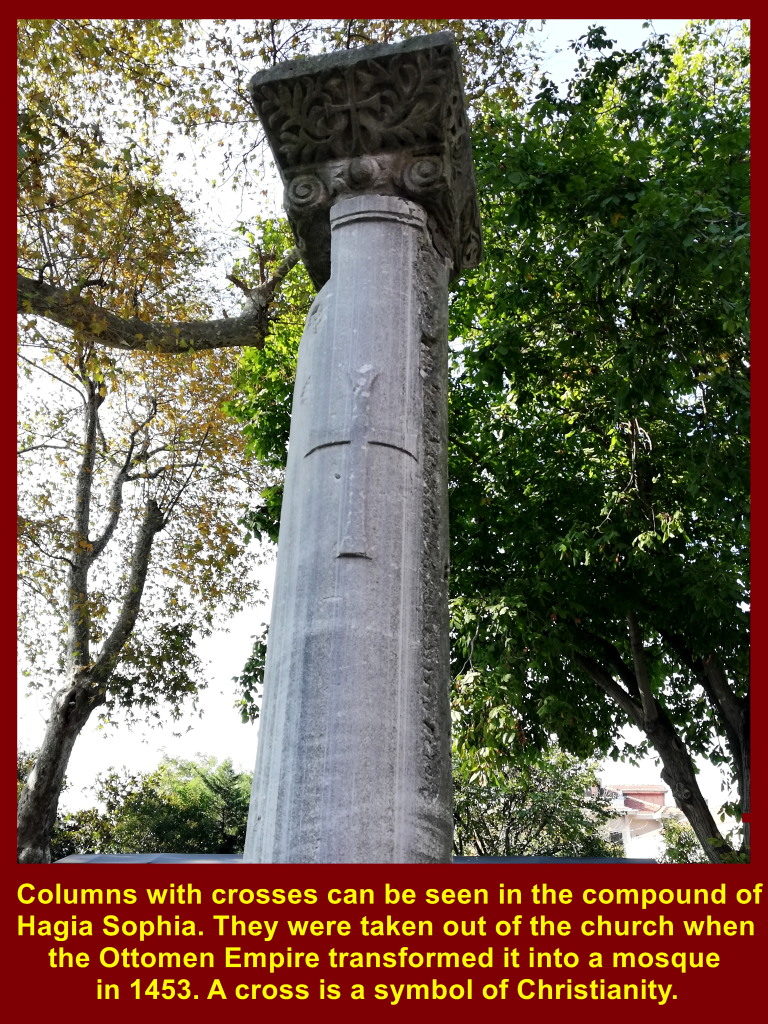
(iv) Many parts of Hagia Sophia with Christian symbols or images were excavated in the compound of the cathedral when it became a museum in 1935.
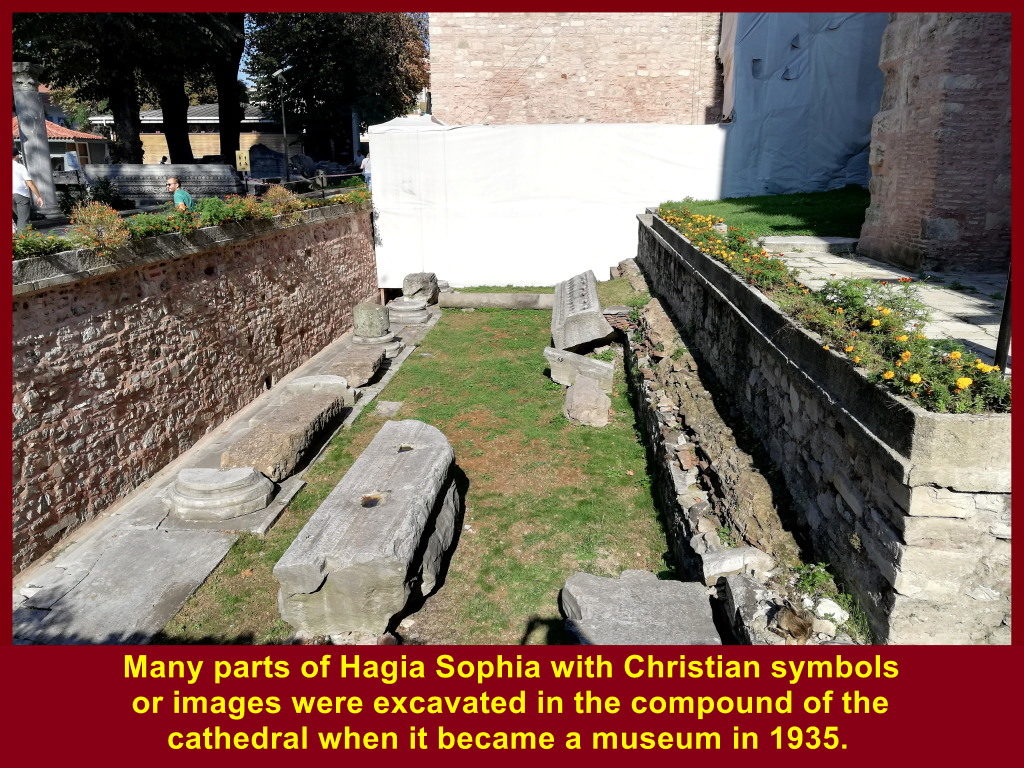
Minarets
When the Ottoman Empire took over the cathedral, Hagia Sophia, in Istanbul, in 1453, it was transformed into a mosque with minarets being erected.
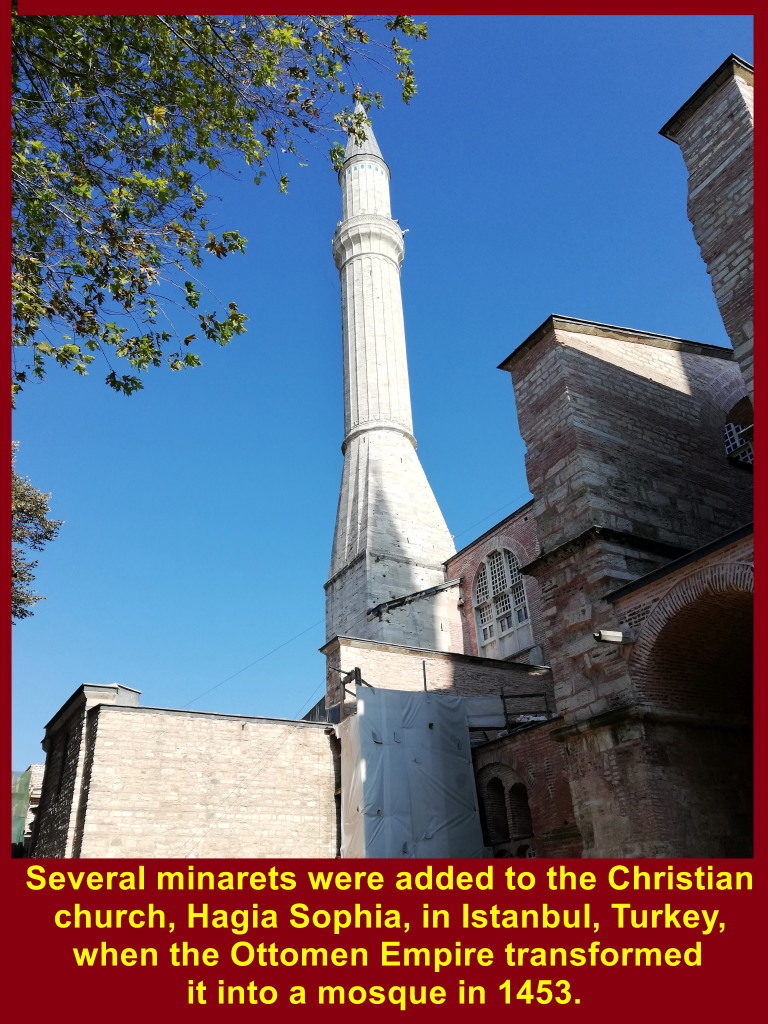
Topkapi Palace Museum
At 2.50 p.m. we left Hagia Sophia Museum and walked to a palace nearby. It is known as Topkapi Palace where the Ottoman Empire rulers stayed from 1478 until 1853 and high ranking officers stayed from 1853 until 1924. Since 1924 the palace becomes a museum for visitors to see.
View of Topkapi Palace Museum and Marmara Sea in the distance as seen on a printed entrance ticket.
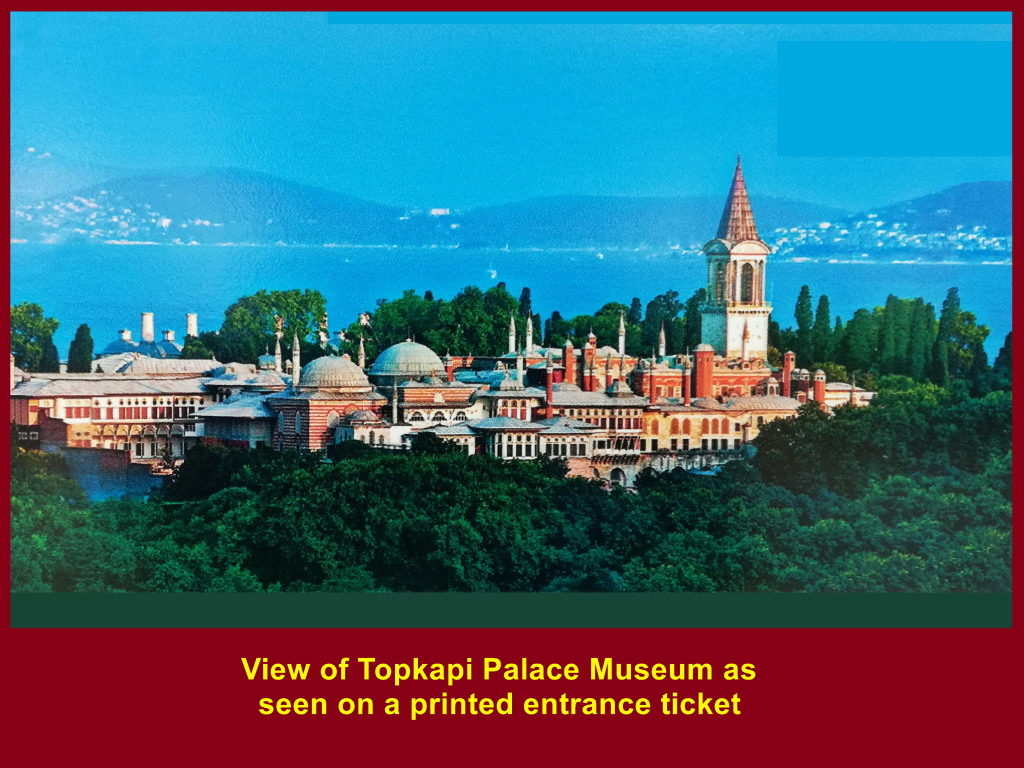
Imperial Gate is the main gate or first gate that allows visitors to enter Courtyard 1 of Topkapi Palace in Istanbul, Turkey.
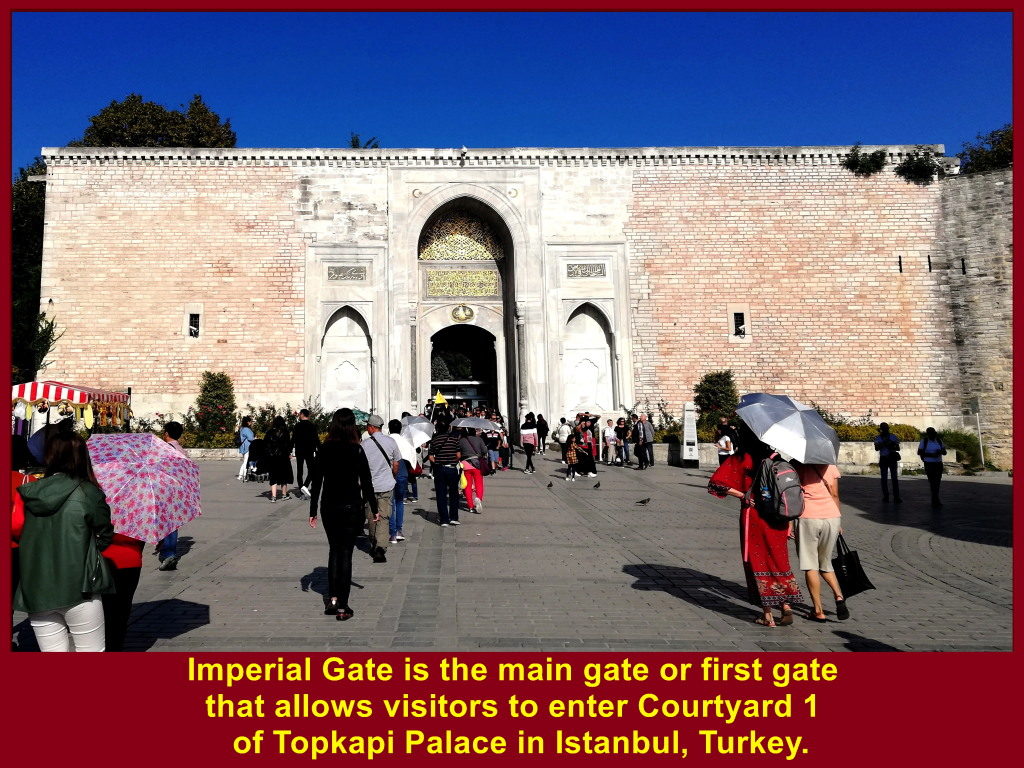
Gate of Salutaion is the second gate of Topkapi Palace that allows visitors to enter Courtyard 2.
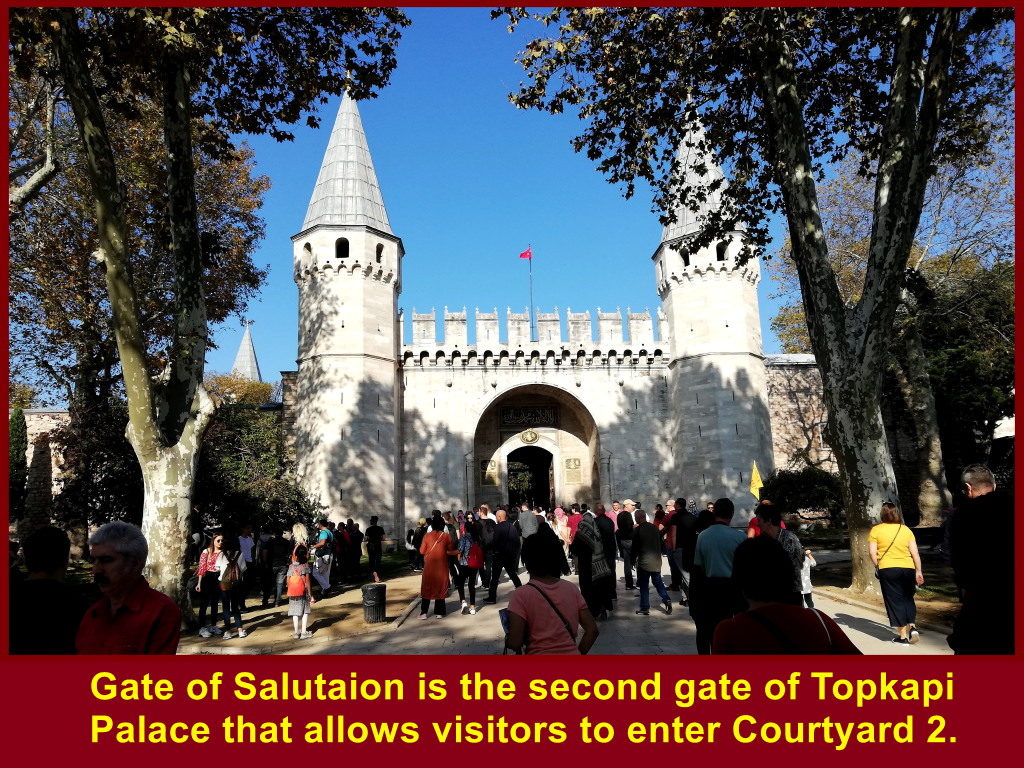
Imperial Kitchens with chimneys in Courtyard 2 of Topkapi Palace in Istanbul, Turkey
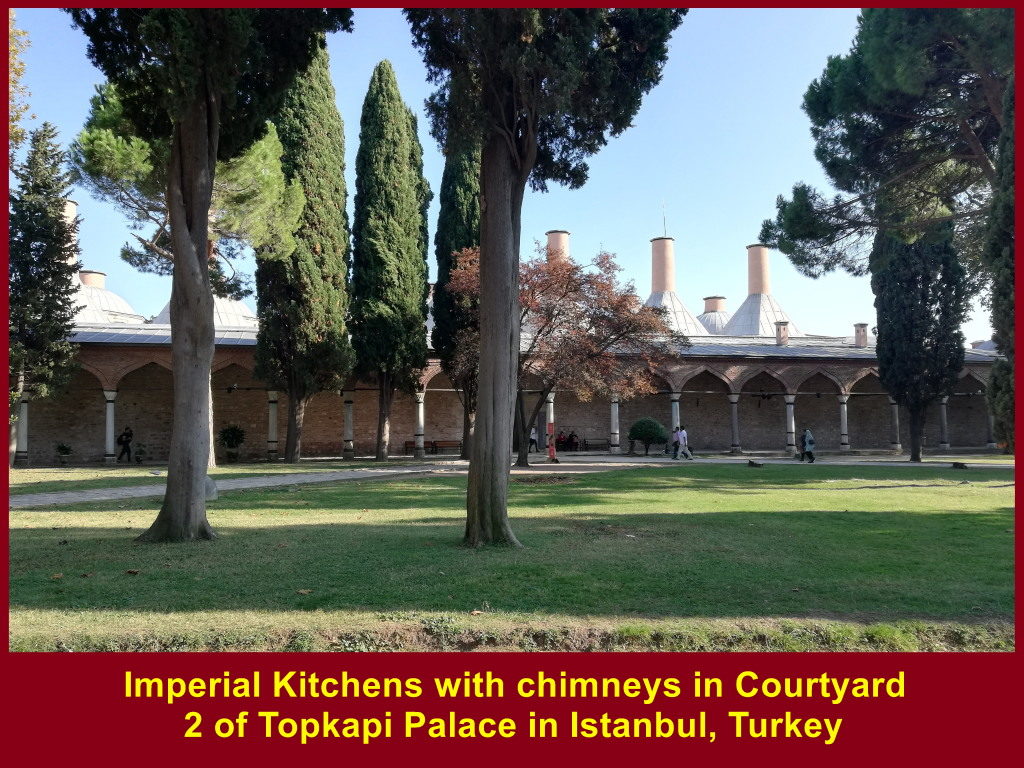
Imperial Council Hall, Harem, Imperial Stables and Imperial Kitchens are located in Courtyard 2.
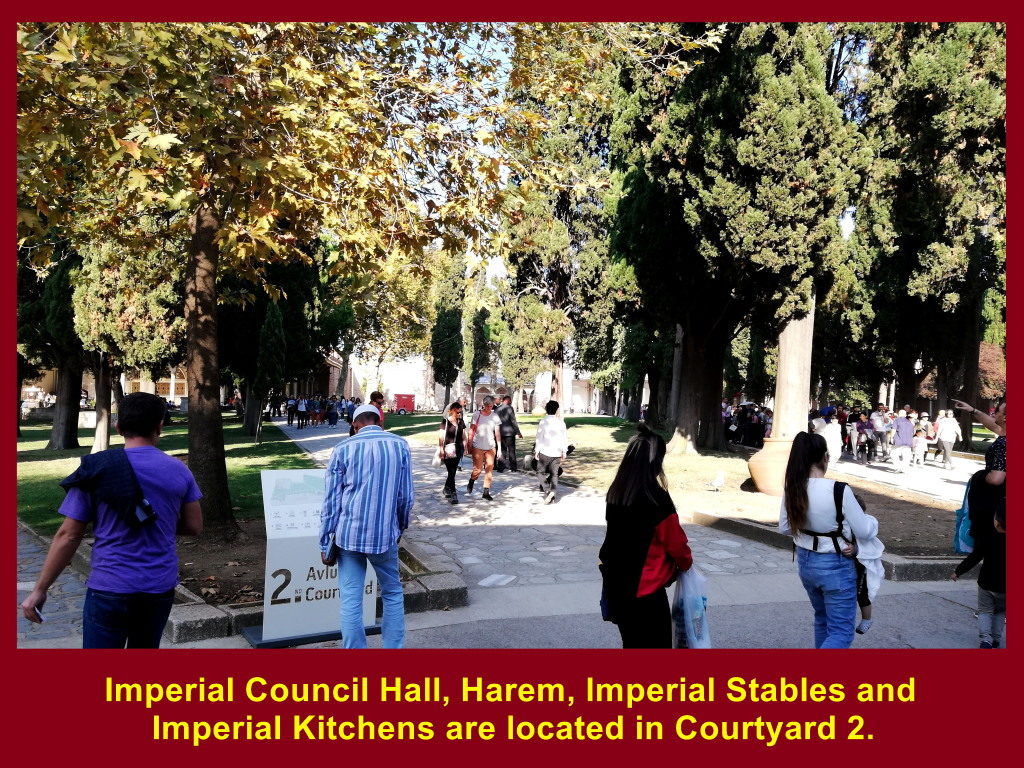
Imperial Kitchens with chimneys are in Courtyard 2 of Topkapi Palace in Istanbul, Turkey
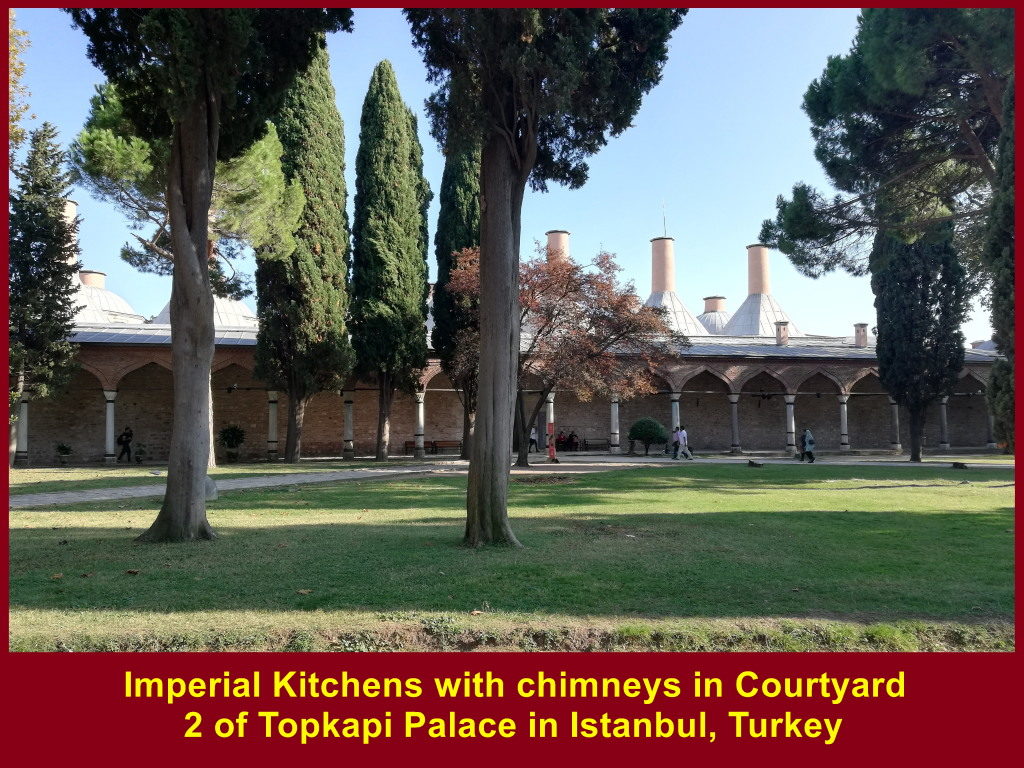
Harem or women’s quarter in Courtyard 2 of Topkapi Palace
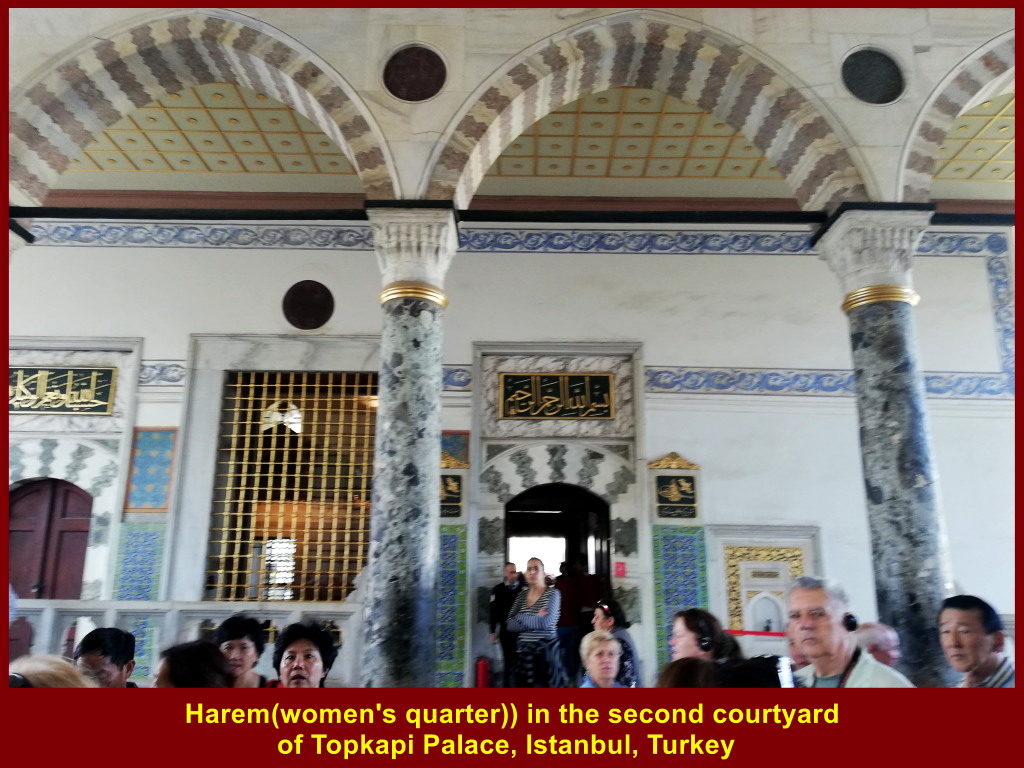
Imperial Council Hall in Courtyard 2 of Topkapi Palace was a place for informal gatherings of senior ministers presided over by the Sultan.
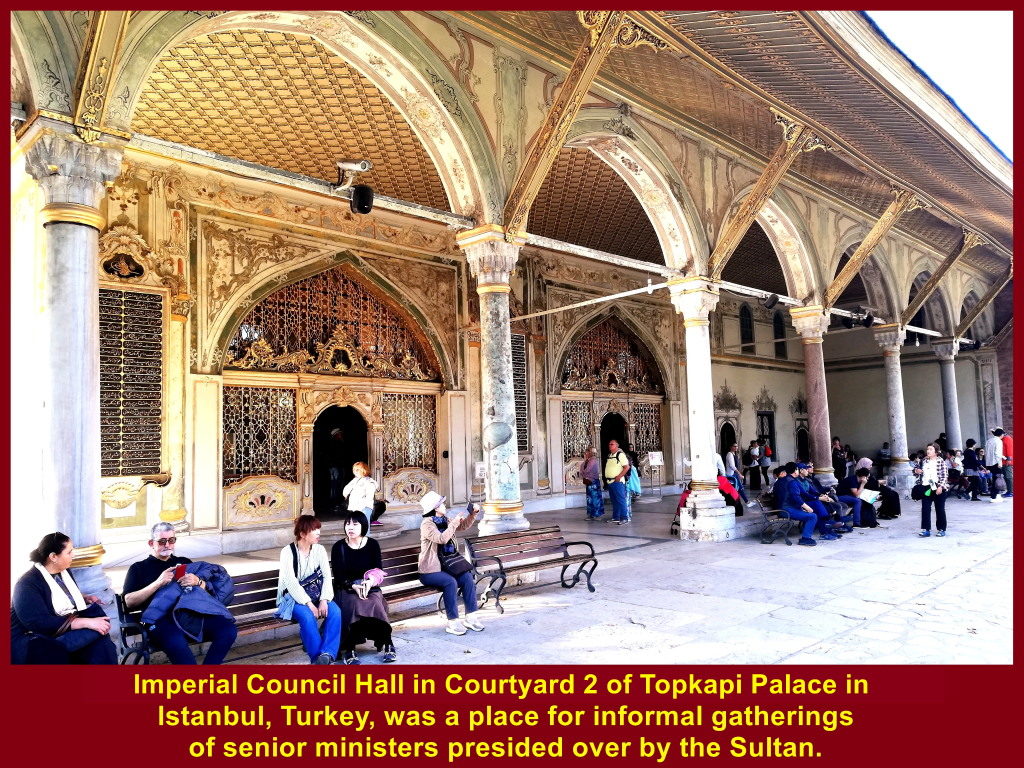
Informal gatherings of senior ministers presided over by the Sultan were held in Imperial Council Hall.
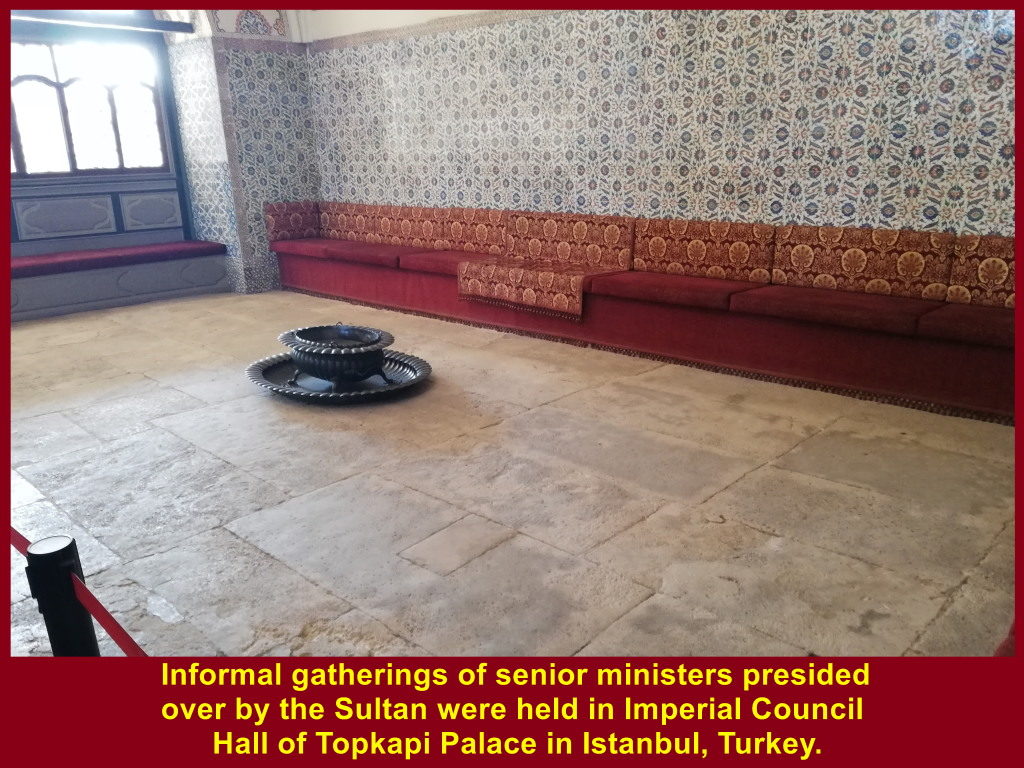
A colourful, gilded wall in the Imperial Council Hall of Topkapi Palace
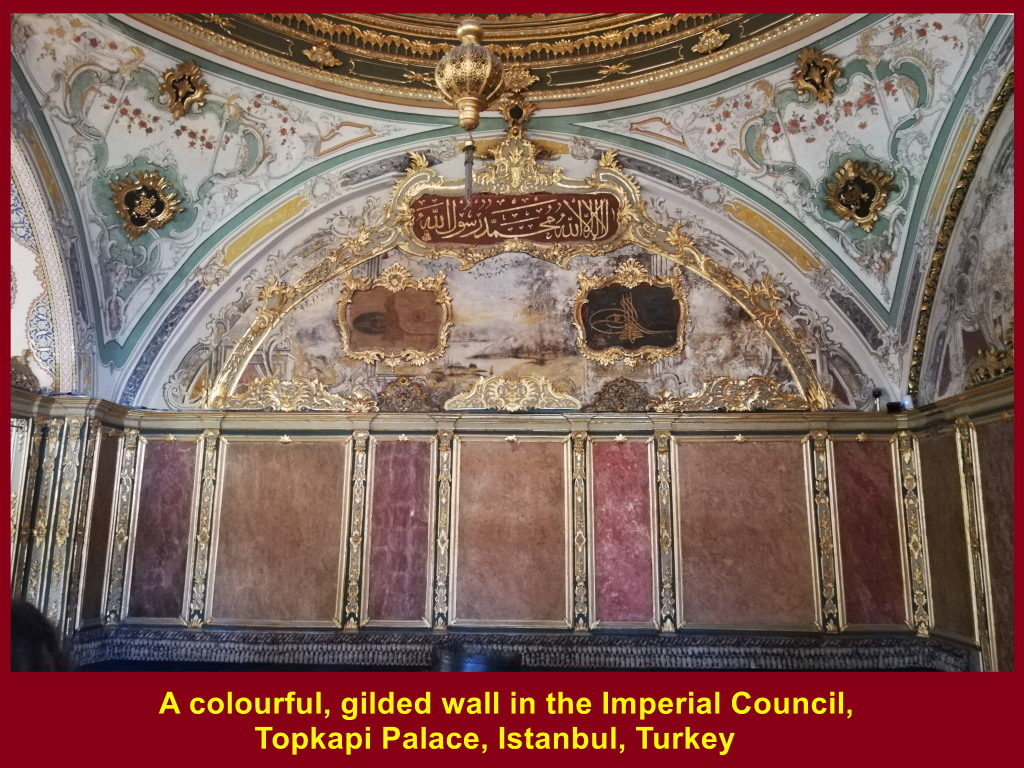
Smart-looking guards on horses can be seen in Courtyard 2 of Topkapi Palace
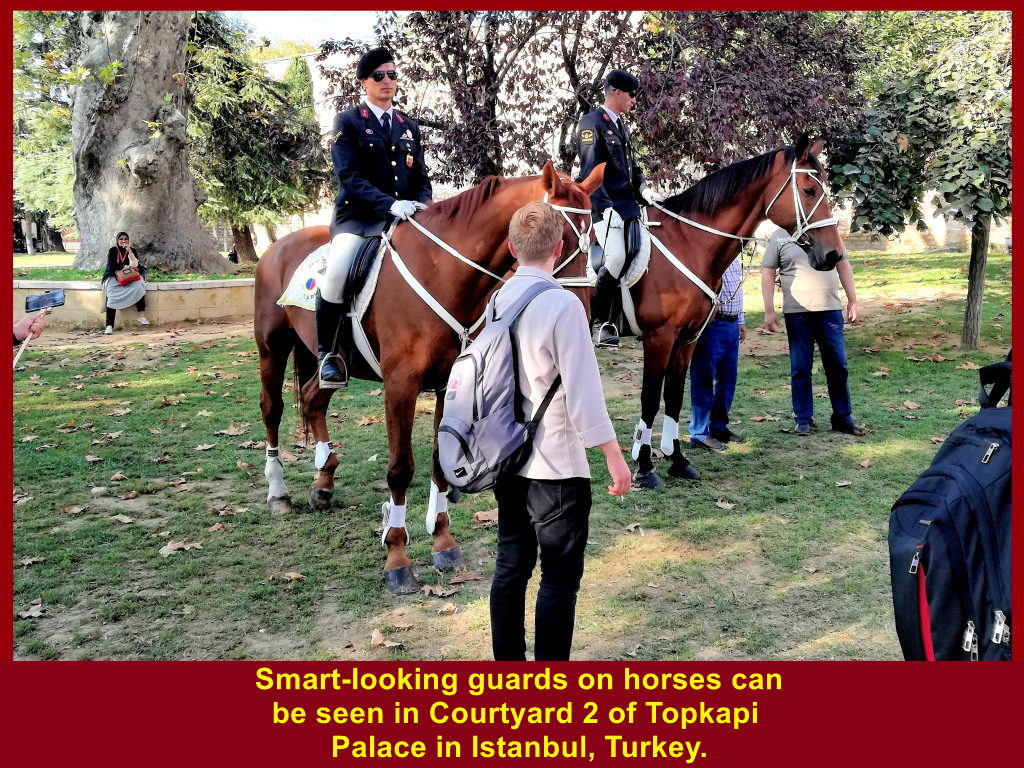
Gate of Felicity is the third gate that allows visitors to enter Courtyard 3 of Topkapi Palace in Istanbul, Turkey.
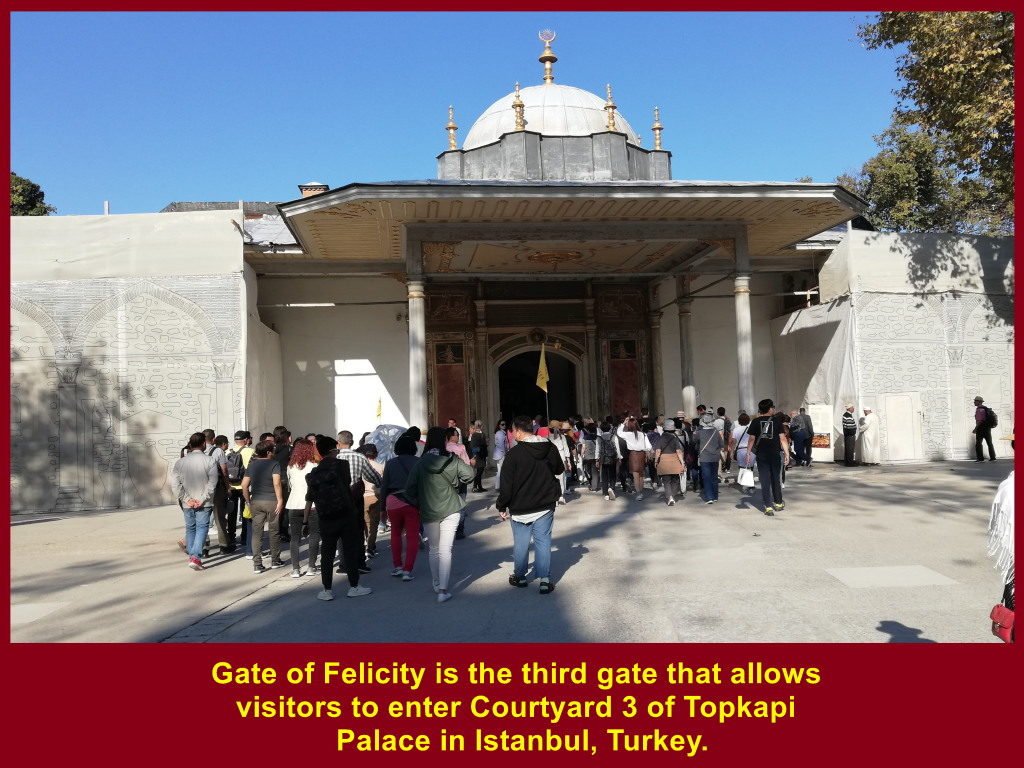
Audience Hall, Imperial Treasury, Library of Sultan Ahmet III and Library of Manuscripts are located in Courtyard 3.
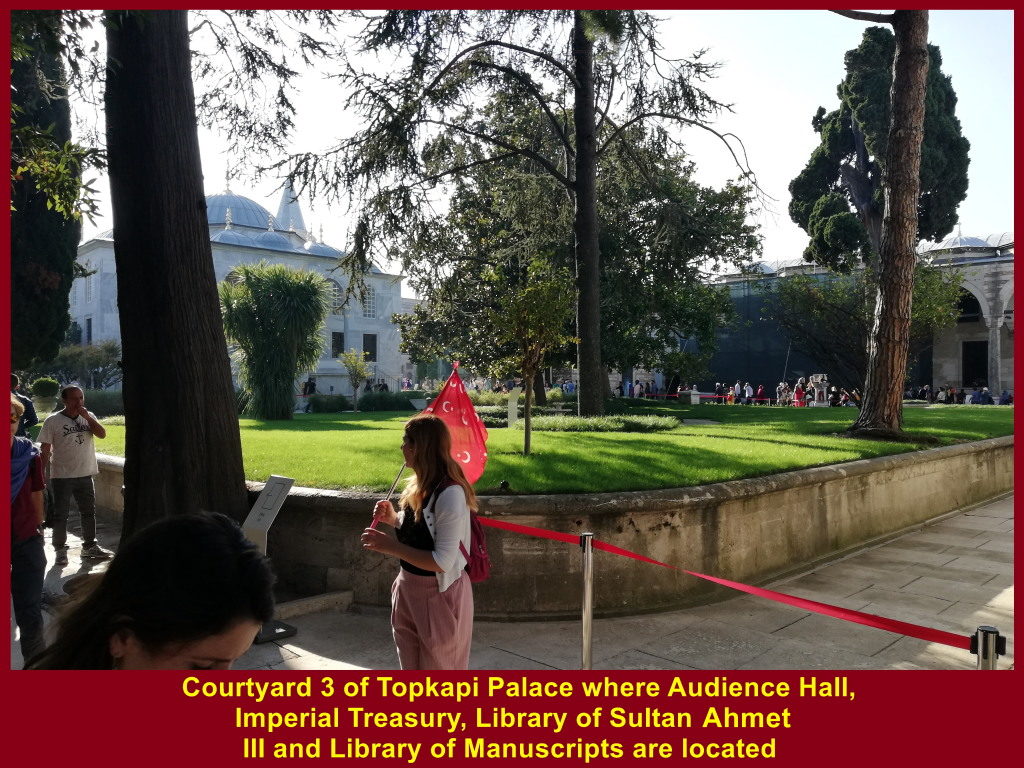
Audience Hall or Chamber of Petitions is in Courtyard 3 of Topkapi Palace.
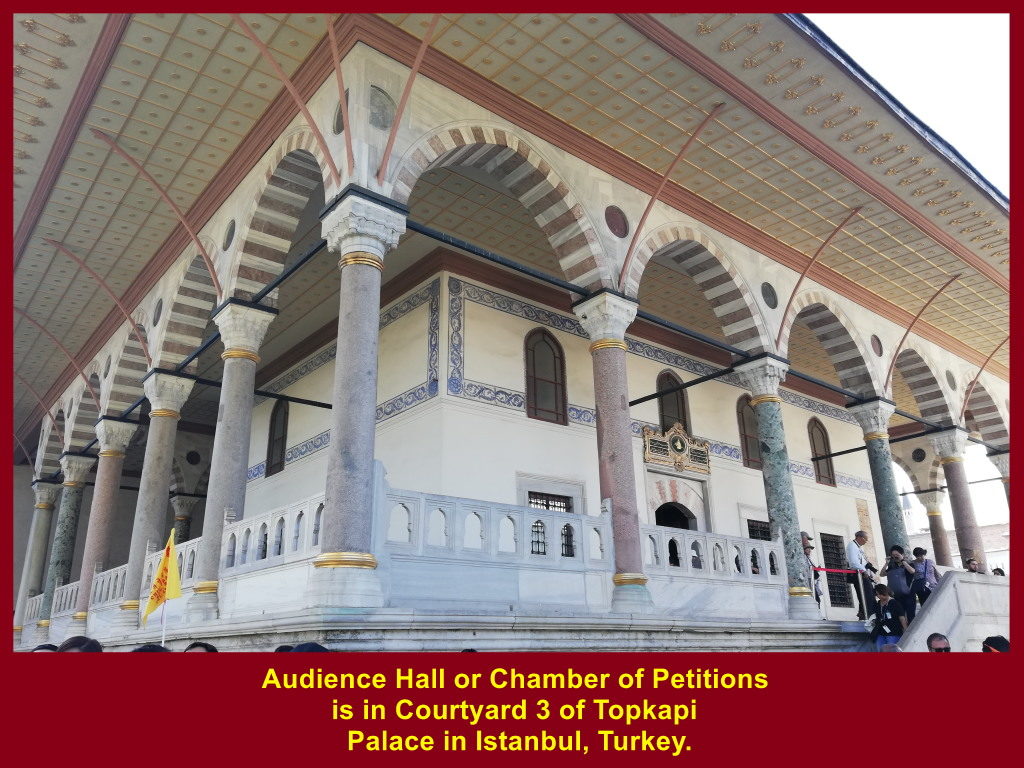
Library of Sultan Ahmet III or Inner Palace Library in Courtyard 3 of Topkapi Palace in Istanbul, Turkey.
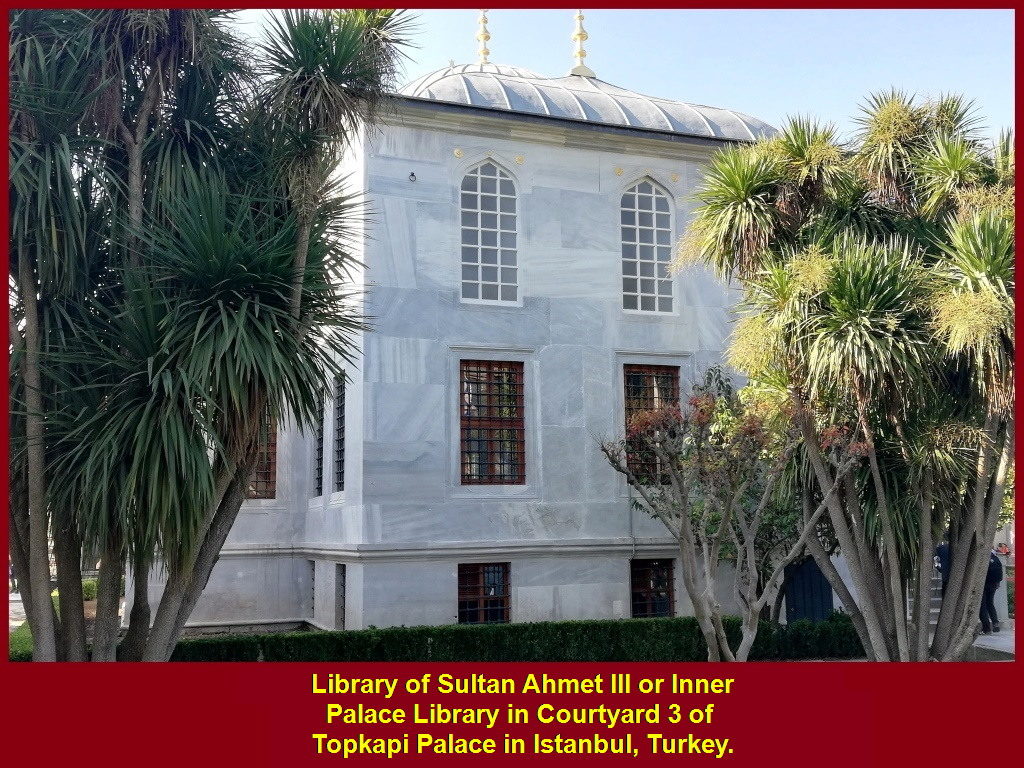
Interior of Library of Sultan Ahmet III in Topkapi Palace
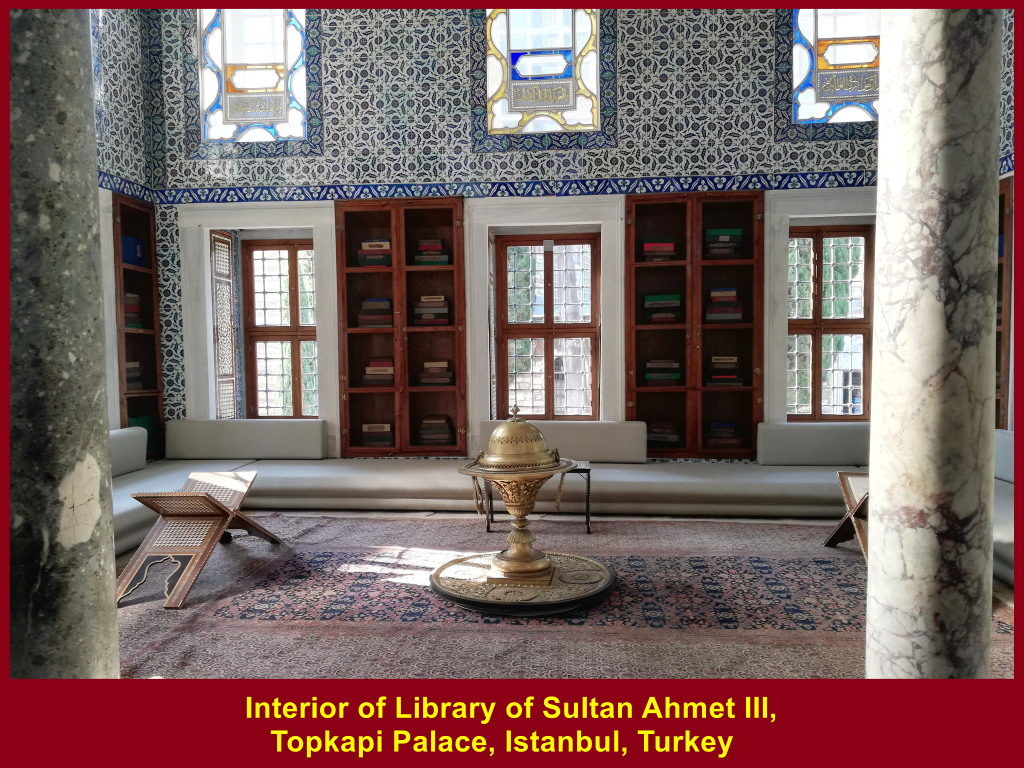
A model of a learned man in the Library of Sultan Ahmet III in Topkapi Palace
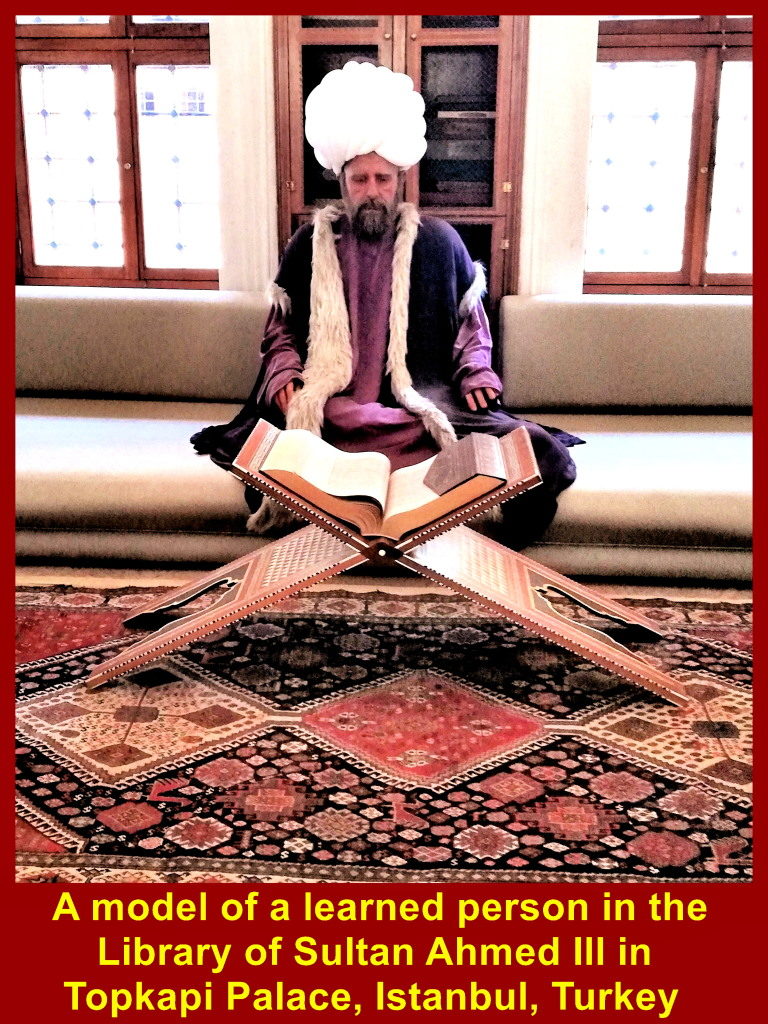
In Courtyard 4, there are Mecidiye Kiosk, Sofa Mosque, Wardrobe Room, Tower Gate, Circuncision Chamber, Chamber of the Physician, Bagdad Kiosk and Revan Kiosk.
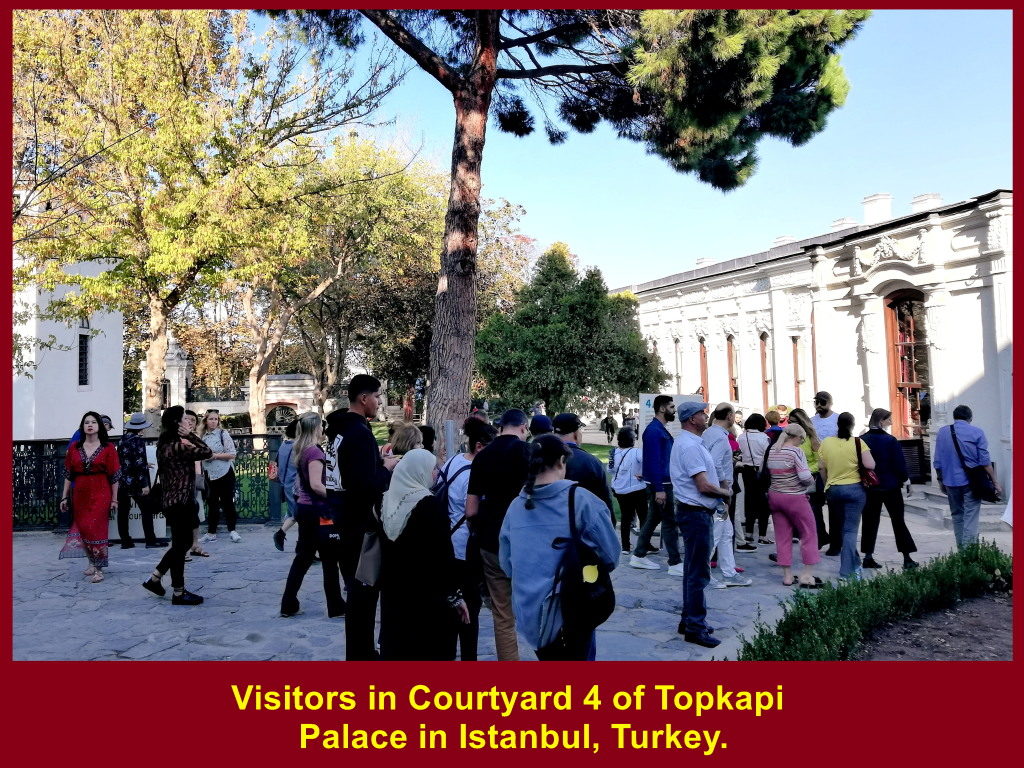
Mecidiye Kiosk
Mecidiye Kiosk in Courtyard 4 was built by Sultan Abdulmecid(1823-1961) in the 18th. Century for enthronement ceremonies and Sultans’ temporary residence in Topkapi Palace, Istanbul, Turkey.
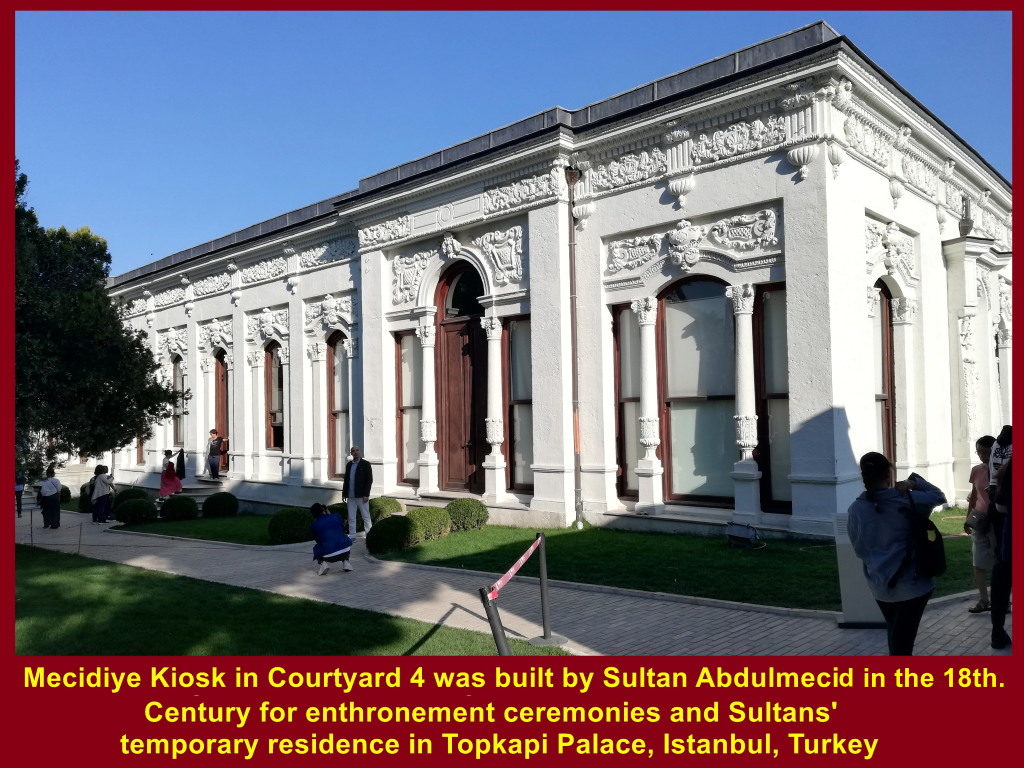
Wardrobe Room
Wardrobe Room in Courtyard 4 of Topkapi Palace was used by Sultan Abdulmecid(1823-1861) whenever he visited the palace.
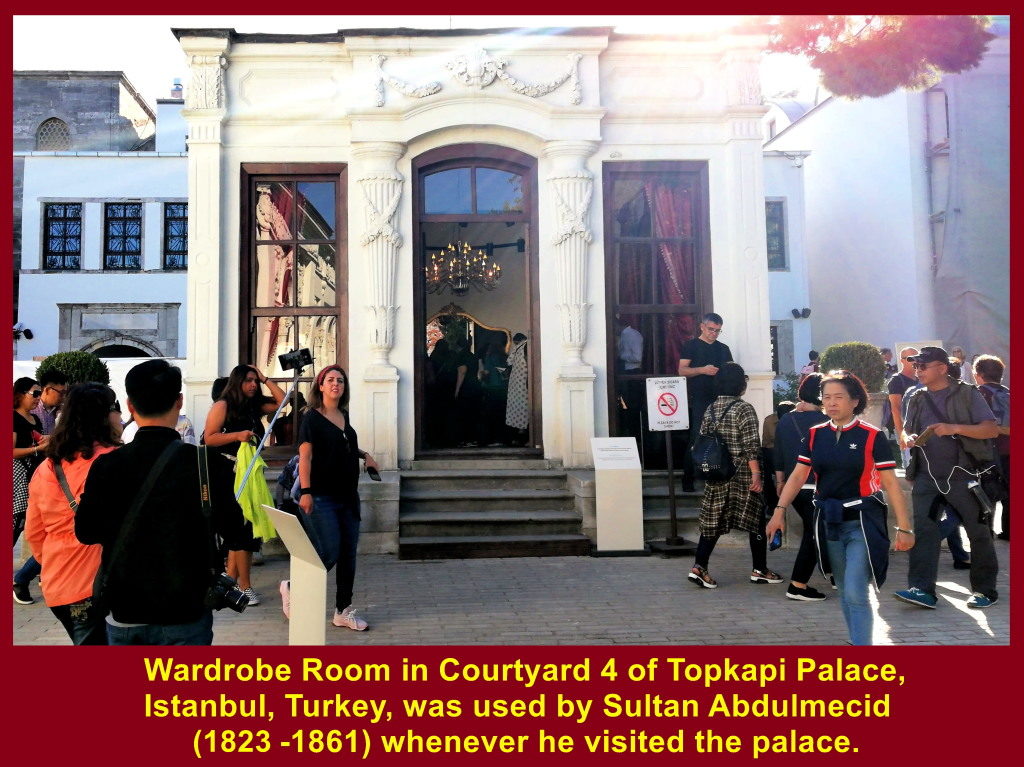
Twin Tower Gate
Twin Tower Gate is the back gate of Topkapi Palace in Istanbul, Turkey, and opens into Bosphorus Strait.
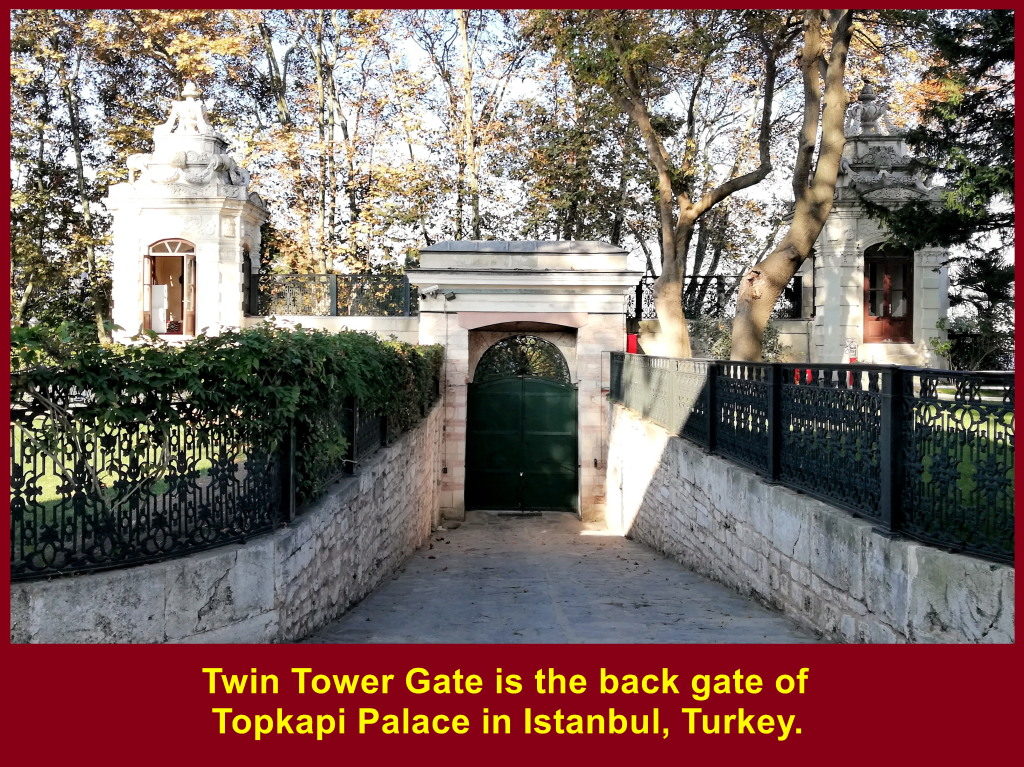
Breathtaking View
A breathtaking view of Bosphorus Bridge and the Strait of Bosphorus as seen from Topkapi Palace, Istanbul, Turkey
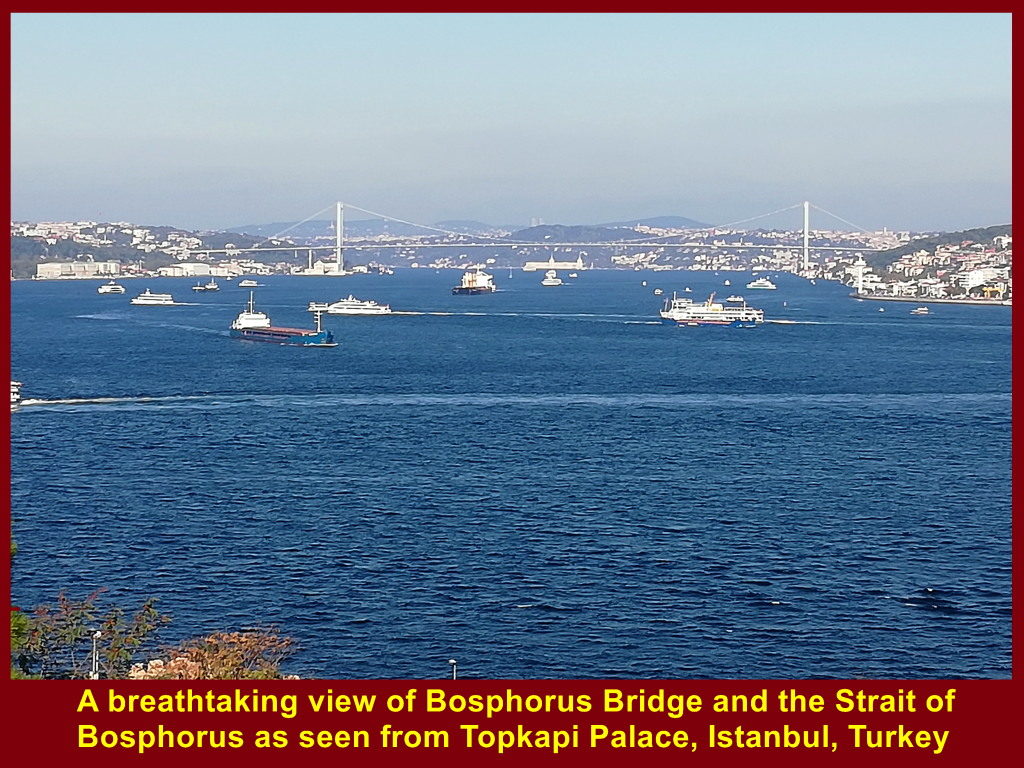
Visiting Blue Mosque
The last place we visited for the day was a large mosque known as Blue Mosque or Sultan Ahmed Mosque which was opened in 1616 as shown in the photo below. This photo was taken at the mosque.
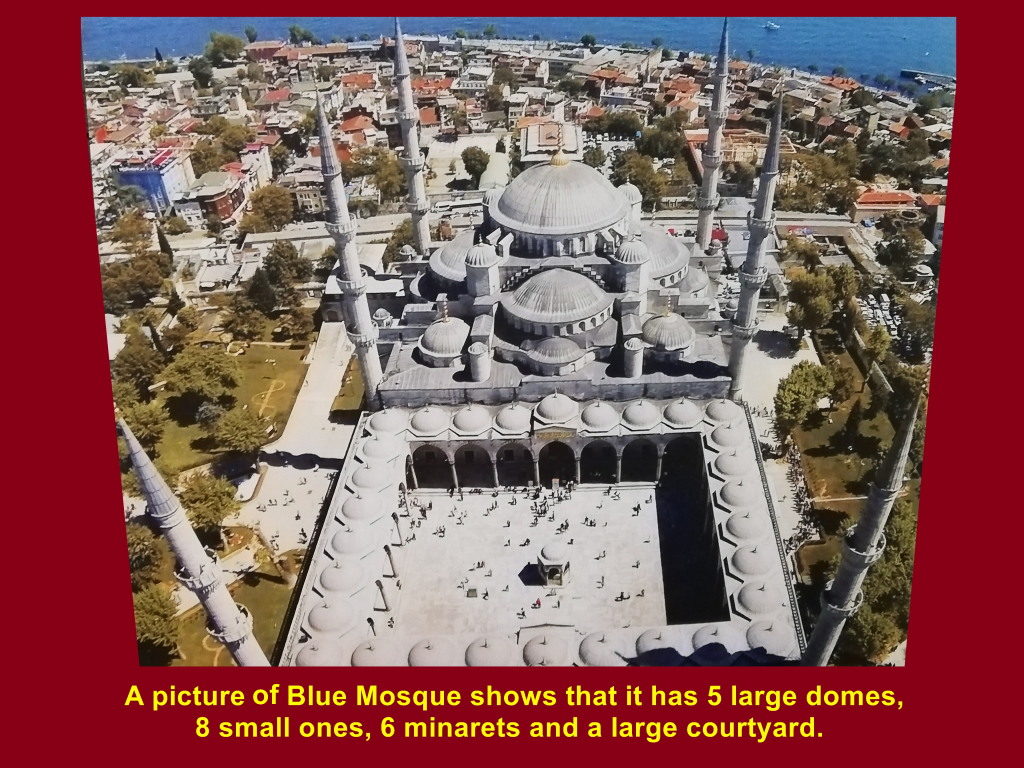
Blue Mosque is near Hagia Sophia Museum
We walked a few hundred metres from Topkapi Palace to Blue Mosque or Sultan Ahmed Mosque. The mosque is near Hagia Sophia or Ayasofya Museum.
Front of Blue Mosque
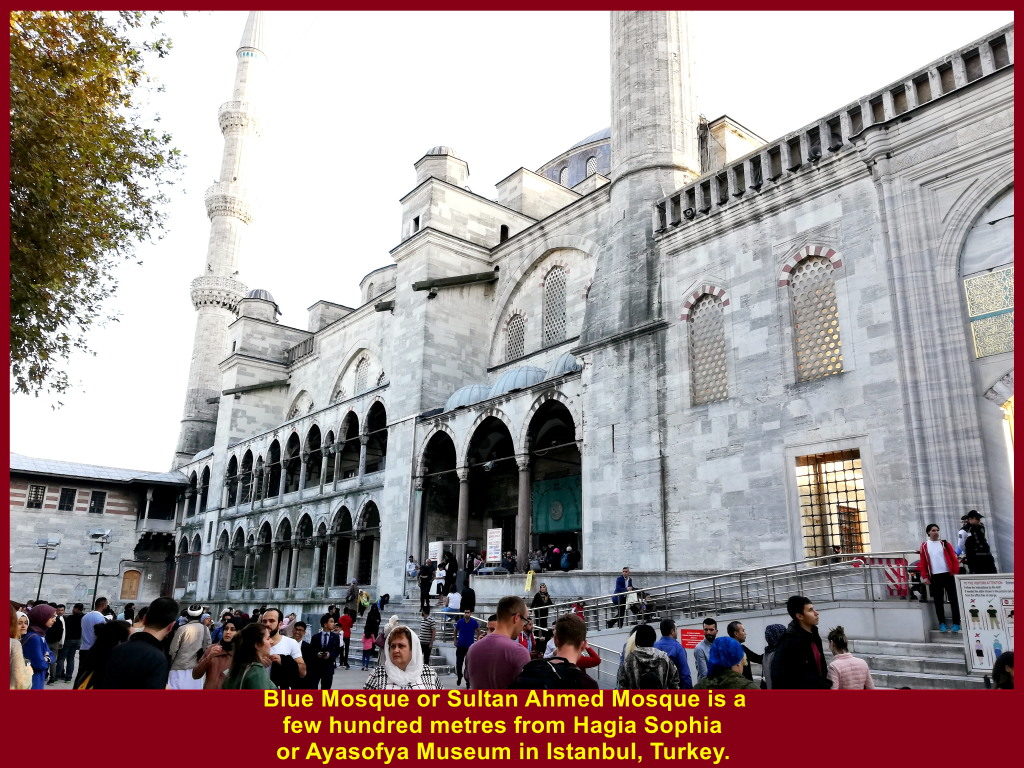
Prayer Hall
The large prayer hall in Blue Mosque has many columns supporting five main domes and 8 smaller ones. The hall has a capacity of 10 000 worshipers.
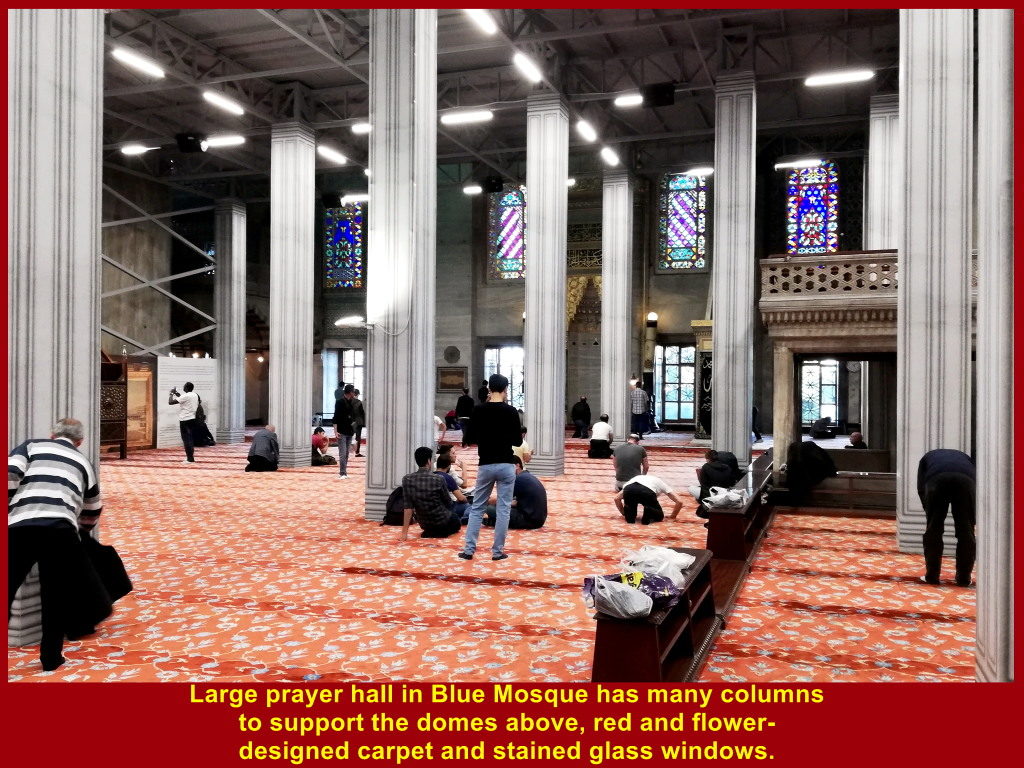
Exit and Entrance Door
The exit and entrance door of Blue Mosque or Sultan Ahmed Mosque in Istanbul, Turkey
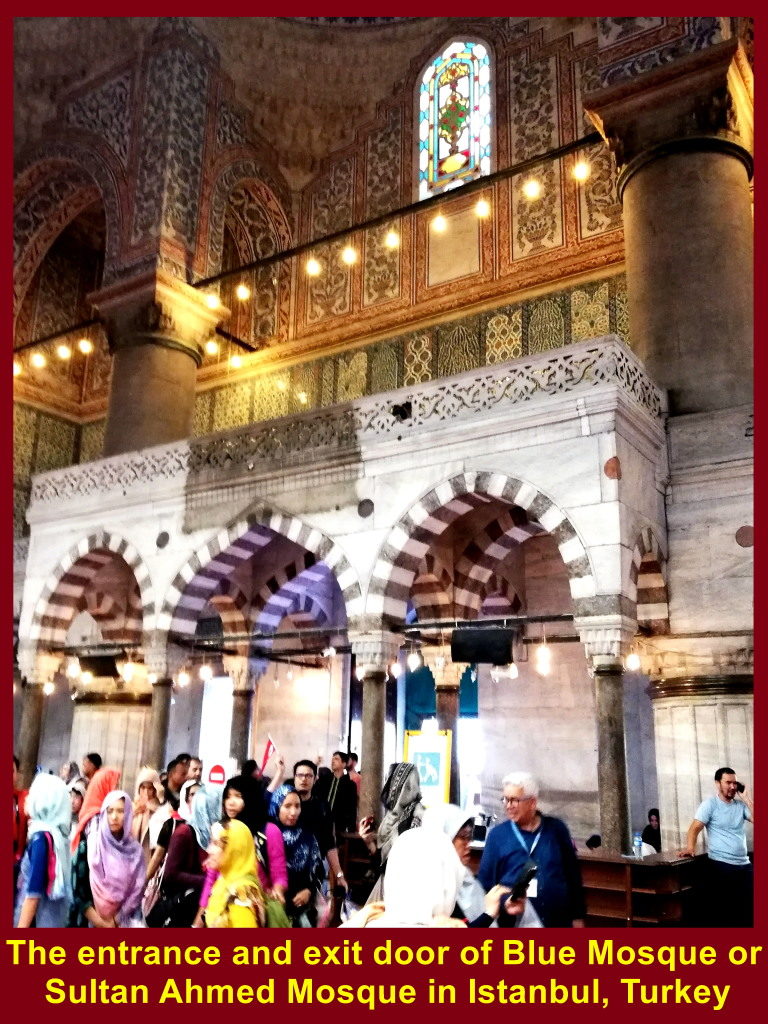
Courtyard
The courtyard of Blue Mosque or Sultan Ahmed Mosque
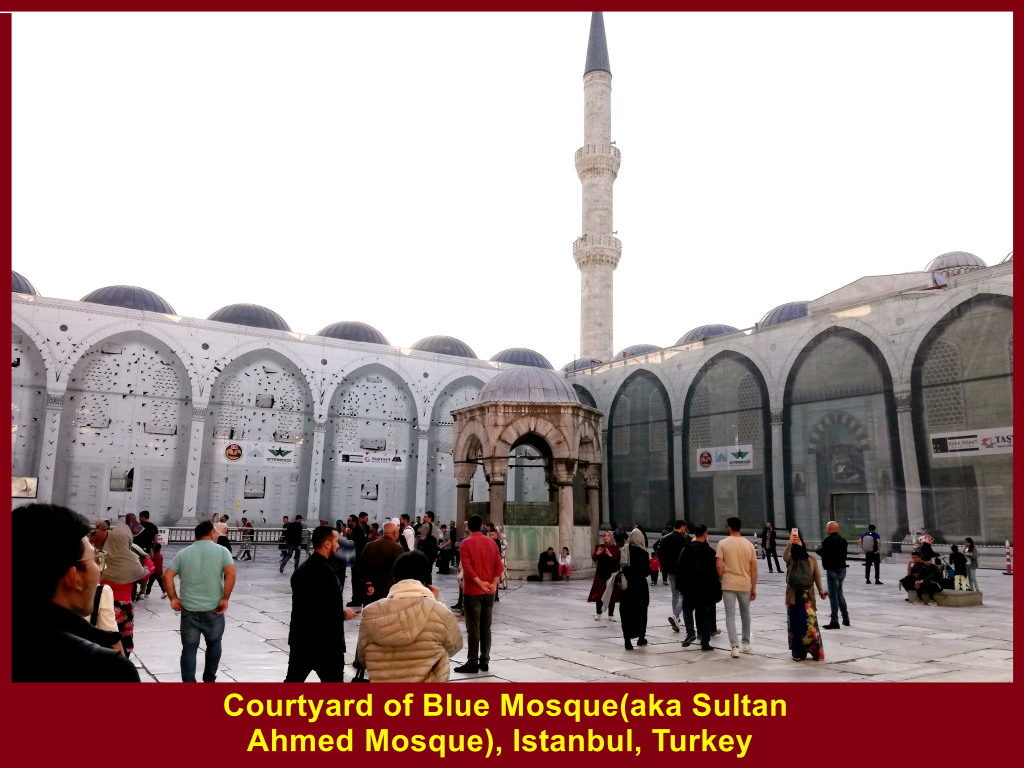
Visitors relaxing in the courtyard of Blue Mosque or Sultan Ahmed Mosque
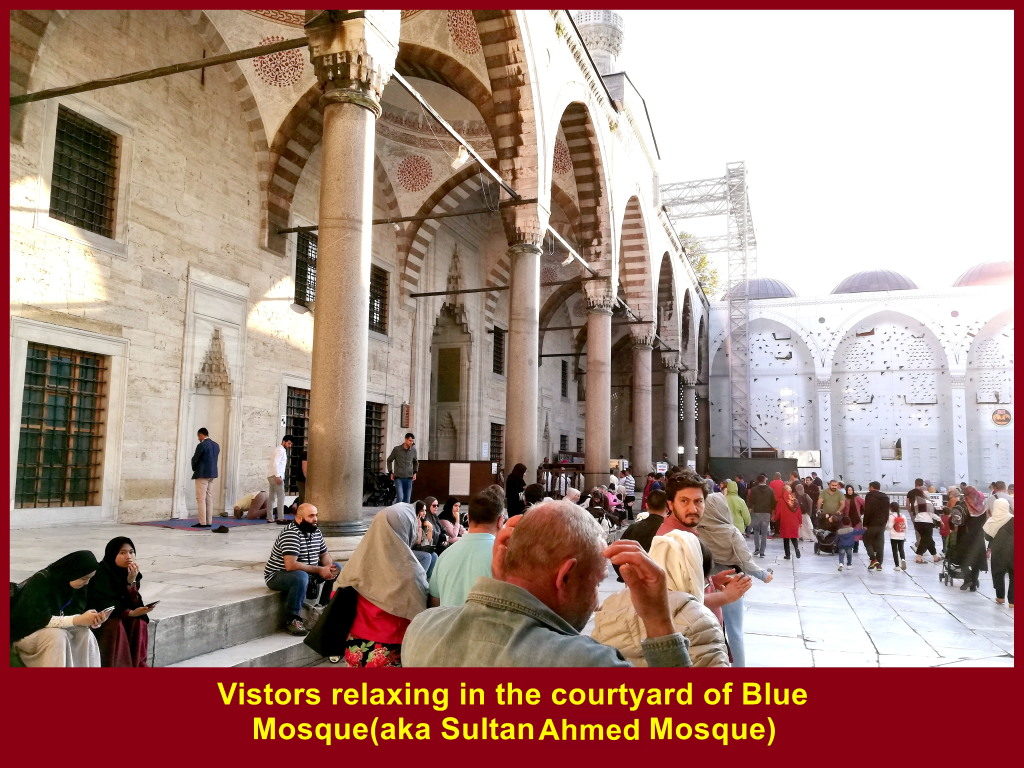
Sultan Ahmet Square
At 5.10 p.m. we left Blue Mosque and walked in an open-air area adjacent to the Blue Mosque. It was known as Hippodrome of Constantinople which was developed by Byzantine emperor, Constantine VII(905-959 AD). It was used for chariot racing and other entertainments. Besides, a few monuments were erected there to adorn the place which is now known as Sultan Ahmet Square.
Below are some of the monuments left in the square.
(a) Obelisk of Pharaoh Tutmose III(1481-1425 BC)
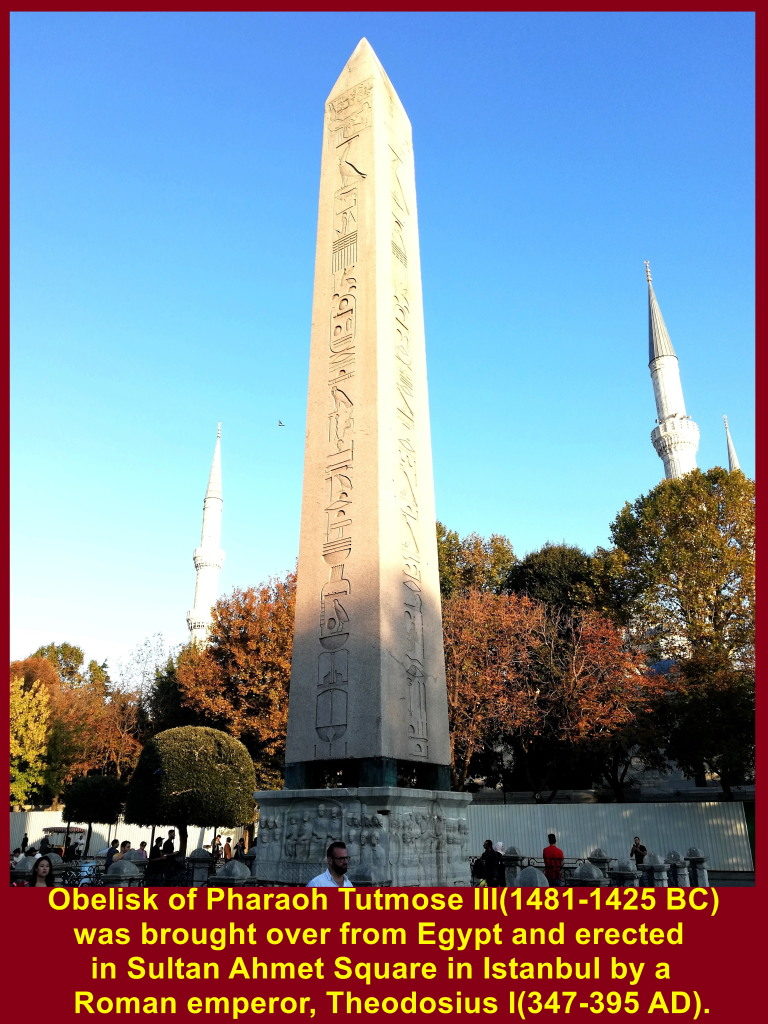
This obelisk was brought over from Egypt and erected in the square by a Roman emperor, Theodosius I(347-395 AD).
(b) Walled Obelisk
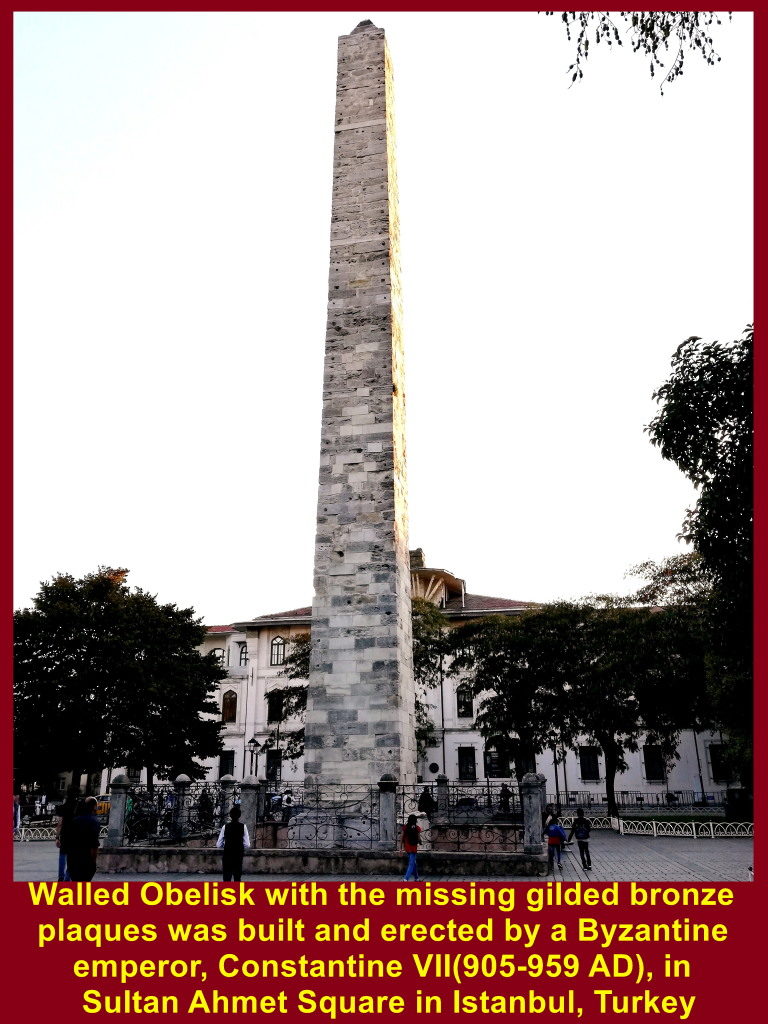
This obelisk with the missing gilded bronze plaques was built and erected by a Byzantine emperor, Constantine VII(905-050 AD).
(c) Serpent Column
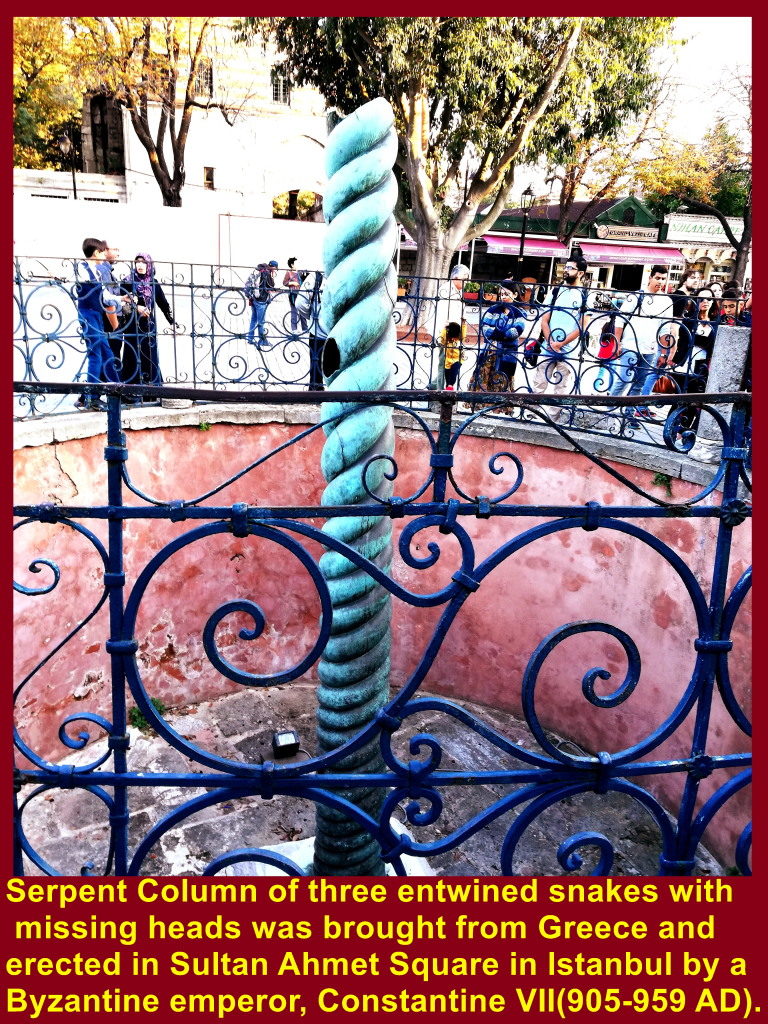
This column with three entwined snakes with missing heads was brought over from Greece and erected in the square by a Byzantine emperor, Constantine VII(905-959 AD).
Later, we checked in and had dinner at a hotel, Golden Tulip Hotel, in Istanbul City.
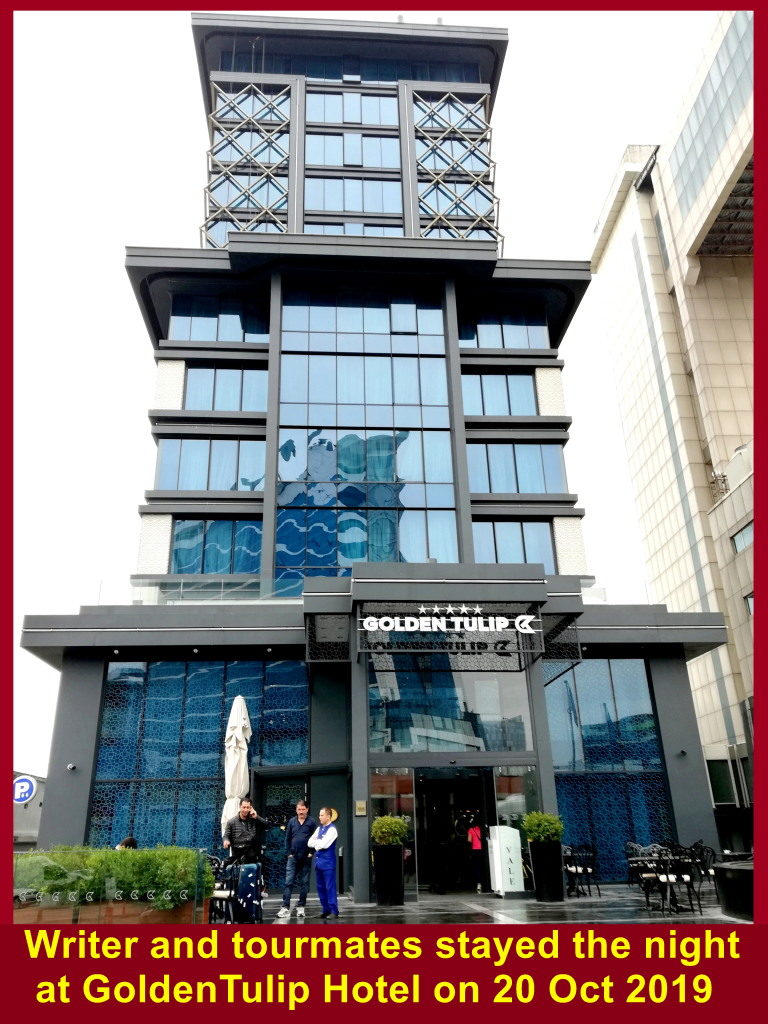
Previous Page / Home / Next Page
Places visited during Turkey Tour(13-22 Oct 2019):
Trojan Horse/Ancient Troy Cities Asklepion Ephesus Hierapolis/Pamukkale Travertine Sultanhani Caravanserai Pasabag Valley Uchisar Valley/Kaymakli Underground City Gerome Valley/Turkish Night Show Hot Air Balloon/Lake Golu/Anitkabir Hagia Sophia/Topkapi Palace/Blue Mosque Bosphorus Boat Cruise Spice Bazaar/Grand Bazaar
Turkey Travel Part XI: Bosphorus Strait Boat-Cruise
Day 9
Monday, 21 Oct 2019
Last Day of Turkey Tour
Monday, 21 Oct 2019, was the last day of our tour in Turkey before we flew back to our country, Malaysia.
Boat Cruise on Strait of Bosphorus
The first thing we did then was to cruise in a boat on the Strait of Bosphorus enjoying the cruise and sights of the strait.
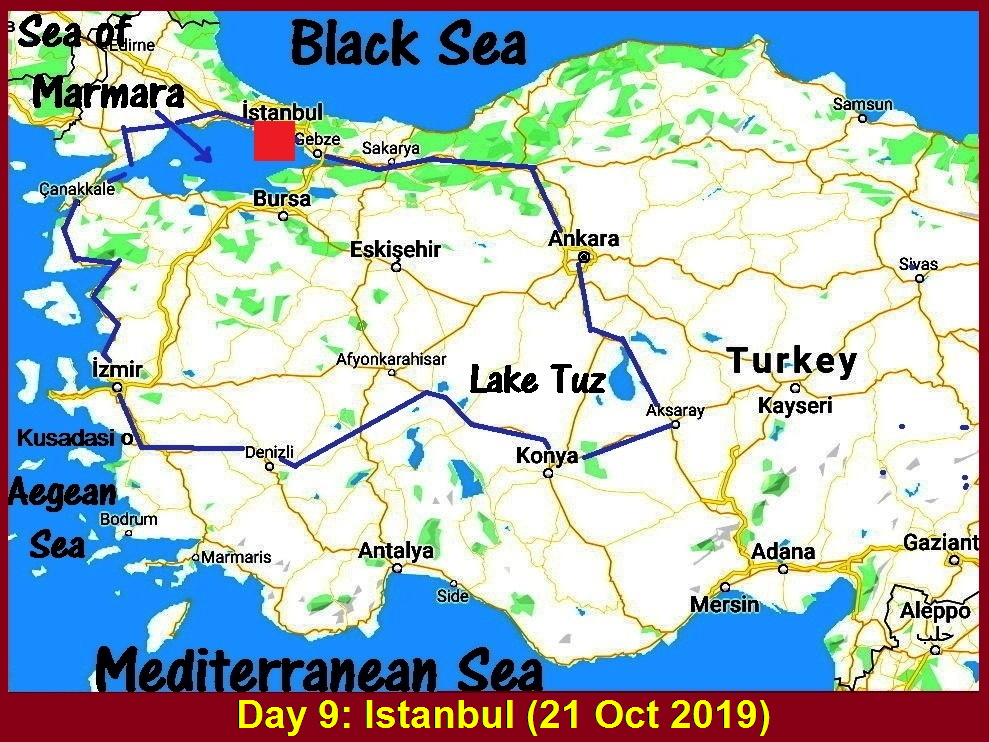
Bosphorus Strait
Bosphorus Strait is 31 km long separating the European side from the Asian side in the City of Istanbul, Turkey. Besides, it links the Black Sea in the north to Marmara Sea and then Mediterranean Sea in the south.

Boat Cruise Route on Bosphorus Strait
The pictorial map below shows the orange-coloured route on the Strait of Bosphorus our boat took to see the important bridges and historical buildings on its shores at close range.
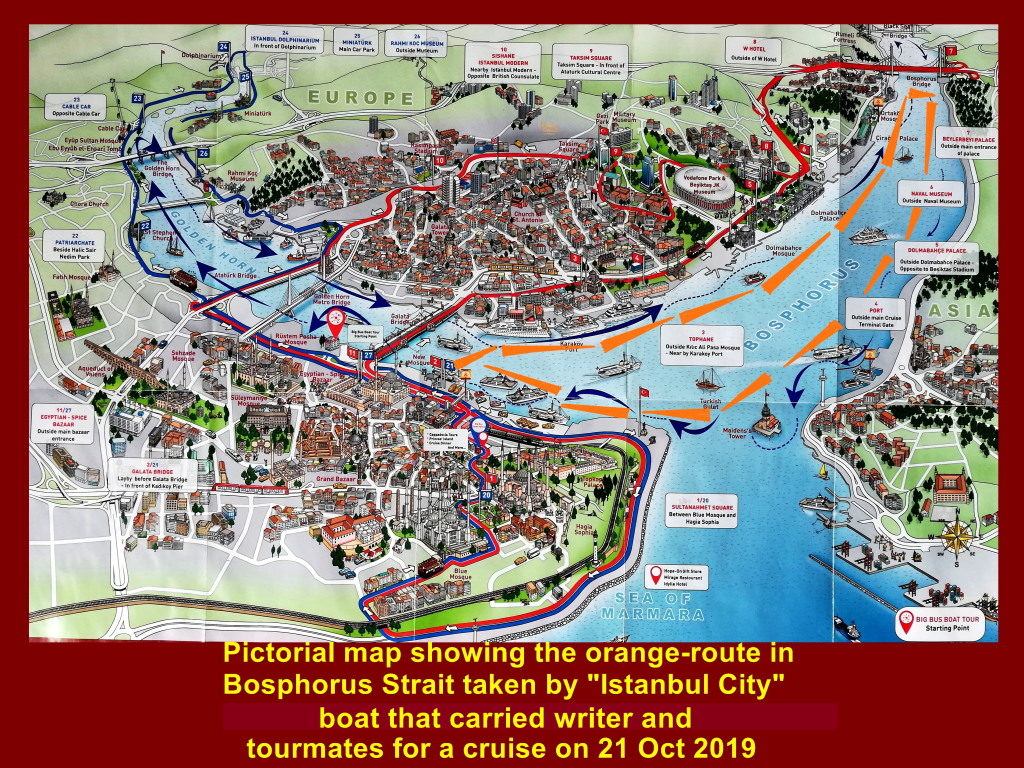
Cruise Boat, “Istanbul City”
At 10.30 a.m. we boarded a boat called “Istanbul City” at a waterfront of the Strait of Bosphorus.
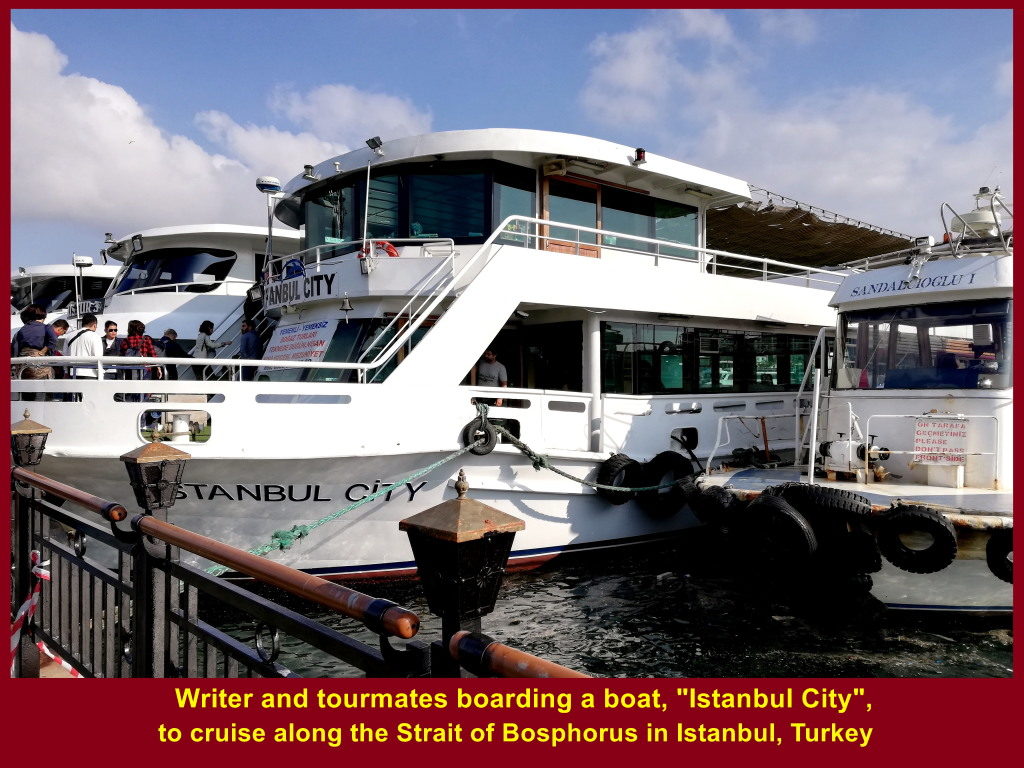
Cruise Boat Owner
The owner of the boat soon brought us around for a sightseeing tour of the Strait of Bosphorus in Istanbul.
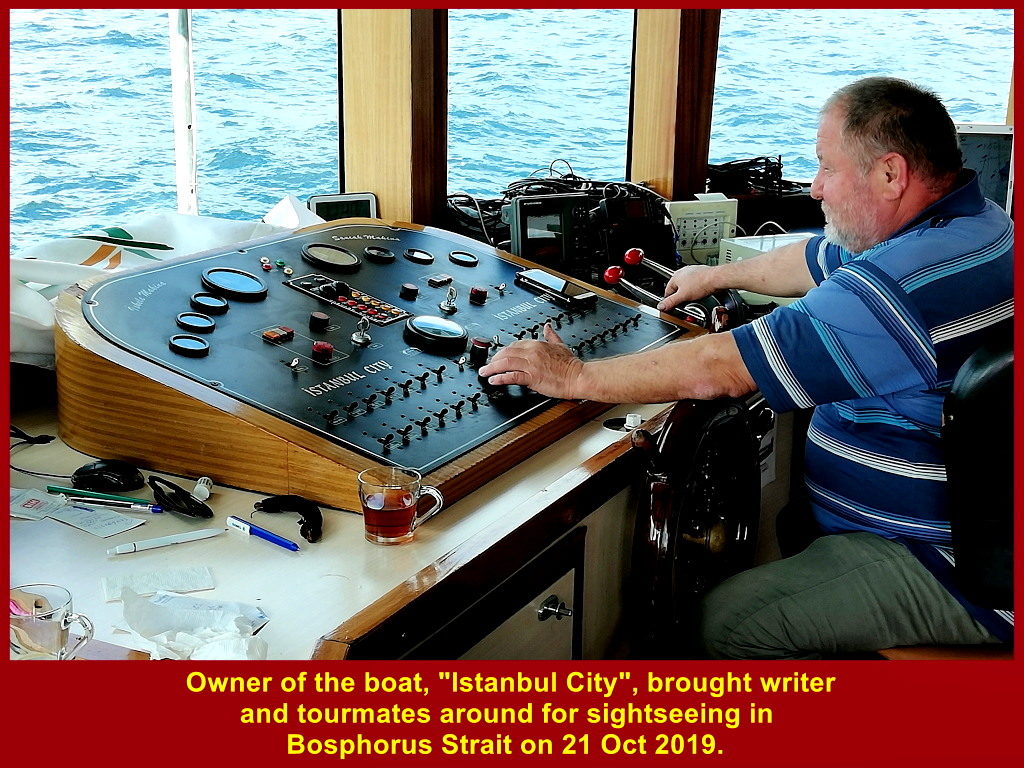
Writer and wife together with tourmates were enjoying the boat ride and sightseeing of the Strait of Bosphorus on 21 Oct 2019.
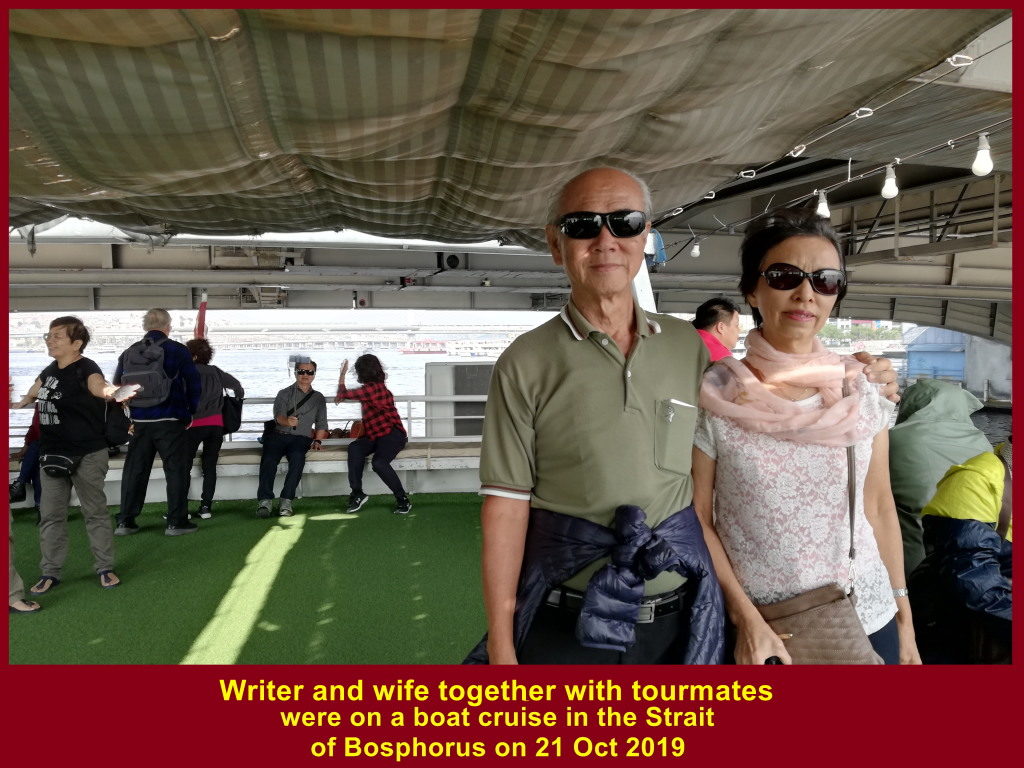
Importance of Bosphorus Strait
Bosphorus Strait or Strait of Istanbul in Turkey is an important waterway between Europe and Asia, and Black Sea and Marmara Sea.
In World War I(1914-18), the Allied Powers fought against the Ottoman Empire to take control of the Strait of Bosphorus, Marmara Sea and Strait of Dardanelles, but they failed in 1916.
Bosphorus Strait Measurements
The photo below shows Bosphorus Strait that links the Black Sea in the north and Marmara Sea and then Mediterranean Sea in the south. Its length is 31 km, minimum width 700 metres and maximum depth 110 metres.
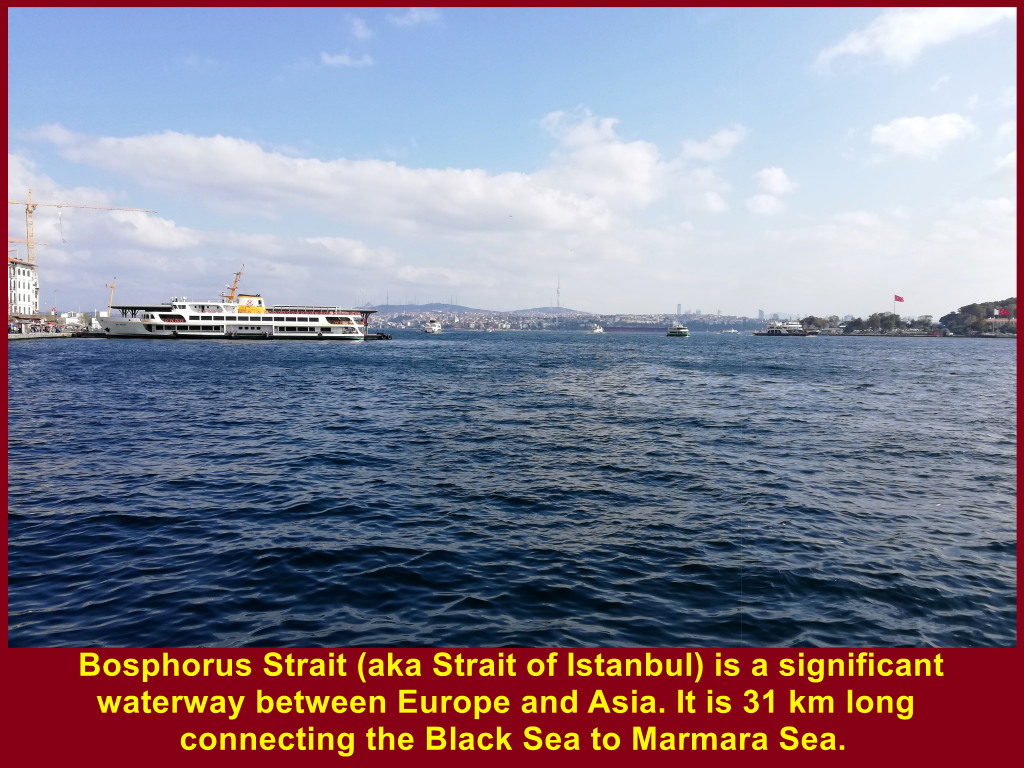
Three Bridges Across Bosphorus Strait
There are three bridges spanning the waterway as shown in the photos below.
(i) Bosphorus Bridge or 15 July Martyr’s Bridge was the first bridge to be built between Europe and Asia. Built in 1973, it is 1560 metres long.
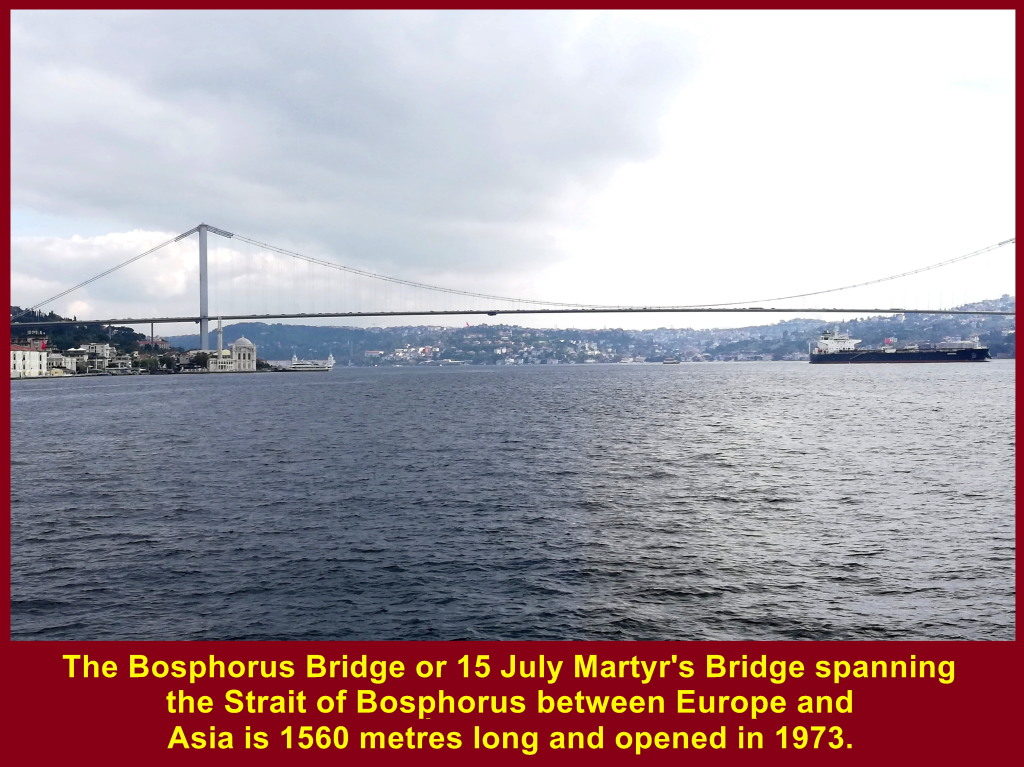
(ii) Faith Sultan Mehmet Bridge, the second bridge built to link Europe and Asia, was opened in 1988. It is 1510 metres long.
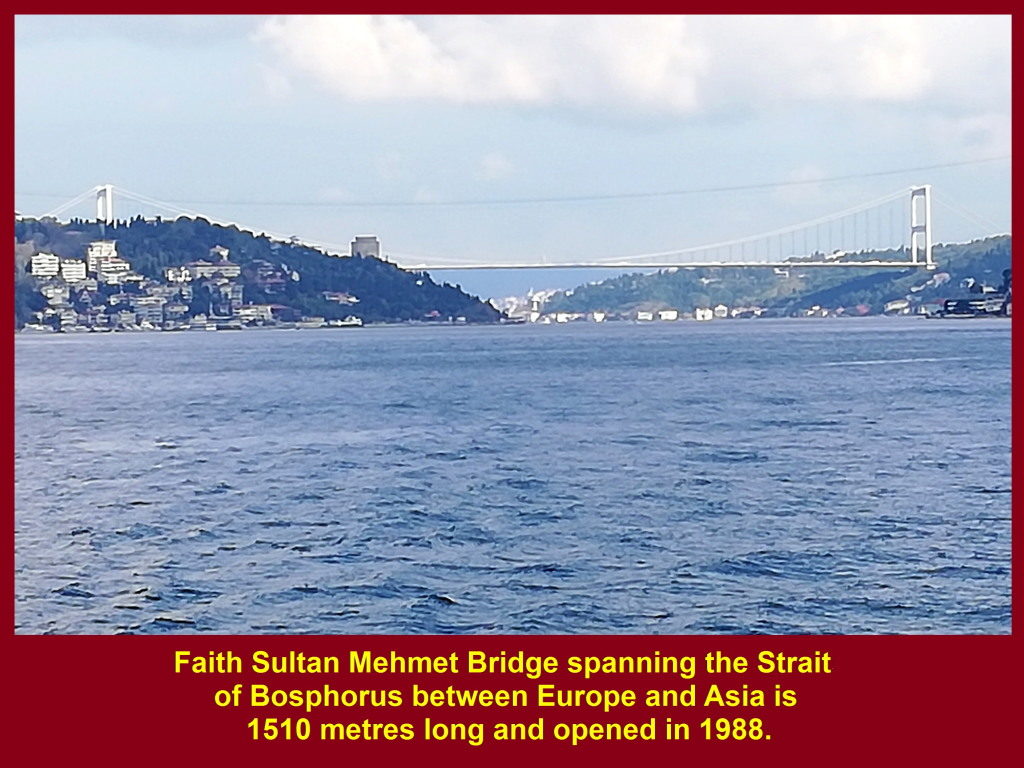
(iii) Yavuz Sultan Selim Bridge, the third bridge that connects Europe and Asia, was opened in 2016. It is the longest bridge among the three of them. Its length is 2164 metres.
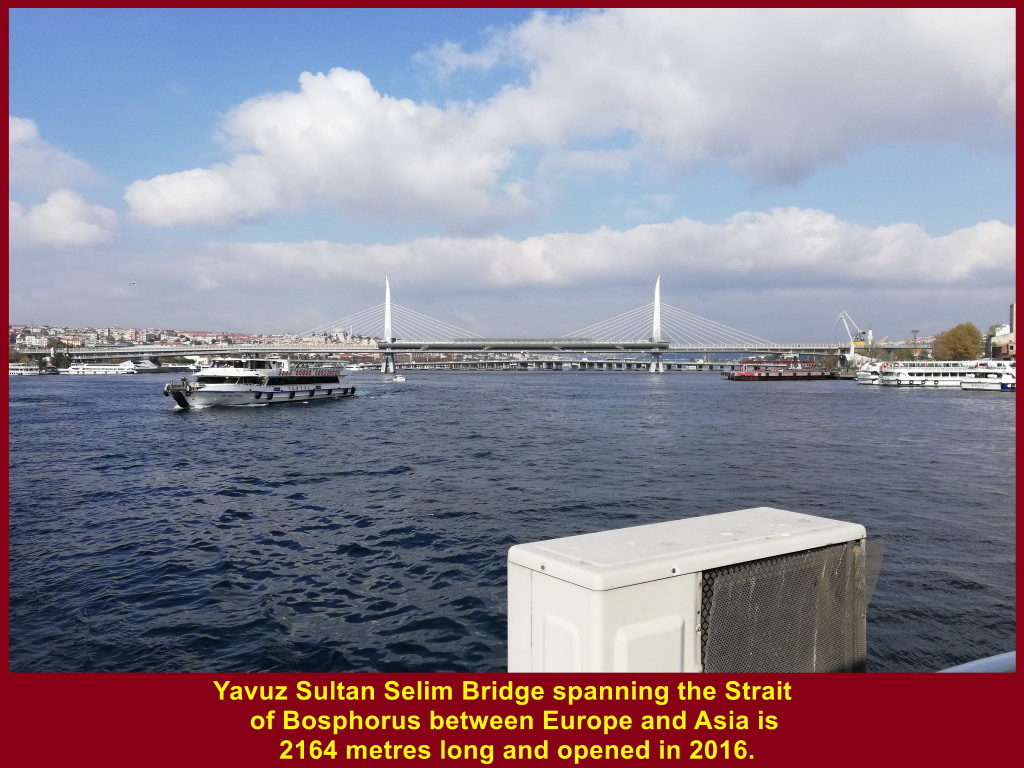
Galata Bridge
Galata Bridge in Istanbul spanning the Golden Horn estuary is 490 metres long. Opened in 2003, it links the traditional place and the place where most of the non-Muslims, foreign merchants and diplomats live and work.
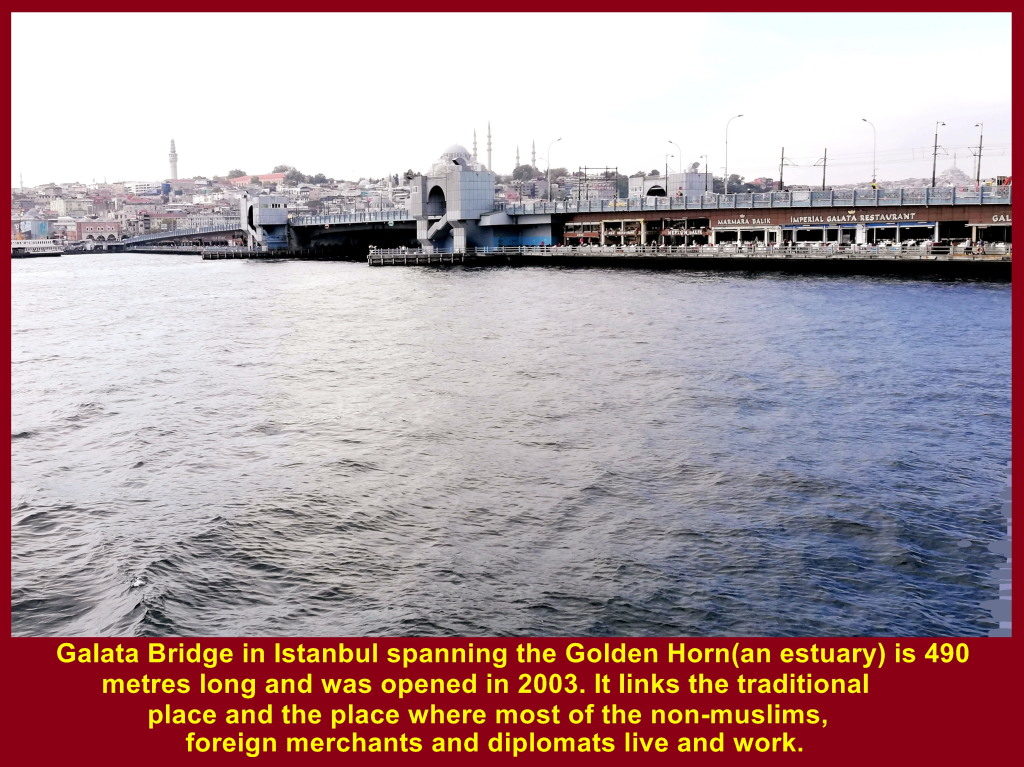
Importance of Boats
Boats in the Strait of Bosphorus between Europe and Asia have been an important public transport for many commuters, tourists and vehicles for many years.
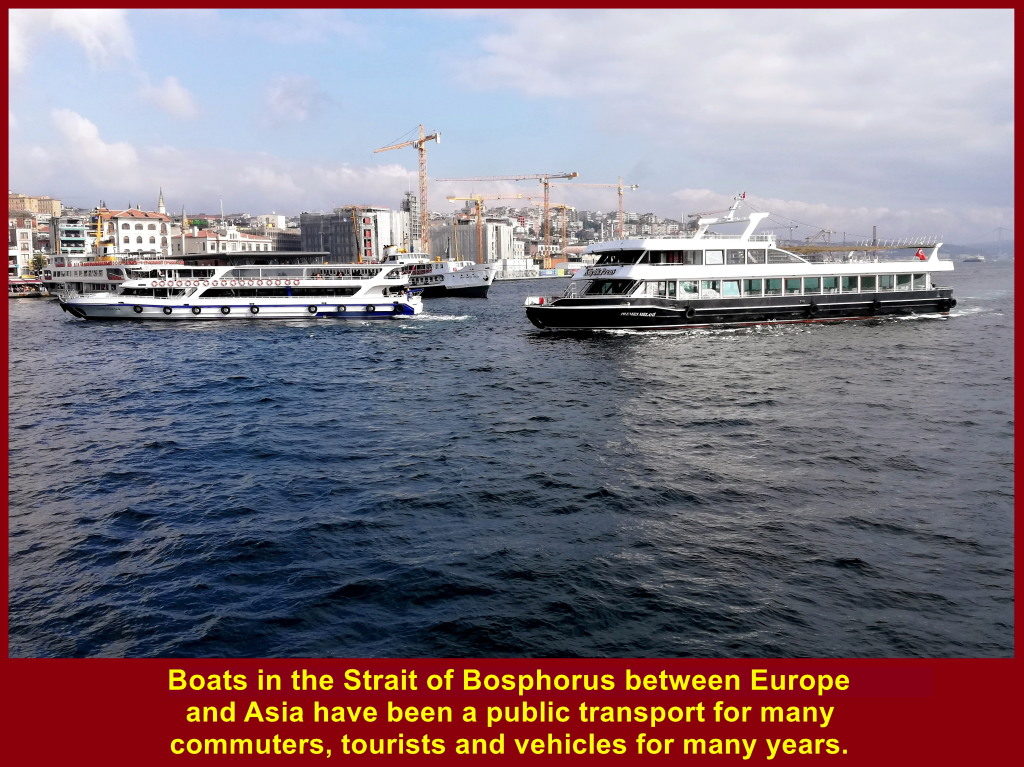
Boats of different kinds use the Strait of Bosphorus every day. Small ships pass through the strait, too.
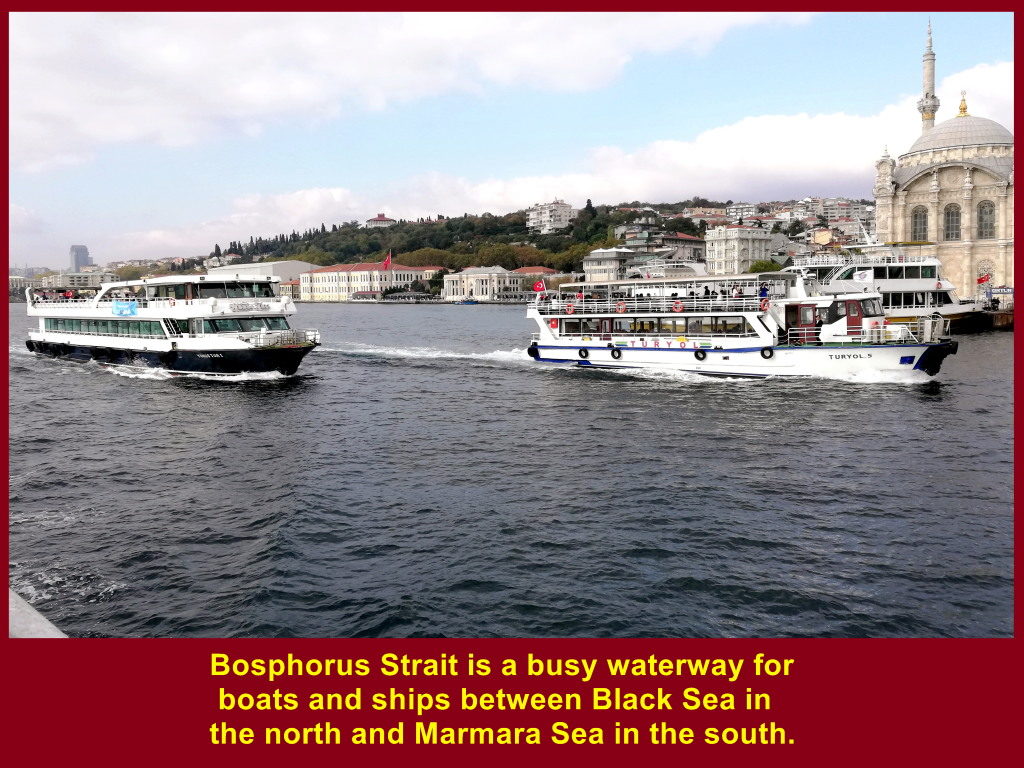
A ferry carrying passengers, tourists and vehicles past our boat in the Strait of Bosphorous in Istanbul, Turkey.
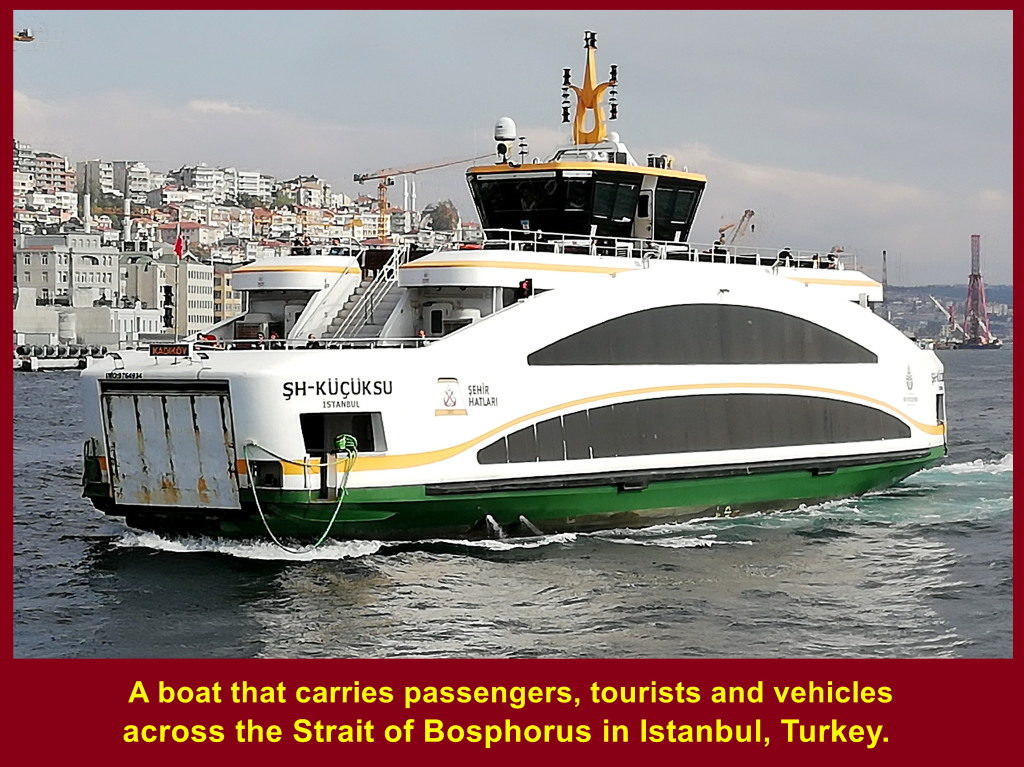
New and Old Buildings
While sailing on our boat, “Istanbul City”, in the Strait of Bosphorus, we saw new and old buildings on its shores.
Below are photos showing historical buildings on the shores of Bosphorus Strait.
(i) Dolmabachce Mosque which was built in 1855
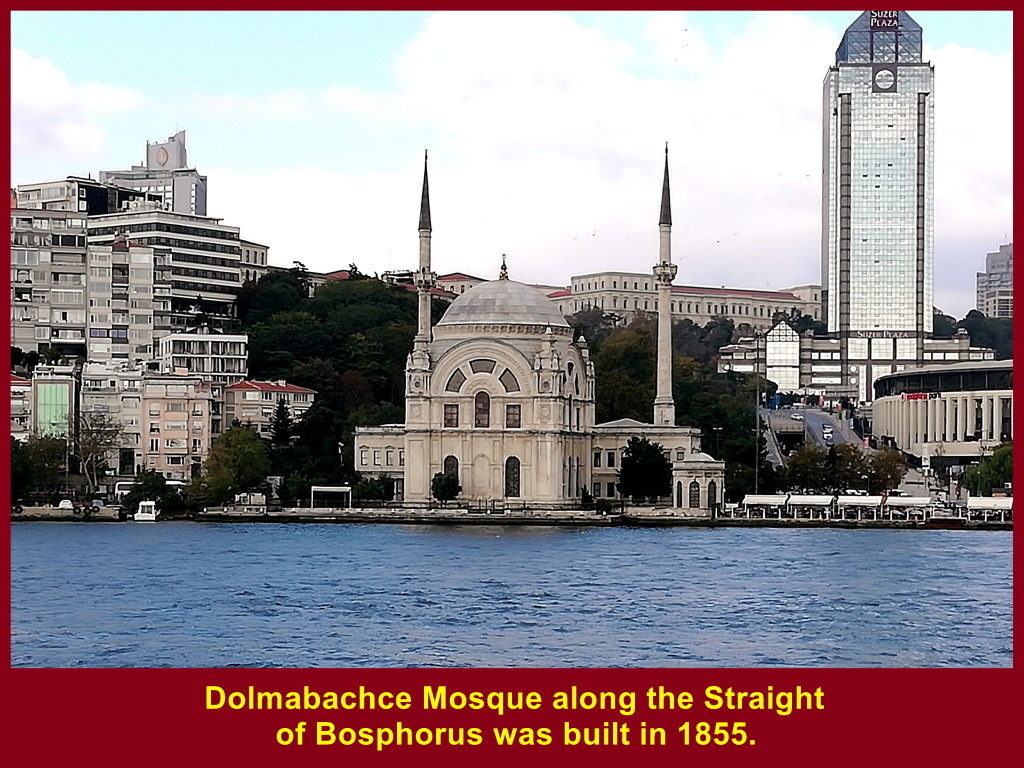
(ii) Ortakoy Mosque which was built in1856
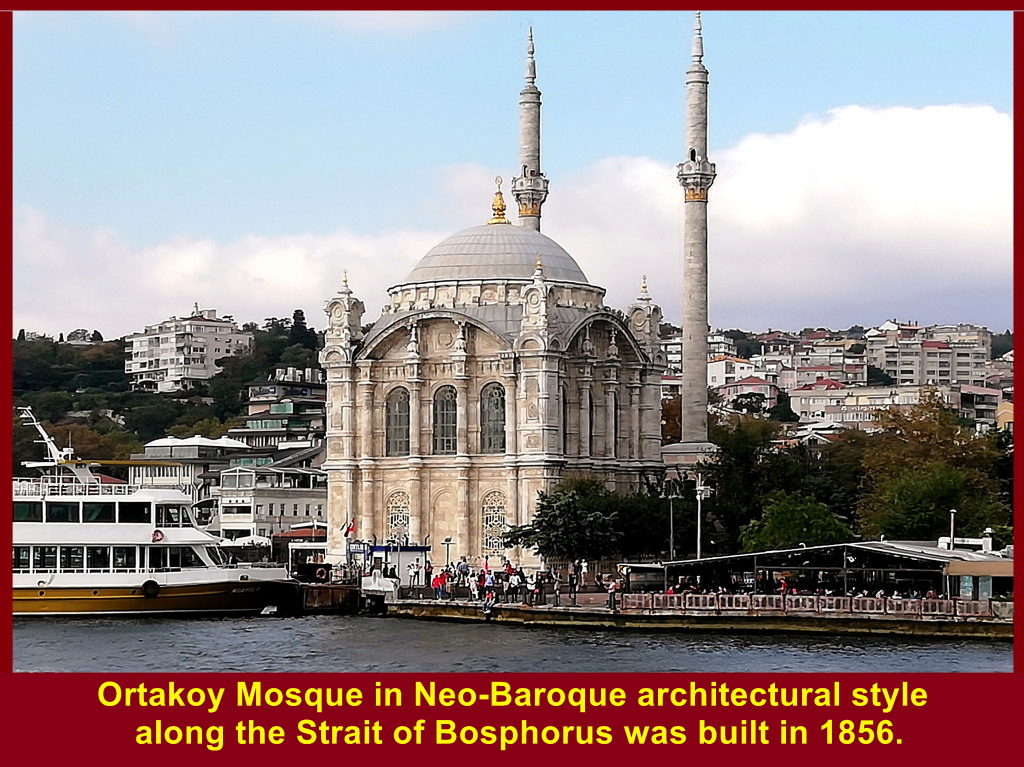
(iii) Dolmabahce Palace which was opened in 1856 and home to 6 sultans of the Ottoman Empire from 1856 until 1922
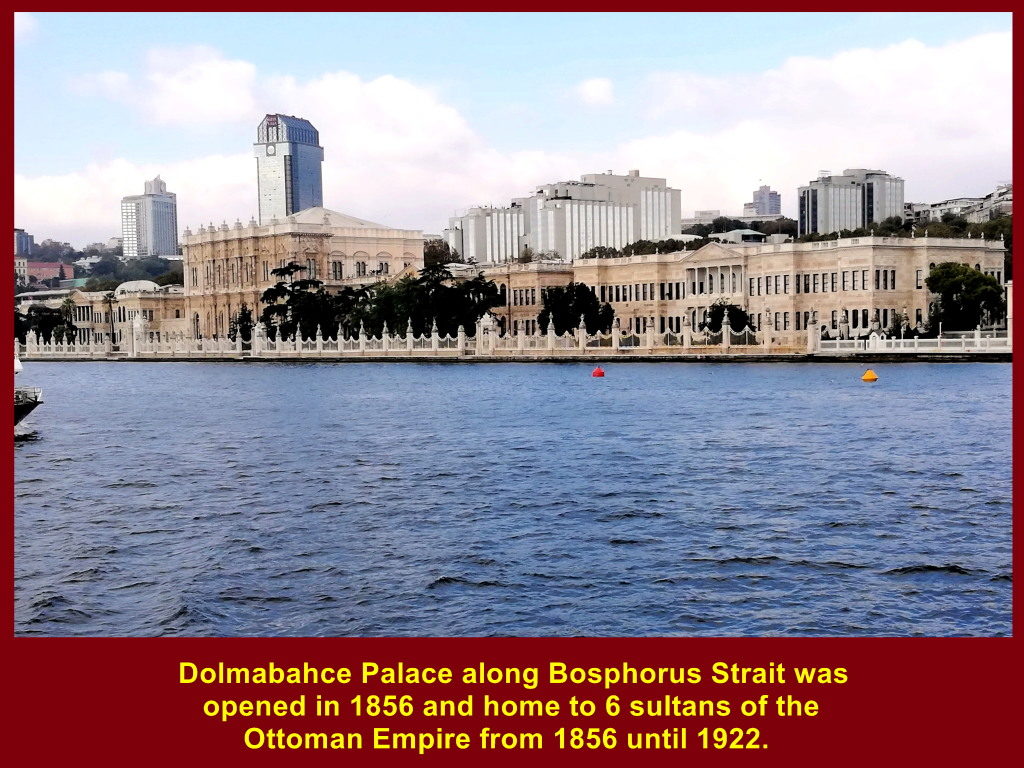
(iv) Ziya Kalkavan Vocational & Technical Anatolian High School

(v) Kuleli Military High School which was established in 1845
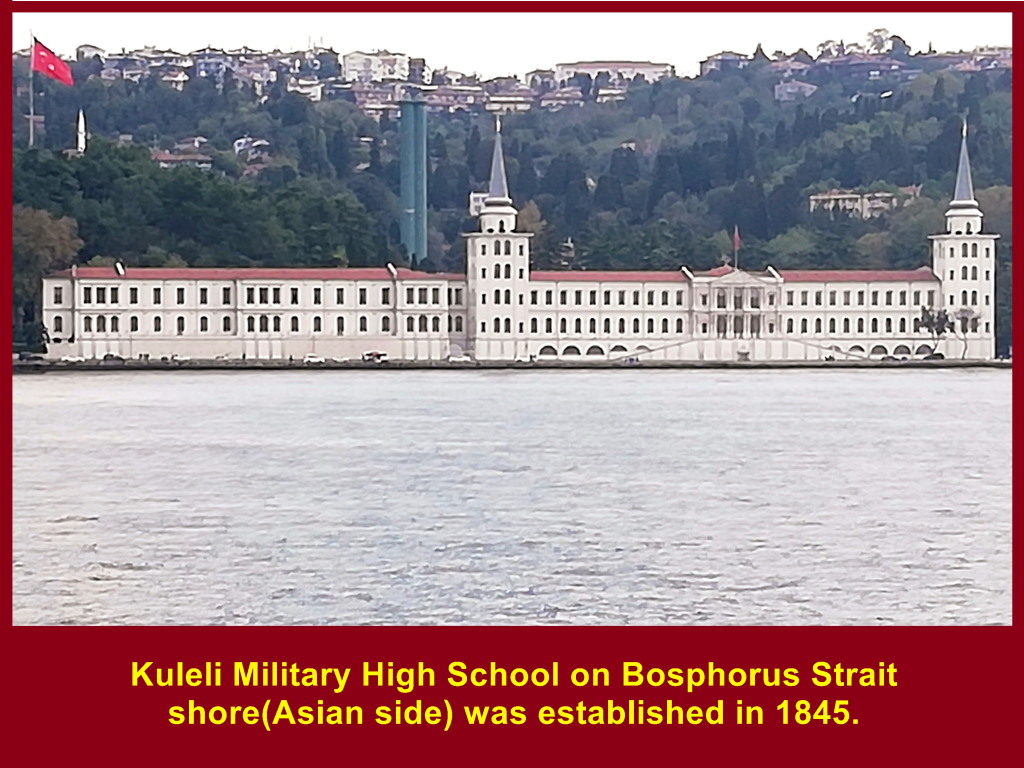
Promontory
We saw from the Golden Horn estuary two monumental buildings, viz. Topkapi Palace and Hagia Sophia Museum on a promontory.
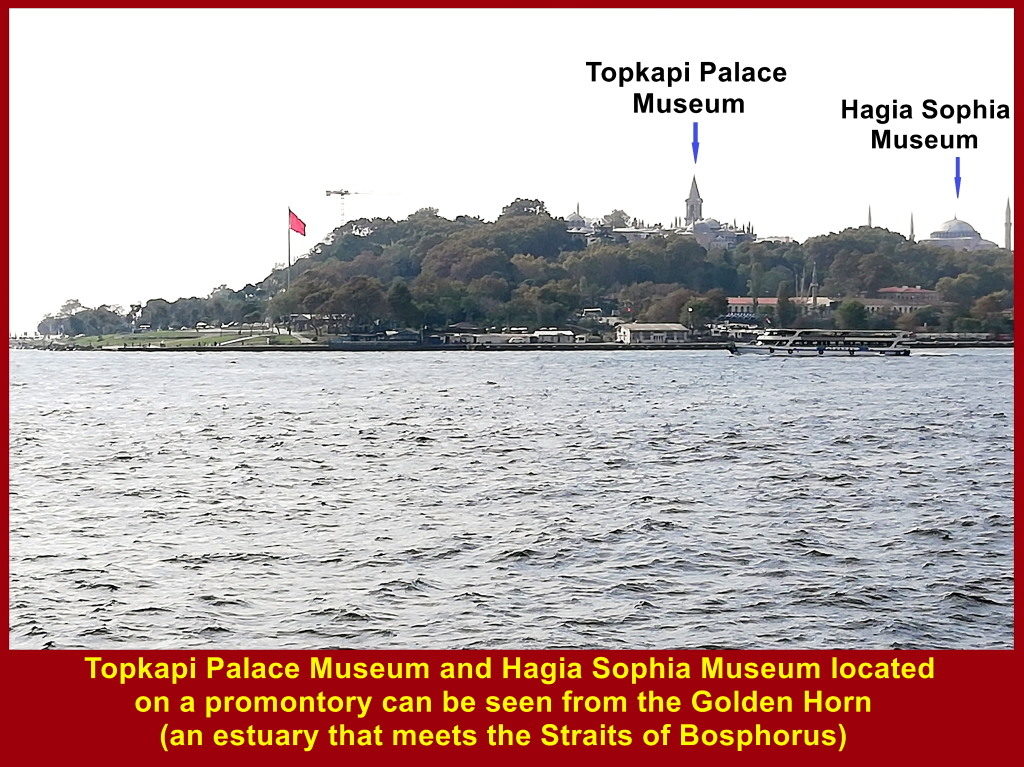
Lunch-Time
After an hour of boat-cruise in the Bosphorus Strait, we stopped at a restaurant, Imperial Galata Restaurant, located under Galata Bridge and had lunch.
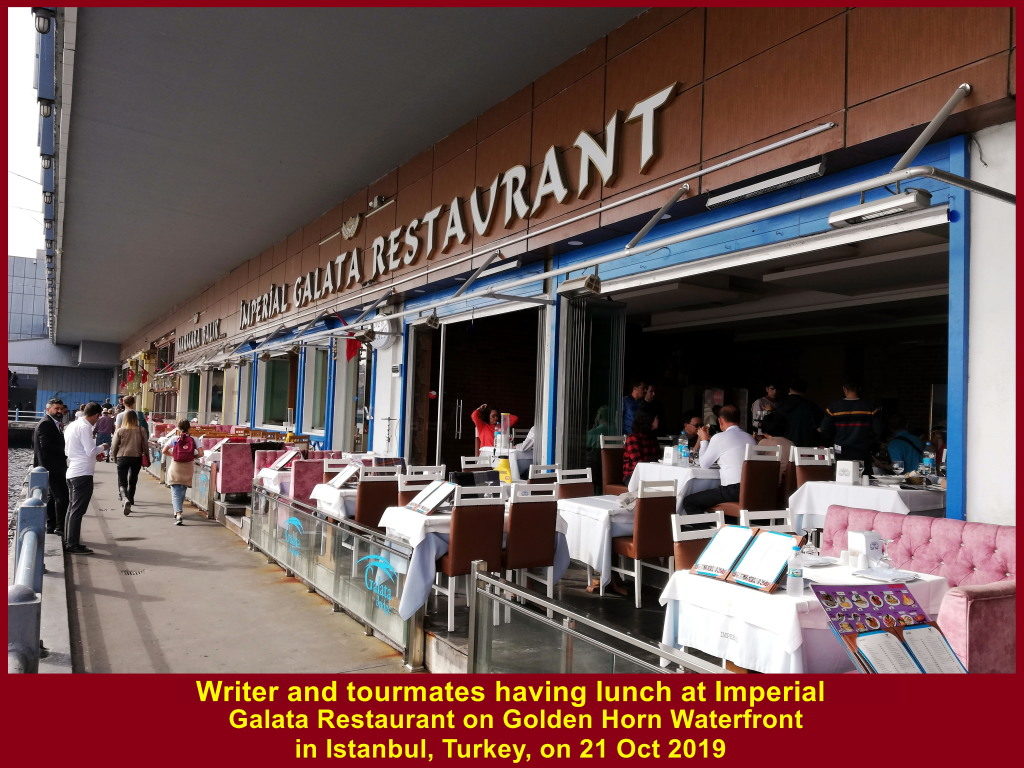
Happy Moment
At the restaurant, our tour-manager, writer and tourmates toasted to each other for having, successfully, visited almost all the places of interest in our Turkey tour on 21 Oct 2019.
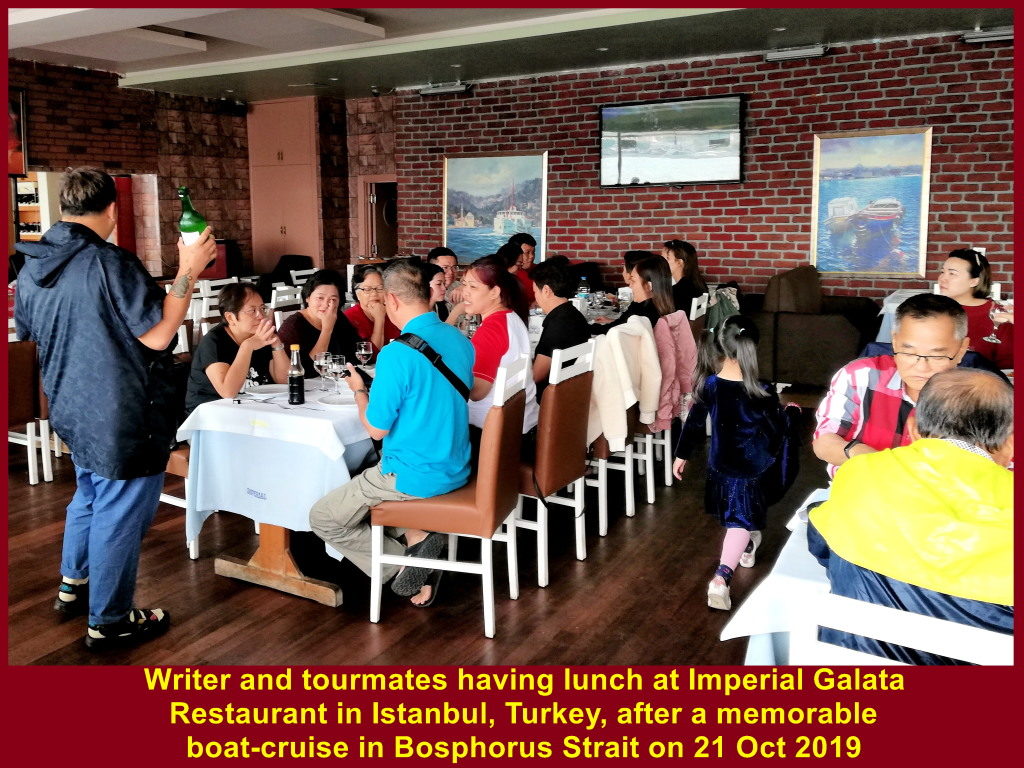
Writer’s Last Lunch in Turkey
My last lunch in Turkey at Imperial Galata Restaurant in Istanbul on 21 Oct 2019
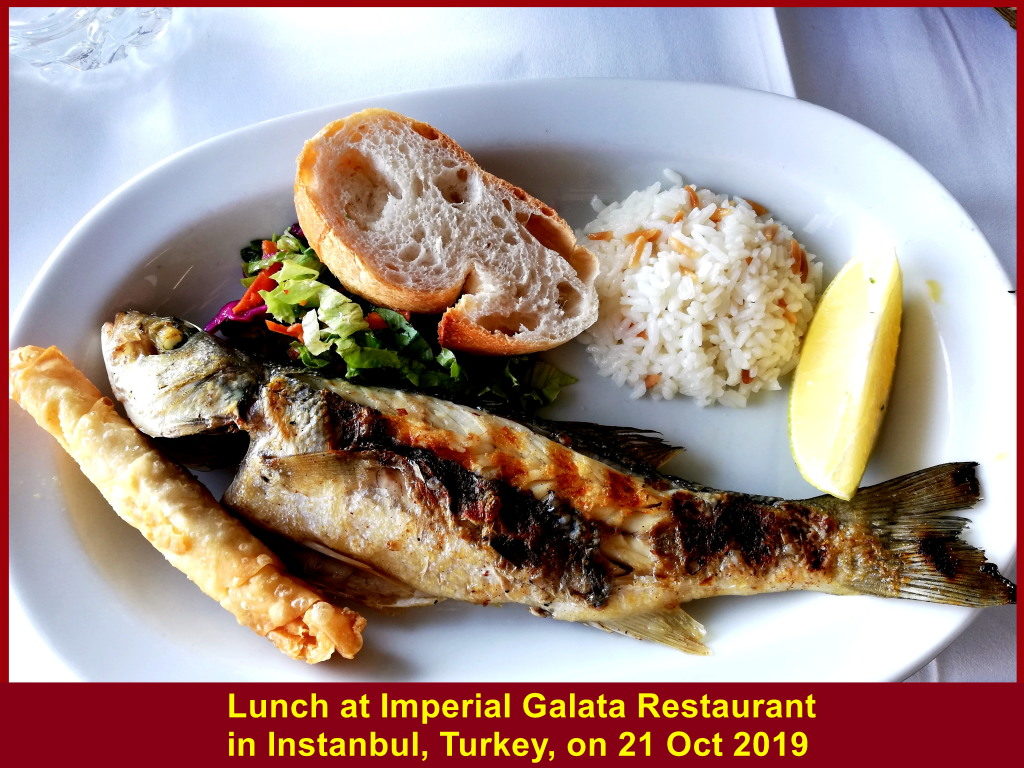
A Visit to Two Famous Bazaars
After lunch, we walked across Galata Bridge spanning the Golden Horn estuary in Istanbul to visit two famous markets, Spice Bazaar and Grand Bazaar.
Anglers on Galata Bridge
While crossing the bridge, we saw many local anglers fishing from the bridge.
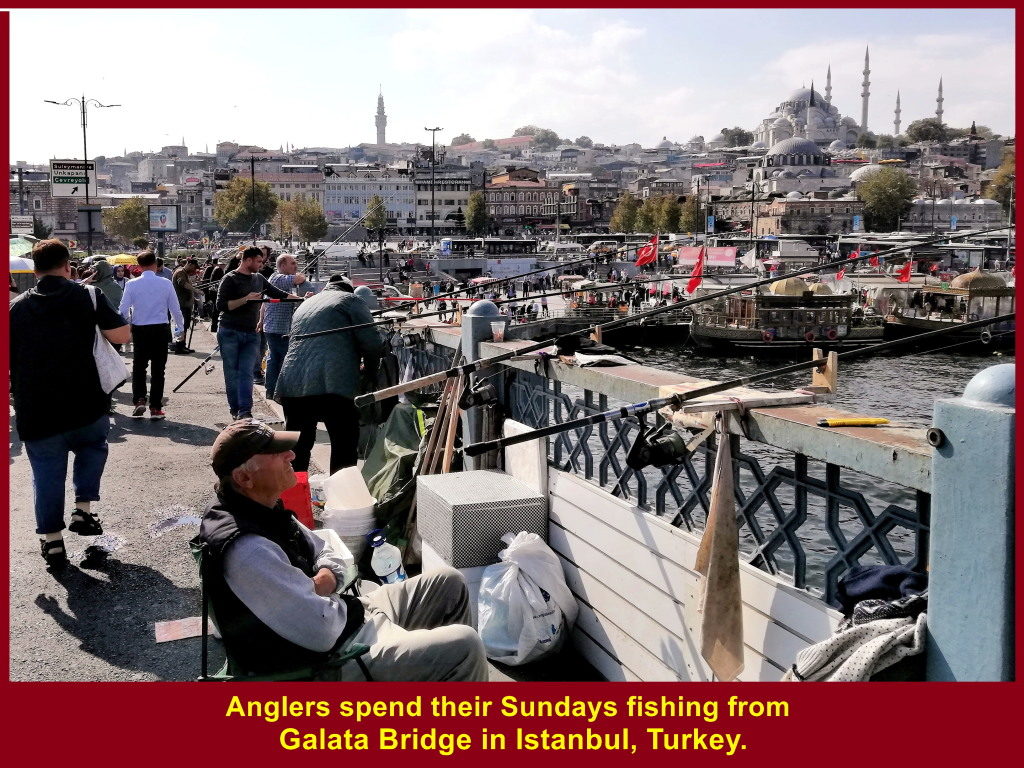
An angler’s pail of fish caught in the Golden Horn estuary.
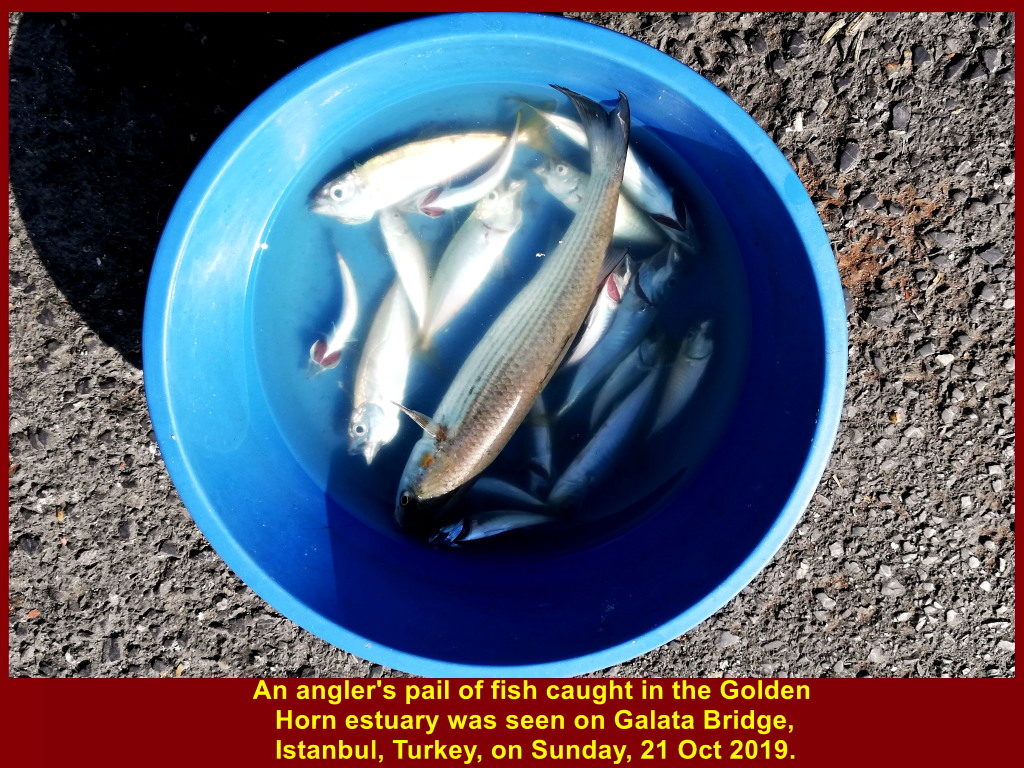
Camilica Mosque or New Mosque
On the way to Spice Bazaar, we saw from Galata Bridge a new large mosque which was opened on 4 May 2019. Known as Camlica Mosque or New Mosque, it is the largest mosque in Turkey.
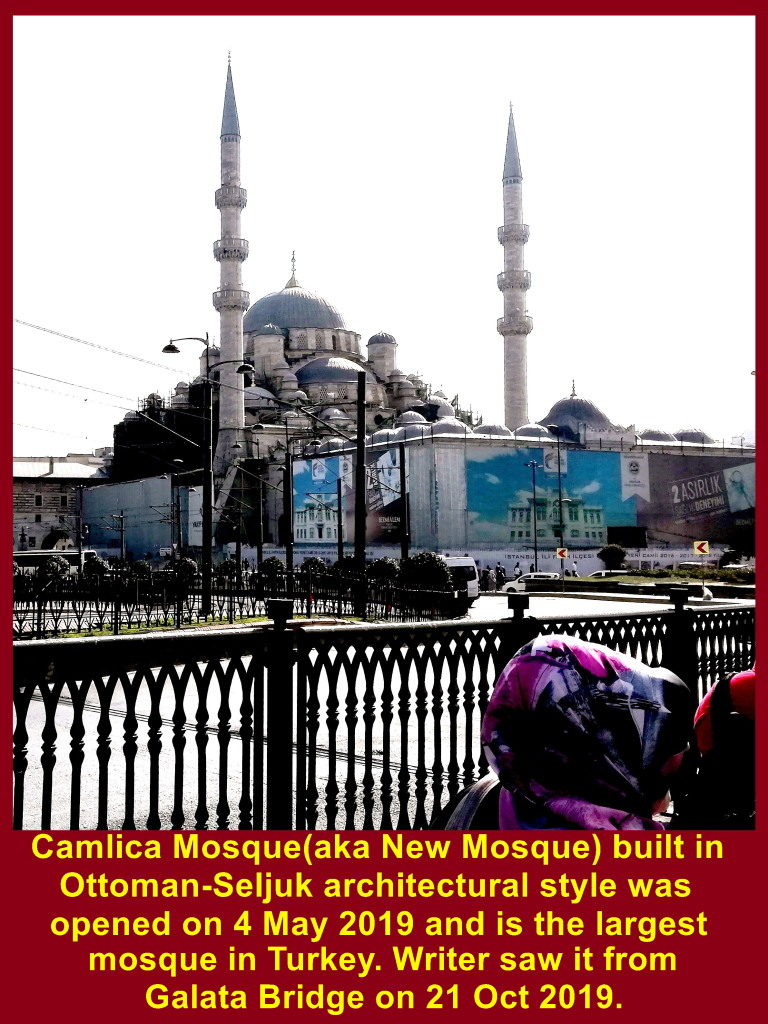
Previous Page / Home / Next Page
Places visited during Turkey Tour(13-22 Oct 2019):
Trojan Horse/Ancient Troy Cities Asklepion Ephesus Hierapolis/Pamukkale Travertine Sultanhani Caravanserai Pasabag Valley Uchisar Valley/Kaymakli Underground City Gerome Valley/Turkish Night Show Hot Air Balloon/Lake Golu/Anitkabir Hagia Sophia/Topkapi Palace/Blue Mosque Bosphorus Boat Cruise Spice Bazaar/Grand Bazaar
Turkey Travel Part XII: Spice Bazaar & Grand Bazaar
(continued)
Day 9
Monday, 21 Oct 2019
Visiting Two Large Bazaars of Istanbul
After lunch at Imperial Galata Restaurant, we walked across Galata Bridge and went to two large bazaars known as Spice Bazaar and Grand Bazaar in Istanbul City.
The location of the two bazaars are shown in the pictorial map below.
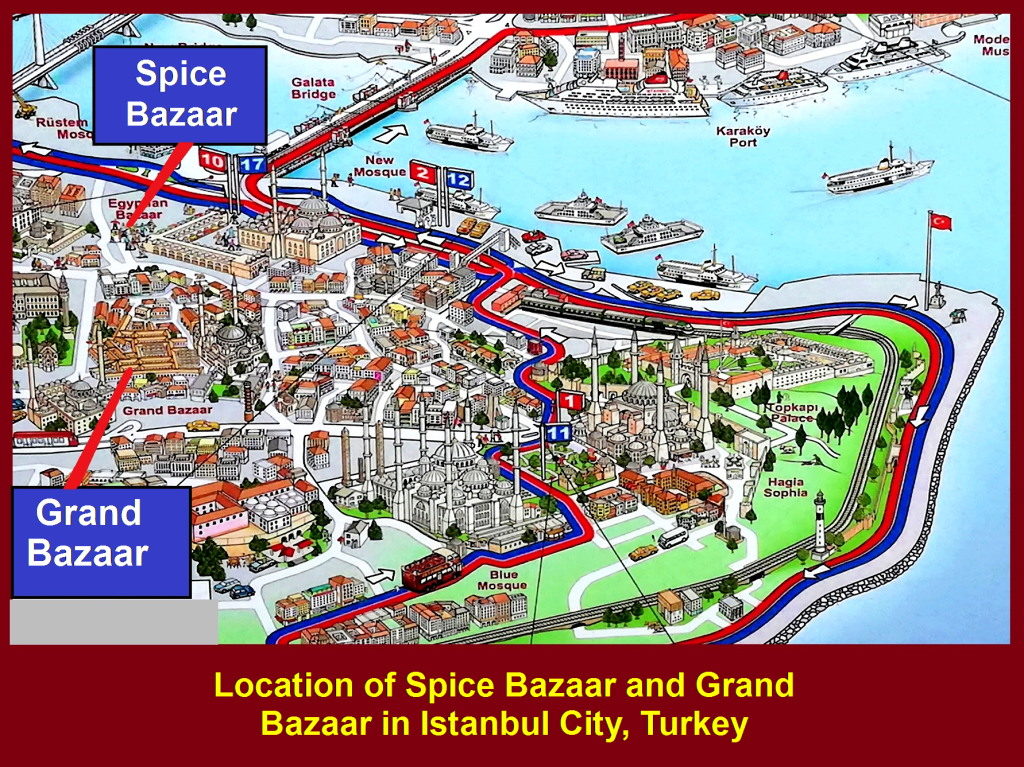
Spice Bazaar
Opened since 1664, Spice Bazaar is the second largest bazaar after Grand Bazaar in Turkey. It houses over 80 shops selling spices, Turkish Delights, jewellery, souvenirs, dried seeds, nuts and fruits, and many more. It is a tourists’ favourite place.
Main Entrance of Spice Bazaar
The photo below shows the main entrance of Spice Bazaar.
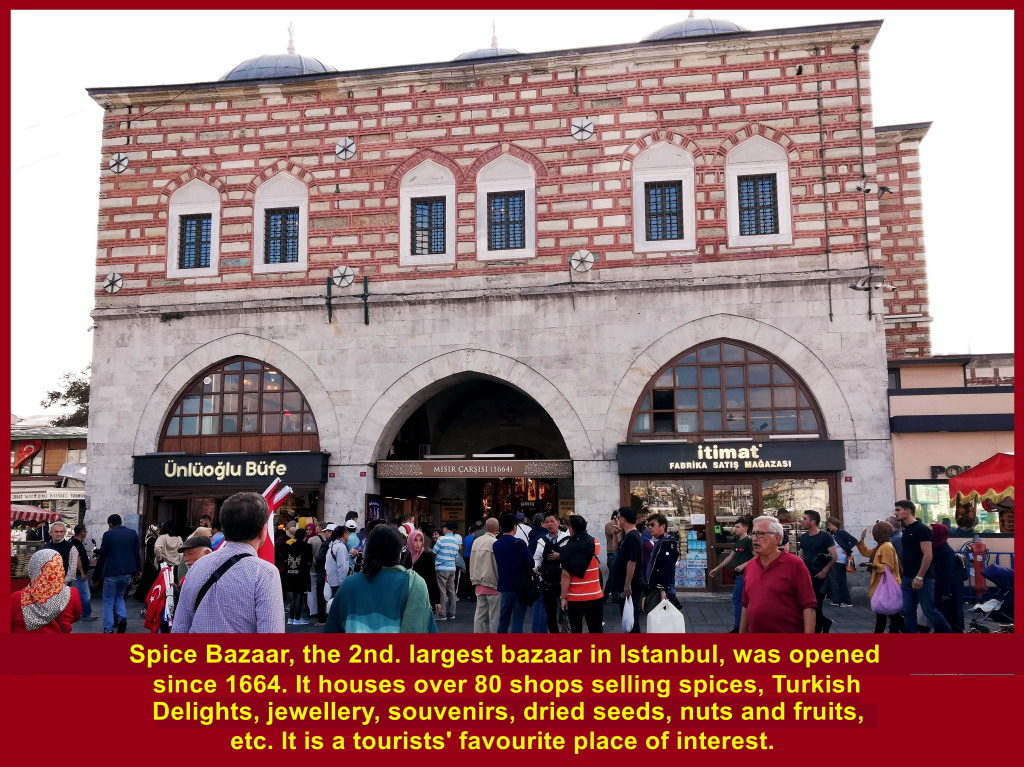
Tourists Throng Spice Bazaar
Tourists throng Spice Bazaar every day. It is a market place where goods ranging from spices to jewellery are sold.
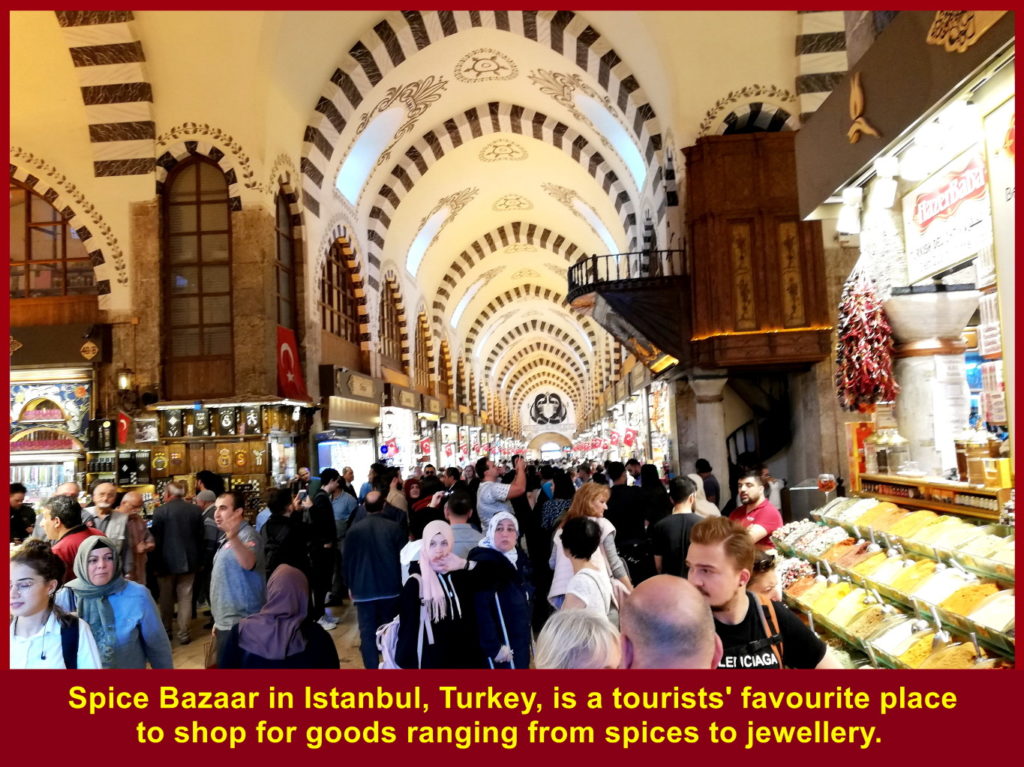
Writer and wife together with tourmates visited Spice Bazaar on 21 Oct 2019.
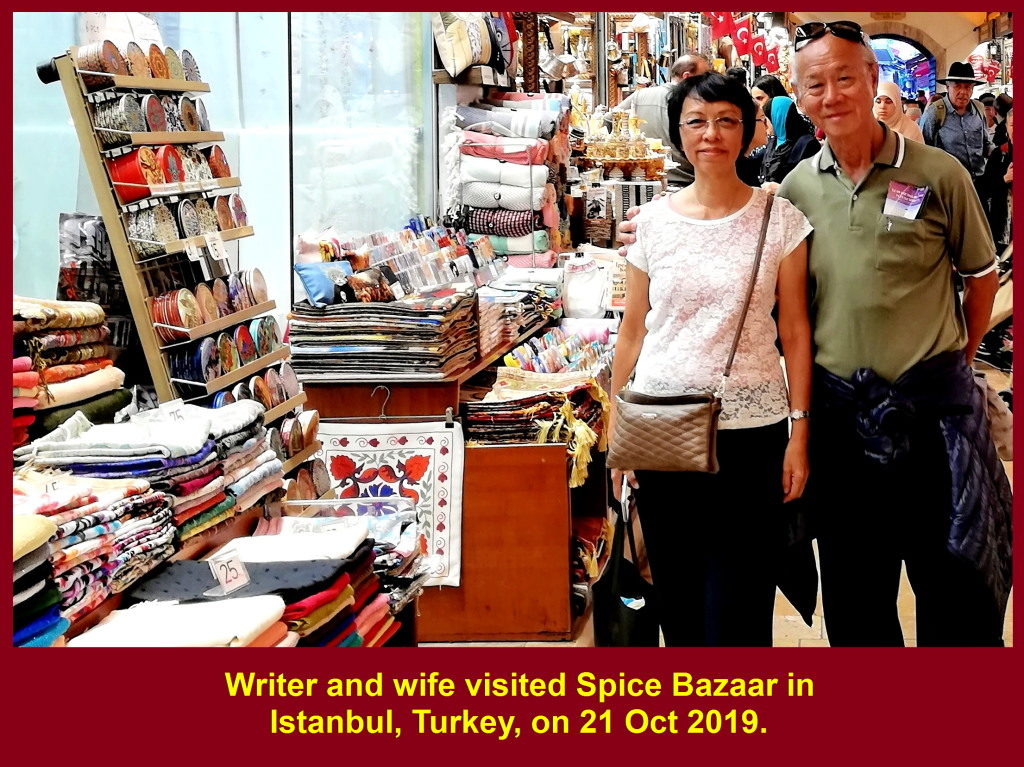
Shops in Spice Bazaar
The following photos below show shops selling the Turkish products in Spice Bazaar.
(i) A Spice Bazaar shop selling a wide variety of Turkish edible products
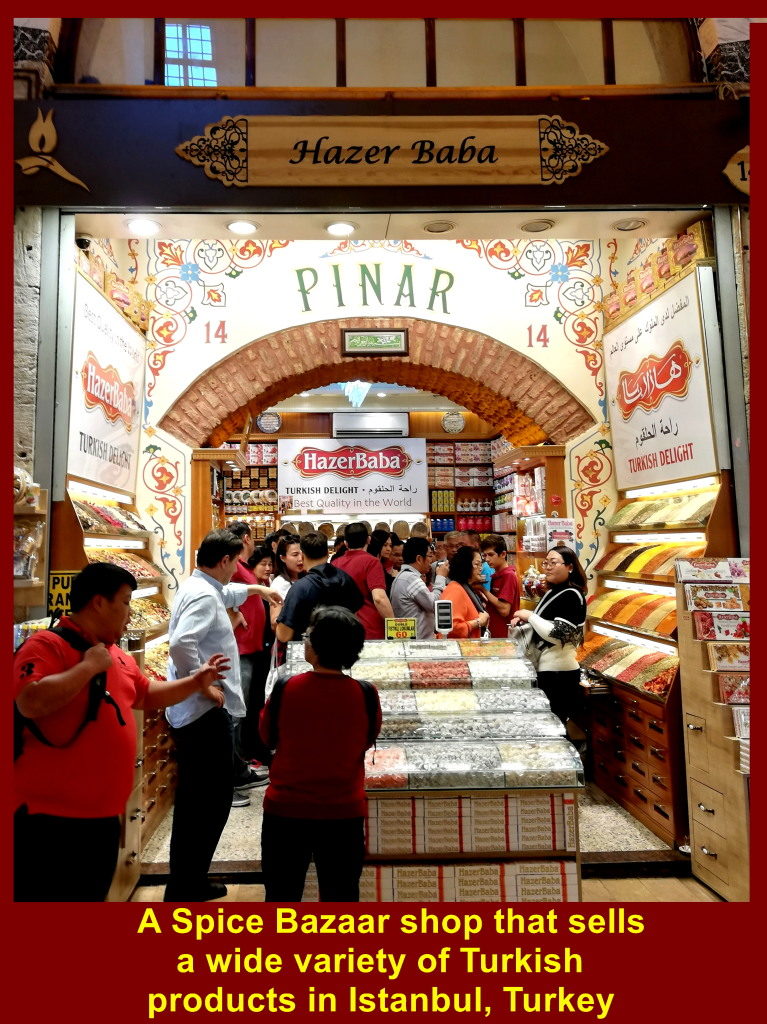
(ii) Different kinds of spices for sale at a Spice Bazaar shop
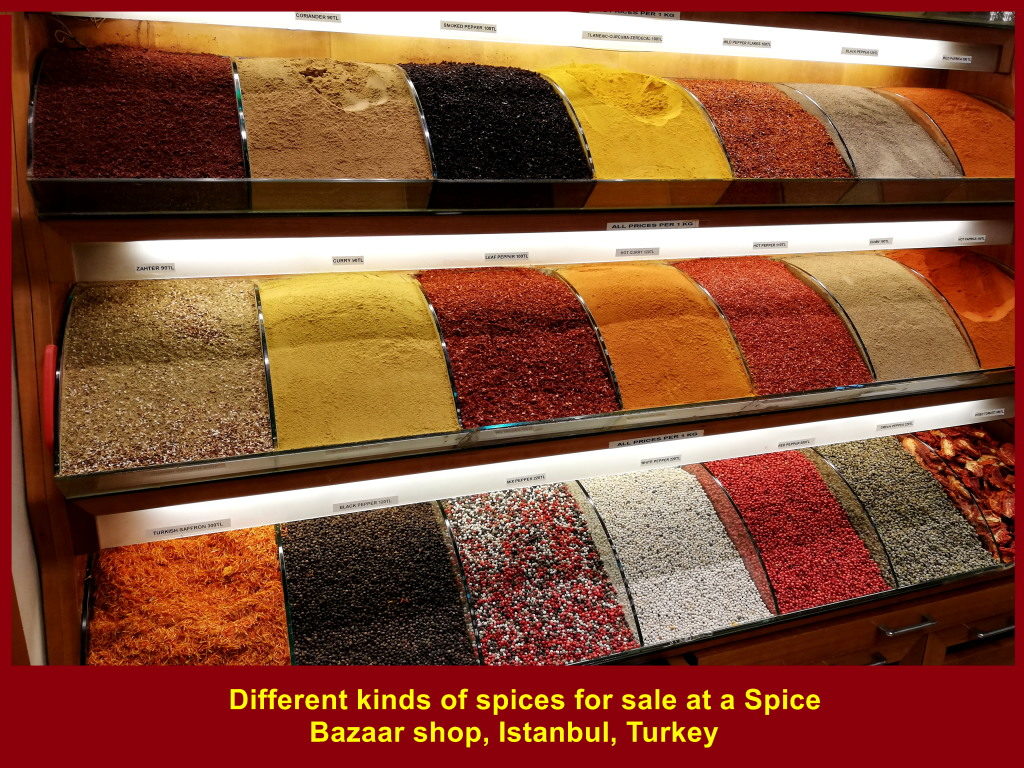
(iii) Boxes of Turkish Delights with different flavours for sale at a Spice Bazaar
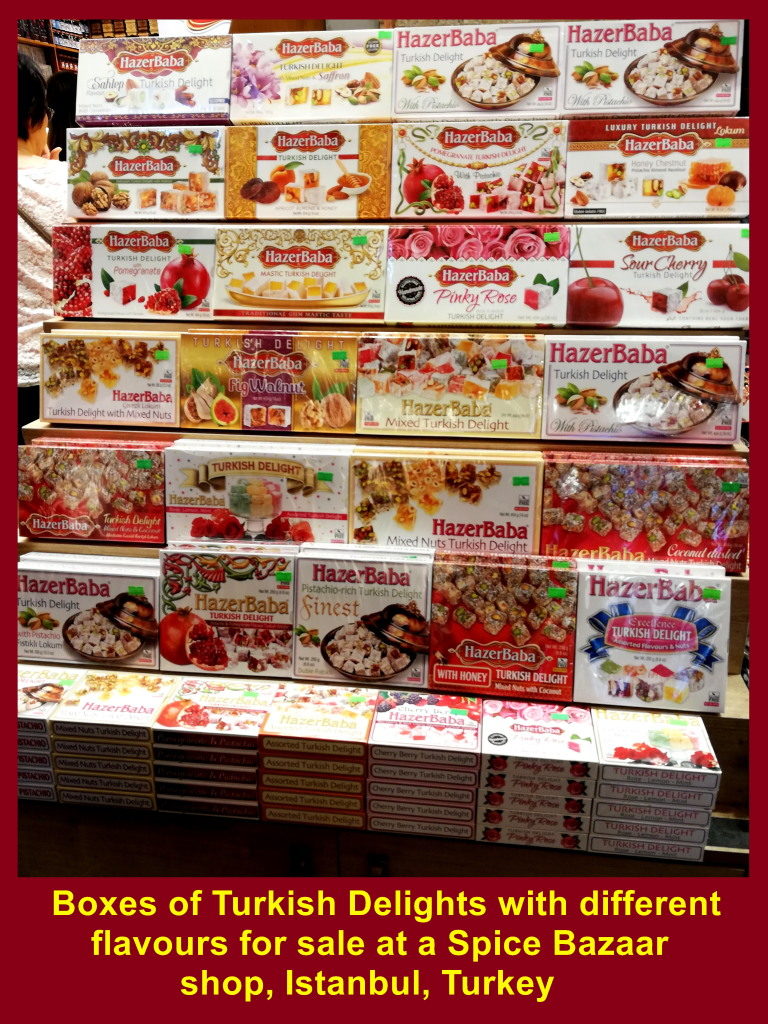
(iv) A wide variety of sweet Turkish Delights for sale at a Spice Bazaar shop
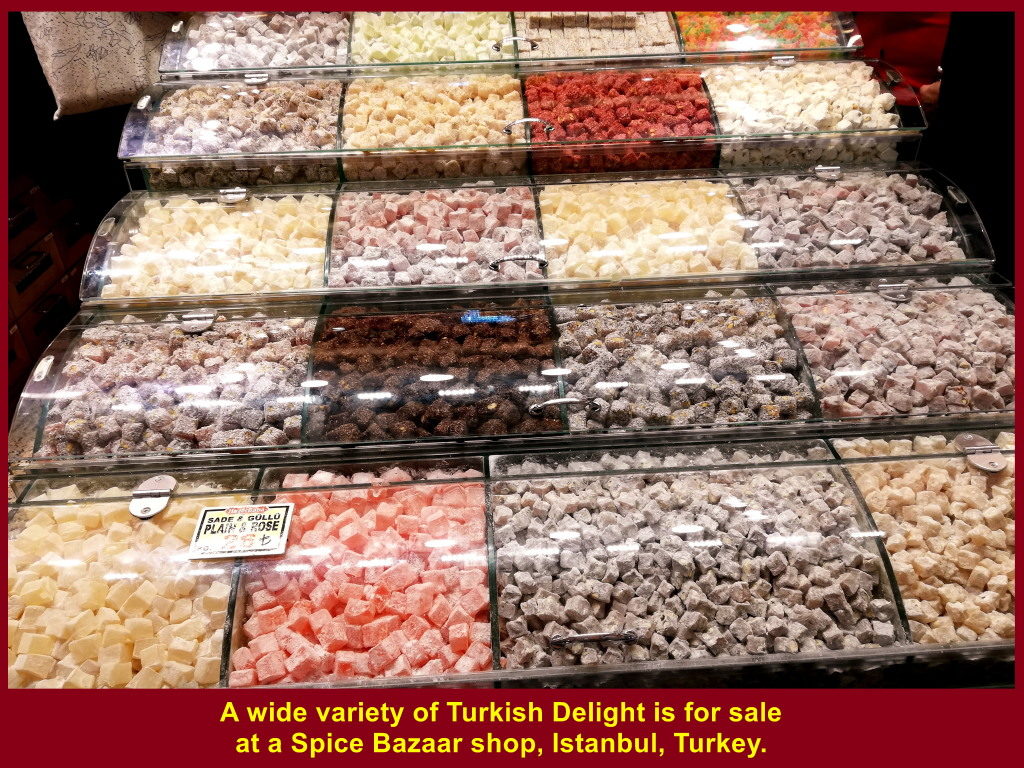
(v) Dried seeds, nuts and fruits for sale at a Spice Bazaar shop
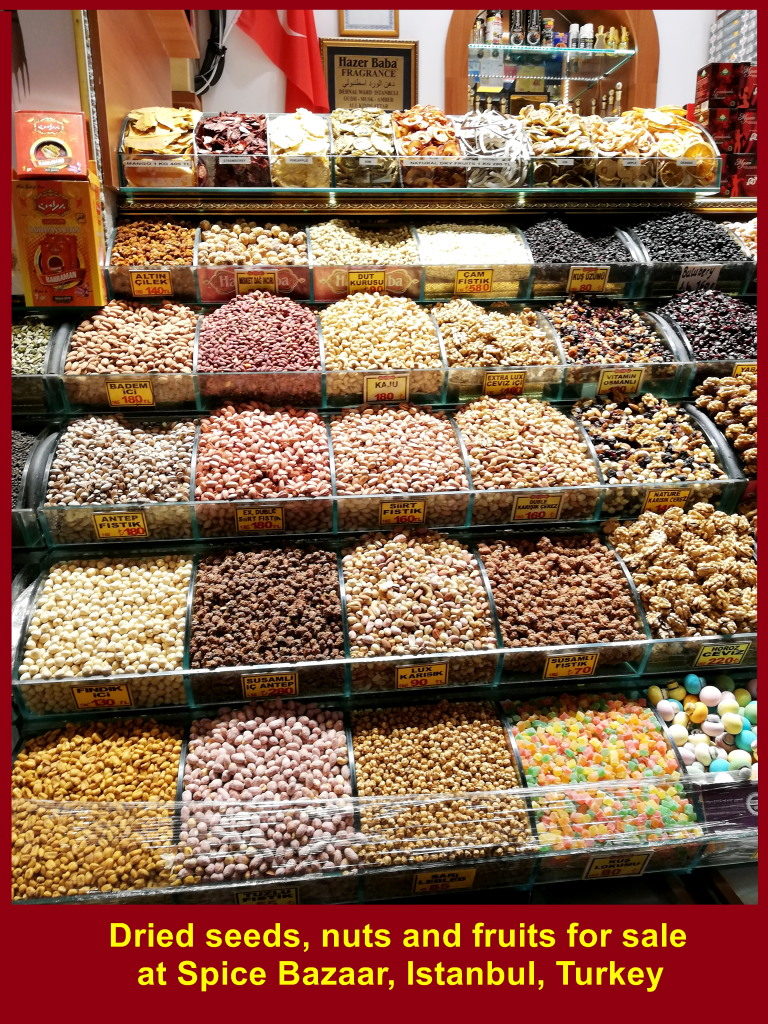
(vi) A wide variety of dried flowers and fruits for making tea for sale at a Spice Bazaar shop
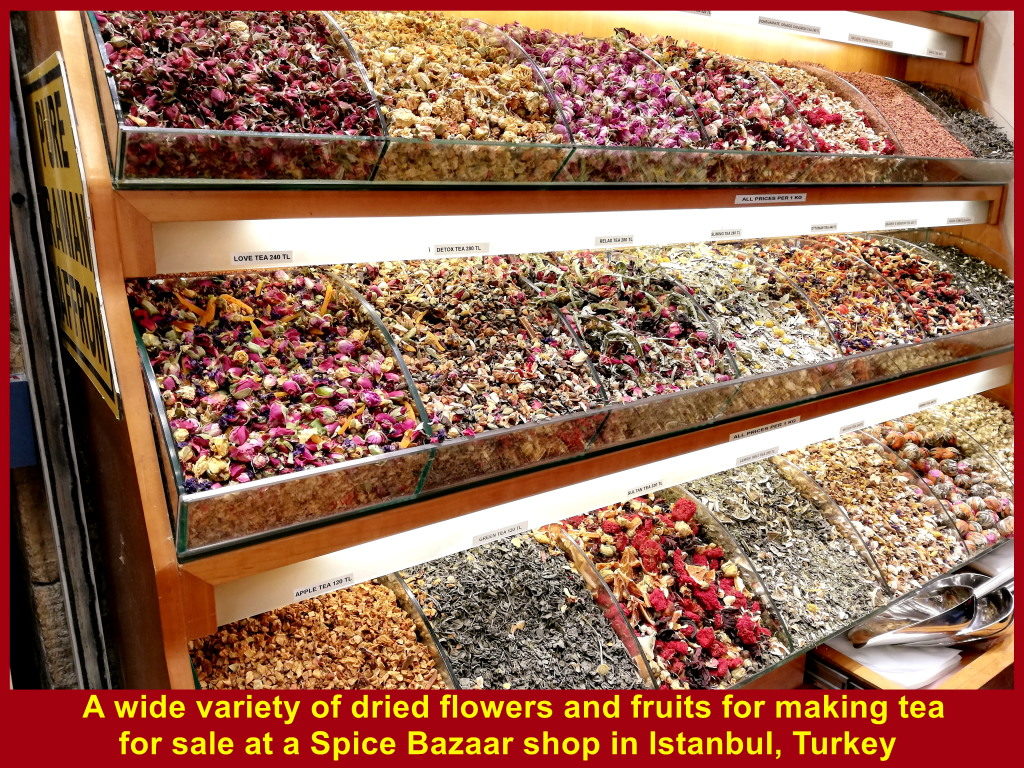
(vii) Dried seed, nuts and fruits for sale at a Spice Bazaar shop
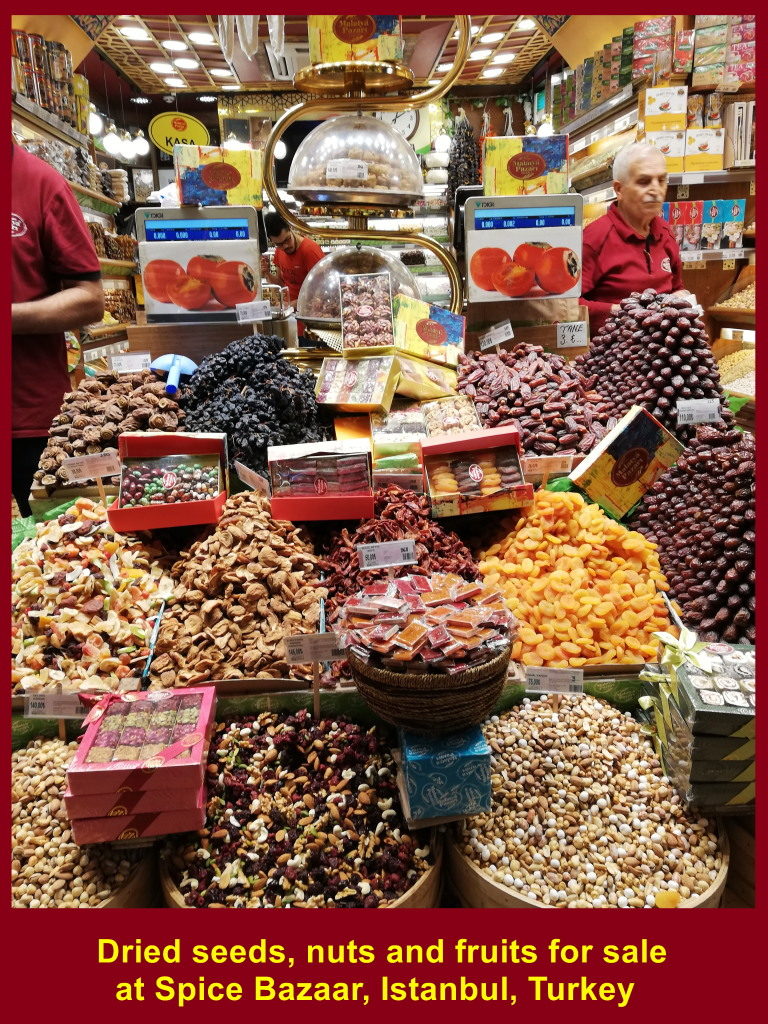
(viii) Boxes of Turkish tea with flavours of apple, orange, rose, cinnamon, pomegranate, honey and ginger for sale at a Spice Bazaar shop
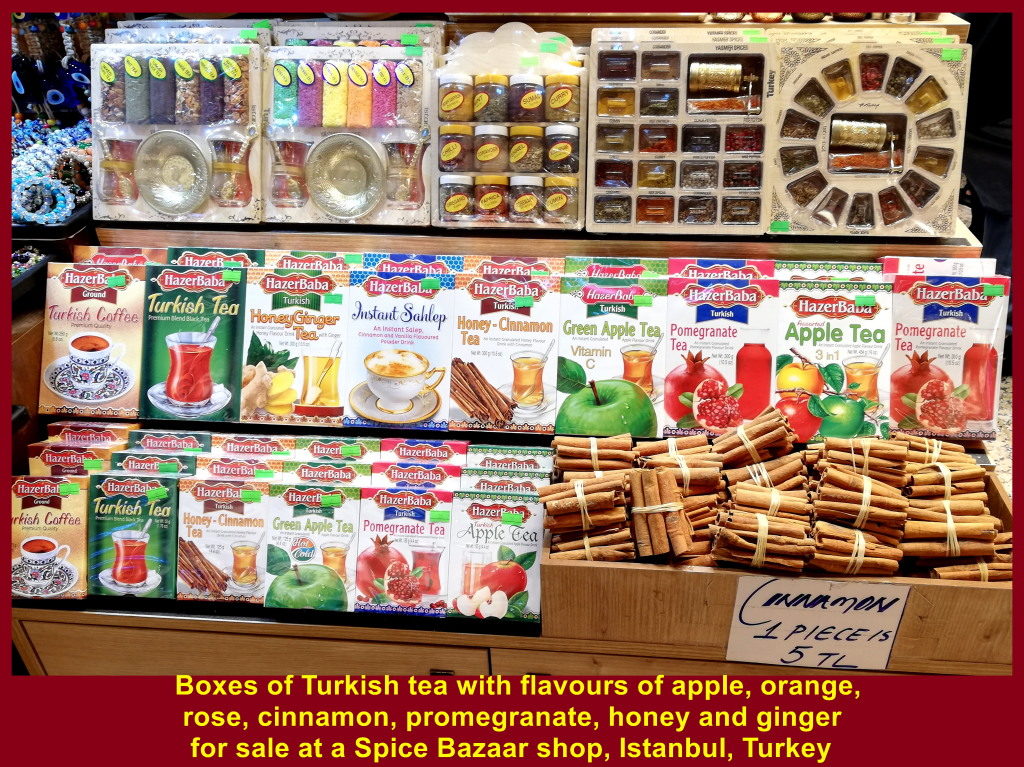
(ix) A souvenir shop at Spice Bazaar

(x) White table-cloths, bar-napkins, tea-towels, etc. for sale at a Spice Bazaar shop
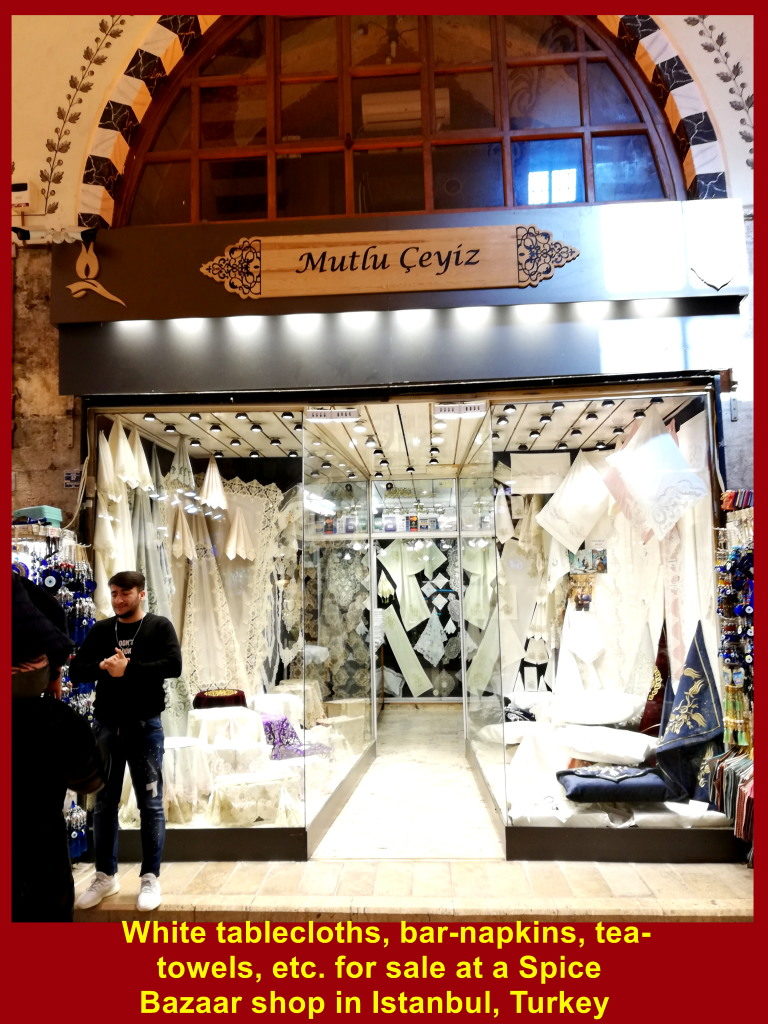
(xi) A Spice Bazaar’s gift shop
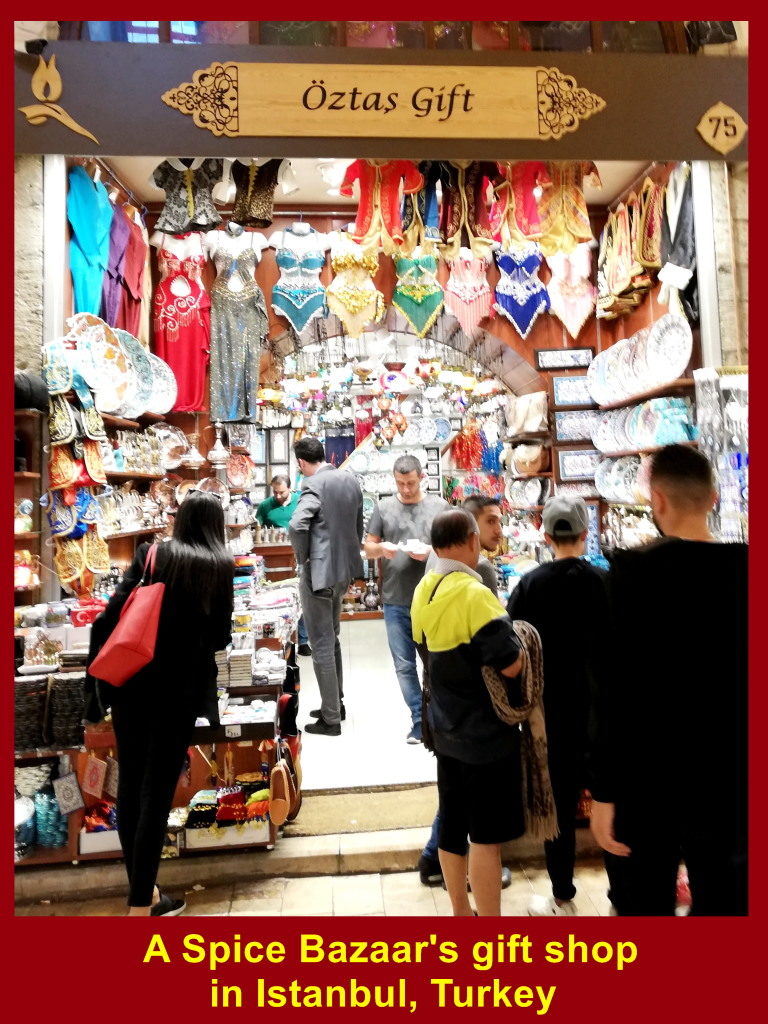
(xii) An ice-cream seller tricked a customer in getting the ice-cream the latter asked for at a Spice Bazaar shop
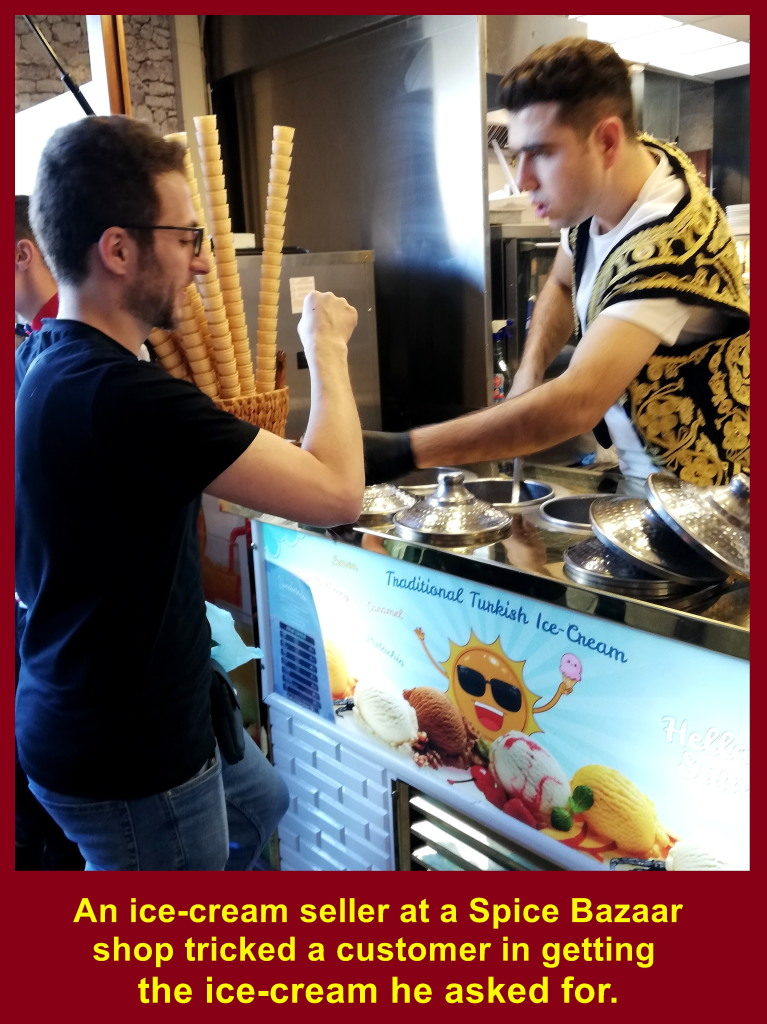
(xiii) Beef for sale at a Spice Bazaar shop
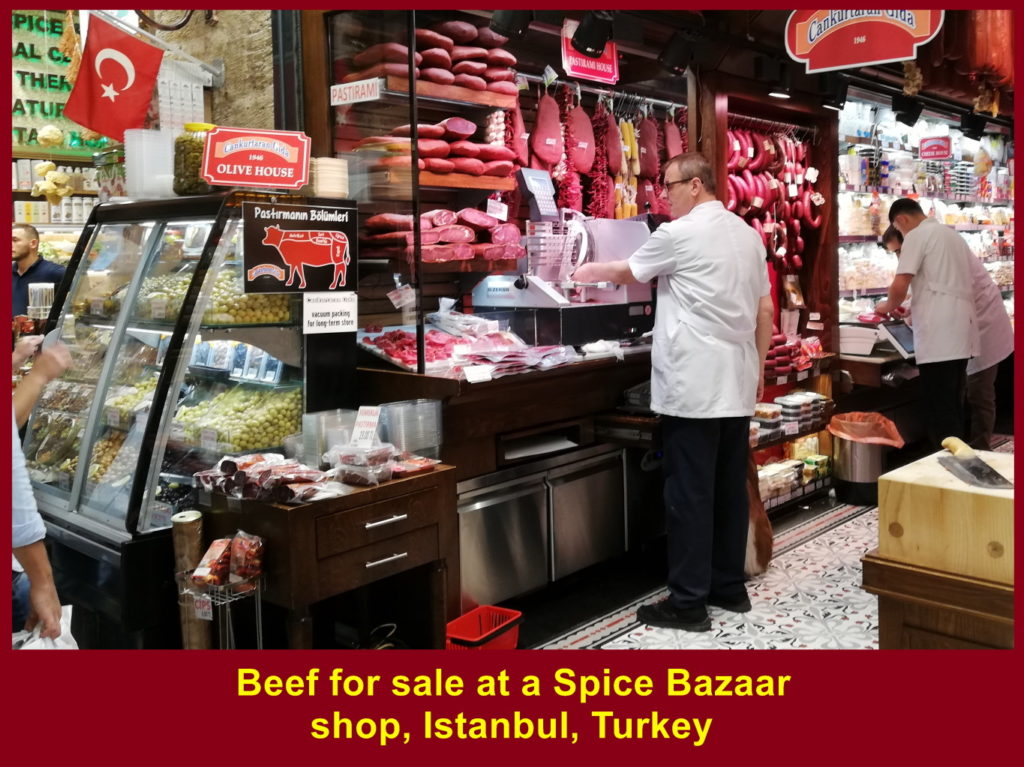
(xiv) A Spice Bazaar shop selling “kebab” which is bread stuffed with slices of meat, salad and some sauce
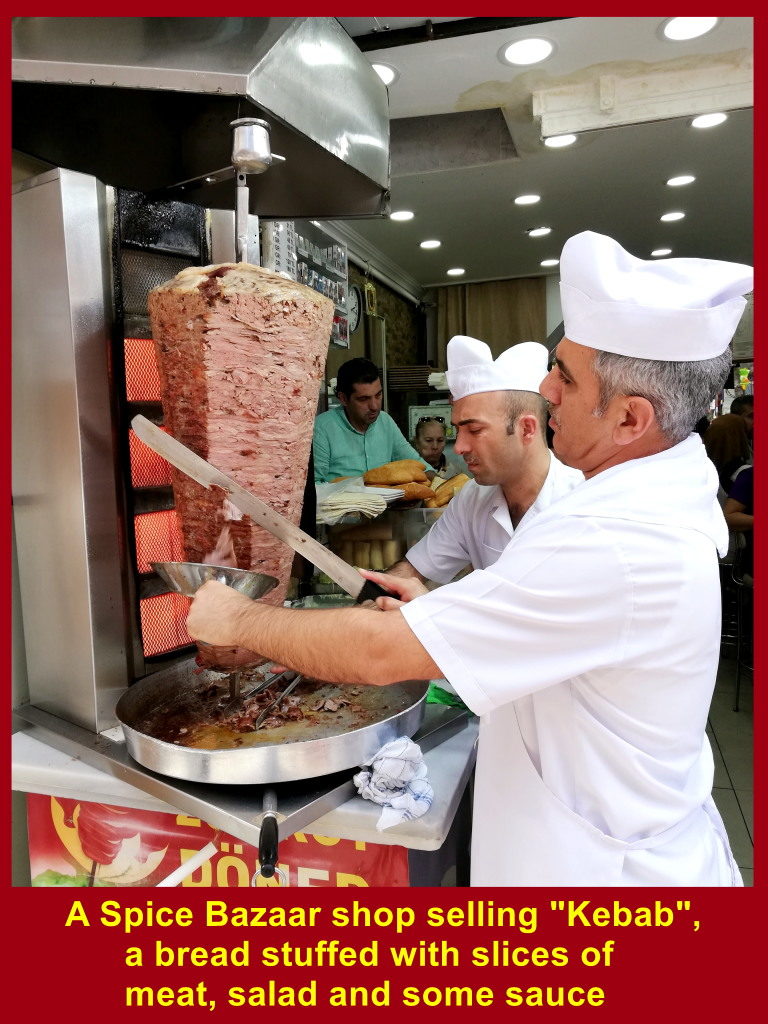
(xv) Photo below shows “kebab” for sale at a Spice Bazaar shop
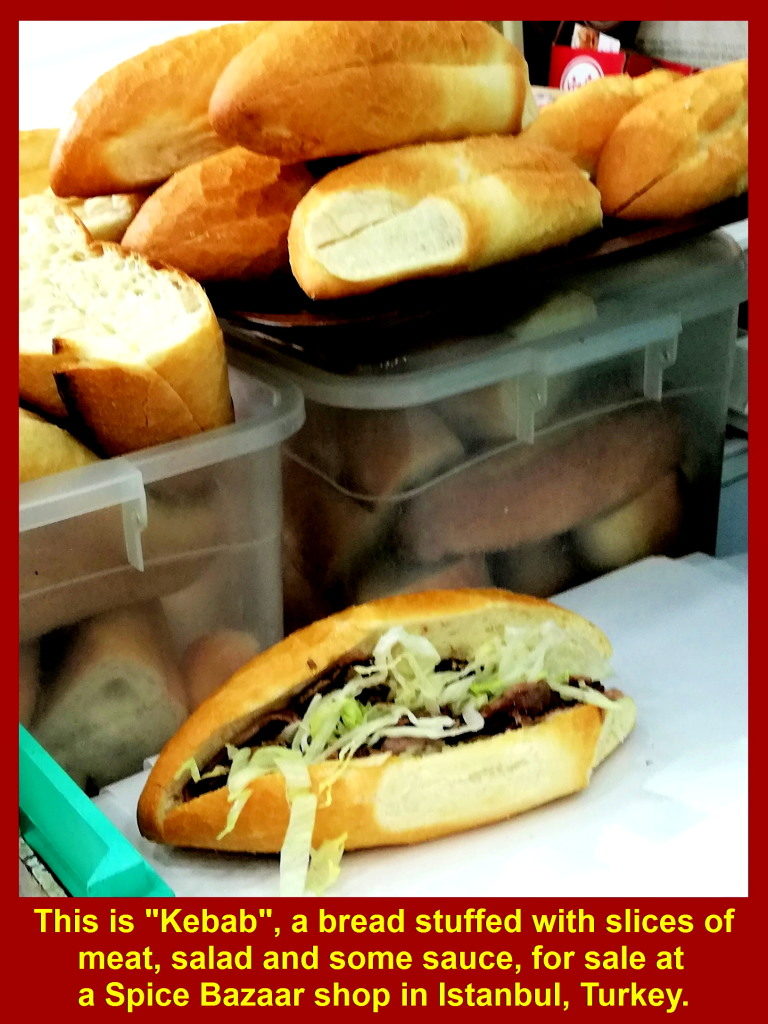
Grand Bazaar, Istanbul
Grand Bazaar was the next Turkish bazaar we visited. It is a couple of hundred metres from Spice Bazaar.
Grand Bazaar was established in 1461. Now it has over 60 covered streets lined with over 4000 shops selling a wide variety of products ranging from spices, dried nuts and fruits, souvenirs to handbags and jewellery. An average of 300 000 people visited the bazaar, daily.
Entrances into Grand Bazaar
There are many entrances into Grand Bazaar in Istanbul, Turkey. Below is one of them.
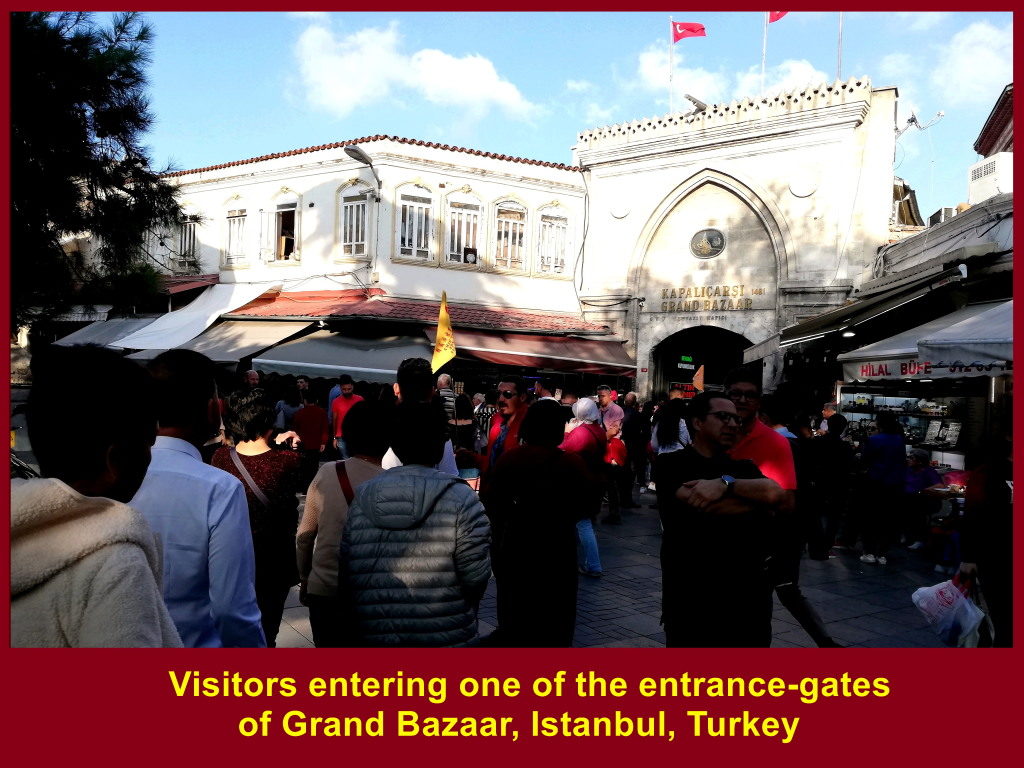
Another entrance into Grand Bazaar
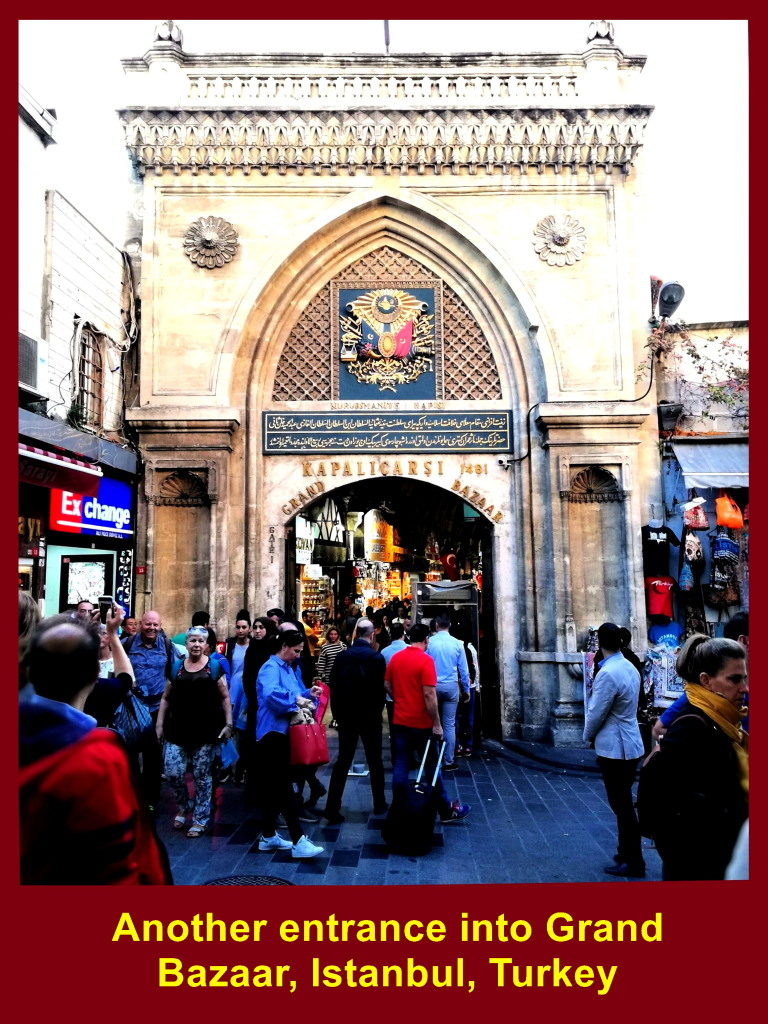
Turkish National Flag
A Turkish national flag hanging in one of the covered streets in Grand Bazaar
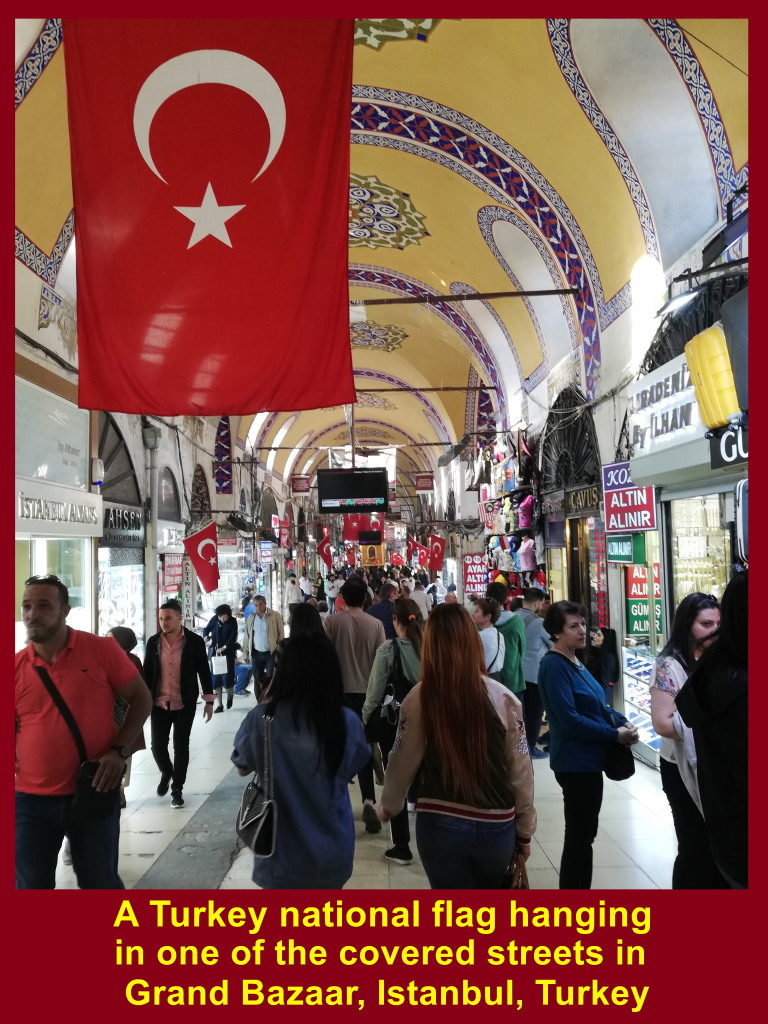
Shops in Grand Bazaar
Below are photos taken at Grand Bazaar on 21 Oct 2019 showing many kinds of Turkish products sold by the shops.
(i) Colourful dried fruits for sale at a Grand Bazaar shop
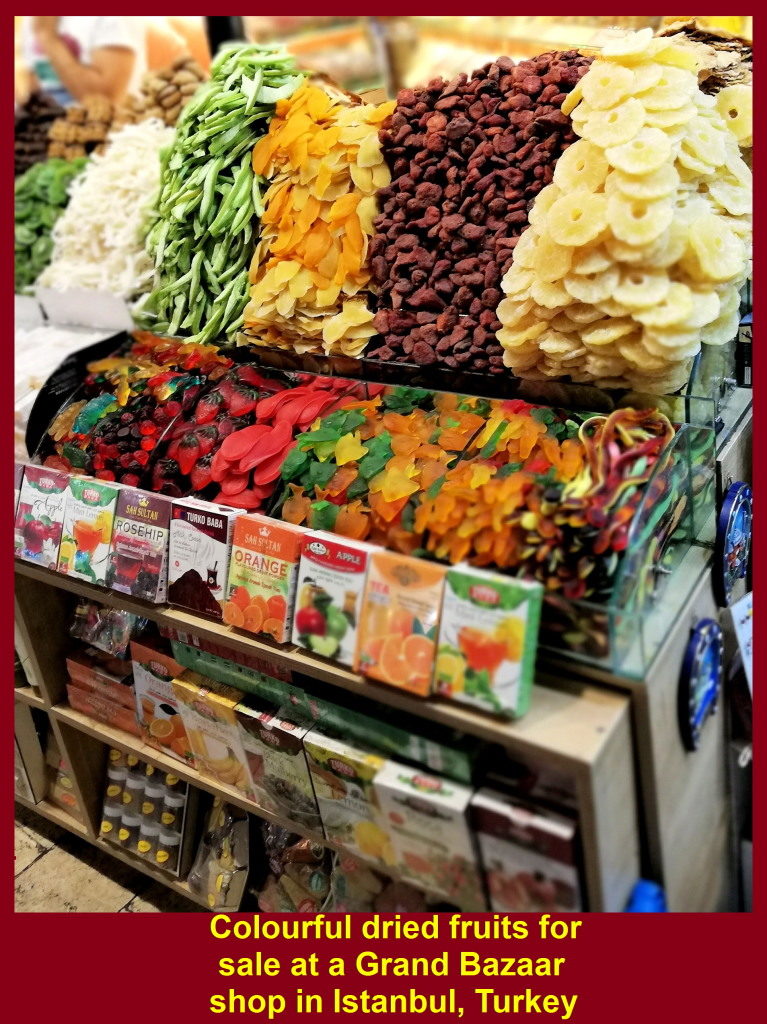
(ii) Handbags for sale at a Grand Bazaar shop
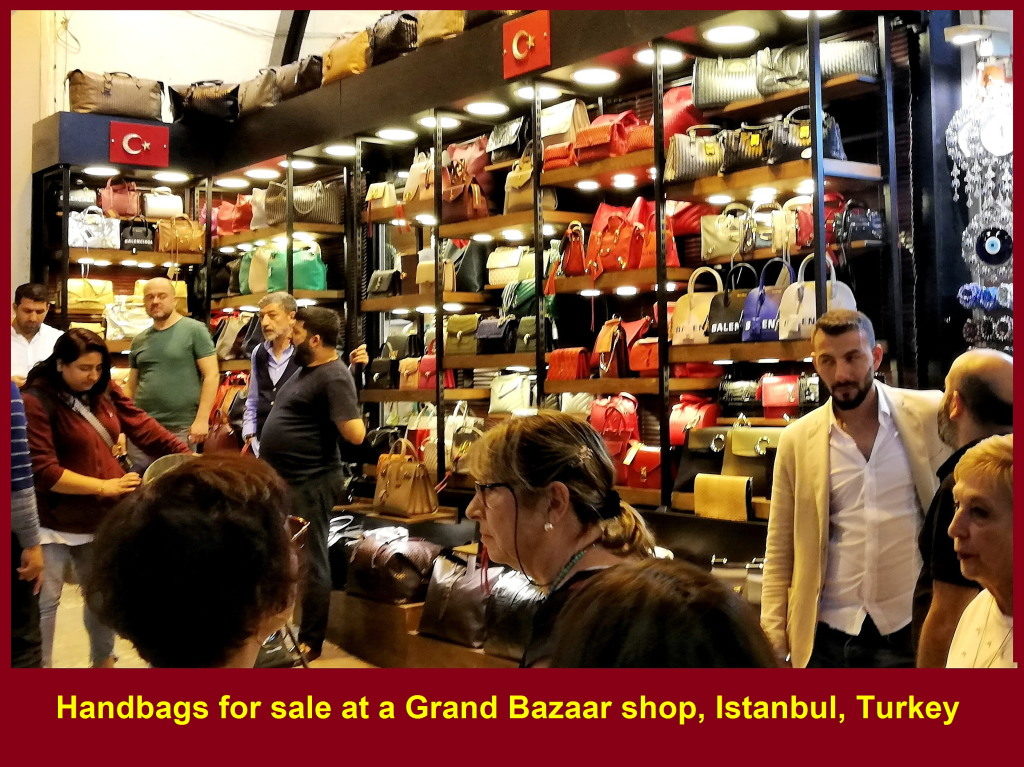
(iii) Jewellery for sale at a Grand Bazaar shop
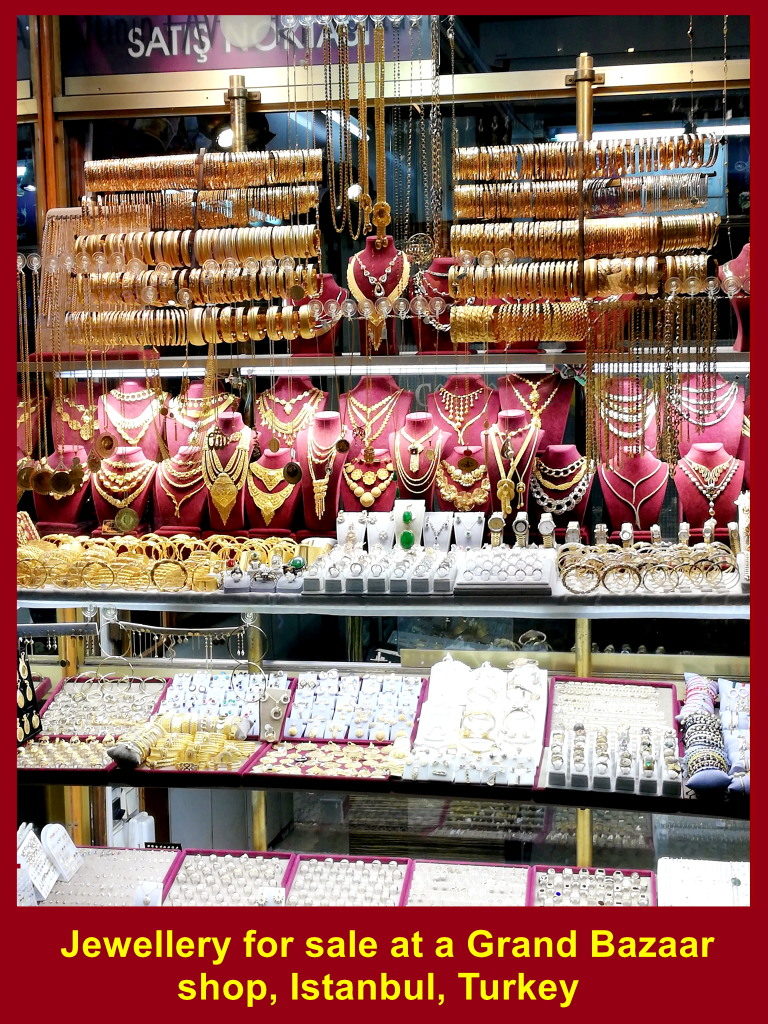
(iv) Colourful scarves for sale at a Grand Bazaar shop
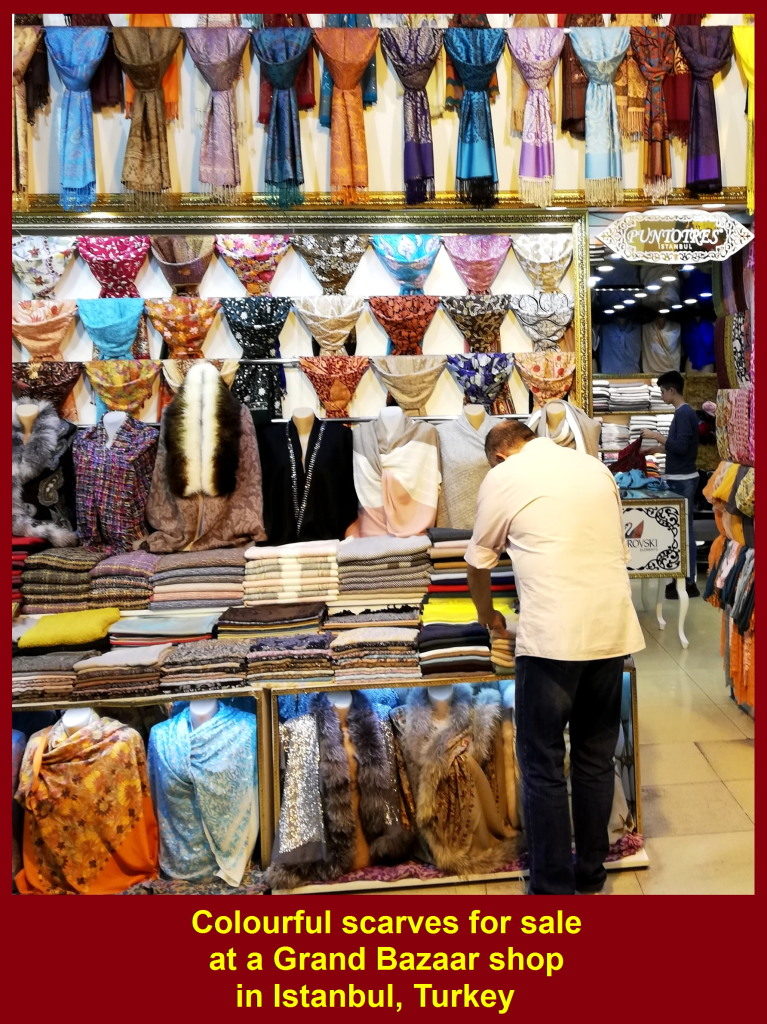
(v) Nazars that ward off evil eye, talismans, amulets, etc. for sale at a Grand Bazaar shop
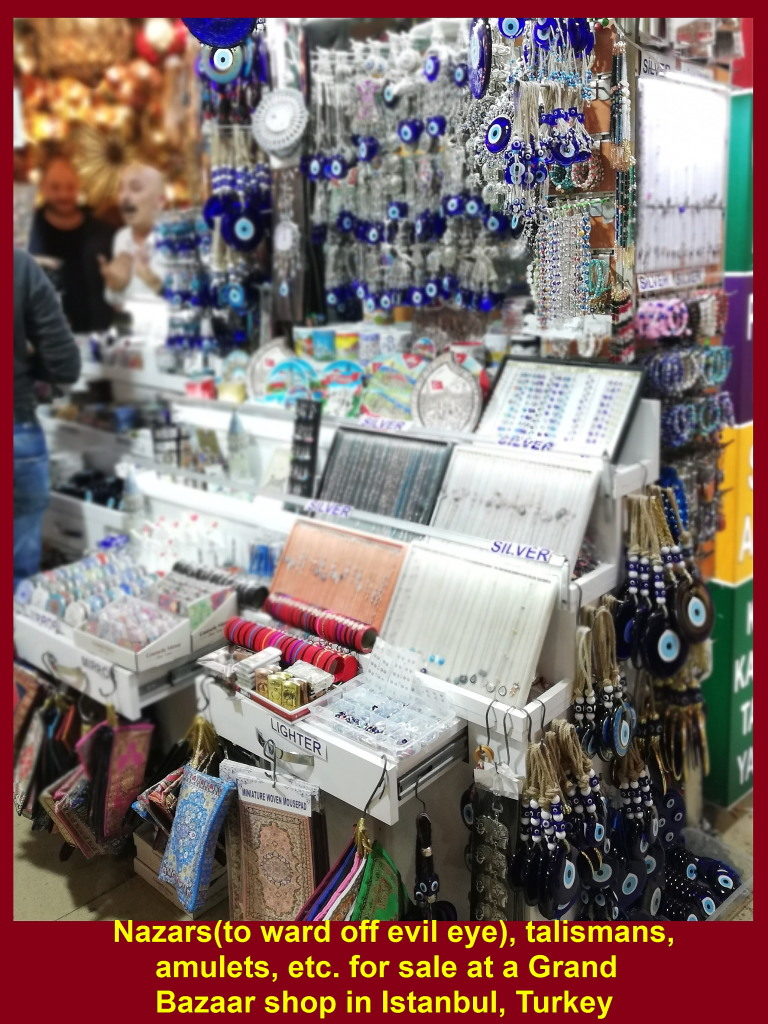
(vi) Colourful Turkish lanterns for sale at a Grand Bazaar shop
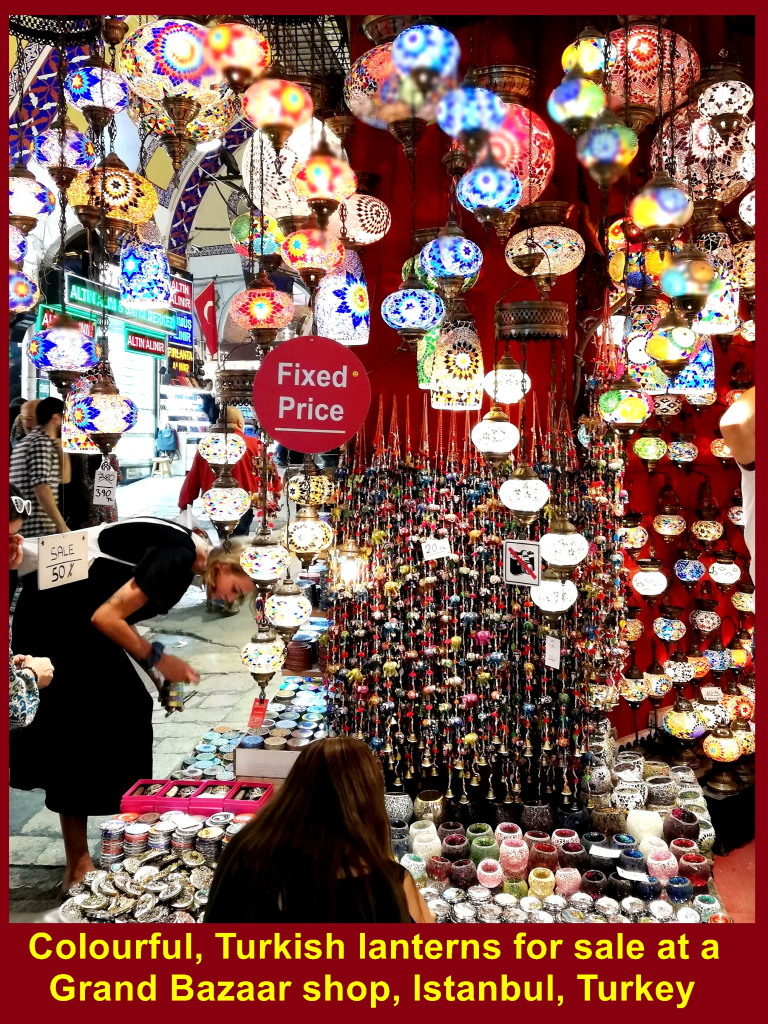
(vii) T-shirts for sale at a Grand Bazaar shop
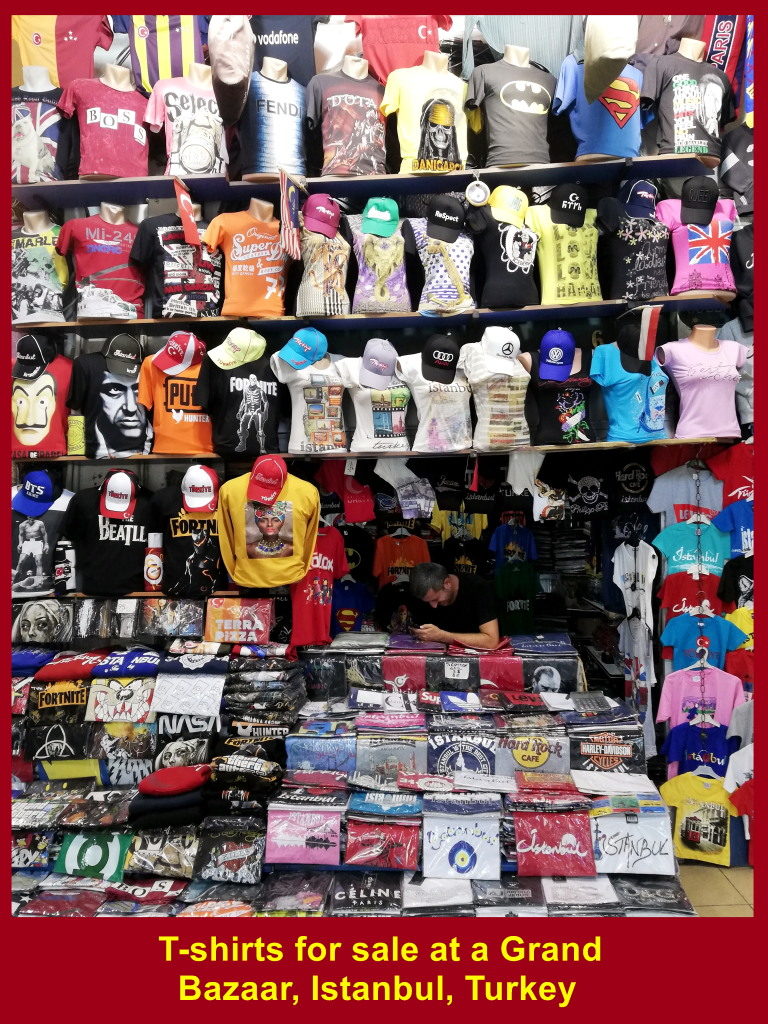
(viii) A cafe at Grand Bazaar
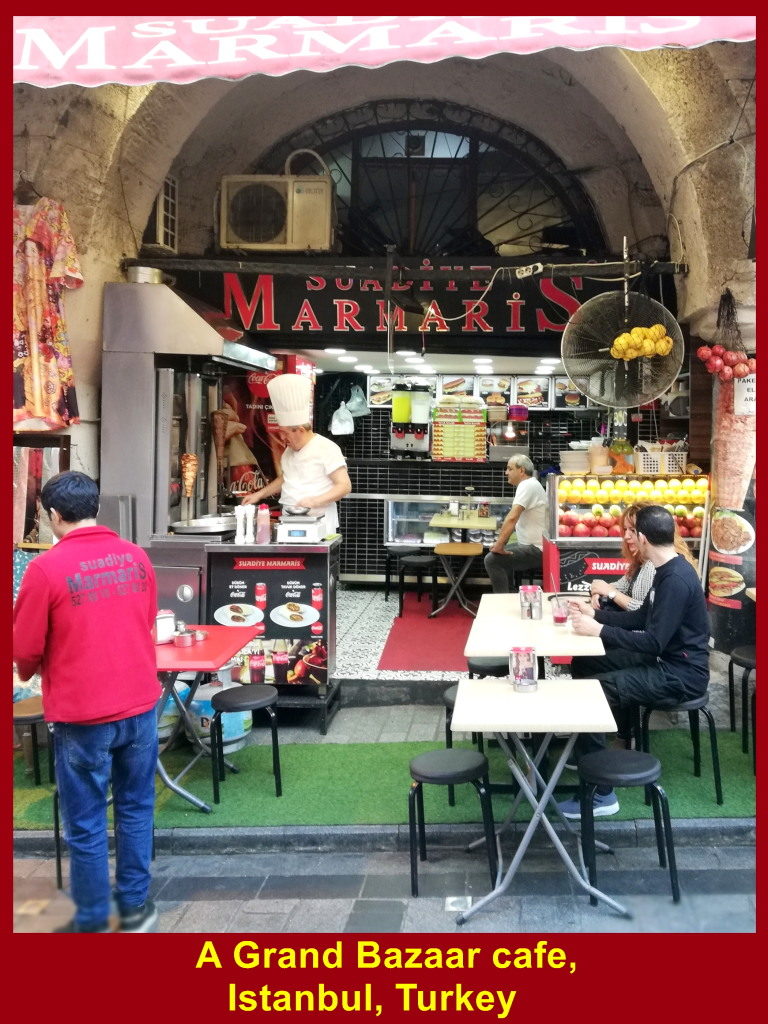
Chinese Dinner at The Wox Restaurant
After a couple of hours at the two large bazaars in Istanbul, we went to a Chinese restaurant called “The Wox” in Sultanahmet for our first Chinese but last dinner in Turkey. It is about 1 km from Grand Bazaar.
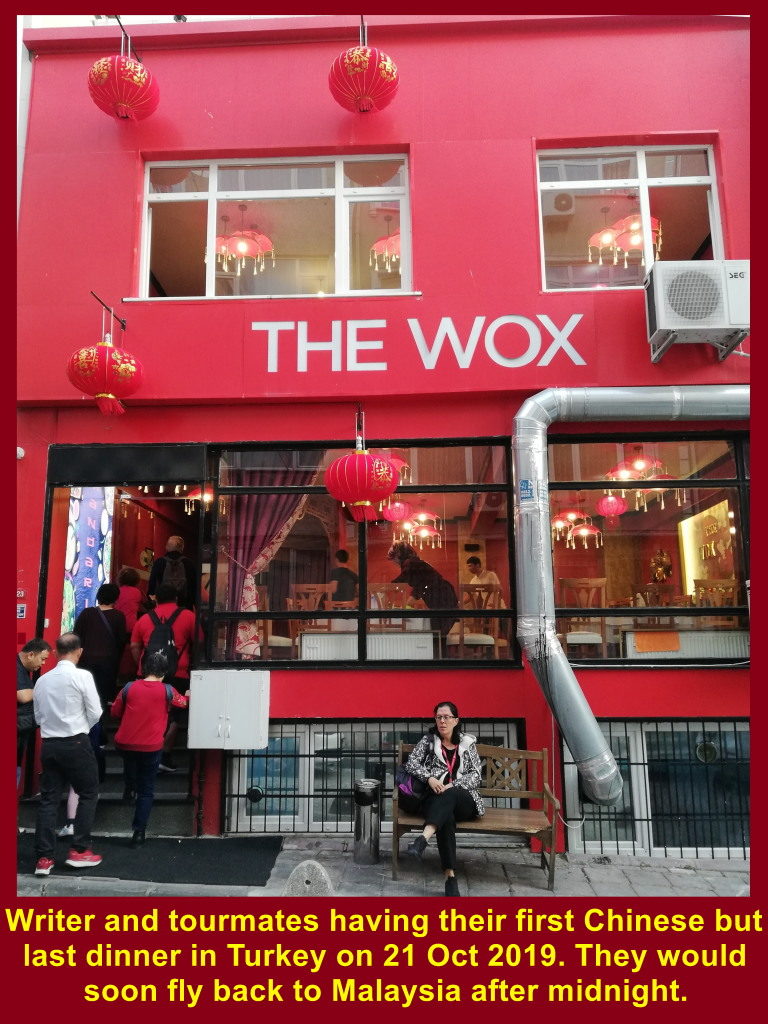
“Home Sweet Home”
After dinner, we checked in at Turkey’s New Airport in Istanbul and flew back to Malaysia, our homeland, after midnight on 22 Oct 2019.
It was a safe journey home, thanks to Turkish Airlines.
Return Air-Flight Route
Map showing the air-flight route back home from Istanbul, Turkey, to KLIA, Kuala Lumpur, Malaysia on 22 Oct 2019

Acknowledgement
Writer and tourmates would like to thank Chiu Travel Agency in Malaysia for the memorable tour in Turkey.
Thanks, too, to Brian Wong, our tour-manager, Cenmal, our Turkish tour-guide, and Metun, our Turkish coach-driver. Without them, our successful tour would not be possible.
Writer and wife thank all our tourmates for the wonderful time we have together during the Turkey tour from 13-22 Oct 2019.
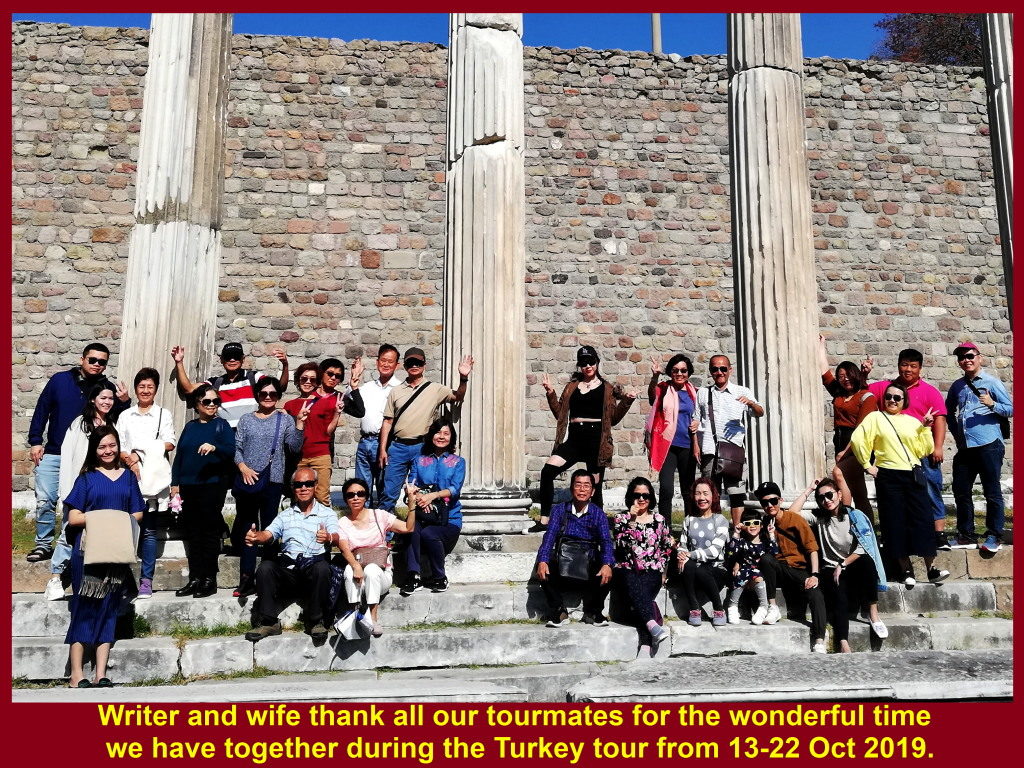
THE END
Places visited during Turkey Tour(13-22 Oct 2019):
Trojan Horse/Ancient Troy Cities Asklepion Ephesus Hierapolis/Pamukkale Travertine Sultanhani Caravanserai Pasabag Valley Uchisar Valley/Kaymakli Underground City Gerome Valley/Turkish Night Show Hot Air Balloon/Lake Golu/Anitkabir Hagia Sophia/Topkapi Palace/Blue Mosque Bosphorus Boat Cruise Spice Bazaar/Grand Bazaar
Spain & Portugal Travel Part I: Toledo
Spain & Portugal Travel Part I: Long Travel to Spain and Toledo Visit
Spain and Portugal have many interesting historical places that are now designated as UNESCO World Heritage sites.
Places of Visit
My wife and I together with 22 people from my country, Malaysia, went to Spain and Portugal to visit some of their historical landmarks from 22 Oct 2018 until 2 November 2018.
Writer and Wife
Tour Group from Malaysia
We would begin our tour from Toledo and end at Barcelona, as shown in the map below.
Map showing the places the tour group would visit
A Brief History of Spain
Spain was ruled by the Romans in around 200 BCE. Subsequently, she was ruled by the Christian Germanic tribal confederations, Visigoths, then the Muslim Moors from North Africa in 7th. century and Christians again in the 15th. century.
King Ferdinand III, a Holy Roman Catholic monarch, recaptured Spain from the Muslims in 1492. The country became a republic in 1873 when the last monarch, King Amadeo I(1845-1890), abdicated his throne.
47 UNESCO World Heritage Sites in Spain
Spain was ruled by different kingdoms in the past and many places and buildings left behind have become UNESCO world heritage sites totalling about 47.
Long Travel to Spain from Malaysia
Day 1 Mon, 22 Oct 2018 Air Flight
On the first day of our travel to Spain, we flew from KLIA, Malaysia, to Madrid in Spain via Bangkok(Thailand) and Amman(Jordan) on Royal Jordanian airlines.
Flight from KLIA to Bangkok(2 hrs 10 mins)
Flight from Bangkok to Amman(9 hrs 20 mins)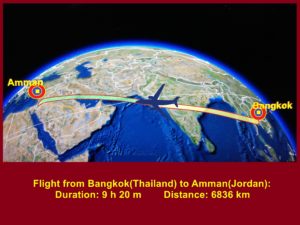
Flight from Bangkok to Amman on 23 Oct 2018
Flight from Amman to Madrid(4 hrs 30 mins)
Jeff Lee, a tour manager of Golden Destinations
Jeff Lee, a tour manager of Golden Destinations Travel Agency(Kuala Lumpur), took care of us during the whole tour as shown in the photo below.
Jeff Lee, tour manager of Golden Destinations
Tue, 23 Oct 2018 Arrival at Madrid, Spain
After a long, tiring journey that took almost a whole day from Malaysia, we finally reached Madrid international airport known as Madrid-Berajas Airport on the second day, Tue, 23 Oct 2018.
At the airport, we boarded a dark orange coach. Then Sergio, a Spanish driver, drove all of us to a small town, Segovia, which is about 90 km north-west of Madrid.
Sergio, a Spanish coach driver
Hotel Puerta de Segovia
On arrival at Segovia, we checked in and rested for a night at a hotel, Hotel Puerta de Segovia. We would begin our Spain-Portugal tour on the following day.
Hotel Puerta de Segovia
Day 3 Wed, 24 Oct 2018
Toledo and Madrid
On this day, we would begin our long-awaited tour in Spain and Portugal.
We would visit Toledo first and then Madrid on the same day.
In the morning, my wife and I had a hearty breakfast at Hotel Puerta de Segovia, our first breakfast in Spain. After breakfast, we and others travelled by coach from the hotel to the former capital of Spain, Toledo, which is located 157 km south-west of Segovia and the journey would take 2 hours.
Writer’s Breakfast
Wife’s Breakfast
Berta, a Toledo tour-guide
On arrival at Toledo, a Spanish guide, Berta, joined us and brought us round to see the landmarks in the old town of Toledo.
Berta, a Toledo tour-guide
Toledo
Toledo is a quaint and charming town in a hilly area. It is known as the “City of Three Cultures” due to the cultural influences of the Christians, Muslims and Jews in the past.
Map showing the location of Toledo
While travelling on a hill in Toledo, we saw the picturesque old town of Toledo on another hill separated by a river, River Tagus.
Alcazar of Toledo
On top of the hill is the Alcazar of Toledo which is a majestic looking fortress on the highest hill in Toledo.
It was used as a Roman palace in the 3rd. Century, restored by a Holy Roman Emperor, Charles V, and his son in the 1540s, and rebuilt between 1939 and 1957.
Now, it houses the regional library and military museum.
Alcazar of Toledo
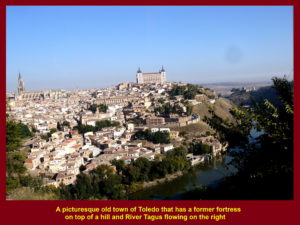
Alcazar of Toledo that was a fortress in the olden days houses a regional library and military museum.
Alcantara Bridge
To enter the old Toledo town, we crossed a bridge over River Tagus. The bridge known as Alcantara Bridge was built between 104 and 106 A.D. by the Romans.
A medieval castle, Castle of San Servando, located on a hill near the bridge was founded in the 7th. Century.
Alcantara Bridge
Castle of San Servando
Wall and Gates
Toledo was surrounded by a wall in the olden days to prevent sudden attack by invaders. Now some parts of the wall and two stone gates remain as monuments.
Wall Round Toledo
Stone Gate to Alcazar of Toledo
This massive stone-gate is an entrance to Alcazar of Toledo. a fortress on the highest hill in Toledo.
Stone Gate in Toledo
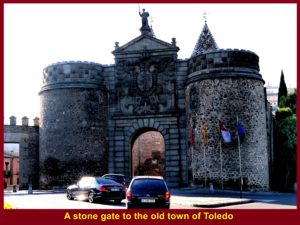
A massive stone gate is an entrance to a fortress, Alcazar of Toledo, located on the highest hill in Toledo.
Alcazar of Toledo
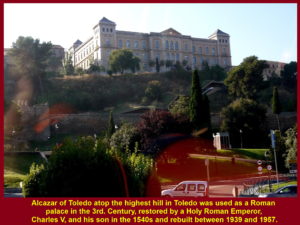
Toledo Alcazar was used as a Roman palace in the 3rd. Century, restored by Charles V and his son in the 1540s and rebuilt between 1939 and 1957.
Narrow Old Streets and Squares
When we were in the old town of Toledo, we walked along narrow old streets. We stopped when we came across some ancient cathedrals.
Narrow Old Street
Souvenir Shops
A Lot of Walking
We walked a lot in the town and sometimes took opportunity to rest for a short while, like these two good, old friends, Roland and Voon, from Sarawak did as shown in the photo below.
Resting in a Toledo Narrow Street
Zocodover Square
While going to Toledo Cathedral, we stopped for a moment at an open-air space known as Zocodover Square.
In the olden days, it was a busy market place and a place for public execution of prisoners. Now, it is a place where important social and political activities take place.
Zocodover Square
Toledo Cathedral
Then we continued walking to a cathedral, Toledo Cathedral, near the square. It is a famous cathedral and the largest in Toledo. It is also known as “Primate Cathedral of St. Mary of Toledo”.
Built in Gothic architectural style, it is a Roman Catholic church that was constructed in 1223 and completed in 1493.
Toledo Cathedral
Facade of Toledo Cathedral
City Council of Toledo Building
On the way to another church, Church of Santo Tome, we were attracted by a charming building with two towers in Baroque style. Besides, it looks symmetrical.
It was constructed from 1575 until 1793 with lots of problems. It is now the seat of the city council of Toledo.
City Council of Toledo
Church of Santo Tome
Then we visited another church known as Church of Santo Tome.
While waiting to enter the church, we were amused by an old, Spanish lady-busker dramatising a play “Don Quxiote” in front of the church. Some generous passers-by donated her some money.
A Lady-Busker
Painting of “The Burial of Count Orfaz”
When we entered the church, we saw a famous painting on a wall, “The Burial of Count Orfaz”. It was painted by El Greco(1541-1614), a Greek Spaniard, who was a painter, sculptor and architect.
Church of Santo Tome
Details of “The Burial of Count Orgaz”
This painting shows heaven on the upper painting and earth on the lower painting.
The heaven shows Mary and John the Baptist gathering at Christ’s feet, whereas the earth shows Saints Augustine and Stephen lowering the body of Count Orgaz into a tomb. Christ was watching and going to judge Count Orgaz’s soul.
El Greco’s famous painting
Count Orgaz
Count Orgaz was a native of Orgaz. When he passed away in 1312, he gave away a large sum of money to Santo Tomes Church and wished to be buried in the church.
According to the legend, two saints, Augustine and Stephen, came down from heaven and buried Count Orgaz in the church.
The church commissioned El Greco to paint a picture in the church showing the burial of Count Orgaz. El Greco finished painting it on a wall in the church in 1586. Art scholars consider it as a masterpiece of Western Art and late Mannerism.
Portrait of El Greco(1541-1614)
Back of the Church of Santo Tome
Toledo Escalators
Later, we went to the top of a Toledo hill by escalators.
The escalators are constructed in six parts in a zig-zag manner totaling 100 metres long. They help tourists to gain a height of 36 metres to reach the hill-top to see the breathtaking view of the new town of Toledo in the distance.
Escalator to the hill-top
Panoramic view of the new town of Toledo
Lunch Time
After a short tour of the old town of Toledo, we went to a restaurant, Restaurante Ciggaral Monte Rey, that perched on a high ground in Toledo old town for lunch.
A Toledo Restaurant
Tour group having lunch in Toledo
Some Dishes Served in the Restaurant
Fried Rice with Seafood
Bread with Cheese, etc.
Two Objects at the Restaurant
At Restarante Ciggaral Monte Rey, two objects attracted my attention as shown in the photos below.
Medieval Armours
In olden days, medieval armours were made of metal and used by soldiers to protect their bodies.
The armours at the restaurant looked heavy. The poor soldiers in ancient times had to wear them for protection during wars.
Medieval Armours
Coat of Arms of Toledo
A carved wooden Coat of Arms of Toledo was on a wall of the restaurant.
Coat of Arms of Toledo
Next Destination
After a sumptuous lunch, we travelled to the capital of Spain, Madrid, which is 73 km north-east of Toledo(Time taken: 1 hour). On arrival in Madrid we visited some heritage sites.
Places visited during Spain & Portugal Tour(22 Oct-02 Nov 2018):
Toledo Madrid Salamanca Porto Lisbon Seville Cordobo Granada Valencia Barcelona
Spain & Portugal Travel Part II: Madrid
Spain & Portugal Travel Part II: Madrid
Day 3 Wed, 24 Oct 2018
Madrid
On this day, we were going to Madrid, the capital of Spain, in the afternoon, after visiting Toledo in the morning.
Map showing location of Madrid
After lunch in Toledo, we travelled 73 km north-east to Madrid for an hour.
Ines, a Madrid tour guide
Arriving at Madrid, we met a Madrid tour guide, Ines, who brought us round.
Ines, a Madrid tour guide
Bullring, Las Ventas
The first place we visited in the city was a large bullring, Las Ventas, that has a seating capacity of about 24000 and opened for bullfighting in 1931. It is also used for concerts, tennis competitions, cultural celebrations and other activities.
Bullring, Las Ventas
In the Bullring
Bullfighting Sculpture
Writer and wife visiting the bullring
Santiago Bernabeu Stadium
On the way to the Royal Palace of Spain from the bullring, we passed by a large football stadium that is known as Santiago Bernabeu which was opened in 1947 and has a seating capacity of about 81000.
Many grand final matches, such as European Cup, UEFA and World Cup, have been played in the stadium. Besides, it is a home to Real Madrid Football Club, a famous professional football club since 1947.
Santiago Bernabeu Stadium
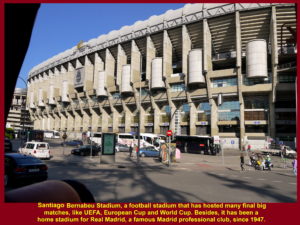
Santiago Bernabeu Stadium that has hosted many grand final matches and is a home to Real Madrid Football Club
Cybele Palace
Then we passed by a stunning, white building called Cybele Palace. It was opened in 1919 until 2007 as headquarters for postal and communications services. Now it houses Madrid City Hall and a cultural centre known as CentroCentro.
Cybele Palace
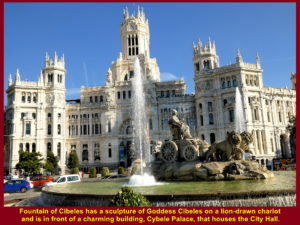
Charming, white Cybele Palace and beautiful fountain known as Cibeles Fountain in front of the white building
Cibeles Fountain
In front of Cybele Palace is a roundabout that has a beautiful fountain in its centre. It has a sculpture of a Phrygian goddess, Cibeles. riding a lion-drawn chariot.
Royal Palace of Spain
Later, we arrived at the Royal Palace of Spain. It is a grand palace where the current king, King Felipe VI and his family do not live. It is used for state ceremonies and opened to public for them to see the valuable things left behind by former kings and queens of Spain.
Royal Palace of Spain
Miguel de Cervantes Monument
In a square, Spain Square, near the royal palace, there is a monument in memory of Miguel de Cervantes(1547-1616), a famous Spanish writer. “Don Quixote” is one of his novels.
The story of “Don Quixote” is about a nobleman, Alonso Quixano. He knows so many romances of chivalry that he loses his mind and becomes a knight-errant trying to revive and serve his country under the name Don Quixote de la Mancha.
Knight-errant is a medieval knight who travels around doing brave things and helping people in trouble.
Monument to Miguel de Cervantes
Statue of Miguel de Cervantes
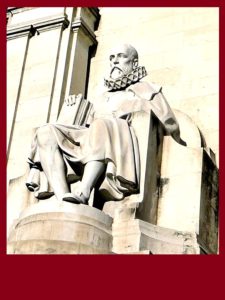
Statue of Miguel de Cervantes, the writer of novel, “Don Quixote”, at its monument in Spain Park, Madrid
Bronze sculpture of Don Quixote and Sancho Panza
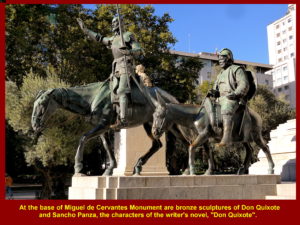
Bronze sculpture of Don Quixote and Sancho Panza, the two important characters in Miguel’s novel, “Don Quixote”
Oriental Square(Plaza de Oriente)
In another square near the royal palace, Oriental Square, there is a bronze equestrian of King Felipe IV of Spain(1605-1665). He ruled Spain from 1621 till 1665. The king commissioned an Italian sculptor, Pietro Tacca(1577-1640), to made this equestrian of himself.
Bronze equestrian of King Felipe IV(1605-1665)
Sabatini Garden
Located near the Oriental Square is the Sabatini Garden. It was opened by King Juan Carlos I(1938- ) in 1978 in honour of an Italian architect, Francesco Sabatini(1722-1797), who had made a lot of contributions to the architectural landscape of Spain in the 18th. Century. King Juan Carlos I ruled Spain from 1975 until his abdication in 2014.
Francessco Sabatini’s Work
The photo below shows the main gate into the city of Madrid, Puerta de Alcala, in the Plaza de la Independencia. It was built in 1778 and looks like a triumphal arch that is one of Sabatini’s works.
A Sabatini’s Work, Puerta Alcala
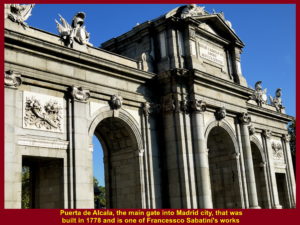
Puerta Alcala was built in 1778 as the main gate into Madrid city and is one of Francessco Sabatini’s works.
Statues of Spanish Kings in Sabatini Garden
In the shady garden of Sabatini Garden near the Royal Palace there are about 20 statues of Spanish kings arranged in two rows, including King of Visigothic Kingdom, Ataulfo(370-415), King of Visigothic Kingdom, Suntila(588-633), King of Asturias, Alonso I(693-757), King of Leon, Alonso V(994-1028), King of Aragon, Ramiro I(1007-1063) and Emperor of Spain, Fernando(1015-1065), as shown in the photos below.
Altaulfo(370-415)
Suntila(588-633)
Alonso I(693-757)
Alonso V(994-1028)
Amiro I(1007-1063)
Fernando(1015-1065)
Spanish Traditional Clothes
Near the Monument to Miguel de Cervantes, I saw four colourful Spanish traditional clothes. They were meant for tourists who wanted to be photographed in them for remembrance, but they had to pay a fee to the owner.
Spanish Traditional Clothes
Royal Palace Guards
In a Royal Palace garden, I came across two palace guards on horses patrolling the palace area. They were very friendly and allowed me to take a photo of them.
Dinner at a Chinese Restaurant, Royal Cantones
Soon we left the Royal Palace in Madrid and went to a Chinese restaurant, Royal Cantones Restaurant, for dinner in the city. After dinner we travelled back to Hotel Puerta de Segovia in Segovia which is 90 km north-east of Madrid.
Royal Cantones
Below are photos showing some dishes served at the Chinese restarant, Royal Cantones Restaurant
Steamed Fish
Tofu
Fried Chicken
Next Destination
Our next destination would be Salamanca on the following day, Thurs, 24 October 2018.
Previous(Toledo) / Home / Next(Salamanca)
Places visited during Spain & Portugal Tour(22 Oct-02 Nov 2018):
Toledo Madrid Salamanca Porto Lisbon Seville Cordobo Granada Valencia Barcelona
Spain & Portugal Travel Part III: Salamanca
Spain & Portugal Travel Part III: Salamanca
Salamanca
Day 4 Thursday, 25 Oct 2018
On this day, we were going to visit Salamanca.
We left Hotel Puerta de Segovia in Segovia in the morning and travelled 310 km west to Salamanca and the travelling time would be 3 hours 20 minutes.
Short History of Salamanca
Salamanca was first ruled by the Romans, then the Christian Visigoths from western Germany, later the Muslim Moors from North Africa and finally the Christians again.
Map showing the location of Salamanca
Economy of Salamanca
The economy of Salamanca depends mostly on tourism and students going for university education in the old town.
There are few heritage sites and old churches that attract tourists to Salamanca, including Roman Bridge, old churches, the oldest university in Spain and old public squares.
Below are some of the landmarks we visited in Salamanca
Roman Bridge
The Roman Bridge that crosses River Tormes in Salamanca was built over 2000 years ago. It is 176 metres long and 37 metres wide.
Roman Bridge
Bronze Sculpture
Erected near the Roman Bridge is a bronze sculpture of Lazarillo, a young boy leading a blind man. It was created by a Spanish artist, Agustin Castillas.
This monument is dedicated to the anonymous novelist who had written a story titled “The Life of Lazarillo de Tormes”(published in 1554). The story is about a poor boy who is sold to some masters who treated him, cruelly.
Lazarillo and Blind Man
Sculpture of a Headless Boar
At the entrance of the Roman Bridge, there is a sculpture of a headless boar on a high pedestal. This stone animal is known as verraco in Spainish.
So far about 400 monuments of this animal have been identified, especially in the high central plain of Iberian Peninsula. It is believed that they were created between the 4th. and 1st. Century B.C. and had some religious protective significance.
Headless Boar
Gate into the Old Town of Salamanca
Before entering the old town of Salamanca, we noticed a large gate standing opposite the Roman Bridge and there was no wall for protecting the town in the olden days.
Salamanca Gate
Old and New Salamanca Cathedrals
There are two cathedrals which are close to each other near the gate. One was built in Gothic and Baroque styles in the 12th. Century and is known as Old Salamanca Cathedral. The other one which is larger was built in Romanesque style between the 16th. and 18th. Century and is known as New Salamanca Cathedral.
Old Salamanca Cathedral
New Salamanca Cathedral
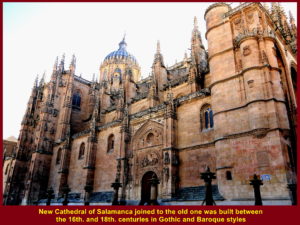
New Cathedral of Salamanca joined to the old one was built between 16th. and 18th. centuries in Gothic and Baroque styles.
Statue of Padre Camara
In the Juan XXIII Plaza next to Salamanca Cathedral is a statue of Padre Camara(1847-1904). He was a bishop of Salamanca Cathedral from 1885 until 1904.
Statue of Padre Camara
Episcopal Palace of Salamanca
Episcopal Palace of Salamanca is located in the same square. Opened in 1890, it was the residence for bishops until 1964. Now it houses the Museum of History of Salamanca.
Episcopal Palace of Salamanca
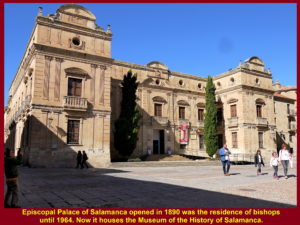
Episcopal Palace of Salamanca opened in 1890 was a residence for bishops unti 1964. It now houses the Museum of History of Salamanca.
Writer and wife visited Salamanca Cathedral
University of Salamanca
Located near Salamanca Cathedral is the 3rd. oldest university in the world, University of Salamanca.
Thousands of students are studying at the university and contribute to the economy of Salamanca, annually. It was opened in the 11th. Century.
University of Salamanca
Statue of Fray Luis de Leon(1527-1591)
Erected in front of the university is a statue of Fray Luis de Leon(1527-1591). Luis graduated from the university with Master’s Degree of Theology in 1560 and later, he lectured at the institution.
Statue of Fray Luis de Leon(1527-1591)
House of Shells or Casa de las Conchas
Near the university there is a house that was built in Gothic and Plateresque styles between 1493 and 1517. Known as House of Shelle or Casa de las Conchas, it was built by Rodrigo Arias, a professor of University of Salamanca.
It has a unique facade as it is decorated with over 300 stone shells. The shells are a symbol of the Order of Santiago and pilgrims performing the Way of St. James. Besides, the facade has the coat of arms of the Catholic monarchs of Spain and four Gothic styled windows of different shapes.
This historical building is now a public library.
House of Shells
Courtyard of House of Shells
Clerecia Church
Right in front of the House of Shells is a church known as Clerecia Church. Built in Baroque style in the 17th. Century as the Royal College of the Jesus, it is now a headquarter of Salamanca Pontificial University.
Clerecia Church
Next Destination, Porto
After visiting the landmarks in Salamanca, we had lunch at a Chinese restaurant known as Mei Shi Restaurant in the old town of Salamanca. Then we left the town and travelled to the next destination, Porto in Portugal. Porta is 350 km west of Salamanca and time taken for the journey is 4 hours.
Mei Shi Restaurant, Salamanca
Tour Group having lunch
Previous(Madrid) / Home / Next(Porto)
Places visited during Spain & Portugal Tour(22 Oct-02 Nov 2018):
Toledo Madrid Salamanca Porto Lisbon Seville Cordobo Granada Valencia Barcelona
Spain & Portugal Travel Part IV: Porto
Spain & Portugal Travel Part IV: Porto
Porto
Day 4 Thursday, 25 October 2018
On this day, we continued our journey from Salamanca in Spain to Porto in Portugal which is 340 km west of Salamanca and the journey would take 4 hours.
As we arrived in Porto in the evening, we stayed at a hotel, Hotel Black Tulip, for a night.
Day 5 Friday, 26 October 2018
On the following day, Friday, 26 October 2018, we left Hotel Black Tulip and travelled to Porto Old Town.
Map showing the location of Porto
Bridges over River Douro
While travelling along River Douro to Porto Old Town, we saw a few bridges crossing the river, including Flexio Bridge(1995), Infante Bridge(2003) and Luis I Bridge(1886), as shown in the photos below.
Fleixo Bridge
Infante Bridge
Luis I Bridge
Luis I Bridge, a two level bridge
Luis I Bridge is a special bridge. Built in 1886 over River Douro connecting Porto City to Vila Nova de Gaia, this old bridge has two levels. The upper level is for light rail train(Metro), and the lower one for pedestrians and cars.
Diogo, a Porto local tour guide
On arrival in Porto City, we were joined by a local tour guide called Diogo. He showed us around to see a few old landmarks in the old town.
Diogo, a Porto local tour guide
Livraria Lello or Livraria Chardron Bookstore
While we were on the way to two old churches in Porto Old Town, we saw a shop with a facade that was quite different from the rest in the same row.
It had a white facade of an elegant architectural design with some simple paintings. It was a bookstore known as Lavraria Lello or Livraria Chadron Bookstore opened in 1960.
That shop was frequented by J.K. Rowling who was teaching English in Porto from 1991 until 1993. She is a famous writer who has written Harry Potter series.
Livraria Lello or Livraria Chardron Bookstore
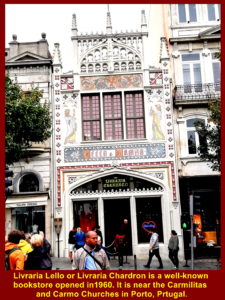
Livrari Lello or Livraria Chardron Bookstore is a well-known bookstore and opened in 1960 in Porto, Portugal.
Carmilitas Church and Carmo Church
Soon we arrived at two churches which were very close to each other.
The left church is known as Carmilitas. It is a convent for nuns built in Classical style with a bell tower on the left in the 17th. Century.
It is separated from another church, Carmo Church, for monks by a very narrow row of houses which prevents the contact between the monks and nuns.
Carmo Church was built in Baroque style in the 18th. Century.
Carmilitas Church and Carmo Church
Interior of Carmilitas Church
The interior of Carmilitas Church is long. Its woodcarvings and the altar are richly gilded with gold.
Interior of Carmilitas Church
Coffee Time
After visiting the two churches, we crossed the road in front of them to one of the cafes to have coffee.
Cafes
Assorted Pastries at a Cafe
A cafe had assorted pastries which were mouth-watering as shown in the two photos below
.Assorted Pastries
After coffee we took a long walk to Freedom or Liberty Square
Statue of Ramalho Orthigao(1836-1915)
On the way to Freedom or Liberty Square we came across a statue in Cordoana Garden. It was a statue of a famous Portuguese writer, Ramalho Orthigao(1836-1915).
“The Mystery of the Sintra Road” and “As Farpas” were among his notable writings.
Ramalho Orthigao(1836-1915)
University of Porto
Then we passed by a large building which was University of Porto.
The university was founded in 1911 and is the 2nd. largest by number of enrolled students after University of Lisbon in Portugal.
University of Porto
Church of Clergy and Tower of Clerics(Clergy)
While walking away from the university, we saw a tall bell tower and a white building adjacent to it. The building is a Roman Catholic church known as Church of Clergy built in the 17th. Century for the brotherhood of clergy. The bell tower known as Tower of Clerics was built several years later.
Visitors can climb up the steep steps in the tower and have a breathtaking view of Porto City.
Church of Clergy and Tower of Clerics(Clergy)
Freedom or Liberty Square
Soon we arrived at the Freedom or Liberty Square.
The square is in the busy business area of Porto. In the centre of the square there is a equestrian statue of King Peter IV. It is a monument in memory of King Peter IV(1798-1834).
King Peter IV was the supporter of constitutional monarchy. He played a very important role in Liberal Wars(1828-1834) in which he defeated his younger brother, Miquel(1802-1866), who supported absolute monarchy. After the war in 1834, Portugal restored the constitutional monarchy.
Freedom or Liberty Square
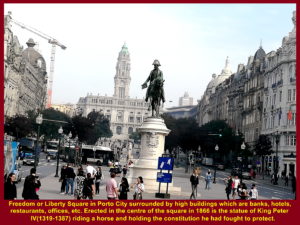
Freedom or Liberty Square in a busy business area of Porto City that has a statue of King Peter IV in its centre
Court and Chain of Relation
A historical building can be seen near the Liberty Square. It was built in 1767 to house the Court and Chain of Relation. Besides, it was used as a prison until 1974 when Portugal returned to democracy.
Portuguese Photography Centre
In 1997 the Portuguese Photography Centre took over the building of Court and Chain of Relation to safeguard, value and promote the photographic heritage of Portugal.
Court and Chain of Relation
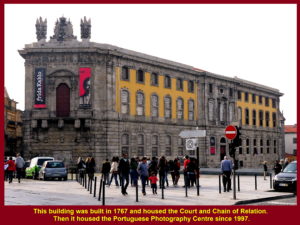
This building was built in 1767 and housed the Court and Chain of Relation. Then it housed the Portuguese Photography Centre since 1997.
Douro Fort or Foz Castle
On the way to Prince Henry the Navigator Square and River Douro Valley from Liberty Square, we saw a fort near the river-mouth of River Douro. It was built in the 16th. Century to protect the port of Porto from being attacked by Spanish fleets from the north. It is called Douro or Foz Castle.
Douro Fort or Foz Castle
Streets of Old Town of Porto
As we passed through the old city we noticed that its streets were narrow and lined with old buildings of a few storeys. Some of the roads were cobble-stoned.
A Street of Old Town of Porto
Old houses in Old Town of Porto
A cobble-stone street in Porto Old Town
Churches in the Old Porto City
There are a few old churches in the city. Among them is Church of the Third Order of St. Francis, a Roman Catholic church on a low hill.
It was built in Gothic style with a large rose window on its facade between 1383 and 1425.
Church of the Third Order of St. Francis
Heritage Trams
In the Old City of Porto, we also noticed that old trams or heritage trams run by electricity were still in operation.
Trams in the city were first pulled by mules, then powered by steam engines and now by electric motors.
Heritage Tram
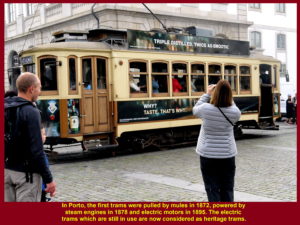
Trams in Porto were first pulled by mules, then powered by steam engines and later by electric motors.
Prince Henry the Navigator Square
After passing through the picturesque Old City of Porto, we arrived at the Prince Henry the Navigator Square.
Prince Henry the Navigator Square
Monument of Prince Henry the Navigator
Erected in the centre of the square is a monument in memory of Prince Henry the Navigator(1394-1460).
Prince Henry played an important role in the early development of Portuguese maritime exploration in the 15th. Century. The period from the 15th. until 18th. Century was known as the Age of Discovery or Expansion.
He sponsored some voyages that led to the discovery of Medeira Islands and other islands off the coast of West Africa, and also some coastal areas in West Africa. He was considered as the initiator of the interest in overseas discovery in Europe.
Monument of Prince Henry the Navigator
Buildings around the Square
There are a few important buildings around Prince Henry the Navigator Square, including the following:
Church of St. Nicholas
Church of St. Nicholas which was built in the 18th. Century is a small church in Baroque-Classical styles.
Church of St. Nicholas
Stock Exchange Palace
Stock Exchange Palace was built in Neoclassical style in the 19th. Century. It is now the seat of the Commercial Association.
Stock Exchange Palace
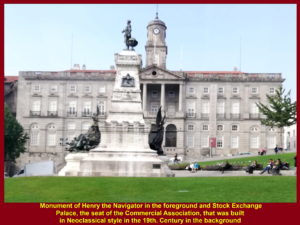
Stock Exchange Palace in the background was built in the 19th. Century and a monument of Henry the Navigator in the foreground
Church of St. Francis
Church of St. Francis is adjacent to the Stock Exchange Palace. It was built in Gothic style in the 15th. Century.
Church of St. Francis
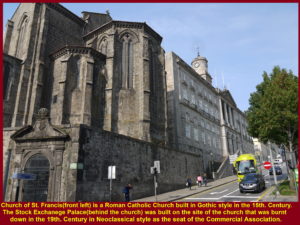
Church of St. Francis built in the 15th. Century with the Stock Exchange Palace built on its burnt-down site
Rebeira Walk
Then we walked down a short distance to a waterfront of River Douro known as Rebeira Walk.
Standing on the waterfront, we saw a beautiful scenery. It was a picturesque view of River Douro on our right, Luis I Bridge over the river in the distance, tourists and foodstalls(cafes) on Rebeira Walk, and old. traditional and colourful shophouses on a higher ground on the left.
Rebeira Walk
Colourful Shophouses
Lunch on Rebeira Walk
As it was lunch-time, my wife, a tour-mate, Roland, and I had lunch together at one of the waterfront cafes. The prices of food and drinks were pricey, but we had no choice as we were hungry.
Writer and wife at a cafe
Writer and wife sharing lunch
Writer and tourmate, Roland, having lunch
River Boat Cruise
There is a place at Rebeira Walk where tourists can embark in boats for a river cruise.
Old traditional cargo boats known as Rabelos are now used for carrying tourists for river-cruises.
A river cruise may start from Rebeira Walk to the river-mouth of Douro, into the Atlantic Ocean and back. It goes under six bridges crossing River Douro and tourists on board can enjoy the quaint sights along the river.
River Douro boat cruise from Rebeira Walk
Next Destination
We left Rebeira Walk and went to Hotel Black Tulip in Porto to stay for a night.
The following day we would leave for the next destination, Lisbon, which is 320 km in the south of Porto.(Time for the journey: 3 hours 30 minutes)
Previous(Salamanca) / Home / Next(Lisbon)
Places visited during Spain & Portugal Tour(22 Oct-02 Nov 2018):
Toledo Madrid Salamanca Porto Lisbon Seville Cordobo Granada Valencia Barcelona

